Heterocyclic Compound And Organic Light-emitting Device Comprising Same
KIM; Minjun ; et al.
U.S. patent application number 16/339868 was filed with the patent office on 2020-02-13 for heterocyclic compound and organic light-emitting device comprising same. The applicant listed for this patent is LG CHEM, LTD.. Invention is credited to Kongkyeom KIM, Minjun KIM, Young Seok KIM, Hyok Joon KWON.
| Application Number | 20200048226 16/339868 |
| Document ID | / |
| Family ID | 63678113 |
| Filed Date | 2020-02-13 |


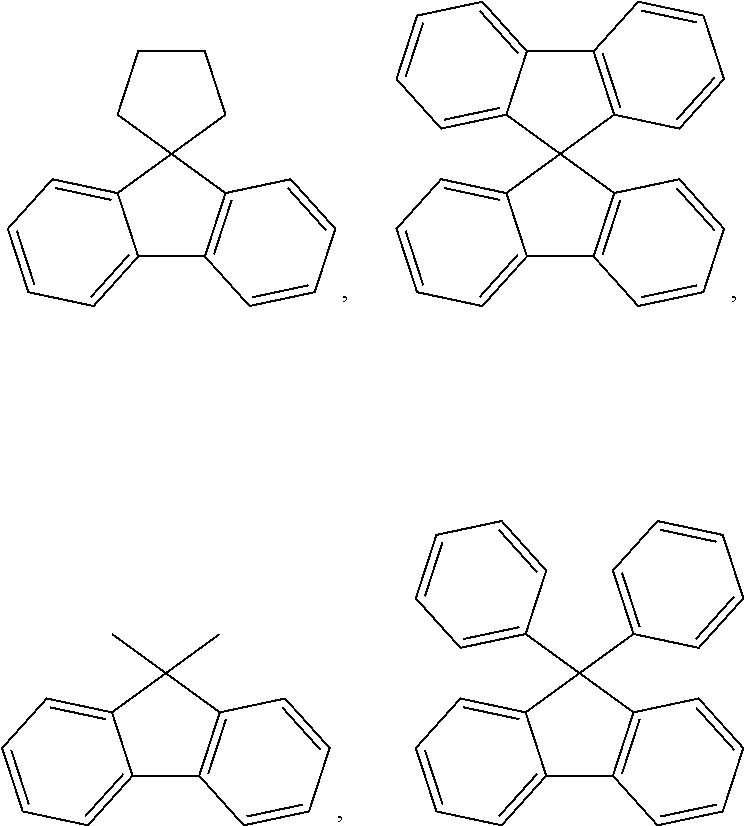






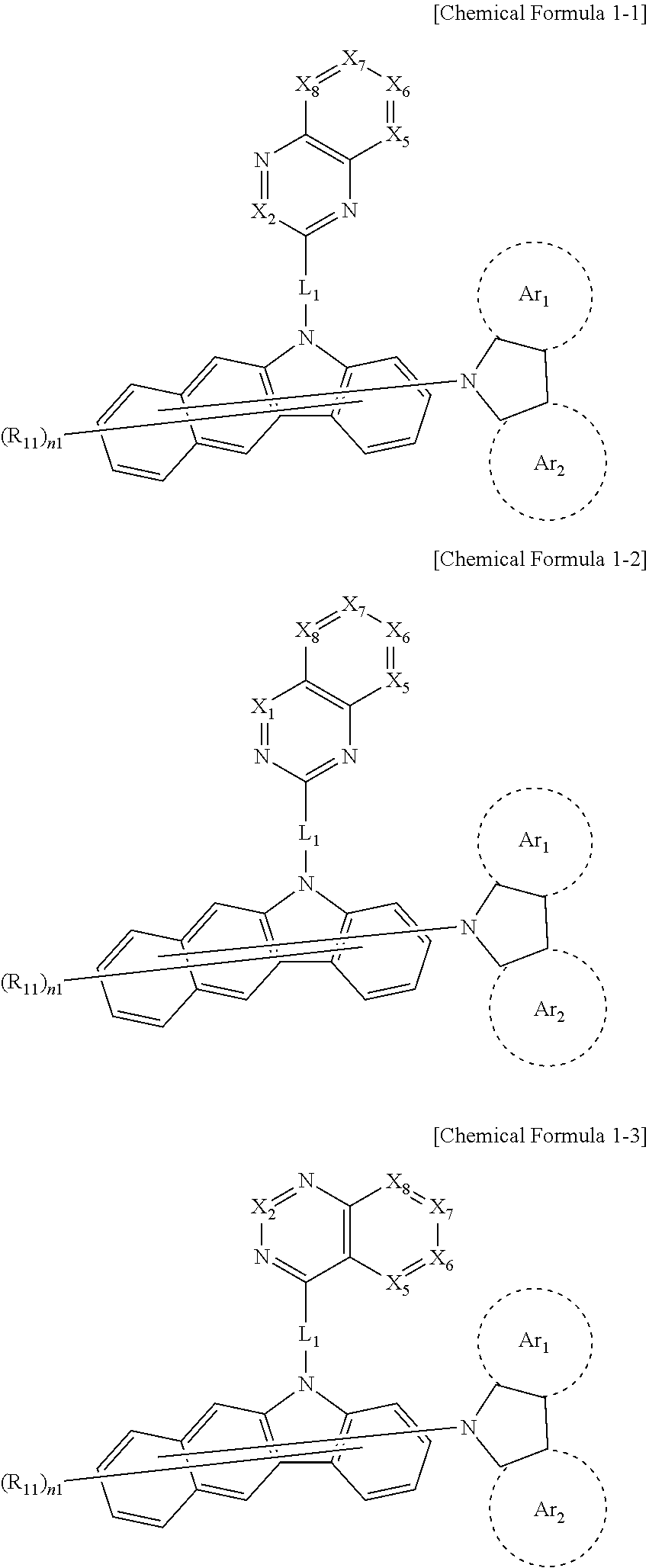


View All Diagrams
| United States Patent Application | 20200048226 |
| Kind Code | A1 |
| KIM; Minjun ; et al. | February 13, 2020 |
HETEROCYCLIC COMPOUND AND ORGANIC LIGHT-EMITTING DEVICE COMPRISING SAME
Abstract
The present specification relates to a heterocyclic compound of Chemical Formula 1, and an organic light emitting device comprising the same. The heterocyclic compound as a material of an organic material layer of the organic light emitting device provides enhanced efficiency, low driving voltage and increased lifetime. ##STR00001##
| Inventors: | KIM; Minjun; (Daejeon, KR) ; KIM; Kongkyeom; (Daejeon, KR) ; KWON; Hyok Joon; (Daejeon, KR) ; KIM; Young Seok; (Daejeon, KR) | ||||||||||
| Applicant: |
|
||||||||||
|---|---|---|---|---|---|---|---|---|---|---|---|
| Family ID: | 63678113 | ||||||||||
| Appl. No.: | 16/339868 | ||||||||||
| Filed: | March 27, 2018 | ||||||||||
| PCT Filed: | March 27, 2018 | ||||||||||
| PCT NO: | PCT/KR2018/003621 | ||||||||||
| 371 Date: | April 5, 2019 |
| Current U.S. Class: | 1/1 |
| Current CPC Class: | H01L 51/5072 20130101; H01L 51/5056 20130101; H01L 51/0073 20130101; H01L 51/0054 20130101; H01L 51/0072 20130101; C07D 407/14 20130101; H01L 51/0074 20130101; C09K 11/06 20130101; C07D 495/04 20130101; H01L 51/0052 20130101; C07D 403/14 20130101; H01L 51/0067 20130101; H01L 51/5016 20130101; C07D 409/14 20130101; C07D 491/048 20130101; C07D 209/56 20130101 |
| International Class: | C07D 403/14 20060101 C07D403/14; C07D 409/14 20060101 C07D409/14; C07D 407/14 20060101 C07D407/14; H01L 51/00 20060101 H01L051/00 |
Foreign Application Data
| Date | Code | Application Number |
|---|---|---|
| Mar 27, 2017 | KR | 10-2017-0038539 |
Claims
1. A heterocyclic compound represented by the following Chemical Formula 1: ##STR00504## wherein, in Chemical Formula 1, Ar.sub.1 and Ar.sub.2 are the same as or different from each other and each independently substituted or unsubstituted benzene; or substituted or unsubstituted naphthalene, and any one of Ar.sub.1 and Ar.sub.2 is substituted or unsubstituted benzene, X.sub.1 to X.sub.4 are the same as or different from each other, and each independently N, CH, CRa, or C linked to L.sub.1, two or more of X.sub.1 to X.sub.4 are N, and any one of X.sub.1 to X.sub.4 is C linked to L.sub.1, X.sub.5 to X.sub.8 are the same as or different from each other, and each independently N, CH or CRa, at least one of X.sub.1 to X.sub.8 is CRa, Ra is a substituted or unsubstituted aryl group having 6 to 60 carbon atoms; or a substituted or unsubstituted heterocyclic group having 2 to 60 carbon atoms, L.sub.1 is a direct bond; or a substituted or unsubstituted arylene group having 6 to 60 carbon atoms, R.sub.11 is hydrogen or deuterium, and n1 is an integer of 0 to 9, and provided that n1 is 2 or greater, two or more R.sub.11s are the same as or different from each other.
2. The heterocyclic compound of claim 1, wherein Chemical Formula 1 is represented by any one of the following Chemical Formula 2 to Chemical Formula 5: ##STR00505## in Chemical Formulae 2 to 5, X.sub.1 to X.sub.8, R.sub.11, n1 and L.sub.1 have the same definitions as in Chemical Formula 1, R.sub.12 to R.sub.19 are the same as or different from each other, and each independently hydrogen; deuterium; a halogen group; a nitrile group; a substituted or unsubstituted alkyl group; a substituted or unsubstituted alkenyl group; a substituted or unsubstituted alkoxy group; a substituted or unsubstituted cycloalkyl group; a substituted or unsubstituted alkylamine group; a substituted or unsubstituted arylamine group; a substituted or unsubstituted aryl group; or a substituted or unsubstituted heterocyclic group, n2, n3, n5, n7 and n9 are each an integer of 0 to 4, n4, n6 and n8 are each an integer of 0 to 6, and provided that n2 to n9 are each 2 or greater, substituents in the parentheses are the same as or different from each other.
3. The heterocyclic compound of claim 1, wherein Ra is a substituted or unsubstituted aryl group having 6 to 30 carbon atoms; or a substituted or unsubstituted heterocyclic group having 2 to 30 carbon atoms.
4. The heterocyclic compound of claim 1, wherein Chemical Formula 1 is represented by any one of the following Chemical Formulae 1-1 to 1-3: ##STR00506## in Chemical Formulae 1-1 to 1-3, X.sub.1, X.sub.2, X.sub.5 to X.sub.8, R.sub.11, n1, L.sub.1, Ar.sub.1 and Ar.sub.2 have the same definitions as in Chemical Formula 1.
5. The heterocyclic compound of claim 1, wherein Chemical Formula 1 is selected from among the following compounds: ##STR00507## ##STR00508## ##STR00509## ##STR00510## ##STR00511## ##STR00512## ##STR00513## ##STR00514## ##STR00515## ##STR00516## ##STR00517## ##STR00518## ##STR00519## ##STR00520## ##STR00521## ##STR00522## ##STR00523## ##STR00524## ##STR00525## ##STR00526## ##STR00527## ##STR00528## ##STR00529## ##STR00530## ##STR00531## ##STR00532## ##STR00533## ##STR00534## ##STR00535## ##STR00536## ##STR00537## ##STR00538## ##STR00539## ##STR00540## ##STR00541## ##STR00542## ##STR00543## ##STR00544## ##STR00545## ##STR00546## ##STR00547## ##STR00548## ##STR00549## ##STR00550## ##STR00551## ##STR00552## ##STR00553## ##STR00554## ##STR00555## ##STR00556## ##STR00557## ##STR00558## ##STR00559## ##STR00560## ##STR00561## ##STR00562## ##STR00563## ##STR00564## ##STR00565## ##STR00566## ##STR00567## ##STR00568## ##STR00569## ##STR00570## ##STR00571## ##STR00572## ##STR00573## ##STR00574## ##STR00575## ##STR00576## ##STR00577## ##STR00578## ##STR00579## ##STR00580## ##STR00581## ##STR00582## ##STR00583## ##STR00584## ##STR00585## ##STR00586## ##STR00587## ##STR00588## ##STR00589## ##STR00590## ##STR00591## ##STR00592## ##STR00593## ##STR00594## ##STR00595## ##STR00596## ##STR00597## ##STR00598## ##STR00599## ##STR00600## ##STR00601## ##STR00602## ##STR00603## ##STR00604## ##STR00605## ##STR00606## ##STR00607## ##STR00608## ##STR00609## ##STR00610## ##STR00611## ##STR00612## ##STR00613## ##STR00614## ##STR00615## ##STR00616## ##STR00617## ##STR00618## ##STR00619## ##STR00620## ##STR00621## ##STR00622## ##STR00623## ##STR00624## ##STR00625## ##STR00626## ##STR00627## ##STR00628## ##STR00629## ##STR00630## ##STR00631## ##STR00632## ##STR00633## ##STR00634## ##STR00635## ##STR00636## ##STR00637## ##STR00638## ##STR00639## ##STR00640## ##STR00641## ##STR00642## ##STR00643## ##STR00644## ##STR00645## ##STR00646## ##STR00647## ##STR00648## ##STR00649## ##STR00650## ##STR00651## ##STR00652## ##STR00653## ##STR00654## ##STR00655## ##STR00656## ##STR00657## ##STR00658## ##STR00659## ##STR00660## ##STR00661## ##STR00662## ##STR00663## ##STR00664## ##STR00665## ##STR00666## ##STR00667## ##STR00668## ##STR00669## ##STR00670## ##STR00671## ##STR00672## ##STR00673## ##STR00674## ##STR00675## ##STR00676## ##STR00677## ##STR00678## ##STR00679## ##STR00680## ##STR00681## ##STR00682## ##STR00683## ##STR00684## ##STR00685## ##STR00686## ##STR00687## ##STR00688## ##STR00689## ##STR00690## ##STR00691## ##STR00692## ##STR00693## ##STR00694## ##STR00695## ##STR00696## ##STR00697## ##STR00698## ##STR00699## ##STR00700## ##STR00701## ##STR00702## ##STR00703## ##STR00704## ##STR00705## ##STR00706## ##STR00707## ##STR00708## ##STR00709## ##STR00710## ##STR00711## ##STR00712## ##STR00713## ##STR00714## ##STR00715## ##STR00716## ##STR00717## ##STR00718## ##STR00719## ##STR00720## ##STR00721## ##STR00722## ##STR00723## ##STR00724## ##STR00725## ##STR00726## ##STR00727## ##STR00728## ##STR00729## ##STR00730## ##STR00731## ##STR00732## ##STR00733## ##STR00734## ##STR00735## ##STR00736## ##STR00737## ##STR00738## ##STR00739## ##STR00740## ##STR00741## ##STR00742## ##STR00743## ##STR00744## ##STR00745## ##STR00746## ##STR00747## ##STR00748## ##STR00749## ##STR00750## ##STR00751## ##STR00752## ##STR00753## ##STR00754## ##STR00755## ##STR00756## ##STR00757## ##STR00758## ##STR00759## ##STR00760## ##STR00761## ##STR00762## ##STR00763## ##STR00764## ##STR00765## ##STR00766## ##STR00767## ##STR00768## ##STR00769## ##STR00770## ##STR00771## ##STR00772## ##STR00773## ##STR00774## ##STR00775## ##STR00776## ##STR00777## ##STR00778## ##STR00779## ##STR00780## ##STR00781## ##STR00782## ##STR00783## ##STR00784## ##STR00785## ##STR00786## ##STR00787## ##STR00788## ##STR00789## ##STR00790## ##STR00791## ##STR00792## ##STR00793## ##STR00794## ##STR00795## ##STR00796## ##STR00797## ##STR00798## ##STR00799## ##STR00800## ##STR00801## ##STR00802## ##STR00803## ##STR00804## ##STR00805## ##STR00806## ##STR00807## ##STR00808## ##STR00809## ##STR00810## ##STR00811## ##STR00812## ##STR00813## ##STR00814## ##STR00815## ##STR00816## ##STR00817## ##STR00818## ##STR00819## ##STR00820## ##STR00821## ##STR00822## ##STR00823## ##STR00824## ##STR00825## ##STR00826## ##STR00827## ##STR00828## ##STR00829## ##STR00830## ##STR00831## ##STR00832## ##STR00833## ##STR00834## ##STR00835## ##STR00836## ##STR00837## ##STR00838## ##STR00839## ##STR00840## ##STR00841## ##STR00842## ##STR00843## ##STR00844## ##STR00845## ##STR00846## ##STR00847## ##STR00848## ##STR00849## ##STR00850## ##STR00851## ##STR00852## ##STR00853## ##STR00854## ##STR00855## ##STR00856## ##STR00857## ##STR00858## ##STR00859## ##STR00860## ##STR00861## ##STR00862## ##STR00863## ##STR00864## ##STR00865## ##STR00866## ##STR00867## ##STR00868## ##STR00869## ##STR00870## ##STR00871## ##STR00872## ##STR00873## ##STR00874## ##STR00875## ##STR00876## ##STR00877## ##STR00878## ##STR00879## ##STR00880## ##STR00881## ##STR00882## ##STR00883## ##STR00884## ##STR00885## ##STR00886## ##STR00887## ##STR00888## ##STR00889## ##STR00890## ##STR00891## ##STR00892## ##STR00893## ##STR00894## ##STR00895##
6. An organic light emitting device comprising: a first electrode, a second electrode provided opposite to the first electrode, and one or more organic material layers provided between the first electrode and the second electrode, wherein one or more layers of the one or more organic material layers comprise the heterocyclic compound of claim 1.
7. The organic light emitting device of claim 6, wherein the one or more organic material layers comprise a hole injection layer or a hole transfer layer, and the hole injection layer or the hole transfer layer comprises the heterocyclic compound.
8. The organic light emitting device of claim 6, wherein the one or more organic material layers comprise an electron transfer layer or an electron injection layer, and the electron transfer layer or the electron injection layer comprises the heterocyclic compound.
9. The organic light emitting device of claim 6, wherein the one or more organic material layers comprise a light emitting layer, and the light emitting layer comprises the heterocyclic compound.
Description
TECHNICAL FIELD
[0001] This application claims priority to and the benefits of Korean Patent Application No. 10-2017-0038539, filed with the Korean Intellectual Property Office on Mar. 27, 2017, the entire contents of which are incorporated herein by reference.
[0002] The present specification relates to a heterocyclic compound and an organic light emitting device comprising the same.
BACKGROUND ART
[0003] An organic light emitting device has a structure disposing an organic thin film between two electrodes. When a voltage is applied to an organic light emitting device having such a structure, electrons and holes injected from the two electrodes bind in the organic thin film to form a pair, and light emits as they disappear. The organic thin film may be formed in a single layer or a multilayer as necessary.
[0004] Materials used in organic light emitting devices are mostly pure organic materials or complex compounds in which organic materials and metals form complexes, and may be divided into hole injection materials, hole transfer materials, light emitting materials, electron transfer materials, electron injection materials and the like depending on the application. Herein, as the hole injection material or the hole transfer material, organic materials having a p-type property, that is, organic materials readily oxidized and electrochemically stable when oxidized, are generally used. Meanwhile, as the electron injection material or the electron transfer material, organic materials having an n-type property, that is, organic materials readily reduced and electrochemically stable when reduced, are generally used. As the light emitting layer material, materials having both a p-type property and an n-type property, that is, materials having a stable form in both oxidized and reduced states, are preferred, and materials having high light emission efficiency converting, when excitons generated by the holes and the electrons recombining in the light emitting layer are formed, the excitons to light are preferred.
[0005] In order to enhance performance, lifetime or efficiency of an organic light emitting device, development of organic thin film materials has been consistently required.
DISCLOSURE
Technical Problem
[0006] The present specification is directed to providing a heterocyclic compound and an organic light emitting device comprising the same.
Technical Solution
[0007] One embodiment of the present specification provides a heterocyclic compound represented by the following Chemical Formula 1.
##STR00002##
[0008] In Chemical Formula 1,
[0009] Ar.sub.1 and Ar.sub.2 are the same as or different from each other and each independently substituted or unsubstituted benzene; or substituted or unsubstituted naphthalene, and any one of Ar.sub.1 and Ar.sub.2 is substituted or unsubstituted benzene,
[0010] X.sub.1 to X.sub.4 are the same as or different from each other and each independently C linked to N, CH, CRa or L.sub.1, two or more of X.sub.1 to X.sub.4 are N, and any one of X.sub.1 to X.sub.4 is C linked to L.sub.1,
[0011] X.sub.5 to X.sub.8 are the same as or different from each other, and each independently N, CH or CRa,
[0012] at least one of X.sub.1 to X.sub.8 is CRa,
[0013] Ra is a substituted or unsubstituted aryl group having 6 to 60 carbon atoms; or a substituted or unsubstituted heterocyclic group having 2 to 60 carbon atoms,
[0014] L.sub.1 is a direct bond; or a substituted or unsubstituted arylene group having 6 to 60 carbon atoms,
[0015] R.sub.11 is hydrogen or deuterium, and
[0016] n1 is an integer of 0 to 9, and when n1 is 2 or greater, two or more R.sub.11s are the same as or different from each other.
[0017] Another embodiment of the present specification provides an organic light emitting device comprising a first electrode; a second electrode provided opposite to the first electrode; and one or more organic material layers provided between the first electrode and the second electrode, wherein one or more layers of the organic material layers comprise the heterocyclic compound represented by Chemical Formula 1.
Advantageous Effects
[0018] A heterocyclic compound described in the present specification can be used as a material of an organic material layer of an organic light emitting device. A compound according to at least one embodiment is capable of enhancing efficiency, obtaining a low driving voltage and/or enhancing lifetime properties in an organic light emitting device. A compound described in the present specification can be used as a material of a hole injection layer, a hole transfer layer, a hole injection layer and hole transfer layer, an electron blocking layer, a light emitting layer, a hole blocking layer, an electron transfer layer or an electron injection layer.
DESCRIPTION OF DRAWINGS
[0019] FIG. 1 illustrates an example of an organic light emitting device formed with a substrate (1), an anode (2), a light emitting layer (3) and a cathode (4).
[0020] FIG. 2 illustrates an example of an organic light emitting device formed with a substrate (1), an anode (2), a hole injection layer (5), a hole transfer layer (6), an electron blocking layer (7), a light emitting layer (8), a hole blocking layer (9), an electron injection and transfer layer (10) and a cathode (4).
[0021] FIG. 3 shows a graph measuring 1H-NMR of Chemical Formula a.
[0022] FIG. 4 shows a graph measuring 1H-NMR of Chemical Formula b.
[0023] FIG. 5 shows a graph measuring 1H-NMR of Compound 547.
[0024] FIG. 6 shows a graph measuring 1H-NMR of Compound 1057.
[0025] 1: Substrate [0026] 2: Anode [0027] 3: Light Emitting Layer [0028] 4: Cathode [0029] 5: Hole Injection Layer [0030] 6: Hole Transfer Layer [0031] 7: Electron Blocking Layer [0032] 8: Light Emitting Layer [0033] 9: Hole Blocking Layer [0034] 10: Electron Injection and Transfer Layer
MODE FOR DISCLOSURE
[0035] Hereinafter, the present specification will be described in more detail.
[0036] The present specification provides a heterocyclic compound represented by Chemical Formula 1. When using the heterocyclic compound represented by Chemical Formula 1 in an organic material layer of an organic light emitting device, efficiency of the organic light emitting device is enhanced, and a low driving voltage and excellent lifetime properties are obtained as well.
[0037] In the present specification, a description of a certain part "comprising" certain constituents means capable of further comprising g other constituents, and does not exclude other constituents unless particularly stated on the contrary.
[0038] In the present specification, a description of one member being placed "on" another member comprises not only a case of the one member adjoining the another member but a case of still another member being present between the two members.
[0039] Examples of the substituents in the present specification are described below, however, the substituents are not limited thereto.
[0040] The term "substitution" means a hydrogen atom bonding to a carbon atom of a compound is changed to another substituent, and the position of substitution is not limited as long as it is a position at which the hydrogen atom is substituted, that is, a position at which a substituent can substitute, and when two or more substituents substitute, the two or more substituents may be the same as or different from each other.
[0041] The term "substituted or unsubstituted" in the present specification means being substituted with one, two or more substituents selected from the group consisting of deuterium; a halogen group; a nitrile group; a silyl group; a boron group; a substituted or unsubstituted alkyl group; a substituted or unsubstituted cycloalkyl group; a substituted or unsubstituted alkoxy group; a substituted or unsubstituted alkenyl group; a substituted or unsubstituted alkylamine group; a substituted or unsubstituted arylamine group; a substituted or unsubstituted aryl group; and a substituted or unsubstituted heterocyclic group, or being substituted with a substituent linking two or more substituents among the substituents illustrated above, or having no substituents. For example, "a substituent linking two or more substituents" may comprise a biphenyl group. In other words, a biphenyl group may be an aryl group, or interpreted as a substituent linking two phenyl groups.
[0042] In the present specification, an "adjacent" group may mean a substituent substituting an atom directly linked to an atom substituted by the corresponding substituent, a substituent sterically most closely positioned to the corresponding substituent, or another substituent substituting an atom substituted by the corresponding substituent. For example, two substituents substituting ortho positions in a benzene ring, and two substituents substituting the same carbon in an aliphatic ring may be interpreted as groups "adjacent" to each other.
[0043] In the present specification, examples of the halogen group may comprise fluorine (F), chlorine (Cl), bromine (Br) or iodine (I).
[0044] In the present specification, the silyl group may be represented by a chemical formula of --SiY.sub.aY.sub.bY.sub.c, and Y.sub.a, Y.sub.b and Y.sub.c may each be hydrogen; a substituted or unsubstituted alkyl group; or a substituted or unsubstituted aryl group. Specific examples of the silyl group may comprise a trimethylsilyl group; a triethylsilyl group; a t-butyldimethylsilyl group; a vinyldimethylsilyl group; a propyldimethylsilyl group; a triphenylsilyl group; a diphenylsilyl group; a phenylsilyl group and the like, but are not limited thereto.
[0045] In the present specification, the boron group may be represented by a chemical formula of --BY.sub.dY.sub.e, and Y.sub.d and Y.sub.d may each be hydrogen; a substituted or unsubstituted alkyl group; or a substituted or unsubstituted aryl group. Specific examples of the boron group may comprise a trimethylboron group, a triethylboron group, a t-butyldimethylboron group, a triphenylboron group, a phenylboron group and the like, but are not limited thereto.
[0046] In the present specification, the alkylamine group preferably has, although not particularly limited thereto, 1 to 40 carbon atoms. Specific examples of the alkylamine group may comprise a methylamine group, a dimethylamine group, an ethylamine group, a diethylamine group and the like, but are not limited thereto.
[0047] In the present specification, examples of the arylamine group comprise a substituted or unsubstituted monoarylamine group, a substituted or unsubstituted diarylamine group, or a substituted or unsubstituted triarylamine group. The aryl group in the arylamine group may be a monocyclic aryl group or a polycyclic aryl group. The arylamine group comprising two or more aryl groups may comprise monocyclic aryl groups, polycyclic aryl groups, or both monocyclic aryl groups and polycyclic aryl groups.
[0048] Specific examples of the arylamine group may comprise phenylamine, naphthylamine, biphenylamine, anthracenylamine, 3-methyl-phenylamine, 4-methyl-naphthylamine, 2-methyl-biphenylamine, 9-methyl-anthracenylamine, a diphenylamine group, a phenylnaphthylamine group, a ditolylamine group, a phenyltolylamine group, carbazole, a triphenylamine group and the like, but are not limited thereto.
[0049] In the present specification, the alkyl group may be linear or branched, and although not particularly limited thereto, the number of carbon atoms is preferably from 1 to 60. According to one embodiment, the number of carbon atoms of the alkyl group is from 1 to 40. According to another embodiment, the number of carbon atoms of the alkyl group is from 1 to 20. Specific examples thereof may comprise a methyl group, an ethyl group, a propyl group, an n-propyl group, an isopropyl group, a butyl group, an n-butyl group, an isobutyl group, a tert-butyl group, a sec-butyl group, a 1-methyl-butyl group, a 1-ethyl-butyl group, a pentyl group, an n-pentyl group, an isopentyl group, a neopentyl group, a tert-pentyl group, a hexyl group, an n-hexyl group, a 1-methylpentyl group, a 2-methylpentyl group, a 4-methyl-2-pentyl group, a 3,3-dimethylbutyl group, a 2-ethylbutyl group, a heptyl group, an n-heptyl group, a 1-methylhexyl group, a cyclopentylmethyl group, a cyclohexylmethyl group, an octyl group, an n-octyl group, a tert-octyl group, a 1-methylheptyl group, a 2-ethylhexyl group, a 2-propylpentyl group, an n-nonyl group, a 2,2-dimethylheptyl group, a 1-ethyl-propyl group, a 1,1-dimethyl-propyl group, an isohexyl group, a 2-methylpentyl group, a 4-methylhexyl group, a 5-methylhexyl group and the like, but are not limited thereto.
[0050] In the present specification, the cycloalkyl group is not particularly limited, but preferably has 3 to 60 carbon atoms. According to one embodiment, the number of carbon atoms of the cycloalkyl group is from 3 to 40. According to another embodiment, the number of carbon atoms of the cycloalkyl group is from 1 to 20. Specific examples thereof may comprise a cyclopropyl group, a cyclobutyl group, a cyclopentyl group, a 3-methylcyclopentyl group, a 2,3-dimethylcyclopentyl group, a cyclohexyl group, a 3-methylcyclohexyl group, a 4-methylcyclohexyl group, a 2,3-dimethylcyclohexyl group, a 3,4,5-trimethylcyclohexyl group, a 4-tert-butylcyclohexyl group, a cycloheptyl group, a cyclooctyl group and the like, but are not limited thereto.
[0051] In the present specification, the alkoxy group may be linear, branched or cyclic. The number of carbon atoms of the alkoxy group is not particularly limited, but is preferably from 1 to 30. Specific examples thereof may comprise methoxy, ethoxy, n-propoxy, isopropoxy, i-propyloxy, n-butoxy, isobutoxy, tert-butoxy, sec-butoxy, n-pentyloxy, neopentyloxy, isopentyloxy, n-hexyloxy, 3,3-dimethylbutyloxy, 2-ethylbutyloxy, n-octyloxy, n-nonyloxy, n-decyloxy and the like, but are not limited thereto.
[0052] In the present specification, the alkenyl group may be linear or branched, and although not particularly limited thereto, the number of carbon atoms is preferably from 2 to 30. Specific examples thereof may comprise vinyl, 1-propenyl, isopropenyl, 1-butenyl, 2-butenyl, 3-butenyl, 1-pentenyl, 2-pentenyl, 3-pentenyl, 3-methyl-1-butenyl, 1,3-butadienyl and the like, but are not limited thereto.
[0053] In the present specification, the aryl group is not particularly limited, but preferably has 6 to 60 carbon atoms, and may be a monocyclic aryl group or a polycyclic aryl group. According to one embodiment, the number of carbon atoms of the aryl group is from 6 to 30. According to one embodiment, the number of carbon atoms of the aryl group is from 6 to 20. When the aryl group is a monocyclic aryl group, examples thereof may comprise a phenyl group, a biphenyl group, a terphenyl group and the like, but are not limited thereto. Examples of the polycyclic aryl group may comprise a naphthyl group, an anthracenyl group, a phenanthrenyl group, a pyrenyl group, a perylenyl group, a triphenylene group, a chrysenyl group, a fluorenyl group and the like, but are not limited thereto.
[0054] In the present specification, the fluorenyl group may be substituted, and adjacent substituents may bond to each other to form a ring.
[0055] When the fluorenyl group is substituted,
##STR00003##
and the like may be included. However, the structure is not limited thereto.
[0056] In the present specification, the heterocyclic group is a heterocyclic group comprising one or more of N, O, P, S, Si and Se as a heteroatom, and although not particularly limited thereto, the number of carbon atoms is preferably from 2 to 60. According to one embodiment, the number of carbon atoms of the heterocyclic group is from 2 to 30. Examples of the heterocyclic group may comprise a pyridyl group, a pyrrole group, a pyrimidyl group, a pyridazinyl group, a furanyl group, a thiophenyl group, an imidazole group, a pyrazole group, an oxazole group, an isoxazole group, a thiazole group, an isothiazole group, a triazole group, an oxadiazole group, a thiadiazole group, a dithiazole group, a tetrazole group, a pyranyl group, a thiopyranyl group, a pyrazinyl group, an oxazinyl group, a thiazinyl group, a dioxynyl group, a triazinyl group, a tetrazinyl group, a quinolinyl group, an isoquinolinyl group, a quinolyl group, a quinazolinyl group, a quinoxalinyl group, a naphthyridinyl group, an acridyl group, a xanthenyl group, a phenanthridinyl group, a diazanaphthalenyl group, a triazaindenyl group, an indole group, an indolinyl group, an indolizinyl group, a phthalazinyl group, a pyridopyrimidinyl group, a pyridopyrazinyl group, a pyrazinopyrazinyl group, a benzothiazole group, a benzoxazole group, a benzimidazole group, a benzothiophenyl group, a benzofuranyl group, a dibenzothiophenyl group, a dibenzofuranyl group, a carbazole group, a benzocarbazole group, a dibenzocarbazole group, an indolocarbazole group, an indenocarbazole group, a phenazinyl group, an imidazopyridine group, a phenoxazinyl group, a phenanthridine group, a phenanthroline group, a phenothiazine group, an imidazopyridine group, an imidazophenanthridine group, a benzimidazoquinazoline group, a benzimidazophenanthridine group or the like, but are not limited thereto.
[0057] In the present specification, descriptions on the heterocyclic group provided above may be applied to the heteroaryl group except for being aromatic.
[0058] In the present specification, descriptions on the aryl group provided above may be applied to the arylene group except for being divalent.
[0059] In the present specification, the "ring" in the substituted or unsubstituted ring formed by adjacent groups bonding to each other means a substituted or unsubstituted hydrocarbon ring; or a substituted or unsubstituted heteroring.
[0060] In the present specification, the hydrocarbon ring may be aromatic, aliphatic or a fused ring of aromatic and aliphatic, and may be selected from among examples of the cycloalkyl group or the aryl group except for those that are divalent.
[0061] In the present specification, descriptions on the aryl group may be applied to the aromatic hydrocarbon ring except for being divalent for those that are divalent.
[0062] In the present specification, the heteroring comprises one or more atoms that are not carbon, that is, heteroatoms, and specifically, the heteroatom may comprise one or more atoms selected from the group consisting of O, N, Se, S and the like. The heteroring may be monocyclic or polycyclic, aromatic, aliphatic or a fused ring of aromatic and aliphatic, and the aromatic heteroring may be selected from among examples of the heteroaryl group except for those that are not monovalent.
[0063] According to one embodiment of the present specification, Ar.sub.1 and Ar.sub.2 are the same as or different from each other and each independently substituted or unsubstituted benzene; or substituted or unsubstituted naphthalene, and any one of Ar.sub.1 and Ar.sub.2 is substituted or unsubstituted benzene.
[0064] According to another embodiment, Ar.sub.1 and Ar.sub.2 are the same as or different from each other and each independently benzene; or naphthalene, and any one of Ar.sub.1 and Ar.sub.2 is benzene.
[0065] According to another embodiment, any one of Ar.sub.1 and Ar.sub.2 is substituted or unsubstituted benzene, and the remaining one is substituted or unsubstituted benzene; or substituted or unsubstituted naphthalene. The naphthalene may be any one of the following structures.
##STR00004##
[0066] In the structures, "*" means a site bonding to Chemical Formula 1.
[0067] In another embodiment, any one of Ar.sub.1 and Ar.sub.2 is benzene, and the remaining one is benzene; or naphthalene. The naphthalene may be any one of the following structures.
##STR00005##
[0068] In one embodiment of the present specification, Chemical Formula 1 may be represented by any one of the following Chemical Formulae 2 to 5.
##STR00006##
[0069] In Chemical Formulae 2 to 5,
[0070] X.sub.1 to X.sub.8, R.sub.11, n1 and L.sub.1 have the same definitions as in Chemical Formula 1,
[0071] R.sub.12 to R.sub.19 are the same as or different from each other, and each independently hydrogen; deuterium; a halogen group; a nitrile group; a substituted or unsubstituted alkyl group; a substituted or unsubstituted alkenyl group; a substituted or unsubstituted alkoxy group; a substituted or unsubstituted cycloalkyl group; a substituted or unsubstituted alkylamine group; a substituted or unsubstituted arylamine group; a substituted or unsubstituted aryl group; or a substituted or unsubstituted heterocyclic group,
[0072] n2, n3, n5, n7 and n9 are each an integer of 0 to 4,
[0073] n4, n6 and n8 are each an integer of 0 to 6, and
[0074] when n2 to n9 are each 2 or greater, substituents in the parentheses are the same as or different from each other.
[0075] According to one embodiment of the present specification, R.sub.11 is hydrogen or deuterium, n1 is an integer of 0 to 9, and when n1 is 2 or greater, two or more R.sub.11s are the same as or different from each other.
[0076] In another embodiment, R.sub.11 is hydrogen.
[0077] According to another embodiment, R.sub.11 is deuterium.
[0078] According to one embodiment of the present specification, L.sub.1 is a direct bond; or a substituted or unsubstituted arylene group having 6 to 60 carbon atoms.
[0079] According to another embodiment, L.sub.1 is a direct bond; or a substituted or unsubstituted arylene group having 6 to 30 carbon atoms.
[0080] In another embodiment, L.sub.1 is a direct bond; substituted or unsubstituted phenylene; or substituted or unsubstituted naphthylene.
[0081] According to another embodiment, L.sub.1 is a direct bond; phenylene; or naphthylene.
[0082] According to one embodiment of the present specification, X.sub.1 to X.sub.4 are the same as or different from each other and each independently C linked to N, CH, CRa or L.sub.1, two or more of X.sub.1 to X.sub.4 are N, any one of X.sub.1 to X.sub.4 is C linked to L.sub.1, X.sub.5 to X.sub.8 are the same as or different from each other and each independently N, CH or CRa, and at least one of X.sub.1 to X.sub.8 is CRa.
[0083] According to another embodiment, X.sub.1 to X.sub.4 are the same as or different from each other and each independently C linked to N, CH, CRa or L.sub.1, two or more of X.sub.1 to X.sub.4 are N, any one of X.sub.1 to X.sub.4 is C linked to L.sub.1, X.sub.5 to X.sub.8 are the same as or different from each other and each independently N, CH or CRa, and at least one of X.sub.1 to X.sub.8 is CRa.
[0084] In another embodiment, X.sub.1 to X.sub.4 are the same as or different from each other and each independently C linked to N, CH, CRa or L.sub.1, two of X.sub.1 to X.sub.4 are N, any one of X.sub.1 to X.sub.4 is C linked to L.sub.1, X.sub.5 to X.sub.8 are the same as or different from each other and each independently N, CH or CRa, one of X.sub.1 to X.sub.8 is CRa, and the rest are CH.
[0085] According to another embodiment, two of X.sub.1 to X.sub.4 are N, any one of X.sub.1 to X.sub.4 is C linked to L.sub.1, the remaining one is CRa, and X.sub.5 to X.sub.8 are CH.
[0086] According to one embodiment of the present disclosure, Ra is a substituted or unsubstituted aryl group having 6 to 60 carbon atoms; or a substituted or unsubstituted heterocyclic group having 2 to 60 carbon atoms.
[0087] According to another embodiment, Ra is a substituted or unsubstituted aryl group having 6 to 30 carbon atoms; or a substituted or unsubstituted heterocyclic group having 2 to 30 carbon atoms.
[0088] In another embodiment, Ra is an aryl group having 6 to 30 carbon atoms unsubstituted or substituted with an alkyl group having 1 to 20 carbon atoms or an aryl group having 6 to 30 carbon atoms; or a heterocyclic group having 2 to 30 carbon atoms unsubstituted or substituted with an alkyl group having 1 to 20 carbon atoms or an aryl group having 6 to 30 carbon atoms.
[0089] In another embodiment, Ra is a substituted or unsubstituted phenyl group; a substituted or unsubstituted naphthyl group; a substituted or unsubstituted biphenyl group; a substituted or unsubstituted terphenyl group; a substituted or unsubstituted triphenylene group; a substituted or unsubstituted fluoranthene group; a substituted or unsubstituted fluorenyl group; a substituted or unsubstituted phenanthrenyl group; a substituted or unsubstituted dibenzofuranyl group; a substituted or unsubstituted dibenzothiophenyl group; or a substituted or unsubstituted carbazole group.
[0090] According to another embodiment, Ra is a phenyl group unsubstituted or substituted with an alkyl group having 1 to 20 carbon atoms or an aryl group having 6 to 30 carbon atoms; a naphthyl group unsubstituted or substituted with an alkyl group having 1 to 20 carbon atoms or an aryl group having 6 to 30 carbon atoms; a biphenyl group unsubstituted or substituted with an alkyl group having 1 to 20 carbon atoms or an aryl group having 6 to 30 carbon atoms; a terphenyl group unsubstituted or substituted with an alkyl group having 1 to 20 carbon atoms or an aryl group having 6 to 30 carbon atoms; a triphenylene group unsubstituted or substituted with an alkyl group having 1 to 20 carbon atoms or an aryl group having 6 to carbon atoms; a fluoranthene group unsubstituted or substituted with an alkyl group having 1 to 20 carbon atoms or an aryl group having 6 to 30 carbon atoms; a fluorenyl group unsubstituted or substituted with an alkyl group having 1 to 20 carbon atoms or an aryl group having 6 to 30 carbon atoms; a phenanthrenyl group unsubstituted or substituted with an alkyl group having 1 to 20 carbon atoms or an aryl group having 6 to 30 carbon atoms; a dibenzofuranyl group unsubstituted or substituted with an alkyl group having 1 to 20 carbon atoms or an aryl group having 6 to 30 carbon atoms; a dibenzothiophenyl group unsubstituted or substituted with an alkyl group having 1 to 20 carbon atoms or an aryl group having 6 to 30 carbon atoms; or a carbazole group unsubstituted or substituted with an alkyl group having 1 to 20 carbon atoms or an aryl group having 6 to 30 carbon atoms.
[0091] In another embodiment, Ra is a phenyl group; a naphthyl group; a biphenyl group; a terphenyl group; a triphenylene group; a fluoranthene group; a fluorenyl group substituted with a methyl group; a phenanthrenyl group; a dibenzofuranyl group; a dibenzothiophenyl group; or a carbazole group substituted with a phenyl group.
[0092] According to one embodiment of the present specification,
##STR00007## [0093] may be any one of the following structures.
##STR00008##
[0094] In the structures, X.sub.1, X.sub.2 and X.sub.5 to X.sub.8 have the same definitions as in Chemical Formula 1, and
##STR00009##
means bonding to L.sub.1 of Chemical Formula 1.
[0095] In one embodiment of the present specification, Chemical Formula 1 may be represented by any one of the following Chemical Formulae 1-1 to 1-3.
##STR00010##
[0096] In Chemical Formulae 1-1 to 1-3,
[0097] X.sub.1, X.sub.2, X.sub.5 to X.sub.8, R.sub.11, n1, L.sub.1, Ar.sub.1 and Ar.sub.2 have the same definitions as in Chemical Formula 1.
[0098] According to another embodiment,
##STR00011##
may be any one of the following structures.
##STR00012##
[0099] In the structures, Ra1 has the same definition as Ra in Chemical Formula 1.
[0100] In one embodiment of the present specification, Chemical Formula 1 may be represented by any one of the following Chemical Formulae 1-1-1 to 1-1-3.
##STR00013##
[0101] In Chemical Formulae 1-1-1 to 1-1-3,
[0102] R.sub.11, n1, L.sub.1, Ar.sub.1 and Ar.sub.2 have the same definitions as in Chemical Formula 1,
[0103] Ra1 is a substituted or unsubstituted aryl group having 6 to 60 carbon atoms; or a substituted or unsubstituted heterocyclic group having 2 to 60 carbon atoms.
[0104] According to one embodiment of the present specification, Chemical Formula 2 may be represented by any one of the following Chemical Formulae 2-1 to 2-3.
##STR00014##
[0105] In Chemical Formulae 2-1 to 2-3,
[0106] X.sub.1, X.sub.2, X.sub.5 to X.sub.8, L.sub.1, R.sub.11 to R.sub.13 and n1 to n3 have the same definitions as in Chemical Formula 2.
[0107] According to one embodiment of the present specification, Chemical Formula 3 may be represented by any one of the following Chemical Formulae 2-4 to 2-6.
##STR00015##
[0108] In Chemical Formulae 2-4 to 2-6,
[0109] X.sub.1, X.sub.2, X.sub.5 to X.sub.8, L.sub.1, R.sub.11, R.sub.14, R.sub.15, n1, n4 and n5 have the same definitions as in Chemical Formula 3.
[0110] According to one embodiment of the present specification, Chemical Formula 4 may be represented by any one of the following Chemical Formulae 2-7 to 2-9.
##STR00016##
[0111] In Chemical Formulae 2-7 to 2-9,
[0112] X.sub.1, X.sub.2, X.sub.5 to X.sub.8, L.sub.1, R.sub.11, R.sub.16, R.sub.17, n1, n6 and n7 have the same definitions as in Chemical Formula 4.
[0113] According to one embodiment of the present specification, Chemical Formula 5 may be represented by any one of the following Chemical Formulae 2-10 to 2-12.
##STR00017##
[0114] In Chemical Formulae 2-10 to 2-12,
[0115] X.sub.1, X.sub.2, X.sub.5 to X.sub.8, L.sub.1, R.sub.11, R.sub.18, R.sub.19, n1, n8 and n9 have the same definitions as in Chemical Formula 5.
[0116] According to one embodiment of the present specification, Chemical Formula 2 may be represented by any one of the following Chemical Formulae 2-1-1 to 2-1-3.
##STR00018##
[0117] In Chemical Formulae 2-1-1 to 2-1-3,
[0118] L.sub.1, R.sub.11 to R.sub.13 and n1 to n3 have the same definitions as in Chemical Formula 2, and
[0119] Ra1 is a substituted or unsubstituted aryl group having 6 to 60 carbon atoms; or a substituted or unsubstituted heterocyclic group having 2 to 60 carbon atoms.
[0120] According to one embodiment of the present specification, Chemical Formula 3 may be represented by any one of the following Chemical Formulae 2-1-4 to 2-1-6.
##STR00019##
[0121] In Chemical Formulae 2-1-4 to 2-1-6,
[0122] L.sub.1, R.sub.11, R.sub.14, R.sub.15, n1, n4 and n5 have the same definitions as in Chemical Formula 3, and
[0123] Ra1 is a substituted or unsubstituted aryl group having 6 to 60 carbon atoms; or a substituted or unsubstituted heterocyclic group having 2 to 60 carbon atoms.
[0124] According to one embodiment of the present specification, Chemical Formula 4 may be represented by any one of the following Chemical Formulae 2-1-7 to 2-1-9.
##STR00020##
[0125] In Chemical Formulae 2-1-7 to 2-1-9,
[0126] L.sub.1, R.sub.11, R.sub.16, R.sub.17, n1, n6 and n7 have the same definitions as in Chemical Formula 4, and
[0127] Ra1 is a substituted or unsubstituted aryl group having 6 to 60 carbon atoms; or a substituted or unsubstituted heterocyclic group having 2 to 60 carbon atoms.
[0128] According to one embodiment of the present specification, Chemical Formula 5 may be represented by any one of the following Chemical Formulae 2-1-10 to 2-1-12.
##STR00021##
[0129] In Chemical Formulae 2-1-10 to 2-1-12,
[0130] L.sub.1, R.sub.11, R.sub.18, R.sub.19, n1, n8 and n9 have the same definitions as in Chemical Formula 5, and
[0131] Ra1 is a substituted or unsubstituted aryl group having 6 to 60 carbon atoms; or a substituted or unsubstituted heterocyclic group having 2 to 60 carbon atoms.
[0132] In one embodiment of the present disclosure, Ra1 is a substituted or unsubstituted aryl group having 6 to 60 carbon atoms; or a substituted or unsubstituted heterocyclic group having 2 to 60 carbon atoms.
[0133] According to another embodiment, Ra1 is a substituted or unsubstituted aryl group having 6 to 30 carbon atoms; or a substituted or unsubstituted heterocyclic group having 2 to 30 carbon atoms.
[0134] In another embodiment, Ra1 is an aryl group having 6 to 30 carbon atoms unsubstituted or substituted with an alkyl group having 1 to 20 carbon atoms or an aryl group having 6 to 30 carbon atoms; or a heterocyclic group having 2 to 30 carbon atoms unsubstituted or substituted with an alkyl group having 1 to 20 carbon atoms or an aryl group having 6 to 30 carbon atoms.
[0135] In another embodiment, Ra1 is a substituted or unsubstituted phenyl group; a substituted or unsubstituted naphthyl group; a substituted or unsubstituted biphenyl group; a substituted or unsubstituted terphenyl group; a substituted or unsubstituted triphenylene group; a substituted or unsubstituted fluoranthene group; a substituted or unsubstituted fluorenyl group; a substituted or unsubstituted phenanthrenyl group; a substituted or unsubstituted dibenzofuranyl group; a substituted or unsubstituted dibenzothiophenyl group; or a substituted or unsubstituted carbazole group.
[0136] According to another embodiment, Ra1 is a phenyl group unsubstituted or substituted with an alkyl group having 1 to 20 carbon atoms or an aryl group having 6 to 30 carbon atoms; a naphthyl group unsubstituted or substituted with an alkyl group having 1 to 20 carbon atoms or an aryl group having 6 to 30 carbon atoms; a biphenyl group unsubstituted or substituted with an alkyl group having 1 to 20 carbon atoms or an aryl group having 6 to 30 carbon atoms; a terphenyl group unsubstituted or substituted with an alkyl group having 1 to 20 carbon atoms or an aryl group having 6 to 30 carbon atoms; a triphenylene group unsubstituted or substituted with an alkyl group having 1 to 20 carbon atoms or an aryl group having 6 to carbon atoms; a fluoranthene group unsubstituted or substituted with an alkyl group having 1 to 20 carbon atoms or an aryl group having 6 to 30 carbon atoms; a fluorenyl group unsubstituted or substituted with an alkyl group having 1 to 20 carbon atoms or an aryl group having 6 to 30 carbon atoms; a phenanthrenyl group unsubstituted or substituted with an alkyl group having 1 to 20 carbon atoms or an aryl group having 6 to carbon atoms; a dibenzofuranyl group unsubstituted or substituted with an alkyl group having 1 to 20 carbon atoms or an aryl group having 6 to 30 carbon atoms; a dibenzothiophenyl group unsubstituted or substituted with an alkyl group having 1 to 20 carbon atoms or an aryl group having 6 to 30 carbon atoms; or a carbazole group unsubstituted or substituted with an alkyl group having 1 to 20 carbon atoms or an aryl group having 6 to 30 carbon atoms.
[0137] In another embodiment, Ra1 is a phenyl group; a naphthyl group; a biphenyl group; a terphenyl group; a triphenylene group; a fluoranthene group; a fluorenyl group substituted with a methyl group; a phenanthrenyl group; a dibenzofuranyl group; a dibenzothiophenyl group; or a carbazole group substituted with a phenyl group.
[0138] In one embodiment of the present specification, the heterocyclic compound represented by Chemical Formula 1 may be any one selected from among the following compounds.
##STR00022## ##STR00023## ##STR00024## ##STR00025## ##STR00026## ##STR00027## ##STR00028## ##STR00029## ##STR00030## ##STR00031## ##STR00032## ##STR00033## ##STR00034## ##STR00035## ##STR00036## ##STR00037## ##STR00038## ##STR00039## ##STR00040## ##STR00041## ##STR00042## ##STR00043## ##STR00044## ##STR00045## ##STR00046## ##STR00047## ##STR00048## ##STR00049## ##STR00050## ##STR00051## ##STR00052## ##STR00053## ##STR00054## ##STR00055## ##STR00056## ##STR00057## ##STR00058## ##STR00059## ##STR00060## ##STR00061## ##STR00062## ##STR00063## ##STR00064## ##STR00065## ##STR00066## ##STR00067## ##STR00068## ##STR00069## ##STR00070## ##STR00071## ##STR00072## ##STR00073## ##STR00074## ##STR00075## ##STR00076## ##STR00077## ##STR00078## ##STR00079## ##STR00080## ##STR00081## ##STR00082## ##STR00083## ##STR00084## ##STR00085## ##STR00086## ##STR00087## ##STR00088## ##STR00089## ##STR00090## ##STR00091## ##STR00092## ##STR00093## ##STR00094## ##STR00095## ##STR00096## ##STR00097## ##STR00098## ##STR00099## ##STR00100## ##STR00101## ##STR00102## ##STR00103## ##STR00104## ##STR00105## ##STR00106## ##STR00107## ##STR00108## ##STR00109## ##STR00110## ##STR00111## ##STR00112## ##STR00113## ##STR00114## ##STR00115## ##STR00116## ##STR00117## ##STR00118## ##STR00119## ##STR00120## ##STR00121## ##STR00122## ##STR00123## ##STR00124## ##STR00125## ##STR00126## ##STR00127## ##STR00128## ##STR00129##
##STR00130## ##STR00131## ##STR00132## ##STR00133## ##STR00134## ##STR00135## ##STR00136## ##STR00137## ##STR00138## ##STR00139## ##STR00140## ##STR00141## ##STR00142## ##STR00143## ##STR00144## ##STR00145## ##STR00146## ##STR00147## ##STR00148## ##STR00149## ##STR00150## ##STR00151## ##STR00152## ##STR00153## ##STR00154## ##STR00155## ##STR00156## ##STR00157## ##STR00158## ##STR00159## ##STR00160## ##STR00161## ##STR00162## ##STR00163## ##STR00164## ##STR00165## ##STR00166## ##STR00167## ##STR00168## ##STR00169## ##STR00170## ##STR00171## ##STR00172## ##STR00173## ##STR00174## ##STR00175## ##STR00176## ##STR00177## ##STR00178## ##STR00179## ##STR00180## ##STR00181## ##STR00182## ##STR00183## ##STR00184## ##STR00185## ##STR00186## ##STR00187## ##STR00188## ##STR00189## ##STR00190## ##STR00191## ##STR00192## ##STR00193## ##STR00194## ##STR00195## ##STR00196## ##STR00197## ##STR00198## ##STR00199## ##STR00200## ##STR00201## ##STR00202## ##STR00203## ##STR00204## ##STR00205## ##STR00206## ##STR00207## ##STR00208## ##STR00209## ##STR00210## ##STR00211## ##STR00212## ##STR00213## ##STR00214## ##STR00215## ##STR00216## ##STR00217## ##STR00218## ##STR00219##
##STR00220## ##STR00221## ##STR00222## ##STR00223## ##STR00224## ##STR00225## ##STR00226## ##STR00227## ##STR00228## ##STR00229## ##STR00230## ##STR00231## ##STR00232## ##STR00233## ##STR00234## ##STR00235## ##STR00236## ##STR00237## ##STR00238## ##STR00239## ##STR00240## ##STR00241## ##STR00242## ##STR00243## ##STR00244## ##STR00245## ##STR00246## ##STR00247## ##STR00248## ##STR00249## ##STR00250## ##STR00251## ##STR00252## ##STR00253## ##STR00254## ##STR00255## ##STR00256## ##STR00257## ##STR00258## ##STR00259## ##STR00260## ##STR00261## ##STR00262## ##STR00263## ##STR00264## ##STR00265## ##STR00266## ##STR00267## ##STR00268## ##STR00269## ##STR00270## ##STR00271## ##STR00272## ##STR00273## ##STR00274## ##STR00275## ##STR00276## ##STR00277## ##STR00278## ##STR00279## ##STR00280## ##STR00281## ##STR00282## ##STR00283## ##STR00284## ##STR00285## ##STR00286## ##STR00287## ##STR00288## ##STR00289## ##STR00290## ##STR00291## ##STR00292## ##STR00293## ##STR00294## ##STR00295## ##STR00296## ##STR00297## ##STR00298## ##STR00299## ##STR00300## ##STR00301## ##STR00302## ##STR00303## ##STR00304## ##STR00305## ##STR00306## ##STR00307## ##STR00308## ##STR00309## ##STR00310## ##STR00311## ##STR00312## ##STR00313## ##STR00314## ##STR00315## ##STR00316## ##STR00317## ##STR00318## ##STR00319## ##STR00320## ##STR00321## ##STR00322## ##STR00323## ##STR00324## ##STR00325## ##STR00326## ##STR00327## ##STR00328## ##STR00329## ##STR00330## ##STR00331## ##STR00332## ##STR00333## ##STR00334## ##STR00335## ##STR00336## ##STR00337##
##STR00338## ##STR00339## ##STR00340## ##STR00341## ##STR00342## ##STR00343## ##STR00344## ##STR00345## ##STR00346## ##STR00347## ##STR00348## ##STR00349## ##STR00350## ##STR00351## ##STR00352## ##STR00353## ##STR00354## ##STR00355## ##STR00356## ##STR00357## ##STR00358## ##STR00359## ##STR00360## ##STR00361## ##STR00362## ##STR00363## ##STR00364## ##STR00365## ##STR00366## ##STR00367## ##STR00368## ##STR00369## ##STR00370## ##STR00371## ##STR00372## ##STR00373## ##STR00374## ##STR00375## ##STR00376## ##STR00377## ##STR00378## ##STR00379## ##STR00380## ##STR00381## ##STR00382## ##STR00383## ##STR00384## ##STR00385## ##STR00386## ##STR00387## ##STR00388## ##STR00389## ##STR00390## ##STR00391## ##STR00392## ##STR00393## ##STR00394## ##STR00395## ##STR00396## ##STR00397## ##STR00398## ##STR00399## ##STR00400## ##STR00401## ##STR00402## ##STR00403## ##STR00404## ##STR00405## ##STR00406## ##STR00407## ##STR00408## ##STR00409## ##STR00410## ##STR00411## ##STR00412## ##STR00413## ##STR00414## ##STR00415## ##STR00416## ##STR00417## ##STR00418## ##STR00419## ##STR00420## ##STR00421## ##STR00422## ##STR00423## ##STR00424## ##STR00425## ##STR00426## ##STR00427## ##STR00428## ##STR00429## ##STR00430##
[0139] The heterocyclic compound according to one embodiment of the present specification may be prepared using a preparation method to describe below.
[0140] For example, the heterocyclic compound of Chemical Formula 1 may have its core structure prepared as in the following reaction formula. Substituents may bond using methods known in the art, and types, positions or the number of the substituents may vary depending on technologies known in the art.
[0141] The heterocyclic compound of the present disclosure may be prepared using, as typical reactions, a Buchwald-Hartwig coupling reaction, a Heck coupling reaction, a Suzuki coupling reaction and the like.
Reaction Formula
##STR00431##
[0142] 1) Preparation of Chemical Formula a-1
[0143] Naphthalene-2-amine (200.0 g, 1.0 eq.), 1-bromo-4-chloro-2-iodobenzene (443.25 g, 1.0 eq.) and NaOtBu (201.3 g, 1.5 eq.), Pd(OAc).sub.2 (3.13 g, 0.01 eq.) and Xantphos (8.08 g, 0.01 eq.) are dissolved in 1,4-dioxane (4 L), and the result is stirred under reflux. When the reaction is terminated after 3 hours, the solvent is removed under vacuum. After that, the result is completely dissolved in ethyl acetate, washed with water, and approximately 70% of the solvent is removed under vacuum again. Under reflux again, crystals are dropped while adding hexane thereto, and the result is cooled and then filtered. This goes through column chromatography to obtain Compound a-1 (283.41 g, yield 61%). [M+H]=333
2) Preparation of Chemical Formula a (3-chloro-5H-benzo[b]carbazole)
[0144] Pd(t-Bu.sub.3P).sub.2 (3.90 g, 0.01 eq.) and K.sub.2CO.sub.3 (211.11 g, 2.00 eq.) are added to Chemical Formula a-1 (283.41 g, 1.0 eq.) in dimethylacetamide (2 L), and the result is stirred under reflux. After 3 hours, the reaction material is poured into water to drop crystals, and the result is filtered. The filtered solids are completely dissolved in 1,2-dichlorobenzene, then washed with water, and the solution in which a product is dissolved is vacuum concentrated to drop crystals, and the result is cooled and filtered. This is purified using column chromatography to obtain Chemical Formula a (3-chloro-5H-benzo[b]carbazole) (74.97 g, yield 39%). A graph measuring 1H-NMR of Chemical Formula a is shown in FIG. 3. [M+H]=252
Reaction Formula 2. Preparation of Chemical Formula b (2-chloro-5H-benzo[b]carbazole)
[0145] 2-Chloro-5H-benzo[b]carbazole is synthesized in the same manner as in the method preparing Chemical Formula a using 2-bromo-4-chloro-1-iodobenzene instead of 1-bromo-4-chloro-2-iodobenzene. A graph measuring 1H-NMR of Chemical Formula b is shown in FIG. 4. [M+H]=252
##STR00432##
[0146] 1-Chloro-5H-benzo[b]carbazole is synthesized in the same manner as in the method preparing Chemical Formula a using 2-bromo-1-chloro-3-iodobenzene instead of 1-bromo-4-chloro-2-iodobenzene.
##STR00433##
[0147] 11-Chloro-5H-benzo[b]carbazole is synthesized in the same manner as in the method preparing Chemical Formula a using 4-chloronaphthalene-2-amine instead of naphthalene-2-amine, and 1-bromo-2-iodobenzene instead of 1-bromo-4-chloro-2-iodobenzene.
##STR00434##
[0148] 10-Chloro-5H-benzo[b]carbazole is synthesized in the same manner as in the method preparing Chemical Formula a using 5-chloronaphthalene-2-amine instead of naphthalene-2-amine, and 1-bromo-2-iodobenzene instead of 1-bromo-4-chloro-2-iodobenzene.
##STR00435##
[0149] 9-Chloro-5H-benzo[b]carbazole is synthesized in the same manner as in the method preparing Chemical Formula a using 6-chloronaphthalene-2-amine instead of naphthalene-2-amine, and 1-bromo-2-iodobenzene instead of 1-bromo-4-chloro-2-iodobenzene.
##STR00436##
[0150] 8-Chloro-5H-benzo[b]carbazole is synthesized in the same manner as in the method preparing Chemical Formula a using 7-chloronaphthalene-2-amine instead of naphthalene-2-amine, and 1-bromo-2-iodobenzene instead of 1-bromo-4-chloro-2-iodobenzene.
##STR00437##
[0151] 7-Chloro-5H-benzo[b]carbazole is synthesized in the same manner as in the method preparing Chemical Formula a using 8-chloronaphthalene-2-amine instead of naphthalene-2-amine, and 1-bromo-2-iodobenzene instead of 1-bromo-4-chloro-2-iodobenzene.
##STR00438##
[0152] A conjugation length of a compound and an energy band gap thereof are closely related. Specifically, as a conjugation length of a compound increases, an energy band gap thereof decreases.
[0153] By introducing various substituents to the core structure as above, compounds having various energy band gaps may be synthesized in the present disclosure. In addition, by introducing various substituents to the core structure having structures as above, HOMO and LUMO energy levels of the compound may also be controlled in the present disclosure.
[0154] In addition, by introducing various substituents to the core structure having structures as above, compounds having unique properties of the introduced substituents may be synthesized. For example, by introducing substituents normally used as a hole injection layer material, a material for hole transfer, a light emitting layer material and an electron transfer layer material used for manufacturing an organic light emitting device to the core structure, materials satisfying needs required from each organic material layer may be synthesized.
[0155] In addition, an organic light emitting device according to the present disclosure comprises a first electrode; a second electrode provided opposite to the first electrode; and one or more organic material layers provided between the first electrode and the second electrode, wherein one or more layers of the organic material layers comprise the heterocyclic compound of Chemical Formula 1.
[0156] The organic light emitting device of the present disclosure may be prepared using common methods and materials for preparing an organic light emitting device except that one or more organic material layers are formed using the heterocyclic compound described above.
[0157] The heterocyclic compound may be formed into an organic material layer through a solution coating method as well as a vacuum deposition method when manufacturing the organic light emitting device. Herein, the solution coating method means spin coating, dip coating, inkjet printing, screen printing, a spray method, roll coating and the like, but is not limited thereto.
[0158] The organic material layer of the organic light emitting device of the present disclosure may be formed in a single layer structure, but may be formed in a multilayer structure in which two or more organic material layers are laminated. For example, the organic light emitting device of the present disclosure may have a structure comprising a hole injection layer, a hole transfer layer, a hole injection and transfer layer, an electron blocking layer, a light emitting layer, an electron transfer layer, an electron injection layer, a hole blocking layer, an electron injection and transfer layer and the like as the organic material layer. However, the structure of the organic light emitting device is not limited thereto, and may comprise less numbers of organic material layers or more numbers of organic material layers.
[0159] In the organic light emitting device of the present disclosure, the organic material layer may comprise an electron transfer layer or an electron injection layer, and the electron transfer layer or the electron injection layer may comprise the heterocyclic compound represented by Chemical Formula 1.
[0160] In the organic light emitting device of the present disclosure, the organic material layer may comprise a hole injection layer or a hole transfer layer, and the hole injection layer or the hole transfer layer may comprise the heterocyclic compound represented by Chemical Formula 1.
[0161] In another embodiment, the organic material layer comprises a light emitting layer, and the light emitting layer comprises the heterocyclic compound represented by Chemical Formula 1. As one example, the heterocyclic compound represented by Chemical Formula 1 may be included as a dopant of the light emitting layer.
[0162] In one embodiment of the present specification, the organic light emitting device is a green organic light emitting device in which the light emitting layer comprises the heterocyclic compound represented by Chemical Formula 1.
[0163] According to one embodiment of the present specification, the organic light emitting device is a red organic light emitting device in which the light emitting layer comprises the heterocyclic compound represented by Chemical Formula 1.
[0164] In another embodiment, the organic light emitting device is a blue organic light emitting device in which the light emitting layer comprises the heterocyclic compound represented by Chemical Formula 1.
[0165] As another example, the organic material layer comprising the heterocyclic compound represented by Chemical Formula 1 comprises the heterocyclic compound represented by Chemical Formula 1 as a dopant, and may comprise a fluorescent host or a phosphorescent host.
[0166] In another embodiment, the organic material layer comprising the heterocyclic compound represented by Chemical Formula 1 comprises the heterocyclic compound represented by Chemical Formula 1 as a dopant, comprises a fluorescent host or a phosphorescent host, and may comprise other organic compounds, metals or metal compounds as a dopant.
[0167] As another example, the organic material layer comprising the heterocyclic compound represented by Chemical Formula 1 comprises the heterocyclic compound represented by Chemical Formula 1 as a dopant, comprises a fluorescent host or a phosphorescent host, and may be used together with an iridium (Ir)-based dopant.
[0168] According to one embodiment of the present disclosure, the organic light emitting device comprises a light emitting layer, and the light emitting layer may comprise the heterocyclic compound represented by Chemical Formula 1 as a host of the light emitting layer.
[0169] According to another embodiment, the organic light emitting device comprises the heterocyclic compound represented by Chemical Formula 1 as a host of the light emitting layer, and may further comprise a dopant.
[0170] In another embodiment, the organic light emitting device comprises the heterocyclic compound represented by Chemical Formula 1 as a host of the light emitting layer, and may further comprise an iridium (Ir)-based dopant. Herein, a weight ratio of the host and the dopant (host:dopant) may be from 90:10 to 99:1, but is not limited thereto.
[0171] The structure of the organic light emitting device of the present disclosure may be as illustrated in FIG. 1 and FIG. 2, but is not limited thereto.
[0172] FIG. 1 illustrates a structure of the organic light emitting device in which an anode (2), a light emitting layer (3) and a cathode (4) are consecutively laminated on a substrate (1). In such a structure, the compound may be included in the light emitting layer (3).
[0173] The organic light emitting device may have, for example, a laminated structure as below, however, the structure is not limited thereto.
[0174] (1) Anode/hole transfer layer/light emitting layer/cathode
[0175] (2) Anode/hole injection layer/hole transfer layer/light emitting layer/cathode
[0176] (3) Anode/hole injection layer/hole buffer layer/hole transfer layer/light emitting layer/cathode
[0177] (4) Anode/hole transfer layer/light emitting layer/electron transfer layer/cathode
[0178] (5) Anode/hole transfer layer/light emitting layer/electron transfer layer/electron injection layer/cathode
[0179] (6) Anode/hole injection layer/hole transfer layer/light emitting layer/electron transfer layer/cathode
[0180] (7) Anode/hole injection layer/hole transfer layer/light emitting layer/electron transfer layer/electron injection layer/cathode
[0181] (8) Anode/hole injection layer/hole buffer layer/hole transfer layer/light emitting layer/electron transfer layer/cathode
[0182] (9) Anode/hole injection layer/hole buffer layer/hole transfer layer/light emitting layer/electron transfer layer/electron injection layer/cathode
[0183] (10) Anode/hole transfer layer/electron blocking layer/light emitting layer/electron transfer layer/cathode
[0184] (11) Anode/hole transfer layer/electron blocking layer/light emitting layer/electron transfer layer/electron injection layer/cathode
[0185] (12) Anode/hole injection layer/hole transfer layer/electron blocking layer/light emitting layer/electron transfer layer/cathode
[0186] (13) Anode/hole injection layer/hole transfer layer/electron blocking layer/light emitting layer/electron transfer layer/electron injection layer/cathode
[0187] (14) Anode/hole transfer layer/light emitting layer/hole blocking layer/electron transfer layer/cathode
[0188] (15) Anode/hole transfer layer/light emitting layer/hole blocking layer/electron transfer layer/electron injection layer/cathode
[0189] (16) Anode/hole injection layer/hole transfer layer/light emitting layer/hole blocking layer/electron transfer layer/cathode
[0190] (17) Anode/hole injection layer/hole transfer layer/light emitting layer/hole blocking layer/electron transfer layer/electron injection layer/cathode
[0191] (18) Anode/hole injection layer/hole transfer layer/electron blocking layer/light emitting layer/hole blocking layer/electron injection and transfer layer/cathode
[0192] FIG. 2 illustrates a structure of the organic light emitting device in which an anode (2), a hole injection layer (5), a hole transfer layer (6), an electron blocking layer (7), a light emitting layer (7), a hole blocking layer (9), an electron injection and transfer layer (10) and a cathode (4) are consecutively laminated on a substrate (1). In such a structure, the heterocyclic compound may be included in the hole injection layer (5), the hole transfer layer (6) or the light emitting layer (8).
[0193] For example, the organic light emitting device according to the present disclosure may be manufactured by forming an anode on a substrate by depositing a metal, a metal oxide having conductivity, or an alloy thereof using a physical vapor deposition (PVD) method such as sputtering or e-beam evaporation, forming an organic material layer comprising a hole injection layer, a hole transfer layer, an electron blocking layer, a light emitting layer, a hole blocking layer, and an electron injection and transfer layer thereon, and then depositing a material capable of being used as a cathode thereon. In addition to such a method, the organic light emitting device may also be manufactured by consecutively depositing a cathode material, an organic material layer and an anode material on a substrate.
[0194] The organic material layer may have a multilayer structure comprising a hole injection layer, a hole transfer layer, a light emitting layer, an electron transfer layer and the like, however, the structure is not limited thereto, and the organic material layer may have a single layer structure. In addition, the organic material layer may be prepared to have less numbers of layers through a solvent process such as spin coating, dip coating, doctor blading, screen printing, inkjet printing or a thermal transfer method instead of a deposition method using various polymer materials.
[0195] As the anode material, materials having large work function are normally preferred so that hole injection to an organic material layer is smooth. Specific examples of the anode material capable of being used in the present disclosure comprise metals such as vanadium, chromium, copper, zinc and gold, or alloys thereof; metal oxides such as zinc oxide, indium oxide, indium tin oxide (ITO) and indium zinc oxide (IZO); combinations of metals and oxides such as ZnO:Al or SnO.sub.2:Sb; conductive polymers such as poly(3-methylthiophene), poly[3,4-(ethylene-1,2-dioxy)thiophene] (PEDOT), polypyrrole and polyaniline, but are not limited thereto.
[0196] As the cathode material, materials having small work function are normally preferred so that electron injection to an organic material layer is smooth. Specific examples of the cathode material comprise metals such as magnesium, calcium, sodium, potassium, titanium, indium, yttrium, lithium, gadolinium, aluminum, silver, tin and lead, or alloys thereof; multilayer structure materials such as LiF/Al or LiO.sub.2/Al, and the like, but are not limited thereto.
[0197] The hole injection material is a material favorably receiving holes from an anode at a low voltage, and the highest occupied molecular orbital (HOMO) of the hole injection material is preferably in between the work function of an anode material and the HOMO of surrounding organic material layers. Specific examples of the hole injection material comprise metal porphyrins, oligothiophene, arylamine-based organic materials, hexanitrile hexaazatriphenylene-based organic materials, quinacridone-based organic materials, perylene-based organic materials, anthraquinone, and polyaniline- and polythiophene-based conductive polymers, and the like, but are not limited thereto, and additional compounds capable of p-doping may be further included.
[0198] The hole transfer material is a material capable of receiving holes from an anode or a hole injection layer and transferring the holes to a light emitting layer, and materials having high mobility for the holes are suited. Specific examples thereof comprise arylamine-based organic materials, conductive polymers, block copolymers having conjugated parts and non-conjugated parts together, and the like, but are not limited thereto.
[0199] An electron blocking layer may be provided between the hole transfer layer and the light emitting layer. As the electron blocking layer, materials known in the art such as arylamine-based organic materials may be used.
[0200] The light emitting layer may emit light of red, green or blue, and may be formed with phosphorescent materials or fluorescent materials. The light emitting material is a material capable of emitting light in a visible light region by receiving holes and electrons from a hole transfer layer and an electron transfer layer, respectively, and binding the holes and the electrons, and is preferably a material having favorable quantum efficiency for fluorescence or phosphorescence. Specific examples thereof comprise 8-hydroxyquinoline aluminum complexes (Alq.sub.3); carbazole-based compounds; dimerized styryl compounds; BAlq; 10-hydroxybenzo quinoline-metal compounds; benzoxazole-, benzothiazole- and benzimidazole-based compounds; poly(p-phenylenevinylene) (PPV)-based polymers; spiro compounds; polyfluorene, rubrene, and the like, but are not limited thereto.
[0201] The host material of the light emitting layer comprises fused aromatic ring derivatives, heteroring-containing compounds or the like. Specifically, the fused aromatic ring derivative comprises anthracene derivatives, pyrene derivatives, naphthalene derivatives, pentacene derivatives, phenanthrene compounds, fluoranthene compounds and the like, and the heteroring-containing compound comprises carbazole derivatives, dibenzofuran derivatives, ladder-type furan compounds, pyrimidine derivatives and the like, however, the material is not limited thereto.
[0202] The iridium-based complex used as a dopant of the light emitting layer is as follows, but is not limited thereto.
##STR00439## ##STR00440## ##STR00441## ##STR00442## ##STR00443## ##STR00444## ##STR00445## ##STR00446##
[0203] A hole blocking layer may be provided between the electron transfer layer and the light emitting layer, and materials known in the art such as triazine-based compounds may be used.
[0204] The electron transfer layer may perform a role of facilitating electron transfer. The electron transfer material is a material favorably receiving electrons from a cathode and transferring the electrons to a light emitting layer, materials having high mobility for the electrons are suited. Specific examples thereof comprise Al complexes of 8-hydroxyquinoline; complexes comprising Alq.sub.3; organic radical compounds; hydroxyflavon-metal complexes, and the like, but are not limited thereto. The electron transfer layer may have a thickness of 1 nm to 50 nm. The electron transfer layer having a thickness of 1 nm or greater has an advantage of preventing decline in the electron transfer properties, and the thickness being 50 nm or less has an advantage of preventing an increase in the driving voltage for enhancing electron migration caused by the electron transfer layer being too thick.
[0205] The electron injection layer may perform a role of facilitating electron injection. The electron injection material is preferably a compound that has an ability to transfer electrons, has an electron injection effect from a cathode, has an excellent electron injection effect for a light emitting layer or a light emitting material, prevents excitons generated in the light emitting layer from moving to a hole injection layer, and in addition thereto, has an excellent thin film forming ability. Specific examples thereof comprise fluorenone, anthraquinodimethane, diphenoquinone, thiopyran dioxide, oxazole, oxadiazole, triazole, imidazole, perylene tetracarboxylic acid, fluorenylidene methane, anthrone or the like, and derivatives thereof, metal complex compounds, nitrogen-containing 5-membered ring derivatives, and the like, but are not limited thereto.
[0206] The organic light emitting device according to the present specification may be a top-emission type, a bottom-emission type or a dual-emission type depending on the materials used.
[0207] Hereinafter, the present specification will be described in detail with reference to examples in order to specifically describe the present specification. However, examples according to the present specification may be modified to various different forms, and the scope of the present specification is not to be construed as being limited to the examples described below. Examples of the present specification are provided in order to more fully describe the present specification to those having average knowledge in the art.
Synthesis Example
Synthesis Example 1
##STR00447##
[0209] Chemical Formula b (10.0 g, 1.0 eq.), 2-chloro-3-(triphenylen-2-yl)quinoxaline (15.52 g, 1.1 eq.), K.sub.3PO.sub.4 (16.86 g, 2.0 eq.) and Pd(t-Bu.sub.3P).sub.2 (0.05 g, 0.002 eq.) were dissolved in xylene (250 ml), and the result was stirred under reflux. When the reaction was terminated after 3 hours, the solvent was removed under vacuum. After that, the result was completely dissolved in CHCl.sub.3, washed with water, and approximately 50% of the solvent was removed under vacuum again. Under reflux again, crystals were dropped while adding ethyl acetate thereto, and the result was cooled and then filtered. This went through column chromatography to obtain Compound 6-1 (15.17 g, yield 63%). [M+H]=607
[0210] Chemical Formula 6-1 (15.17 g, 1.0 eq.), 9H-carbazole (4.60 g, 1.1 eq.), Pd(t-Bu.sub.3P).sub.2 (0.13 g, 0.01 eq.) and NaOtBu (4.81 g, 2.0 eq.) were introduced to xylene (250 ml), and the result was stirred under reflux. When the reaction was terminated after 2 hours, the solvent was removed under vacuum. After that, the result was completely dissolved in CHCl.sub.3, washed with water, and approximately 50% of the solvent was removed under vacuum again. Under reflux again, crystals were dropped while adding ethyl acetate thereto, and the result was cooled and then filtered. This went through column chromatography to obtain Compound 6 (13.09 g, yield 71%). [M+H]=737
Synthesis Example 2
##STR00448##
[0212] Chemical Formula e (10.0 g, 1.0 eq.), 2-chloro-3-(dibenzo[b,d]thiophen-4-yl)quinoxaline (13.78 g, 1.1 eq.), K.sub.3PO.sub.4 (16.86 g, 2.0 eq.) and Pd(t-Bu.sub.3P).sub.2 (0.05 g, 0.002 eq.) were dissolved in xylene (250 ml), and the result was stirred under reflux. When the reaction was terminated after 3 hours, the solvent was removed under vacuum. After that, the result was completely dissolved in CHCl.sub.3, washed with water, and approximately 50% of the solvent was removed under vacuum again. Under reflux again, crystals were dropped while adding ethyl acetate thereto, and the result was cooled and then filtered. This went through column chromatography to obtain Compound 16-1 (14.96 g, yield 67%). [M+H]=563
[0213] Chemical Formula 6-1 (14.96 g, 1.0 eq.), 9H-carbazole (4.89 g, 1.1 eq.), Pd(t-Bu.sub.3P).sub.2 (0.13 g, 0.01 eq.) and NaOtBu (5.11 g, 2.0 eq.) were introduced to xylene (250 ml), and the result was stirred under reflux. When the reaction was terminated after 2 hours, the solvent was removed under vacuum. After that, the result was completely dissolved in CHCl.sub.3, washed with water, and approximately 50% of the solvent was removed under vacuum again. Under reflux again, crystals were dropped while adding ethyl acetate thereto, and the result was cooled and then filtered. This went through column chromatography to obtain Compound 16 (12.90 g, yield 70%). [M+H]=693
Synthesis Example 3
##STR00449##
[0215] Chemical Formula c (10.0 g, 1.0 eq.), 2-([1,1'-biphenyl]-4-yl)-3-chloroquinoxaline (12.58 g, 1.1 eq.), K.sub.3PO.sub.4 (16.86 g, 2.0 eq.) and Pd(t-Bu.sub.3P).sub.2 (0.05 g, 0.002 eq.) were dissolved in xylene (250 ml), and the result was stirred under reflux. When the reaction was terminated after 3 hours, the solvent was removed under vacuum. After that, the result was completely dissolved in CHCl.sub.3, washed with water, and approximately 50% of the solvent was removed under vacuum again. Under reflux again, crystals were dropped while adding ethyl acetate thereto, and the result was cooled and then filtered. This went through column chromatography to obtain Compound 27-1 (14.79 g, yield 70%). [M+H]=533
[0216] Chemical Formula 27-1 (14.79 g, 1.0 eq.), 9H-carbazole (5.11 g, 1.1 eq.), Pd(t-Bu.sub.3P).sub.2 (0.14 g, 0.01 eq.) and NaOtBu (5.34 g, 2.0 eq.) were introduced to xylene (250 ml), and the result was stirred under reflux. When the reaction was terminated after 2 hours, the solvent was removed under vacuum. After that, the result was completely dissolved in CHCl.sub.3, washed with water, and approximately 50% of the solvent was removed under vacuum again. Under reflux again, crystals were dropped while adding ethyl acetate thereto, and the result was cooled and then filtered. This went through column chromatography to obtain Compound 27 (12.52 g, yield 68%). [M+H]=663
Synthesis Example 4
##STR00450##
[0218] Chemical Formula f (10.0 g, 1.0 eq.), 2-(3-chloroquinoxalin-2-yl)-9-phenyl-9H-carbazole (16.12 g, 1.1 eq.), K.sub.3PO.sub.4 (16.86 g, 2.0 eq.) and Pd(t-Bu.sub.3P) (0.05 g, 0.002 eq.) were dissolved in xylene (250 ml), and the result was stirred under reflux. When the reaction was terminated after 3 hours, the solvent was removed under vacuum. After that, the result was completely dissolved in CHCl.sub.3, washed with water, and approximately 50% of the solvent was removed under vacuum again. Under reflux again, crystals were dropped while adding ethyl acetate thereto, and the result was cooled and then filtered. This went through column chromatography to obtain Compound 34-1 (16.78 g, yield 68%). [M+H]=622
[0219] Chemical Formula 34-1 (16.78 g, 1.0 eq.), 9H-carbazole (4.96 g, 1.1 eq.), Pd(t-Bu.sub.3P).sub.2 (0.13 g, 0.01 eq.) and NaOtBu (5.19 g, 2.0 eq.) were introduced to xylene (250 ml), and the result was stirred under reflux. When the reaction was terminated after 2 hours, the solvent was removed under vacuum. After that, the result was completely dissolved in CHCl.sub.3, washed with water, and approximately 50% of the solvent was removed under vacuum again. Under reflux again, crystals were dropped while adding ethyl acetate thereto, and the result was cooled and then filtered. This went through column chromatography to obtain Compound 34 (14.82 g, yield 73%). [M+H]=752
Synthesis Example 5
##STR00451##
[0221] Chemical Formula a (10.0 g, 1.0 eq.), 2-chloro-3-(dibenzo[b,d]furan-4-yl)quinoxaline (13.14 g, 1.1 eq.), K.sub.3PO.sub.4 (16.86 g, 2.0 eq.) and Pd(t-Bu.sub.3P).sub.2 (0.05 g, 0.002 eq.) were dissolved in xylene (250 ml), and the result was stirred under reflux. When the reaction was terminated after 3 hours, the solvent was removed under vacuum. After that, the result was completely dissolved in CHCl.sub.3, washed with water, and approximately 50% of the solvent was removed under vacuum again. Under reflux again, crystals were dropped while adding ethyl acetate thereto, and the result was cooled and then filtered. This went through column chromatography to obtain Compound 39-1 (14.10 g, yield 65%). [M+H]=547
[0222] Chemical Formula 39-1 (14.10 g, 1.0 eq.), 9H-carbazole (4.79 g, 1.1 eq.), Pd(t-Bu.sub.3P).sub.2 (0.13 g, 0.01 eq.) and NaOtBu (4.96 g, 2.0 eq.) were introduced to xylene (250 ml), and the result was stirred under reflux. When the reaction was terminated after 2 hours, the solvent was removed under vacuum. After that, the result was completely dissolved in CHCl.sub.3, washed with water, and approximately 50% of the solvent was removed under vacuum again. Under reflux again, crystals were dropped while adding ethyl acetate thereto, and the result was cooled and then filtered. This went through column chromatography to obtain Compound 39 (12.23 g, yield 70%). [M+H]=677
##STR00452##
Synthesis Example 6
[0223] Chemical Formula b (10.0 g, 1.0 eq.), 2-chloro-3-(naphthalen-2-yl)quinoxaline (11.55 g, 1.1 eq.), K.sub.3PO.sub.4 (16.86 g, 2.0 eq.) and Pd(t-Bu.sub.3P).sub.2 (0.05 g, 0.002 eq.) were dissolved in xylene (250 ml), and the result was stirred under reflux. When the reaction was terminated after 3 hours, the solvent was removed under vacuum. After that, the result was completely dissolved in CHCl.sub.3, washed with water, and approximately 50% of the solvent was removed under vacuum again. Under reflux again, crystals were dropped while adding ethyl acetate thereto, and the result was cooled and then filtered. This went through column chromatography to obtain Compound 122-1 (13.46 g, yield 67%). [M+H]=507
[0224] Chemical Formula 122-1 (13.46 g, 1.0 eq.), 7H-benzo[c]carbazole (6.35 g, 1.1 eq.), Pd(t-Bu.sub.3P).sub.2 (0.13 g, 0.01 eq.) and NaOtBu (5.11 g, 2.0 eq.) were introduced to xylene (250 ml), and the result was stirred under reflux. When the reaction was terminated after 2 hours, the solvent was removed under vacuum. After that, the result was completely dissolved in CHCl.sub.3, washed with water, and approximately 50% of the solvent was removed under vacuum again. Under reflux again, crystals were dropped while adding ethyl acetate thereto, and the result was cooled and then filtered. This went through column chromatography to obtain Compound 122 (11.87 g, yield 65%). [M+H]=687
Synthesis Example 7
##STR00453##
[0226] Chemical Formula a (10.0 g, 1.0 eq.), 2-chloro-3-(dibenzo[b,d]furan-4-yl)quinoxaline (13.14 g, 1.1 eq.), K.sub.3PO.sub.4 (16.86 g, 2.0 eq.) and Pd(t-Bu.sub.3P).sub.2 (0.05 g, 0.002 eq.) were dissolved in xylene (250 ml), and the result was stirred under reflux. When the reaction was terminated after 3 hours, the solvent was removed under vacuum. After that, the result was completely dissolved in CHCl.sub.3, washed with water, and approximately 50% of the solvent was removed under vacuum again. Under reflux again, crystals were dropped while adding ethyl acetate thereto, and the result was cooled and then filtered. This went through column chromatography to obtain Compound 159-1 (14.96 g, yield 69%). [M+H]=547
[0227] Chemical Formula 159-1 (14.96 g, 1.0 eq.), 7H-benzo[c]carbazole (6.54 g, 1.1 eq.), Pd(t-Bu.sub.3P).sub.2 (0.14 g, 0.01 eq.) and NaOtBu (5.26 g, 2.0 eq.) were introduced to xylene (250 ml), and the result was stirred under reflux. When the reaction was terminated after 2 hours, the solvent was removed under vacuum. After that, the result was completely dissolved in CHCl.sub.3, washed with water, and approximately 50% of the solvent was removed under vacuum again. Under reflux again, crystals were dropped while adding ethyl acetate thereto, and the result was cooled and then filtered. This went through column chromatography to obtain Compound 159 (12.94 g, yield 65%). [M+H]=727
Synthesis Example 8
##STR00454## ##STR00455##
[0229] Chemical Formula d (10.0 g, 1.0 eq.), 2-(4-bromophenyl)-3-(dibenzo[b,d]furan-1-yl)quinoxaline (17.93 g, 1.1 eq.), K.sub.3PO.sub.4 (16.86 g, 2.0 eq.) and Pd(t-Bu.sub.3P).sub.2 (0.05 g, 0.002 eq.) were dissolved in xylene (250 ml), and the result was stirred under reflux. When the reaction was terminated after 3 hours, the solvent was removed under vacuum. After that, the result was completely dissolved in CHCl.sub.3, washed with water, and approximately 50% of the solvent was removed under vacuum again. Under reflux again, crystals were dropped while adding ethyl acetate thereto, and the result was cooled and then filtered. This went through column chromatography to obtain Compound 187-1 (18.28 g, yield 74%). [M+H]=623
[0230] Chemical Formula 187-1 (18.28 g, 1.0 eq.), 7H-benzo[c]carbazole (7.02 g, 1.1 eq.), Pd(t-Bu.sub.3P).sub.2 (0.15 g, 0.01 eq.) and NaOtBu (5.64 g, 2.0 eq.) were introduced to xylene (250 ml), and the result was stirred under reflux. When the reaction was terminated after 2 hours, the solvent was removed under vacuum. After that, the result was completely dissolved in CHCl.sub.3, washed with water, and approximately 50% of the solvent was removed under vacuum again. Under reflux again, crystals were dropped while adding ethyl acetate thereto, and the result was cooled and then filtered. This went through column chromatography to obtain Compound 187 (16.27 g, yield 69%). [M+H]=803
Synthesis Example 9
##STR00456## ##STR00457##
[0232] Chemical Formula g (10.0 g, 1.0 eq.), 2-(3-(4-bromonaphthalen-2-yl)quinoxalin-2-yl)-9-phenyl-9H-carbazole (22.90 g, 1.1 eq.), K.sub.3PO.sub.4 (16.86 g, 2.0 eq.) and Pd(t-Bu.sub.3P).sub.2 (0.05 g, 0.002 eq.) were dissolved in xylene (250 ml), and the result was stirred under reflux. When the reaction was terminated after 3 hours, the solvent was removed under vacuum. After that, the result was completely dissolved in CHCl.sub.3, washed with water, and approximately 50% of the solvent was removed under vacuum again. Under reflux again, crystals were dropped while adding ethyl acetate thereto, and the result was cooled and then filtered. This went through column chromatography to obtain Compound 226-1 (21.07 g, yield 71%). [M+H]=748
[0233] Chemical Formula 226-1 (21.07 g, 1.0 eq.), 7H-benzo[c]carbazole (6.73 g, 1.1 eq.), Pd(t-Bu.sub.3P).sub.2 (0.14 g, 0.01 eq.) and NaOtBu (5.41 g, 2.0 eq.) were introduced to xylene (250 ml), and the result was stirred under reflux. When the reaction was terminated after 2 hours, the solvent was removed under vacuum. After that, the result was completely dissolved in CHCl.sub.3, washed with water, and approximately 50% of the solvent was removed under vacuum again. Under reflux again, crystals were dropped while adding ethyl acetate thereto, and the result was cooled and then filtered. This went through column chromatography to obtain Compound 226 (17.00 g, yield 65%). [M+H]=929
Synthesis Example 10
##STR00458##
[0235] Chemical Formula d (10.0 g, 1.0 eq.), 2-(4-bromophenyl)-3-(dibenzo[b,d]furan-2-yl)quinoxaline (17.93 g, 1.1 eq.), K.sub.3PO.sub.4 (16.86 g, 2.0 eq.) and Pd(t-Bu.sub.3P).sub.2 (0.05 g, 0.002 eq.) were dissolved in xylene (250 ml), and the result was stirred under reflux. When the reaction was terminated after 3 hours, the solvent was removed under vacuum. After that, the result was completely dissolved in CHCl.sub.3, washed with water, and approximately 50% of the solvent was removed under vacuum again. Under reflux again, crystals were dropped while adding ethyl acetate thereto, and the result was cooled and then filtered. This went through column chromatography to obtain Compound 311-1 (19.03 g, yield 77%). [M+H]=623
[0236] Chemical Formula 311-1 (19.03 g, 1.0 eq.), 5H-benzo[b]carbazole (7.31 g, 1.1 eq.), Pd(t-Bu.sub.3P).sub.2 (0.15 g, 0.01 eq.) and NaOtBu (5.87 g, 2.0 eq.) were introduced to xylene (250 ml), and the result was stirred under reflux. When the reaction was terminated after 2 hours, the solvent was removed under vacuum. After that, the result was completely dissolved in CHCl.sub.3, washed with water, and approximately 50% of the solvent was removed under vacuum again. Under reflux again, crystals were dropped while adding ethyl acetate thereto, and the result was cooled and then filtered. This went through column chromatography to obtain Compound 311 (16.70 g, yield 68%). [M+H]=803
Synthesis Example 11
##STR00459##
[0238] Chemical Formula h (10.0 g, 1.0 eq.), 2-(6-bromonaphthalen-1-yl)-3-(dibenzo[b,d]furan-2-yl)quinoxaline (19.91 g, 1.1 eq.), K.sub.3PO.sub.4 (16.86 g, 2.0 eq.) and Pd(t-Bu.sub.3P).sub.2 (0.05 g, 0.002 eq.) were dissolved in xylene (250 ml), and the result was stirred under reflux. When the reaction was terminated after 3 hours, the solvent was removed under vacuum. After that, the result was completely dissolved in CHCl.sub.3, washed with water, and approximately 50% of the solvent was removed under vacuum again. Under reflux again, crystals were dropped while adding ethyl acetate thereto, and the result was cooled and then filtered. This went through column chromatography to obtain Compound 335-1 (19.23 g, yield 77%). [M+H]=673
[0239] Chemical Formula 335-1 (19.23 g, 1.0 eq.), 5H-benzo[b]carbazole (6.83 g, 1.1 eq.), Pd(t-Bu.sub.3P).sub.2 (0.14 g, 0.01 eq.) and NaOtBu (5.49 g, 2.0 eq.) were introduced to xylene (250 ml), and the result was stirred under reflux. When the reaction was terminated after 2 hours, the solvent was removed under vacuum. After that, the result was completely dissolved in CHCl.sub.3, washed with water, and approximately 50% of the solvent was removed under vacuum again. Under reflux again, crystals were dropped while adding ethyl acetate thereto, and the result was cooled and then filtered. This went through column chromatography to obtain Compound 335 (16.34 g, yield 67%). [M+H]=854
Synthesis Example 12
##STR00460##
[0241] Chemical Formula b (10.0 g, 1.0 eq.), 2-chloro-3-phenylquinoxaline (9.56 g, 1.1 eq.), K.sub.3PO.sub.4 (16.86 g, 2.0 eq.) and Pd(t-Bu.sub.3P).sub.2 (0.05 g, 0.002 eq.) were dissolved in xylene (250 ml), and the result was stirred under reflux. When the reaction was terminated after 3 hours, the solvent was removed under vacuum. After that, the result was completely dissolved in CHCl.sub.3, washed with water, and approximately 50% of the solvent was removed under vacuum again. Under reflux again, crystals were dropped while adding ethyl acetate thereto, and the result was cooled and then filtered. This went through column chromatography to obtain Compound 361-1 (12.67 g, yield 70%). [M+H]=456
[0242] Chemical Formula 361-1 (12.67 g, 1.0 eq.), 11H-benzo[a]carbazole (6.64 g, 1.1 eq.), Pd(t-Bu.sub.3P).sub.2 (0.14 g, 0.01 eq.) and NaOtBu (5.34 g, 2.0 eq.) were introduced to xylene (250 ml), and the result was stirred under reflux. When the reaction was terminated after 2 hours, the solvent was removed under vacuum. After that, the result was completely dissolved in CHCl.sub.3, washed with water, and approximately 50% of the solvent was removed under vacuum again. Under reflux again, crystals were dropped while adding ethyl acetate thereto, and the result was cooled and then filtered. This went through column chromatography to obtain Compound 361 (12.03 g, yield 68%). [M+H]=637
Synthesis Example 13
##STR00461##
[0244] Chemical Formula b (10.0 g, 1.0 eq.), 4-([1,1'-biphenyl]-4-yl)-2-(3-bromophenyl)quinazoline (17.37 g, 1.1 eq.), K.sub.3PO.sub.4 (16.86 g, 2.0 eq.) and Pd(t-Bu.sub.3P).sub.2 (0.05 g, 0.002 eq.) were dissolved in xylene (250 ml), and the result was stirred under reflux. When the reaction was terminated after 3 hours, the solvent was removed under vacuum. After that, the result was completely dissolved in CHCl.sub.3, washed with water, and approximately 50% of the solvent was removed under vacuum again. Under reflux again, crystals were dropped while adding ethyl acetate thereto, and the result was cooled and then filtered. This went through column chromatography to obtain Compound 483-1 (16.91 g, yield 70%). [M+H]=609
[0245] Chemical Formula 483-1 (16.91 g, 1.0 eq.), 9H-carbazole (5.11 g, 1.1 eq.), Pd(t-Bu.sub.3P).sub.2 (0.14 g, 0.01 eq.) and NaOtBu (5.34 g, 2.0 eq.) were introduced to xylene (250 ml), and the result was stirred under reflux. When the reaction was terminated after 2 hours, the solvent was removed under vacuum. After that, the result was completely dissolved in CHCl.sub.3, washed with water, and approximately 50% of the solvent was removed under vacuum again. Under reflux again, crystals were dropped while adding ethyl acetate thereto, and the result was cooled and then filtered. This went through column chromatography to obtain Compound 483 (13.56 g, yield 66%). [M+H]=739
Synthesis Example 14
##STR00462##
[0247] Chemical Formula c (10.0 g, 1.0 eq.), 2-(4-bromophenyl)-4-phenylquinazoline (14.35 g, 1.1 eq.), K.sub.3PO.sub.4 (16.86 g, 2.0 eq.) and Pd(t-Bu.sub.3P).sub.2 (0.05 g, 0.002 eq.) were dissolved in xylene (250 ml), and the result was stirred under reflux. When the reaction was terminated after 3 hours, the solvent was removed under vacuum. After that, the result was completely dissolved in CHCl.sub.3, washed with water, and approximately 50% of the solvent was removed under vacuum again. Under reflux again, crystals were dropped while adding ethyl acetate thereto, and the result was cooled and then filtered. This went through column chromatography to obtain Compound 505-1 (15.64 g, yield 74%). [M+H]=532
[0248] Chemical Formula 505-1 (15.64 g, 1.0 eq.), 9H-carbazole (5.40 g, 1.1 eq.), Pd(t-Bu.sub.3P).sub.2 (0.15 g, 0.01 eq.) and NaOtBu (5.64 g, 2.0 eq.) were introduced to xylene (250 ml), and the result was stirred under reflux. When the reaction was terminated after 2 hours, the solvent was removed under vacuum. After that, the result was completely dissolved in CHCl.sub.3, washed with water, and approximately 50% of the solvent was removed under vacuum again. Under reflux again, crystals were dropped while adding ethyl acetate thereto, and the result was cooled and then filtered. This went through column chromatography to obtain Compound 505 (13.44 g, yield 69%). [M+H]=663
Synthesis Example 15
##STR00463##
[0250] Chemical Formula c (10.0 g, 1.0 eq.), 4-(4-bromonaphthalen-1-yl)-2-(naphthalen-2-yl)quinazoline (18.32 g, 1.1 eq.), K.sub.3PO.sub.4 (16.86 g, 2.0 eq.) and Pd(t-Bu.sub.3P).sub.2 (0.05 g, 0.002 eq.) were dissolved in xylene (250 ml), and the result was stirred under reflux. When the reaction was terminated after 3 hours, the solvent was removed under vacuum. After that, the result was completely dissolved in CHCl.sub.3, washed with water, and approximately 50% of the solvent was removed under vacuum again. Under reflux again, crystals were dropped while adding ethyl acetate thereto, and the result was cooled and then filtered. This went through column chromatography to obtain Compound 518-1 (17.58 g, yield 70%). [M+H]=633
[0251] Chemical Formula 518-1 (17.58 g, 1.0 eq.), 9H-carbazole (5.11 g, 1.1 eq.), Pd(t-Bu.sub.3P).sub.2 (0.14 g, 0.01 eq.) and NaOtBu (5.34 g, 2.0 eq.) were introduced to xylene (250 ml), and the result was stirred under reflux. When the reaction was terminated after 2 hours, the solvent was removed under vacuum. After that, the result was completely dissolved in CHCl.sub.3, washed with water, and approximately 50% of the solvent was removed under vacuum again. Under reflux again, crystals were dropped while adding ethyl acetate thereto, and the result was cooled and then filtered. This went through column chromatography to obtain Compound 518 (13.36 g, yield 63%). [M+H]=763 Synthesis Example 16
##STR00464##
[0252] Chemical Formula g (10.0 g, 1.0 eq.), 2-chloro-4-phenylquinazoline (9.56 g, 1.1 eq.), K.sub.3PO.sub.4 (16.86 g, 2.0 eq.) and Pd(t-Bu.sub.3P).sub.2 (0.05 g, 0.002 eq.) were dissolved in xylene (250 ml), and the result was stirred under reflux. When the reaction was terminated after 3 hours, the solvent was removed under vacuum. After that, the result was completely dissolved in CHCl.sub.3, washed with water, and approximately 50% of the solvent was removed under vacuum again. Under reflux again, crystals were dropped while adding ethyl acetate thereto, and the result was cooled and then filtered. This went through column chromatography to obtain Compound 547-1 (13.22 g, yield 73%). [M+H]=456
[0253] Chemical Formula 547-1 (13.22 g, 1.0 eq.), 9H-carbazole (5.33 g, 1.1 eq.), Pd(t-Bu.sub.3P).sub.2 (0.14 g, 0.01 eq.) and NaOtBu (5.57 g, 2.0 eq.) were introduced to xylene (250 ml), and the result was stirred under reflux. When the reaction was terminated after 2 hours, the solvent was removed under vacuum. After that, the result was completely dissolved in CHCl.sub.3, washed with water, and approximately 50% of the solvent was removed under vacuum again. Under reflux again, crystals were dropped while adding ethyl acetate thereto, and the result was cooled and then filtered. This went through column chromatography to obtain Compound 547 (11.73 g, yield 69%). A graph measuring 1H-NMR of Compound 547 is shown in FIG. 5. [M+H]=587
Synthesis Example 17
##STR00465##
[0255] Chemical Formula d (10.0 g, 1.0 eq.), 2-chloro-4-(dibenzo[b,d]thiophen-3-yl)quinazoline (13.77 g, 1.1 eq.), K.sub.3PO.sub.4 (16.86 g, 2.0 eq.) and Pd(t-Bu.sub.3P).sub.2 (0.05 g, 0.002 eq.) were dissolved in xylene (250 ml), and the result was stirred under reflux. When the reaction was terminated after 3 hours, the solvent was removed under vacuum. After that, the result was completely dissolved in CHCl.sub.3, washed with water, and approximately 50% of the solvent was removed under vacuum again. Under reflux again, crystals were dropped while adding ethyl acetate thereto, and the result was cooled and then filtered. This went through column chromatography to obtain Compound 561-1 (16.74 g, yield 75%). [M+H]=563
[0256] Chemical Formula 561-1 (16.74 g, 1.0 eq.), 9H-carbazole (5.47 g, 1.1 eq.), Pd(t-Bu.sub.3P).sub.2 (0.14 g, 0.01 eq.) and NaOtBu (5.72 g, 2.0 eq.) were introduced to xylene (250 ml), and the result was stirred under reflux. When the reaction was terminated after 2 hours, the solvent was removed under vacuum. After that, the result was completely dissolved in CHCl.sub.3, washed with water, and approximately 50% of the solvent was removed under vacuum again. Under reflux again, crystals were dropped while adding ethyl acetate thereto, and the result was cooled and then filtered. This went through column chromatography to obtain Compound 561 (12.58 g, yield 61%). [M+H]=693
Synthesis Example 18
##STR00466##
[0258] Chemical Formula b (10.0 g, 1.0 eq.), 4-chloro-2-(naphthalen-2-yl)quinazoline (11.55 g, 1.1 eq.), K.sub.3PO.sub.4 (16.86 g, 2.0 eq.) and Pd(t-Bu.sub.3P).sub.2 (0.05 g, 0.002 eq.) were dissolved in xylene (250 ml), and the result was stirred under reflux. When the reaction was terminated after 3 hours, the solvent was removed under vacuum. After that, the result was completely dissolved in CHCl.sub.3, washed with water, and approximately 50% of the solvent was removed under vacuum again. Under reflux again, crystals were dropped while adding ethyl acetate thereto, and the result was cooled and then filtered. This went through column chromatography to obtain Compound 1034-1 (14.87 g, yield 74%). [M+H]=507
[0259] Chemical Formula 1034-1 (14.87 g, 1.0 eq.), 9H-carbazole (5.40 g, 1.1 eq.), Pd(t-Bu.sub.3P).sub.2 (0.14 g, 0.01 eq.) and NaOtBu (5.64 g, 2.0 eq.) were introduced to xylene (250 ml), and the result was stirred under reflux. When the reaction was terminated after 2 hours, the solvent was removed under vacuum. After that, the result was completely dissolved in CHCl.sub.3, washed with water, and approximately 50% of the solvent was removed under vacuum again. Under reflux again, crystals were dropped while adding ethyl acetate thereto, and the result was cooled and then filtered. This went through column chromatography to obtain Compound 1034 (12.91 g, yield 69%) [M+H]=637
Synthesis Example 19
##STR00467##
[0261] Chemical Formula a (10.0 g, 1.0 eq.), 2-chloro-4-(naphthalen-2-yl)quinazoline (11.55 g, 1.1 eq.), K.sub.3PO.sub.4 (16.86 g, 2.0 eq.) and Pd(t-Bu.sub.3P).sub.2 (0.05 g, 0.002 eq.) were dissolved in xylene (250 ml), and the result was stirred under reflux. When the reaction was terminated after 3 hours, the solvent was removed under vacuum. After that, the result was completely dissolved in CHCl.sub.3, washed with water, and approximately 50% of the solvent was removed under vacuum again. Under reflux again, crystals were dropped while adding ethyl acetate thereto, and the result was cooled and then filtered. This went through column chromatography to obtain Compound 572-1 (14.47 g, yield 72%). [M+H]=507
[0262] Chemical Formula 572-1 (14.47 g, 1.0 eq.), 9H-carbazole (5.40 g, 1.1 eq.), Pd(t-Bu.sub.3P).sub.2 (0.14 g, 0.01 eq.) and NaOtBu (5.64 g, 2.0 eq.) were introduced to xylene (250 ml), and the result was stirred under reflux. When the reaction was terminated after 2 hours, the solvent was removed under vacuum. After that, the result was completely dissolved in CHCl.sub.3, washed with water, and approximately 50% of the solvent was removed under vacuum again. Under reflux again, crystals were dropped while adding ethyl acetate thereto, and the result was cooled and then filtered. This went through column chromatography to obtain Compound 572 (12.74 g, yield 70%). [M+H]=637
Synthesis Example 20
##STR00468##
[0264] Chemical Formula g (10.0 g, 1.0 eq.), 4-chloro-2-(9,9-dimethyl-9H-fluoren-2-yl)quinazoline (14.25 g, 1.1 eq.), K.sub.3PO.sub.4 (16.86 g, 2.0 eq.) and Pd(t-Bu.sub.3P).sub.2 (0.05 g, 0.002 eq.) were dissolved in xylene (250 ml), and the result was stirred under reflux. When the reaction was terminated after 3 hours, the solvent was removed under vacuum. After that, the result was completely dissolved in CHCl.sub.3, washed with water, and approximately 50% of the solvent was removed under vacuum again. Under reflux again, crystals were dropped while adding ethyl acetate thereto, and the result was cooled and then filtered. This went through column chromatography to obtain Compound 1043-1 (15.91 g, yield 70%). [M+H]=573
[0265] Chemical Formula 1043-1 (15.91 g, 1.0 eq.), 9H-carbazole (5.11 g, 1.1 eq.), Pd(t-Bu.sub.3P).sub.2 (0.14 g, 0.01 eq.) and NaOtBu (5.34 g, 2.0 eq.) were introduced to xylene (250 ml), and the result was stirred under reflux. When the reaction was terminated after 2 hours, the solvent was removed under vacuum. After that, the result was completely dissolved in CHCl.sub.3, washed with water, and approximately 50% of the solvent was removed under vacuum again. Under reflux again, crystals were dropped while adding ethyl acetate thereto, and the result was cooled and then filtered. This went through column chromatography to obtain Compound 1043 (14.07 g, yield 72%). [M+H]=703
Synthesis Example 21
##STR00469##
[0267] Chemical Formula e (10.0 g, 1.0 eq.), 4-chloro-2-(dibenzo[b,d]furan-4-yl)quinazoline (13.14 g, 1.1 eq.), K.sub.3PO.sub.4 (16.86 g, 2.0 eq.) and Pd(t-Bu.sub.3P).sub.2 (0.05 g, 0.002 eq.) were reflux. When the reaction was terminated after 3 hours, the solvent was removed under vacuum. After that, the result was completely dissolved in CHCl.sub.3, washed with water, and approximately 50% of the solvent was removed under vacuum again. Under reflux again, crystals were dropped while adding ethyl acetate thereto, and the result was cooled and then filtered. This went through column chromatography to obtain Compound 1047-1 (15.18 g, yield 70%). [M+H]=547
[0268] Chemical Formula 1047-1 (15.18 g, 1.0 eq.), 9H-carbazole (5.35 g, 1.1 eq.), Pd(t-Bu.sub.3P).sub.2 (0.14 g, 0.01 eq.) and NaOtBu (5.60 g, 2.0 eq.) were introduced to xylene (250 ml), and the result was stirred under reflux. When the reaction was terminated after 2 hours, the solvent was removed under vacuum. After that, the result was completely dissolved in CHCl.sub.3, washed with water, and approximately 50% of the solvent was removed under vacuum again. Under reflux again, crystals were dropped while adding ethyl acetate thereto, and the result was cooled and then filtered. This went through column chromatography to obtain Compound 1047 (13.80 g, yield 70%). [M+H]=677
Synthesis Example 22
##STR00470##
[0270] Chemical Formula d (10.0 g, 1.0 eq.), 4-chloro-2-(dibenzo[b,d]furan-2-yl)quinazoline (13.14 g, 1.1 eq.), K.sub.3PO.sub.4 (16.86 g, 2.0 eq.) and Pd(t-Bu.sub.3P).sub.2 (0.05 g, 0.002 eq.) were dissolved in xylene (250 ml), and the result was stirred under reflux. When the reaction was terminated after 3 hours, the solvent was removed under vacuum. After that, the result was completely dissolved in CHCl.sub.3, washed with water, and approximately 50% of the solvent was removed under vacuum again. Under reflux again, crystals were dropped while adding ethyl acetate thereto, and the result was cooled and then filtered. This went through column chromatography to obtain Compound 1055-1 (15.61 g, yield 72%). [M+H]=547
[0271] Chemical Formula 1055-1 (15.61 g, 1.0 eq.), 9H-carbazole (5.25 g, 1.1 eq.), Pd(t-Bu.sub.3P).sub.2 (0.14 g, 0.01 eq.) and NaOtBu (5.49 g, 2.0 eq.) were introduced to xylene (250 ml), and the result was stirred under reflux. When the reaction was terminated after 2 hours, the solvent was removed under vacuum. After that, the result was completely dissolved in CHCl.sub.3, washed with water, and approximately 50% of the solvent was removed under vacuum again. Under reflux again, crystals were dropped while adding ethyl acetate thereto, and the result was cooled and then filtered. This went through column chromatography to obtain Compound 1055 (13.54 g, yield 70%). [M+H]=677
Synthesis Example 23
##STR00471##
[0273] Chemical Formula g (10.0 g, 1.0 eq.), 4-chloro-2-(9,9-dimethyl-9H-fluoren-2-yl)quinazoline (14.17 g, 1.1 eq.), K.sub.3PO.sub.4 (16.86 g, 2.0 eq.) and Pd(t-Bu.sub.3P).sub.2 (0.05 g, 0.002 eq.) were dissolved in xylene (250 ml), and the result was stirred under reflux. When the reaction was terminated after 3 hours, the solvent was removed under vacuum. After that, the result was completely dissolved in CHCl.sub.3, washed with water, and approximately 50% of the solvent was removed under vacuum again. Under reflux again, crystals were dropped while adding ethyl acetate thereto, and the result was cooled and then filtered. This went through column chromatography to obtain Compound 647-1 (15.45 g, yield 68%). [M+H]=573
[0274] Chemical Formula 647-1 (15.45 g, 1.0 eq.), 7H-benzo[c]carbazole (6.52 g, 1.1 eq.), Pd(t-Bu.sub.3P).sub.2 (0.14 g, 0.01 eq.) and NaOtBu (5.49 g, 2.0 eq.) were introduced to xylene (250 ml), and the result was stirred under reflux. When the reaction was terminated after 2 hours, the solvent was removed under vacuum. After that, the result was completely dissolved in CHCl.sub.3, washed with water, and approximately 50% of the solvent was removed under vacuum again. Under reflux again, crystals were dropped while adding ethyl acetate thereto, and the result was cooled and then filtered. This went through column chromatography to obtain Compound 647 (13.14 g, yield 64%). [M+H]=753
Synthesis Example 24
##STR00472##
[0276] Chemical Formula e (10.0 g, 1.0 eq.), 4-chloro-2-(dibenzo[b,d]furan-4-yl)quinazoline (13.14 g, 1.1 eq.), K.sub.3PO.sub.4 (16.86 g, 2.0 eq.) and Pd(t-Bu.sub.3P).sub.2 (0.05 g, 0.002 eq.) were dissolved in xylene (250 ml), and the result was stirred under reflux. When the reaction was terminated after 3 hours, the solvent was removed under vacuum. After that, the result was completely dissolved in CHCl.sub.3, washed with water, and approximately 50% of the solvent was removed under vacuum again. Under reflux again, crystals were dropped while adding ethyl acetate thereto, and the result was cooled and then filtered. This went through column chromatography to obtain Compound 651-1 (14.75 g, yield 68%). [M+H]=547
[0277] Chemical Formula 651-1 (14.75 g, 1.0 eq.), 7H-benzo[c]carbazole (6.45 g, 1.1 eq.), Pd(t-Bu.sub.3P).sub.2 (0.14 g, 0.01 eq.) and NaOtBu (5.19 g, 2.0 eq.) were introduced to xylene (250 ml), and the result was stirred under reflux. When the reaction was terminated after 2 hours, the solvent was removed under vacuum. After that, the result was completely dissolved in CHCl.sub.3, washed with water, and approximately 50% of the solvent was removed under vacuum again. Under reflux again, crystals were dropped while adding ethyl acetate thereto, and the result was cooled and then filtered. This went through column chromatography to obtain Compound 651 (12.95 g, yield 66%). [M+H]=727
Synthesis Example 25
##STR00473## ##STR00474##
[0279] Chemical Formula f (10.0 g, 1.0 eq.), 4-(4-bromophenyl)-2-(phenanthren-3-yl)quinazoline (18.32 g, 1.1 eq.), K.sub.3PO.sub.4 (16.86 g, 2.0 eq.) and Pd(t-Bu.sub.3P).sub.2 (0.05 g, 0.002 eq.) were dissolved in xylene (250 ml), and the result was stirred under reflux. When the reaction was terminated after 3 hours, the solvent was removed under vacuum. After that, the result was completely dissolved in CHCl.sub.3, washed with water, and approximately 50% of the solvent was removed under vacuum again. Under reflux again, crystals were dropped while adding ethyl acetate thereto, and the result was cooled and then filtered. This went through column chromatography to obtain Compound 672-1 (16.82 g, yield 67%). [M+H]=633
[0280] Chemical Formula 672-1 (16.82 g, 1.0 eq.), 7H-benzo[c]carbazole (6.35 g, 1.1 eq.), Pd(t-Bu.sub.3P).sub.2 (0.14 g, 0.01 eq.) and NaOtBu (5.11 g, 2.0 eq.) were introduced to xylene (250 ml), and the result was stirred under reflux. When the reaction was terminated after 2 hours, the solvent was removed under vacuum. After that, the result was completely dissolved in CHCl.sub.3, washed with water, and approximately 50% of the solvent was removed under vacuum again. Under reflux again, crystals were dropped while adding ethyl acetate thereto, and the result was cooled and then filtered. This went through column chromatography to obtain Compound 672 (14.92 g, yield 69%). [M+H]=813
Synthesis Example 26
##STR00475##
[0282] Chemical Formula b (10.0 g, 1.0 eq.), 2-chloro-4-phenylquinazoline (9.56 g, 1.1 eq.), K.sub.3PO.sub.4 (16.86 g, 2.0 eq.) and Pd(t-Bu.sub.3P).sub.2 (0.05 g, 0.002 eq.) were dissolved in xylene (250 ml), and the result was stirred under reflux. When the reaction was terminated after 3 hours, the solvent was removed under vacuum. After that, the result was completely dissolved in CHCl.sub.3, washed with water, and approximately 50% of the solvent was removed under vacuum again. Under reflux again, crystals were dropped while adding ethyl acetate thereto, and the result was cooled and then filtered. This went through column chromatography to obtain Compound 685-1 (13.22 g, yield 73%). [M+H]=456
[0283] Chemical Formula 685-1 (13.22 g, 1.0 eq.), 7H-benzo[c]carbazole (6.92 g, 1.1 eq.), Pd(t-Bu.sub.3P).sub.2 (0.14 g, 0.01 eq.) and NaOtBu (5.57 g, 2.0 eq.) were introduced to xylene (250 ml), and the result was stirred under reflux. When the reaction was terminated after 2 hours, the solvent was removed under vacuum. After that, the result was completely dissolved in CHCl.sub.3, washed with water, and approximately 50% of the solvent was removed under vacuum again. Under reflux again, crystals were dropped while adding ethyl acetate thereto, and the result was cooled and then filtered. This went through column chromatography to obtain Compound 685 (12.55 g, yield 68%). [M+H]=637
Synthesis Example 27
##STR00476##
[0285] Chemical Formula f (10.0 g, 1.0 eq.), 2-chloro-4-phenylquinazoline (9.56 g, 1.1 eq.), K.sub.3PO.sub.4 (16.86 g, 2.0 eq.) and Pd(t-Bu.sub.3P).sub.2 (0.05 g, 0.002 eq.) were dissolved in xylene (250 ml), and the result was stirred under reflux. When the reaction was terminated after 3 hours, the solvent was removed under vacuum. After that, the result was completely dissolved in CHCl.sub.3, washed with water, and approximately 50% of the solvent was removed under vacuum again. Under reflux again, crystals were dropped while adding ethyl acetate thereto, and the result was cooled and then filtered. This went through column chromatography to obtain Compound 1057-1 (13.58 g, yield 75%). [M+H]=456
[0286] Chemical Formula 1057-1 (13.58 g, 1.0 eq.), 7H-benzo[c]carbazole (7.11 g, 1.1 eq.), Pd(t-Bu.sub.3P).sub.2 (0.14 g, 0.01 eq.) and NaOtBu (5.72 g, 2.0 eq.) were introduced to xylene (250 ml), and the result was stirred under reflux. When the reaction was terminated after 2 hours, the solvent was removed under vacuum. After that, the result was completely dissolved in CHCl.sub.3, washed with water, and approximately 50% of the solvent was removed under vacuum again. Under reflux again, crystals were dropped while adding ethyl acetate thereto, and the result was cooled and then filtered. This went through column chromatography to obtain Compound 1057 (12.70 g, yield 67%). A graph measuring 1H-NMR of Compound 1057 is shown in FIG. 6. [M+H]=637
Synthesis Example 28
##STR00477##
[0288] Chemical Formula a (10.0 g, 1.0 eq.), 2-chloro-4-phenylquinazoline (9.56 g, 1.1 eq.), K.sub.3PO.sub.4 (16.86 g, 2.0 eq.) and Pd(t-Bu.sub.3P).sub.2 (0.05 g, 0.002 eq.) were dissolved in xylene (250 ml), and the result was stirred under reflux. When the reaction was terminated after 3 hours, the solvent was removed under vacuum. After that, the result was completely dissolved in CHCl.sub.3, washed with water, and approximately 50% of the solvent was removed under vacuum again. Under reflux again, crystals were dropped while adding ethyl acetate thereto, and the result was cooled and then filtered. This went through column chromatography to obtain Compound 715-1 (13.40 g, yield 74%). [M+H]=456
[0289] Chemical Formula 715-1 (13.40 g, 1.0 eq.), 7H-benzo[c]carbazole (7.02 g, 1.1 eq.), Pd(t-Bu.sub.3P).sub.2 (0.14 g, 0.01 eq.) and NaOtBu (5.64 g, 2.0 eq.) were introduced to xylene (250 ml), and the result was stirred under reflux. When the reaction was terminated after 2 hours, the solvent was removed under vacuum. After that, the result was completely dissolved in CHCl.sub.3, washed with water, and approximately 50% of the solvent was removed under vacuum again. Under reflux again, crystals were dropped while adding ethyl acetate thereto, and the result was cooled and then filtered. This went through column chromatography to obtain Compound 715 (13.09 g, yield 70%). [M+H]=637
Synthesis Example 29
##STR00478##
[0291] Chemical Formula c (10.0 g, 1.0 eq.), 2-chloro-4-(dibenzo[b,d]furan-3-yl)quinazoline (13.14 g, 1.1 eq.), K.sub.3PO.sub.4 (16.86 g, 2.0 eq.) and Pd(t-Bu.sub.3P).sub.2 (0.05 g, 0.002 eq.) were dissolved in xylene (250 ml), and the result was stirred under reflux. When the reaction was terminated after 3 hours, the solvent was removed under vacuum. After that, the result was completely dissolved in CHCl.sub.3, washed with water, and approximately 50% of the solvent was removed under vacuum again. Under reflux again, crystals were dropped while adding ethyl acetate thereto, and the result was cooled and then filtered. This went through column chromatography to obtain Compound 728-1 (15.40 g, yield 71%). [M+H]=547
[0292] Chemical Formula 728-1 (15.40 g, 1.0 eq.), 7H-benzo[c]carbazole (6.74 g, 1.1 eq.), Pd(t-Bu.sub.3P).sub.2 (0.14 g, 0.01 eq.) and NaOtBu (5.42 g, 2.0 eq.) were introduced to xylene (250 ml), and the result was stirred under reflux. When the reaction was terminated after 2 hours, the solvent was removed under vacuum. After that, the result was completely dissolved in CHCl.sub.3, washed with water, and approximately 50% of the solvent was removed under vacuum again. Under reflux again, crystals were dropped while adding ethyl acetate thereto, and the result was cooled and then filtered. This went through column chromatography to obtain Compound 728 (13.93 g, yield 68%). [M+H]=727
Synthesis Example 30
##STR00479## ##STR00480##
[0294] Chemical Formula f (10.0 g, 1.0 eq.), 2-(4-bromonapthalen-1-yl)-4-(fluoranthen-3-yl)quinazoline (23.39 g, 1.1 eq.), K.sub.3PO.sub.4 (16.86 g, 2.0 eq.) and Pd(t-Bu.sub.3P).sub.2 (0.05 g, 0.002 eq.) were dissolved in xylene (250 ml), and the result was stirred under reflux. When the reaction was terminated after 3 hours, the solvent was removed under vacuum. After that, the result was completely dissolved in CHCl.sub.3, washed with water, and approximately 50% of the solvent was removed under vacuum again. Under reflux again, crystals were dropped while adding ethyl acetate thereto, and the result was cooled and then filtered. This went through column chromatography to obtain Compound 763-1 (20.76 g, yield 74%). [M+H]=707
[0295] Chemical Formula 763-1 (20.76 g, 1.0 eq.), 5H-benzo[b]carbazole (7.02 g, 1.1 eq.), Pd(t-Bu.sub.3P).sub.2 (0.14 g, 0.01 eq.) and NaOtBu (5.64 g, 2.0 eq.) were introduced to xylene (250 ml), and the result was stirred under reflux. When the reaction was terminated after 2 hours, the solvent was removed under vacuum. After that, the result was completely dissolved in CHCl.sub.3, washed with water, and approximately 50% of the solvent was removed under vacuum again. Under reflux again, crystals were dropped while adding ethyl acetate thereto, and the result was cooled and then filtered. This went through column chromatography to obtain Compound 763 (19.03 g, yield 73%). [M+H]=888
Synthesis Example 31
##STR00481##
[0297] Chemical Formula g (10.0 g, 1.0 eq.), 4-chloro-2-(dibenzo[b,d]furan-3-yl)quinazoline (14.45 g, 1.1 eq.), K.sub.3PO.sub.4 (16.86 g, 2.0 eq.) and Pd(t-Bu.sub.3P).sub.2 (0.05 g, 0.002 eq.) were dissolved in xylene (250 ml), and the result was stirred under reflux. When the reaction was terminated after 3 hours, the solvent was removed under vacuum. After that, the result was completely dissolved in CHCl.sub.3, washed with water, and approximately 50% of the solvent was removed under vacuum again. Under reflux again, crystals were dropped while adding ethyl acetate thereto, and the result was cooled and then filtered. This went through column chromatography to obtain Compound 788-1 (14.53 g, yield 67%). [M+H]=547
[0298] Chemical Formula 788-1 (14.53 g, 1.0 eq.), 5H-benzo[b]carbazole (6.35 g, 1.1 eq.), Pd(t-Bu.sub.3P).sub.2 (0.14 g, 0.01 eq.) and NaOtBu (5.11 g, 2.0 eq.) were introduced to xylene (250 ml), and the result was stirred under reflux. When the reaction was terminated after 2 hours, the solvent was removed under vacuum. After that, the result was completely dissolved in CHCl.sub.3, washed with water, and approximately 50% of the solvent was removed under vacuum again. Under reflux again, crystals were dropped while adding ethyl acetate thereto, and the result was cooled and then filtered. This went through column chromatography to obtain Compound 788 (13.53 g, yield 70%). [M+H]=727
Synthesis Example 32
##STR00482##
[0300] Chemical Formula e (10.0 g, 1.0 eq.), 4-chloro-2-(phenanthren-9-yl)quinazoline (14.89 g, 1.1 eq.), K.sub.3PO.sub.4 (16.86 in xylene (250 ml), and the result was stirred under reflux. When the reaction was terminated after 3 hours, the solvent was removed under vacuum. After that, the result was completely dissolved in CHCl.sub.3, washed with water, and approximately 50% of the solvent was removed under vacuum again. Under reflux again, crystals were dropped while adding ethyl acetate thereto, and the result was cooled and then filtered. This went through column chromatography to obtain Compound 793-1 (15.24 g, yield 67%). [M+H]=557
[0301] Chemical Formula 793-1 (15.24 g, 1.0 eq.), 5H-benzo[b]carbazole (6.55 g, 1.1 eq.), Pd(t-Bu.sub.3P).sub.2 (0.14 g, 0.01 eq.) and NaOtBu (5.26 g, 2.0 eq.) were introduced to xylene (250 ml), and the result was stirred under reflux. When the reaction was terminated after 2 hours, the solvent was removed under vacuum. After that, the result was completely dissolved in CHCl.sub.3, washed with water, and approximately 50% of the solvent was removed under vacuum again. Under reflux again, crystals were dropped while adding ethyl acetate thereto, and the result was cooled and then filtered. This went through column chromatography to obtain Compound 793 (13.53 g, yield 67%). [M+H]=737
Synthesis Example 33
##STR00483##
[0303] Chemical Formula a (10.0 g, 1.0 eq.), 3-(4-(4-bromonaphthalen-2-yl)quinazolin-2-yl)-9-phenyl-9H-carbazole (25.19 g, 1.1 eq.), K.sub.3PO.sub.4 (16.86 g, 2.0 eq.) and Pd(t-Bu.sub.3P).sub.2 (0.05 g, 0.002 eq.) were dissolved in xylene (250 ml), and the result was stirred under reflux. When the reaction was terminated after 3 hours, the solvent was removed under vacuum. After that, the result was completely dissolved in CHCl.sub.3, washed with water, and approximately 50% of the solvent was removed under vacuum again. Under reflux again, crystals were dropped while adding ethyl acetate thereto, and the result was cooled and then filtered. This went through column chromatography to obtain Compound 821-1 (21.96 g, yield 74%). [M+H]=748
[0304] Chemical Formula 821-1 (21.96 g, 1.0 eq.), 5H-benzo[b]carbazole (7.02 g, 1.1 eq.), Pd(t-Bu.sub.3P).sub.2 (0.15 g, 0.01 eq.) and NaOtBu (5.64 g, 2.0 eq.) were introduced to xylene (250 ml), and the result was stirred under reflux. When the reaction was terminated after 2 hours, the solvent was removed under vacuum. After that, the result was completely dissolved in CHCl.sub.3, washed with water, and approximately 50% of the solvent was removed under vacuum again. Under reflux again, crystals were dropped while adding ethyl acetate thereto, and the result was cooled and then filtered. This went through column chromatography to obtain Compound 821 (17.72 g, yield 65%). [M+H]=929
Synthesis Example 34
##STR00484##
[0306] Chemical Formula h (10.0 g, 1.0 eq.), 4-(4-bromonaphthalen-1-yl)-2-(dibenzo[b,d]furan-1-yl) quinazoline (21.91 g, 1.1 eq.), K.sub.3PO.sub.4 (16.86 g, 2.0 eq.) and Pd(t-Bu.sub.3P) 2 (0.05 g, 0.002 eq.) were dissolved in xylene (250 ml), and the result was stirred under reflux. When the reaction was terminated after 3 hours, the solvent was removed under vacuum. After that, the result was completely dissolved in CHCl.sub.3, washed with water, and approximately 50% of the solvent was removed under vacuum again. Under reflux again, crystals were dropped while adding ethyl acetate thereto, and the result was cooled and then filtered. This went through column chromatography to obtain Compound 823-1 (18.69 g, yield 70%). [M+H]=673
[0307] Chemical Formula 823-1 (18.69 g, 1.0 eq.), 5H-benzo[b]carbazole (6.64 g, 1.1 eq.), Pd(t-Bu.sub.3P).sub.2 0.15 g, 0.01 eq.) and NaOtBu (5.34 g, 2.0 eq.) were introduced to xylene (250 ml), and the result was stirred under reflux. When the reaction was terminated after 2 hours, the solvent was removed under vacuum. After that, the result was completely dissolved in CHCl.sub.3, washed with water, and approximately 50% of the solvent was removed under vacuum again. Under reflux again, crystals were dropped while adding ethyl acetate thereto, and the result was cooled and then filtered. This went through column chromatography to obtain Compound 823 (14.46 g, yield 61%). [M+H]=854
Synthesis Example 35
##STR00485##
[0309] Chemical Formula b (10.0 g, 1.0 eq.), 4-([1,1':3',1''-terphenyl]-5'-yl)-2-chloroquinazoline (17.16 g, 1.1 eq.), K.sub.3PO.sub.4 (16.86 g, 2.0 eq.) and Pd(t-Bu.sub.3P).sub.2 (0.05 g, 0.002 eq.) were dissolved in xylene (250 ml), and the result was stirred under reflux. When the reaction was terminated after 3 hours, the solvent was removed under vacuum. After that, the result was completely dissolved in CHCl.sub.3, washed with water, and approximately 50% of the solvent was removed under vacuum again. Under reflux again, crystals were dropped while adding ethyl acetate thereto, and the result was cooled and then filtered. This went through column chromatography to obtain Compound 832-1 (17.87 g, yield 74%). [M+H]=609
[0310] Chemical Formula 832-1 (17.87 g, 1.0 eq.), 5H-benzo[b]carbazole (7.02 g, 1.1 eq.), Pd(t-Bu.sub.3P).sub.2 (0.15 g, 0.01 eq.) and NaOtBu (5.64 g, 2.0 eq.) were introduced to xylene (250 ml), and the result was stirred under reflux. When the reaction was terminated after 2 hours, the solvent was removed under vacuum. After that, the result was completely dissolved in CHCl.sub.3, washed with water, and approximately 50% of the solvent was removed under vacuum again. Under reflux again, crystals were dropped while adding ethyl acetate thereto, and the result was cooled and then filtered. This went through column chromatography to obtain Compound 832 (15.53 g, yield 67%). [M+H]=789
Synthesis Example 36
##STR00486##
[0312] Chemical Formula f (10.0 g, 1.0 eq.), 2-chloro-4-(9,9-dimethyl-9H-fluoren-1-yl)quinazoline (15.59 g, 1.1 eq.), K.sub.3PO.sub.4 (16.86 g, 2.0 eq.) and Pd(t-Bu.sub.3P).sub.2 (0.05 g, 0.002 eq.) were dissolved in xylene (250 ml), and the result was stirred under reflux. When the reaction was terminated after 3 hours, the solvent was removed under vacuum. After that, the result was completely dissolved in CHCl.sub.3, washed with water, and approximately 50% of the solvent was removed under vacuum again. Under reflux again, crystals were dropped while adding ethyl acetate thereto, and the result was cooled and then filtered. This went through column chromatography to obtain Compound 858-1 (16.13 g, yield 71%). [M+H]=573
[0313] Chemical Formula 858-1 (16.13 g, 1.0 eq.), 5H-benzo[b]carbazole (6.73 g, 1.1 eq.), Pd(t-Bu.sub.3P).sub.2 (0.15 g, 0.01 eq.) and NaOtBu (5.64 g, 2.0 eq.) were introduced to xylene (250 ml), and the result was stirred under reflux. When the reaction was terminated after 2 hours, the solvent was removed under vacuum. After that, the result was completely dissolved in CHCl.sub.3, washed with water, and approximately 50% of the solvent was removed under vacuum again. Under reflux again, crystals were dropped while adding ethyl acetate thereto, and the result was cooled and then filtered. This went through column chromatography to obtain Compound 858 (14.64 g, yield 69%). [M+H]=753
Synthesis Example 37
##STR00487##
[0315] Chemical Formula a (10.0 g, 1.0 eq.), 4-([1,1':3',1''-terphenyl]-5'-yl)-2-chloroquinazoline (17.16 g, 1.1 eq.), K.sub.3PO.sub.4 (16.86 g, 2.0 eq.) and Pd(t-Bu.sub.3P).sub.2 (0.05 g, 0.002 eq.) were dissolved in xylene (250 ml), and the result was stirred under reflux. When the reaction was terminated after 3 hours, the solvent was removed under vacuum. After that, the result was completely dissolved in CHCl.sub.3, washed with water, and approximately 50% of the solvent was removed under vacuum again. Under reflux again, crystals were dropped while adding ethyl acetate thereto, and the result was cooled and then filtered. This went through column chromatography to obtain Compound 862-1 (17.63 g, yield 73%). [M+H]=609
[0316] Chemical Formula 862-1 (17.63 g, 1.0 eq.), 5H-benzo[b]carbazole (6.92 g, 1.1 eq.), Pd(t-Bu.sub.3P).sub.2 (0.15 g, 0.01 eq.) and NaOtBu (5.57 g, 2.0 eq.) were introduced to xylene (250 ml), and the result was stirred under reflux. When the reaction was terminated after 2 hours, the solvent was removed under vacuum. After that, the result was completely dissolved in CHCl.sub.3, washed with water, and approximately 50% of the solvent was removed under vacuum again. Under reflux again, crystals were dropped while adding ethyl acetate thereto, and the result was cooled and then filtered. This went through column chromatography to obtain Compound 862 (15.78 g, yield 69%). [M+H]=789
Synthesis Example 38
##STR00488##
[0318] Chemical Formula c (10.0 g, 1.0 eq.), 2-chloro-4-(dibenzo[b,d]furan-3-yl)quinazoline (14.45 g, 1.1 eq.), K.sub.3PO.sub.4 (16.86 g, 2.0 eq.) and Pd(t-Bu.sub.3P).sub.2 (0.05 g, 0.002 eq.) were dissolved in xylene (250 ml), and the result was stirred under reflux. When the reaction was terminated after 3 hours, the solvent was removed under vacuum. After that, the result was completely dissolved in CHCl.sub.3, washed with water, and approximately 50% of the solvent was removed under vacuum again. Under reflux again, crystals were dropped while adding ethyl acetate thereto, and the result was cooled and then filtered. This went through column chromatography to obtain Compound 872-1 (16.26 g, yield 75%). [M+H]=547
[0319] Chemical Formula 872-1 (16.26 g, 1.0 eq.), 5H-benzo[b]carbazole (7.11 g, 1.1 eq.), Pd(t-Bu.sub.3P).sub.2 (0.15 g, 0.01 eq.) and NaOtBu (5.72 g, 2.0 eq.) were introduced to xylene (250 ml), and the result was stirred under reflux. When the reaction was terminated after 2 hours, the solvent was removed under vacuum. After that, the result was completely dissolved in CHCl.sub.3, washed with water, and approximately 50% of the solvent was removed under vacuum again. Under reflux again, crystals were dropped while adding ethyl acetate thereto, and the result was cooled and then filtered. This went through column chromatography to obtain Compound 872 (13.63 g, yield 63%). [M+H]=727
Synthesis Example 39
##STR00489##
[0321] Chemical Formula g (10.0 g, 1.0 eq.), 2-(3-bromophenyl)-4-(9,9-dimethyl-9H-fluoren-2-yl)quinazoline (20.86 g, 1.1 eq.), K.sub.3PO.sub.4 (16.86 g, 2.0 eq.) and Pd(t-Bu.sub.3P).sub.2 (0.05 g, 0.002 eq.) were dissolved in xylene (250 ml), and the result was stirred under reflux. When the reaction was terminated after 3 hours, the solvent was removed under vacuum. After that, the result was completely dissolved in CHCl.sub.3, washed with water, and approximately 50% of the solvent was removed under vacuum again. Under reflux again, crystals were dropped while adding ethyl acetate thereto, and the result was cooled and then filtered. This went through column chromatography to obtain Compound 887-1 (18.79 g, yield 73%). [M+H]=649
[0322] Chemical Formula 887-1 (18.79 g, 1.0 eq.), 11H-benzo[a]carbazole (6.92 g, 1.1 eq.), Pd(t-Bu.sub.3P).sub.2 (0.15 g, 0.01 eq.) and NaOtBu (5.57 g, 2.0 eq.) were introduced to xylene (250 ml), and the result was stirred under reflux. When the reaction was terminated after 2 hours, the solvent was removed under vacuum. After that, the result was completely dissolved in CHCl.sub.3, washed with water, and approximately 50% of the solvent was removed under vacuum again. Under reflux again, crystals were dropped while adding ethyl acetate thereto, and the result was cooled and then filtered. This went through column chromatography to obtain Compound 887 (16.10 g, yield 67%). [M+H]=830
Synthesis Example 40
##STR00490##
[0324] Chemical Formula d (10.0 g, 1.0 eq.), 2-(3-bromophenyl)-4-(dibenzo[b,d]thiophen-2-yl)quinazoline (20.42 g, 1.1 eq.), K.sub.3PO.sub.4 (16.86 g, 2.0 eq.) and Pd(t-Bu.sub.3P).sub.2 (0.05 g, 0.002 eq.) were dissolved in xylene (250 ml), and the result was stirred under reflux. When the reaction was terminated after 3 hours, the solvent was removed under vacuum. After that, the result was completely dissolved in CHCl.sub.3, washed with water, and approximately 50% of the solvent was removed under vacuum again. Under reflux again, crystals were dropped while adding ethyl acetate thereto, and the result was cooled and then filtered. This went through column chromatography to obtain Compound 900-1 (19.46 g, yield 77%). [M+H]=637
[0325] Chemical Formula 900-1 (19.46 g, 1.0 eq.), 11H-benzo[a]carbazole (7.31 g, 1.1 eq.), Pd(t-Bu.sub.3P).sub.2 (0.15 g, 0.01 eq.) and NaOtBu (5.87 g, 2.0 eq.) were introduced to xylene (250 ml), and the result was stirred under reflux. When the reaction was terminated after 2 hours, the solvent was removed under vacuum. After that, the result was completely dissolved in CHCl.sub.3, washed with water, and approximately 50% of the solvent was removed under vacuum again. Under reflux again, crystals were dropped while adding ethyl acetate thereto, and the result was cooled and then filtered. This went through column chromatography to obtain Compound 900 (15.28 g, yield 61%). [M+H]=820
Synthesis Example 41
##STR00491##
[0327] Chemical Formula a (10.0 g, 1.0 eq.), 2-(4-bromonaphthalen-1-yl)-4-(dibenzo[b,d]furan-4-yl)quinazoline (21.91 g, 1.1 eq.), K.sub.3PO.sub.4 (16.86 g, 2.0 eq.) and Pd(t-Bu.sub.3P).sub.2 (0.05 g, 0.002 eq.) were dissolved in xylene (250 ml), and the result was stirred under reflux. When the reaction was terminated after 3 hours, the solvent was removed under vacuum. After that, the result was completely dissolved in CHCl.sub.3, washed with water, and approximately 50% of the solvent was removed under vacuum again. Under reflux again, crystals were dropped while adding ethyl acetate thereto, and the result was cooled and then filtered. This went through column chromatography to obtain Compound 915-1 (19.76 g, yield 74%). [M+H]=673
[0328] Chemical Formula 915-1 (19.76 g, 1.0 eq.), 11H-benzo[a]carbazole (7.02 g, 1.1 eq.), Pd(t-Bu.sub.3P).sub.2 (0.15 g, 0.01 eq.) and NaOtBu (5.65 g, 2.0 eq.) were introduced to xylene (250 ml), and the result was stirred under reflux. When the reaction was terminated after 2 hours, the solvent was removed under vacuum. After that, the result was completely dissolved in CHCl.sub.3, washed with water, and approximately 50% of the solvent was removed under vacuum again. Under reflux again, crystals were dropped while adding ethyl acetate thereto, and the result was cooled and then filtered. This went through column chromatography to obtain Compound 915 (16.04 g, yield 64%). [M+H]=853
Synthesis Example 42
##STR00492##
[0330] Chemical Formula b (10.0 g, 1.0 eq.), 2-([1,1':3',1''-terphenyl]-5'-yl)-4-chloroquinazoline (17.16 g, 1.1 eq.), K.sub.3PO.sub.4 (16.86 g, 2.0 eq.) and Pd(t-Bu.sub.3P).sub.2 (0.05 g, 0.002 eq.) were dissolved in xylene (250 ml), and the result was stirred under reflux. When the reaction was terminated after 3 hours, the solvent was removed under vacuum. After that, the result was completely dissolved in CHCl.sub.3, washed with water, and approximately 50% of the solvent was removed under vacuum again. Under reflux again, crystals were dropped while adding ethyl acetate thereto, and the result was cooled and then filtered. This went through column chromatography to obtain Compound 928-1 (16.42 g, yield 68%). [M+H]=609
[0331] Chemical Formula 928-1 (16.42 g, 1.0 eq.), 11H-benzo[a]carbazole (6.45 g, 1.1 eq.), Pd(t-Bu.sub.3P).sub.2 (0.15 g, 0.01 eq.) and NaOtBu (5.18 g, 2.0 eq.) were introduced to xylene (250 ml), and the result was stirred under reflux. When the reaction was terminated after 2 hours, the solvent was removed under vacuum. After that, the result was completely dissolved in CHCl.sub.3, washed with water, and approximately 50% of the solvent was removed under vacuum again. Under reflux again, crystals were dropped while adding ethyl acetate thereto, and the result was cooled and then filtered. This went through column chromatography to obtain Compound 928 (13.20 g, yield 62%). [M+H]=789
Synthesis Example 43
##STR00493##
[0333] Chemical Formula e (10.0 g, 1.0 eq.), 3-(4-chloroquinazolin-2-yl)-9-phenyl-9H-carbazolee (17.73 g, 1.1 eq.), K.sub.3PO.sub.4 (16.86 g, 2.0 eq.) and Pd(t-Bu.sub.3P).sub.2 (0.05 g, 0.002 eq.) were dissolved in xylene (250 ml), and the result was stirred under reflux. When the reaction was terminated after 3 hours, the solvent was removed under vacuum. After that, the result was completely dissolved in CHCl.sub.3, washed with water, and approximately 50% of the solvent was removed under vacuum again. Under reflux again, crystals were dropped while adding ethyl acetate thereto, and the result was cooled and then filtered. This went through column chromatography to obtain Compound 941-1 (15.79 g, yield 64%). [M+H]=622
[0334] Chemical Formula 941-1 (15.79 g, 1.0 eq.), 11H-benzo[a]carbazole (6.07 g, 1.1 eq.), Pd(t-Bu.sub.3P).sub.2 (0.15 g, 0.01 eq.) and NaOtBu (4.88 g, 2.0 eq.) were introduced to xylene (250 ml), and the result was stirred under reflux. When the reaction was terminated after 2 hours, the solvent was removed under vacuum. After that, the result was completely dissolved in CHCl.sub.3, washed with water, and approximately 50% of the solvent was removed under vacuum again. Under reflux again, crystals were dropped while adding ethyl acetate thereto, and the result was cooled and then filtered. This went through column chromatography to obtain Compound 941 (12.84 g, yield 63%). [M+H]=802
Synthesis Example 44
##STR00494##
[0336] Chemical Formula c (10.0 g, 1.0 eq.), 4-(3-bromophenyl)-2-(naphthalen-1-yl)quinazoline (17.97 g, 1.1 eq.), K.sub.3PO.sub.4 (16.86 g, 2.0 eq.) and Pd(t-Bu.sub.3P).sub.2 (0.05 g, 0.002 eq.) were dissolved in xylene (250 ml), and the result was stirred under reflux. When the reaction was terminated after 3 hours, the solvent was removed under vacuum. After that, the result was completely dissolved in CHCl.sub.3, washed with water, and approximately 50% of the solvent was removed under vacuum again. Under reflux again, crystals were dropped while adding ethyl acetate thereto, and the result was cooled and then filtered. This went through column chromatography to obtain Compound 953-1 (15.72 g, yield 68%). [M+H]=583
[0337] Chemical Formula 953-1 (15.72 g, 1.0 eq.), 11H-benzo[a]carbazole (6.45 g, 1.1 eq.), Pd(t-Bu.sub.3P).sub.2 (0.15 g, 0.01 eq.) and NaOtBu (5.19 g, 2.0 eq.) were introduced to xylene (250 ml), and the result was stirred under reflux. When the reaction was terminated after 2 hours, the solvent was removed under vacuum. After that, the result was completely dissolved in CHCl.sub.3, washed with water, and approximately 50% of the solvent was removed under vacuum again. Under reflux again, crystals were dropped while adding ethyl acetate thereto, and the result was cooled and then filtered. This went through column chromatography to obtain Compound 953 (13.59 g, yield 66%). [M+H]=763
Synthesis Example 45
##STR00495##
[0339] Chemical Formula b (10.0 g, 1.0 eq.), 2-chloro-4-phenylquinazoline (10.51 g, 1.1 eq.), K.sub.3PO.sub.4 (16.86 g, 2.0 eq.) and Pd(t-Bu.sub.3P).sub.2 (0.05 g, 0.002 eq.) were dissolved in xylene (250 ml), and the result was stirred under reflux. When the reaction was terminated after 3 hours, the solvent was removed under vacuum. After that, the result was completely dissolved in CHCl.sub.3, washed with water, and approximately 50% of the solvent was removed under vacuum again. Under reflux again, crystals were dropped while adding ethyl acetate thereto, and the result was cooled and then filtered. This went through column chromatography to obtain Compound 973-1 (13.58 g, yield 75%). [M+H]=456
[0340] Chemical Formula 973-1 (13.58 g, 1.0 eq.), 11H-benzo[a]carbazole (7.11 g, 1.1 eq.), Pd(t-Bu.sub.3P).sub.2 (0.15 g, 0.01 eq.) and NaOtBu (5.72 g, 2.0 eq.) were introduced to xylene (250 ml), and the result was stirred under reflux. When the reaction was terminated after 2 hours, the solvent was removed under vacuum. After that, the result was completely dissolved in CHCl.sub.3, washed with water, and approximately 50% of the solvent was removed under vacuum again. Under reflux again, crystals were dropped while adding ethyl acetate thereto, and the result was cooled and then filtered. This went through column chromatography to obtain Compound 973 (12.13 g, yield 64%). [M+H]=637















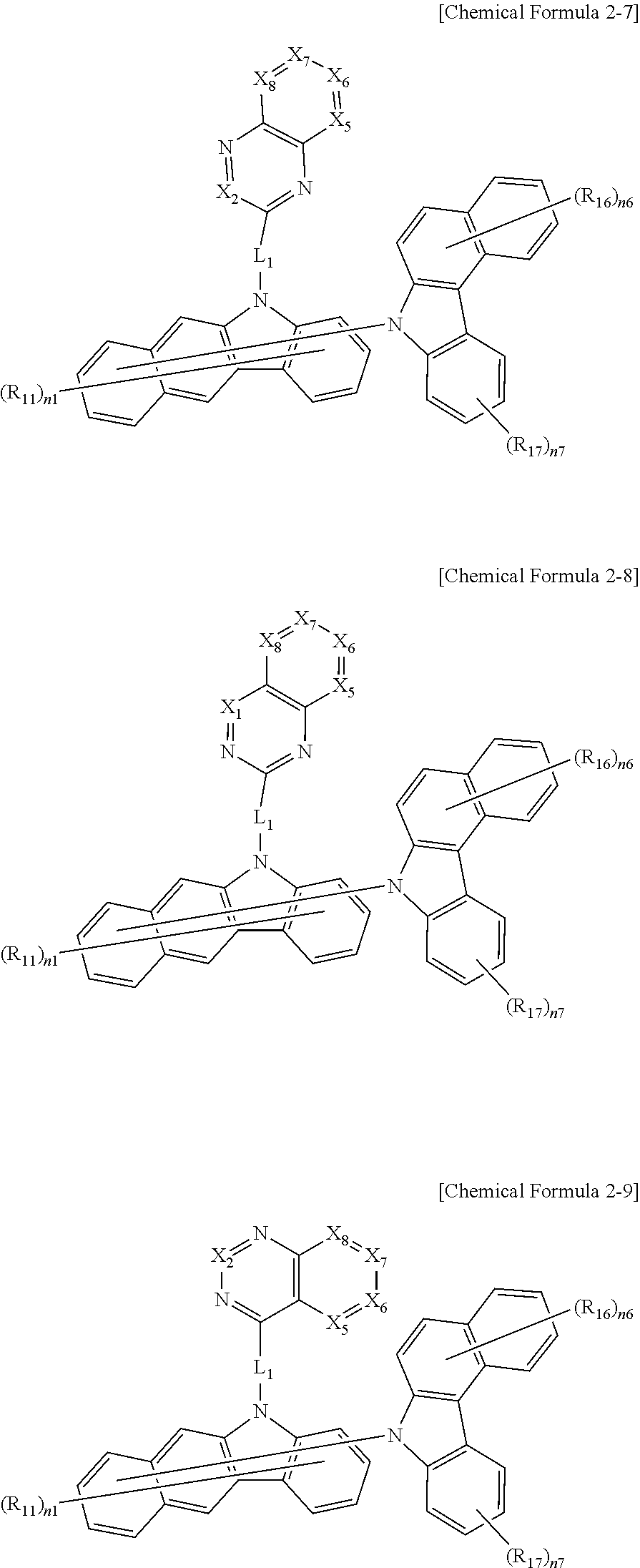
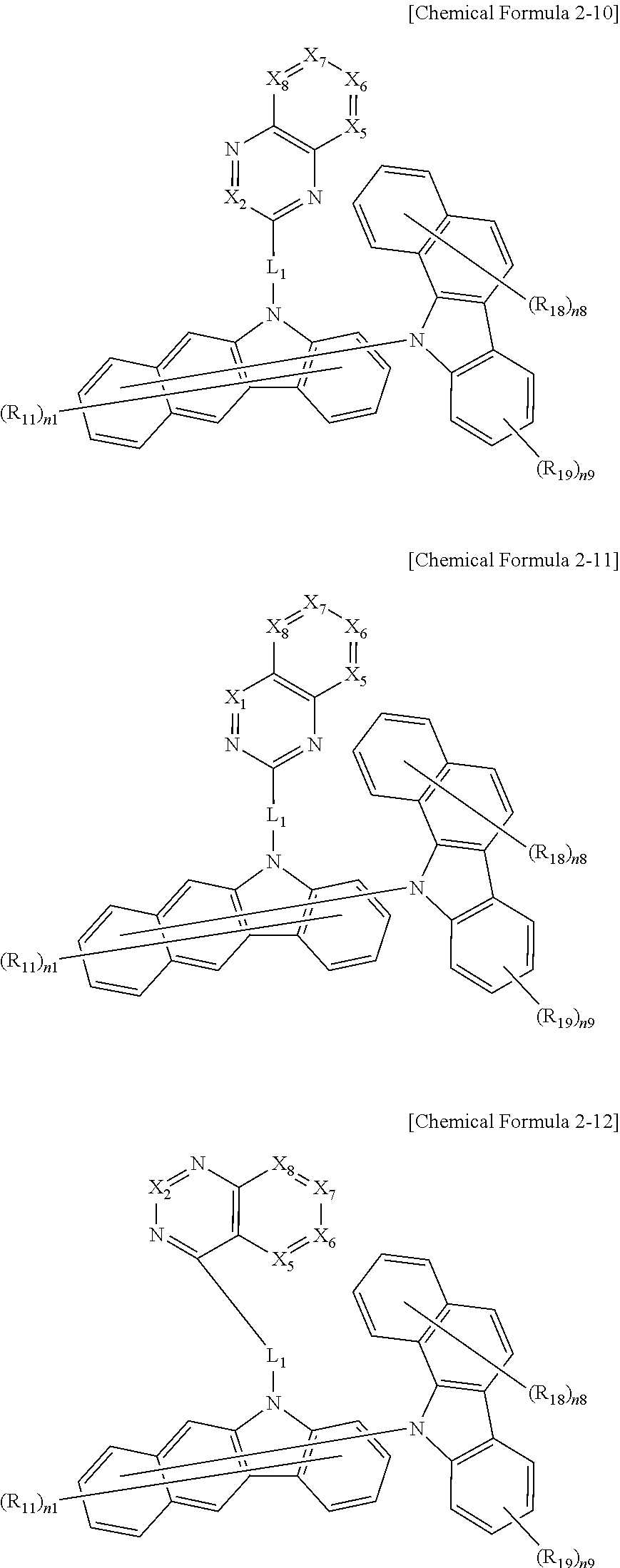













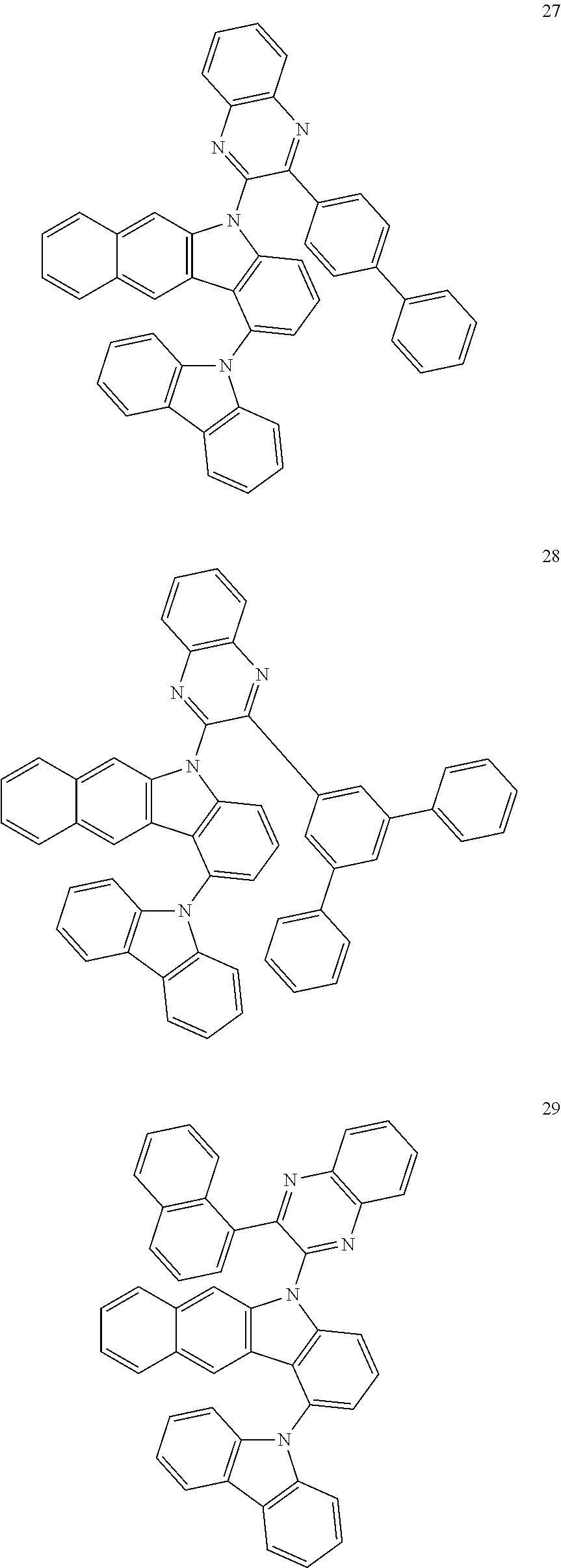












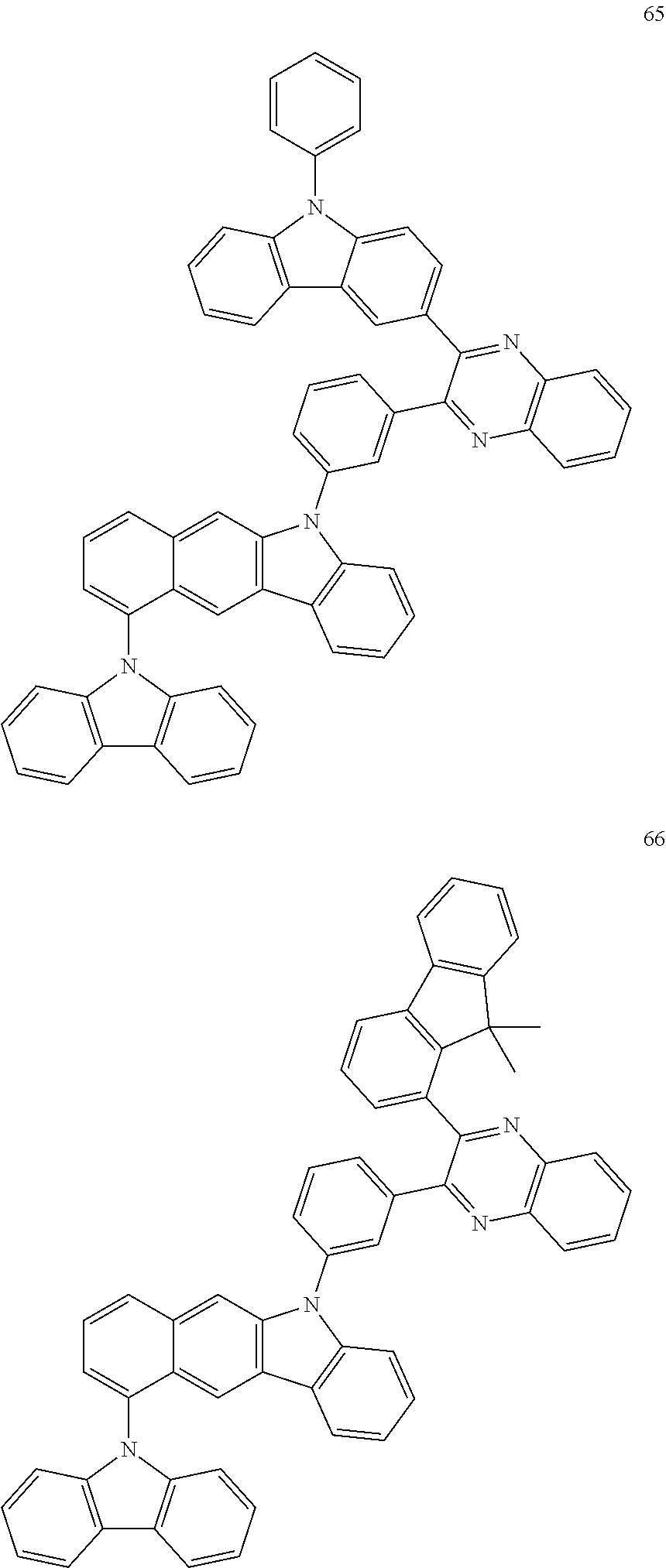
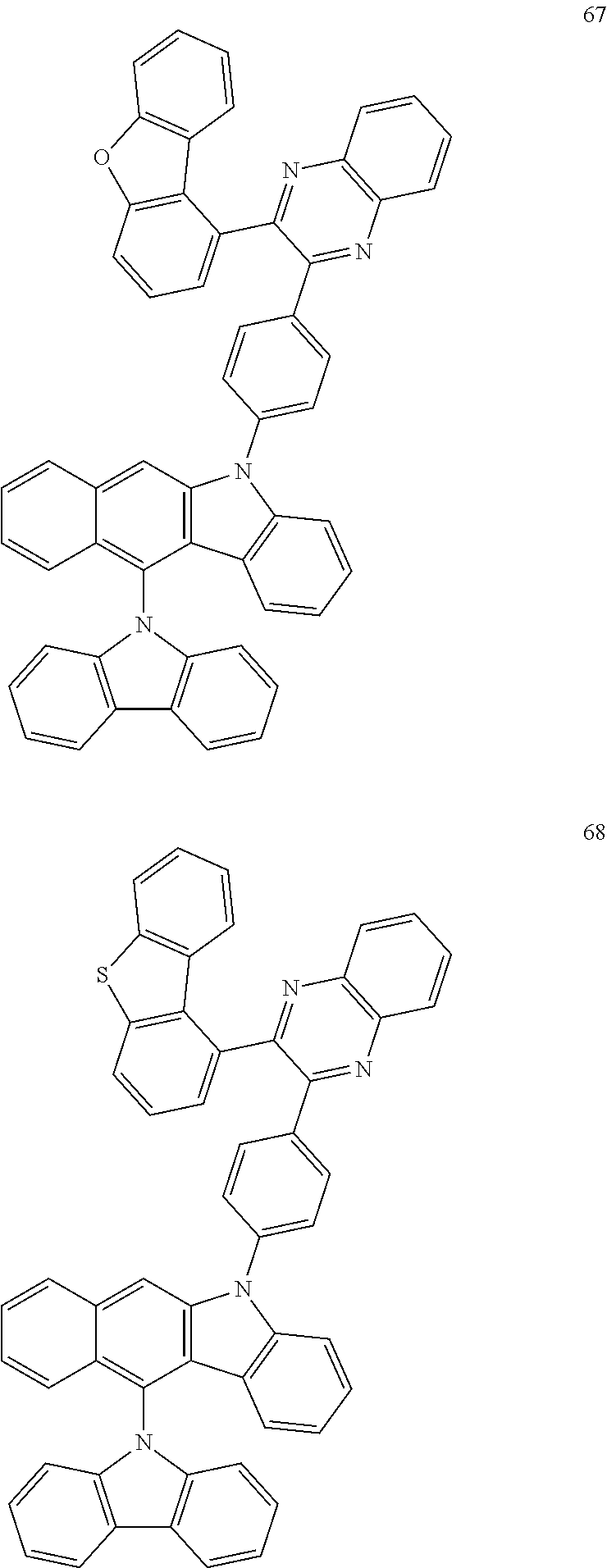

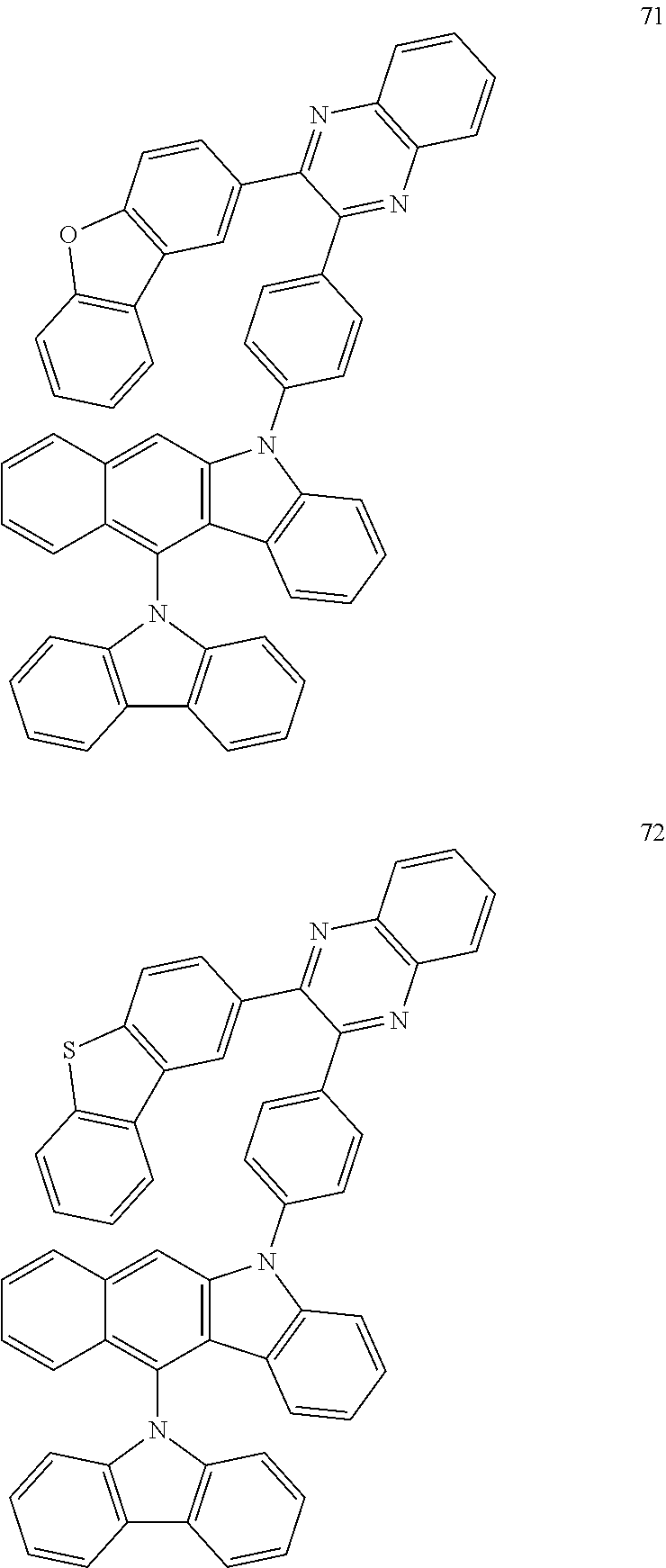








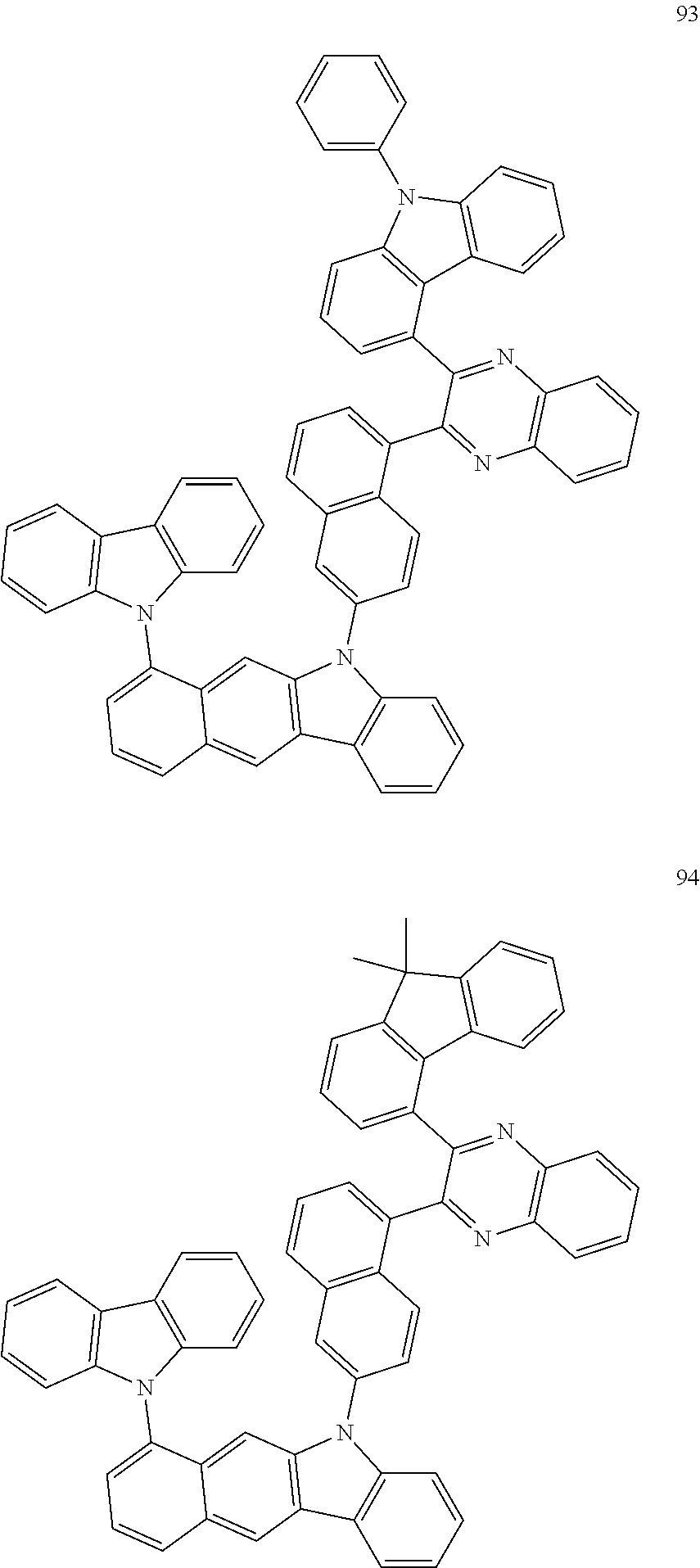









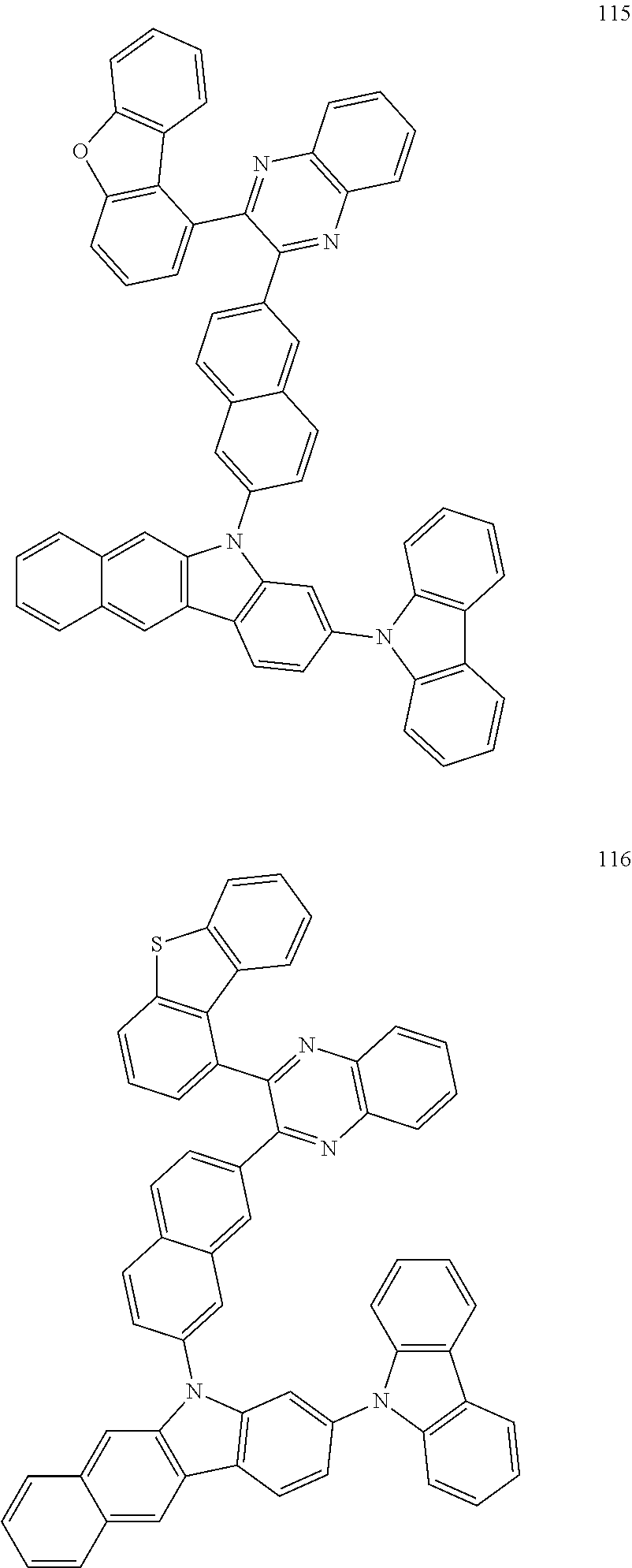


















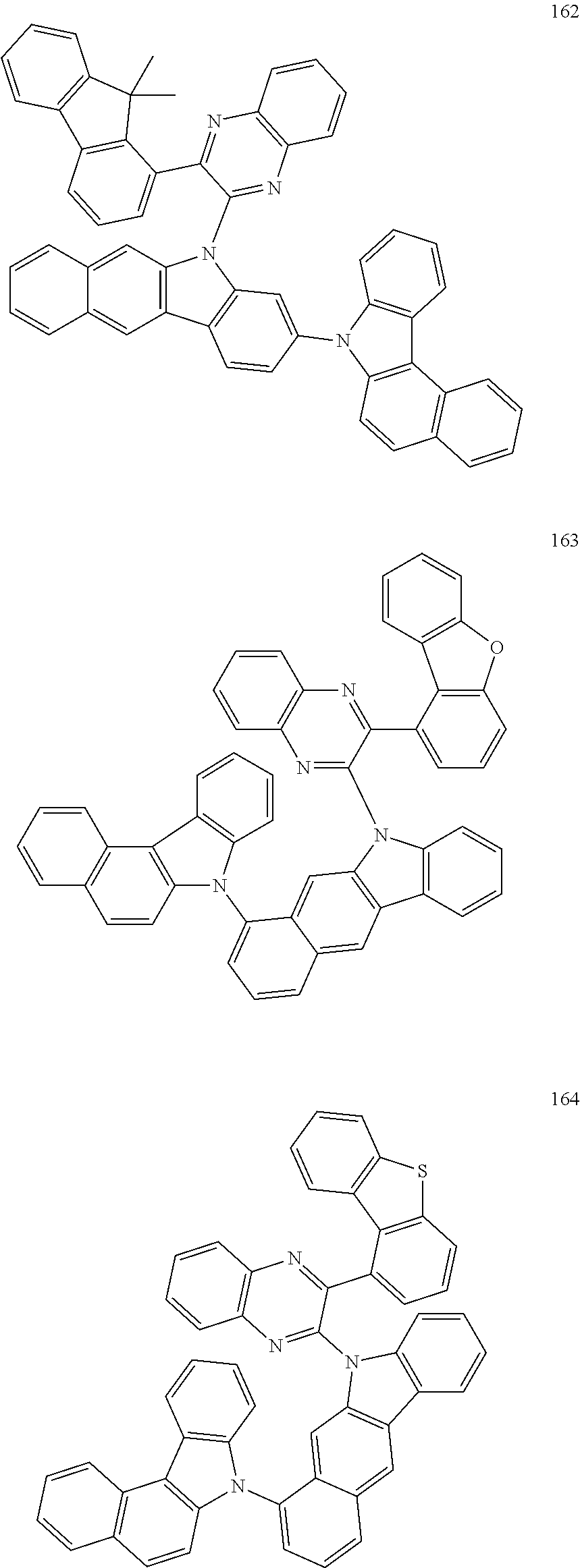










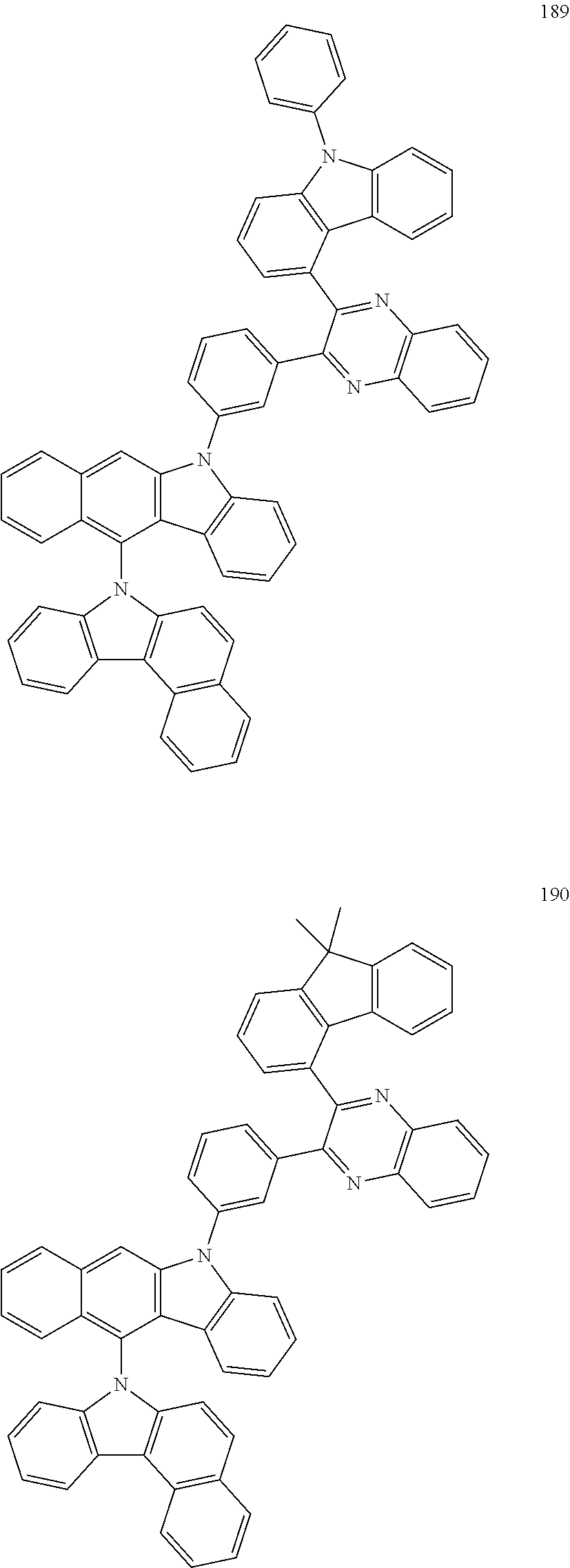

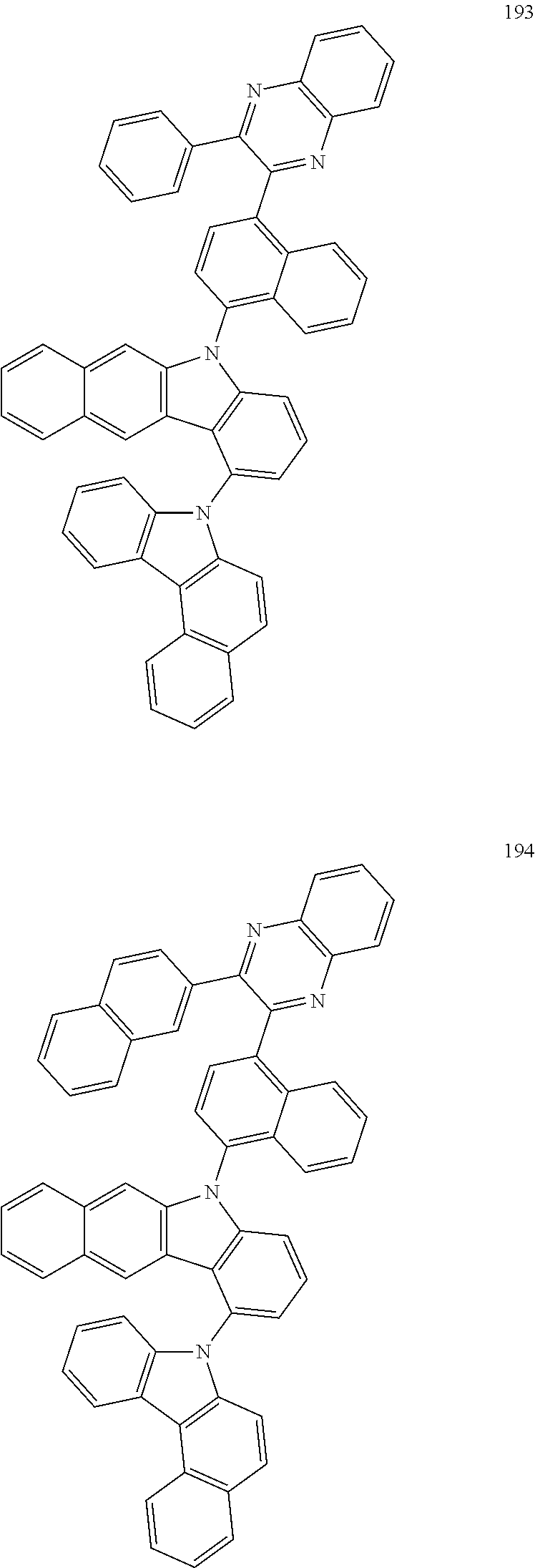




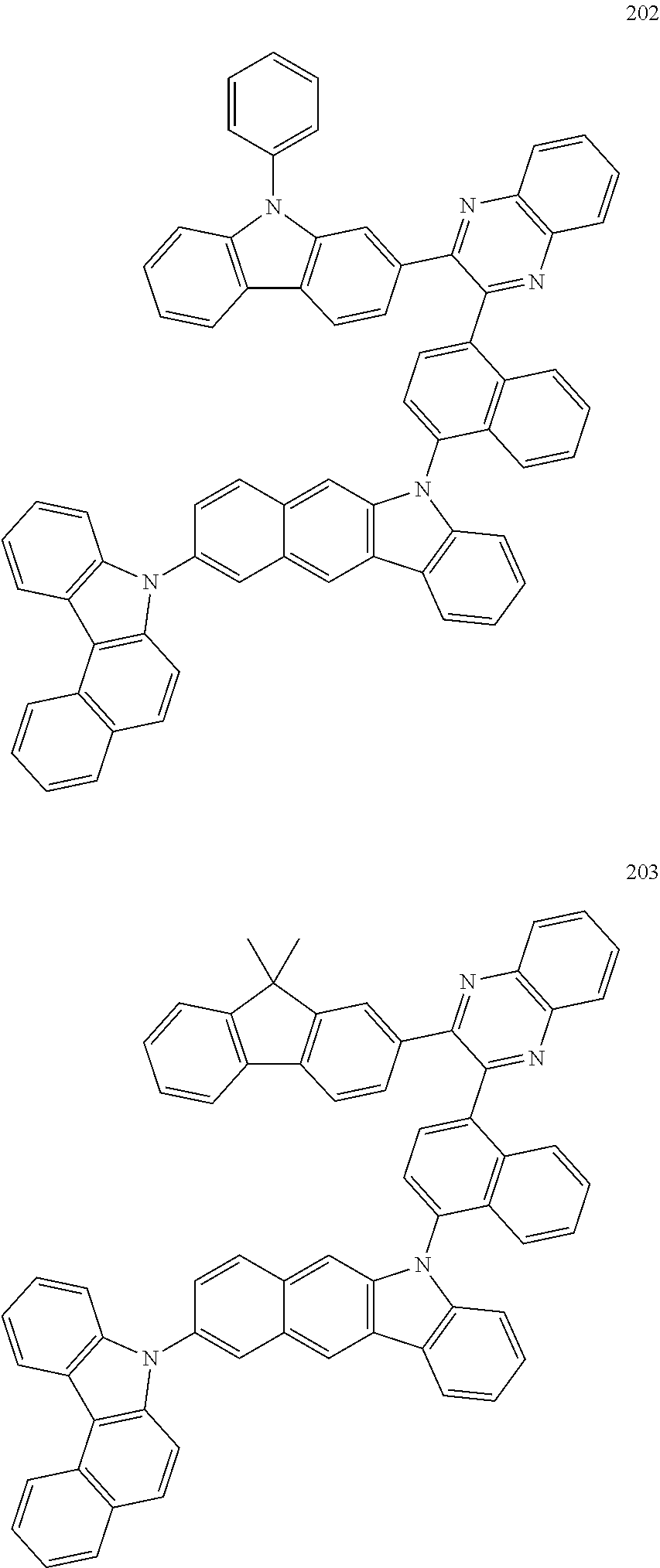








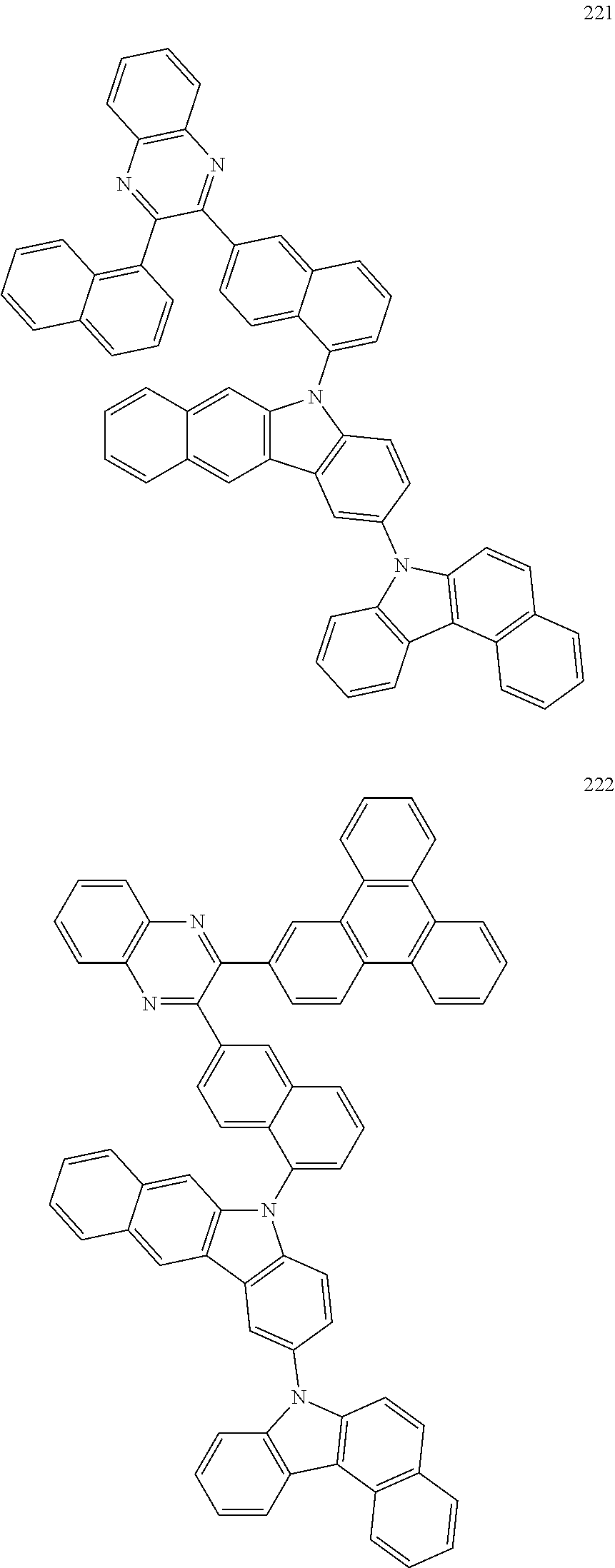



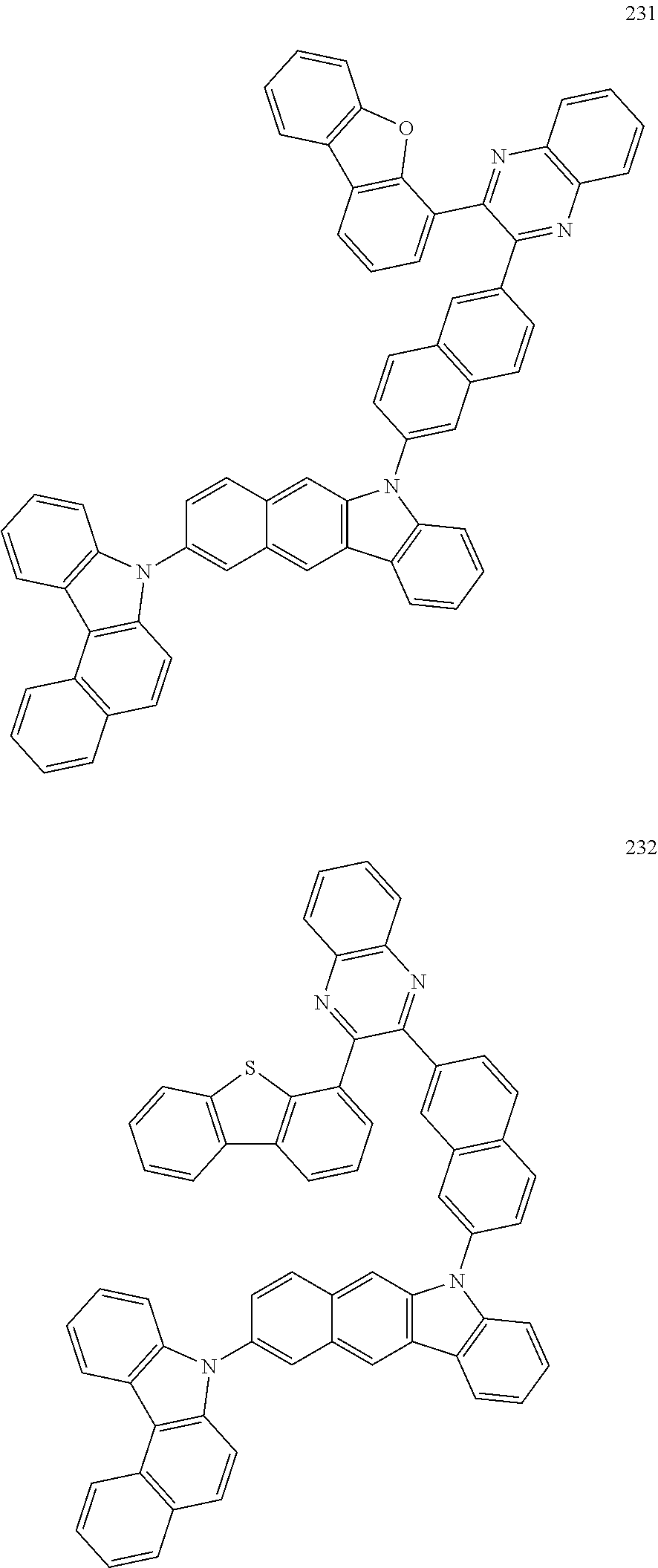
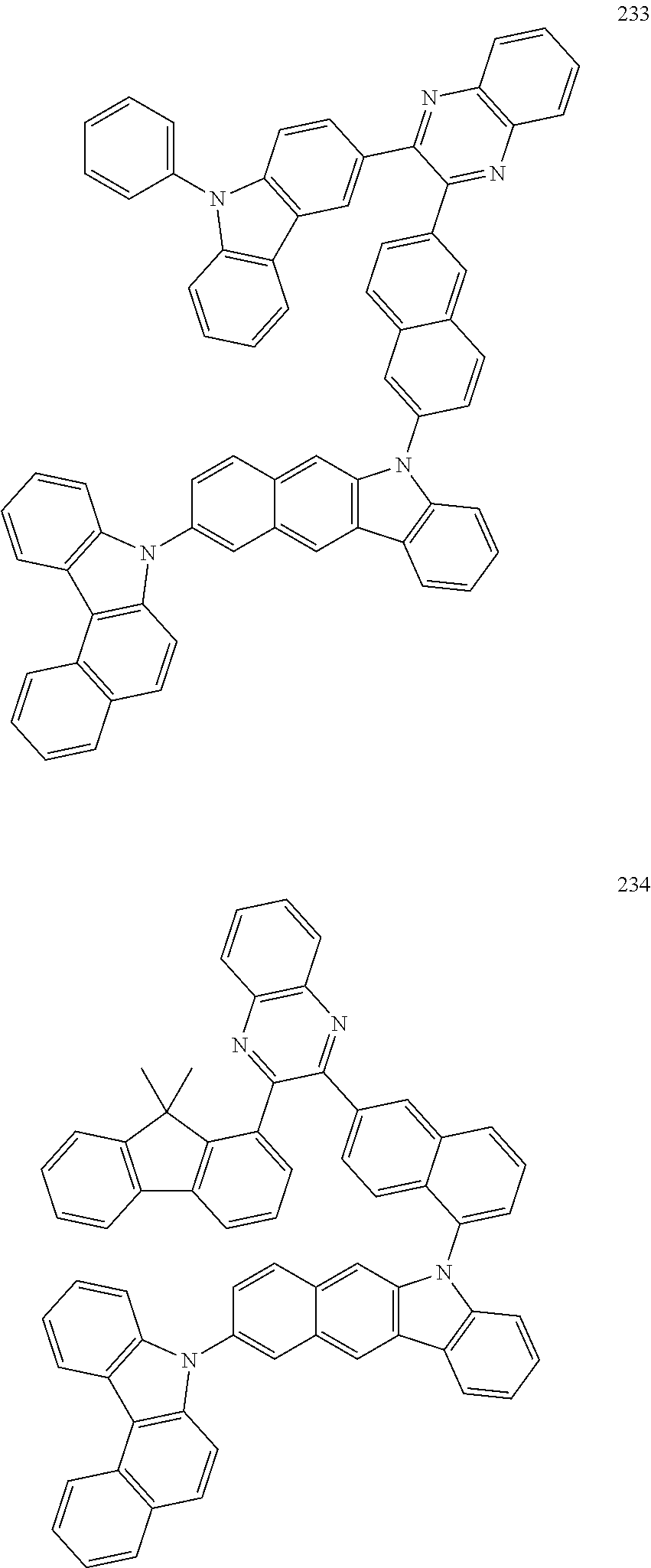


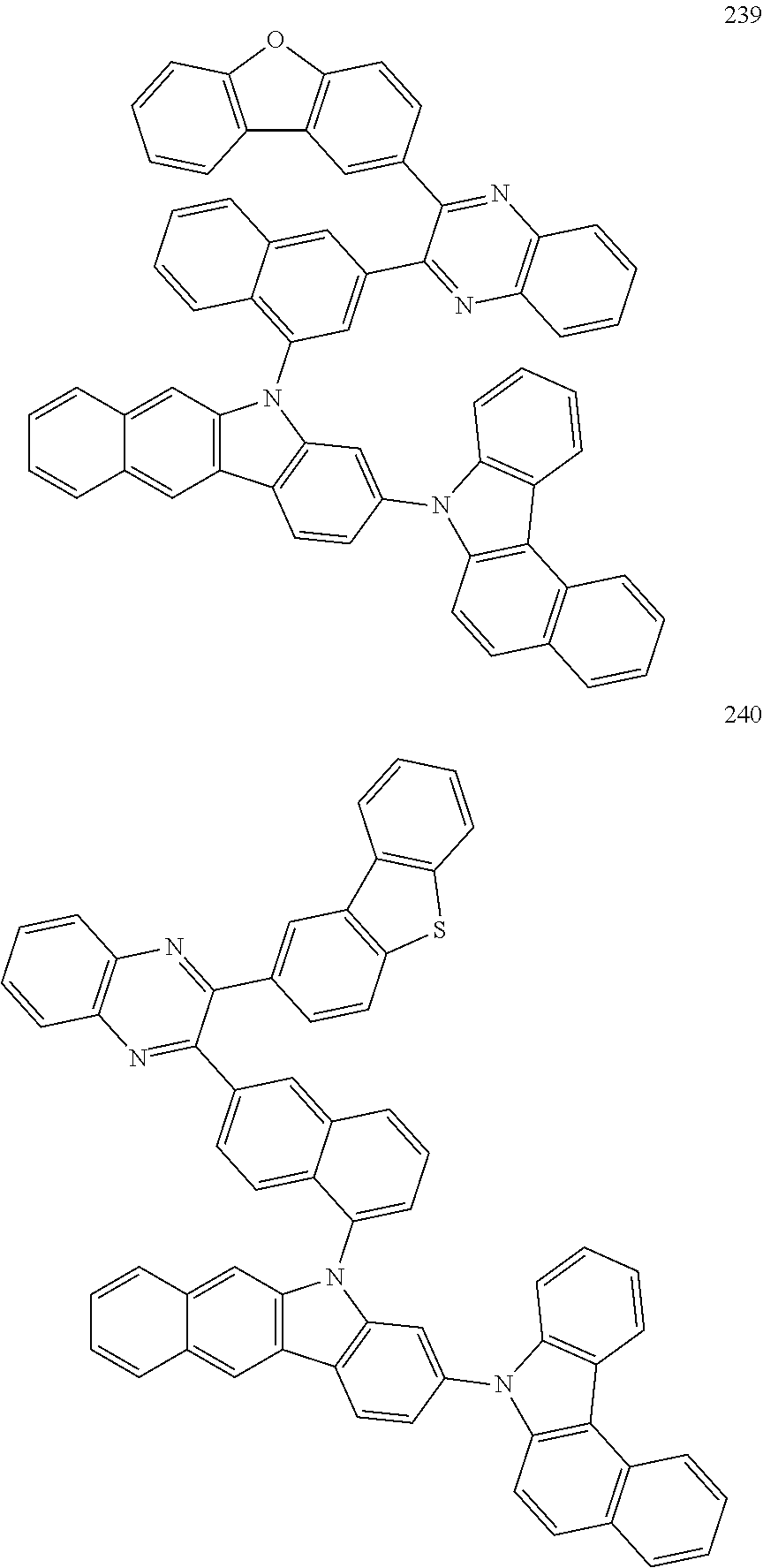



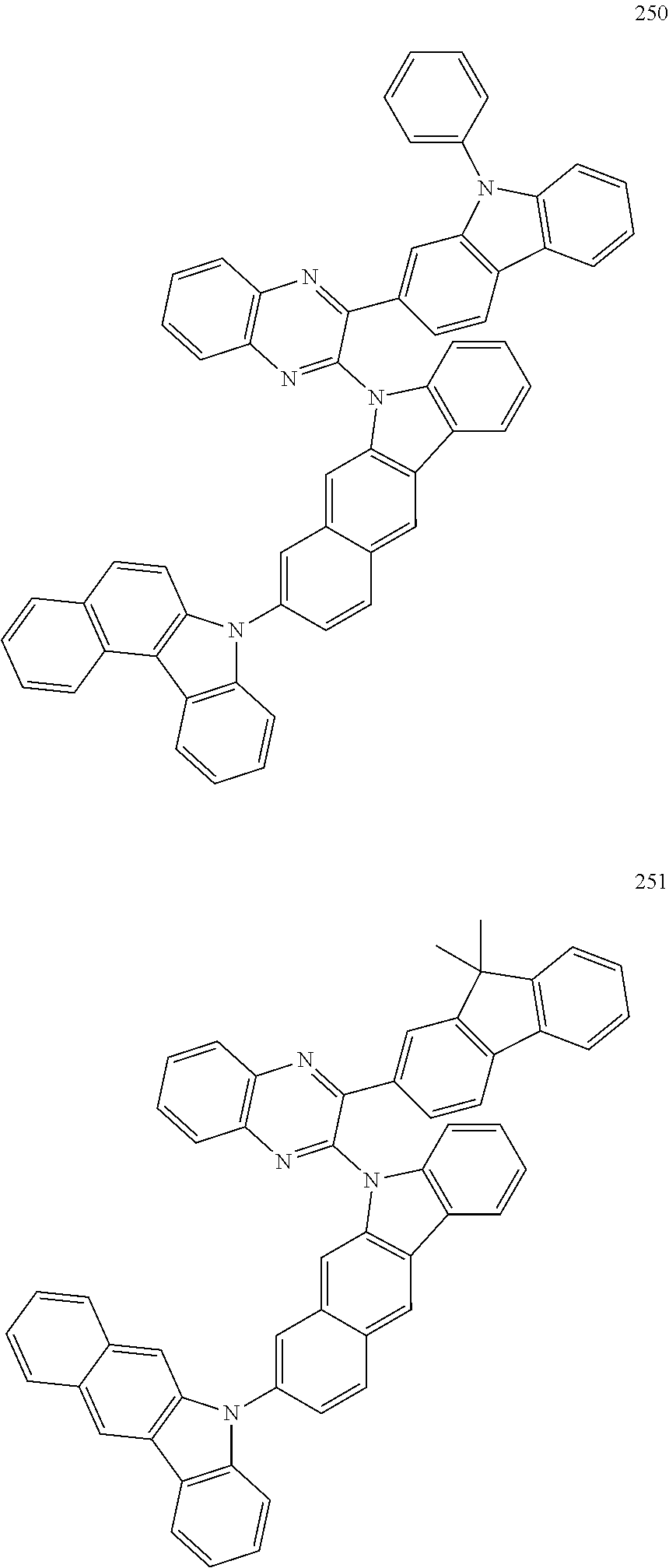
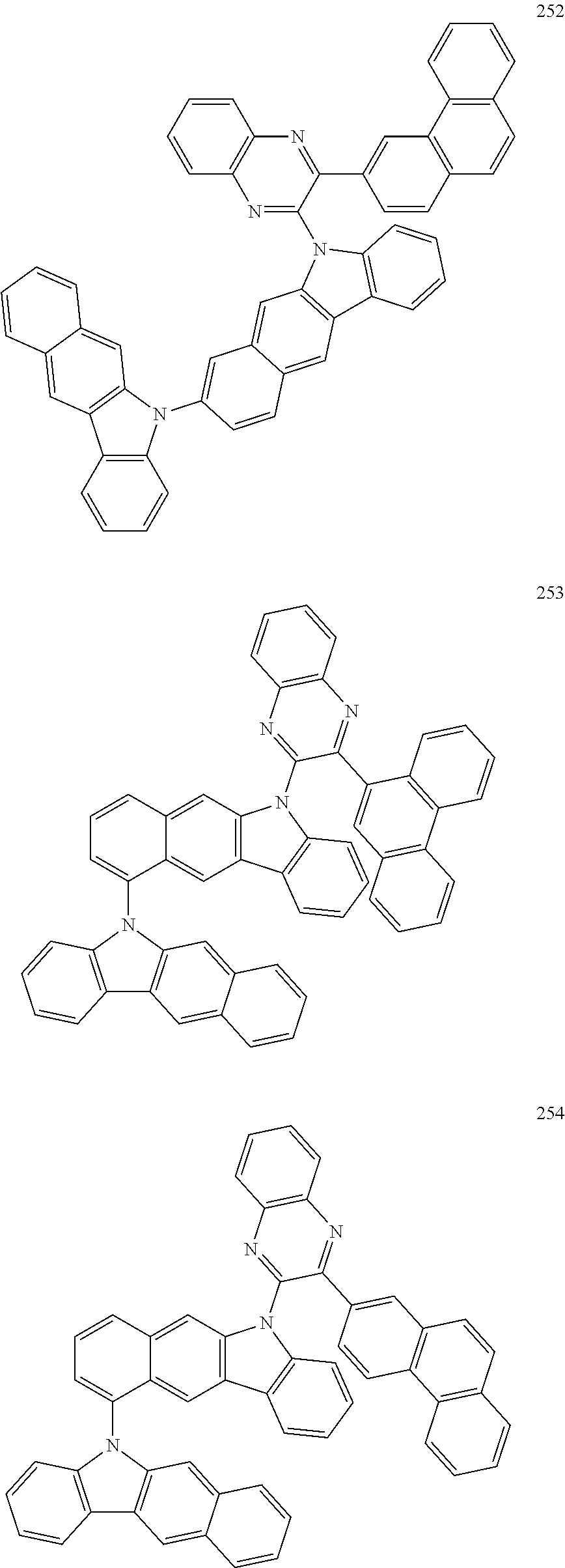


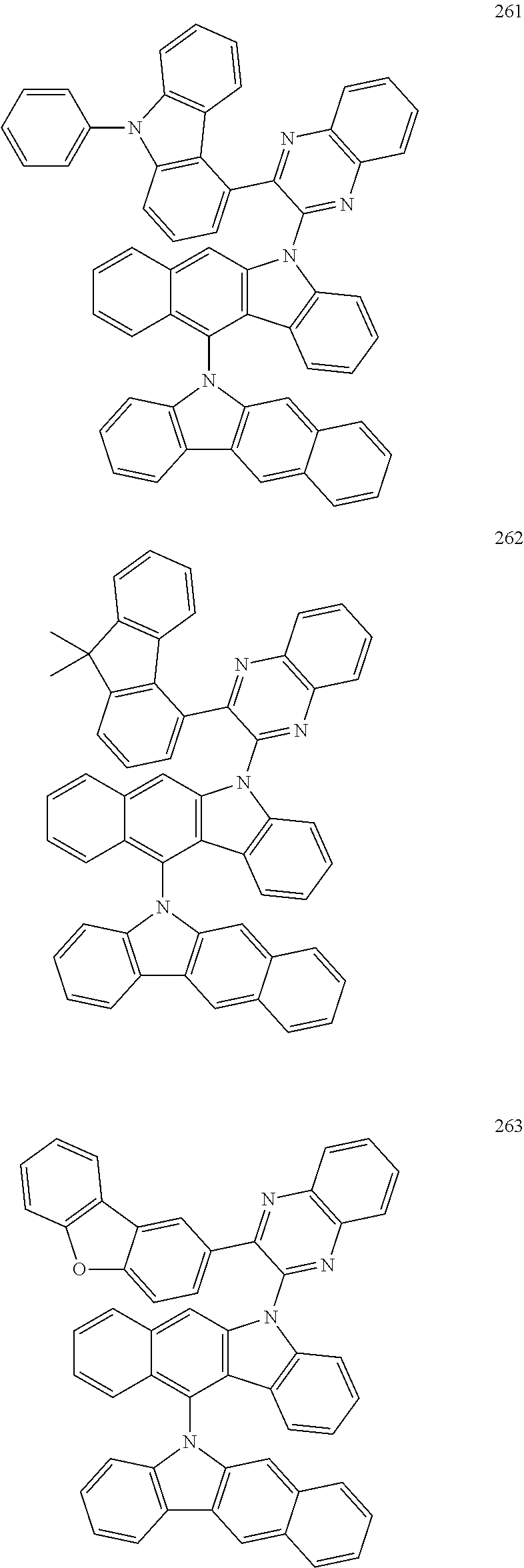



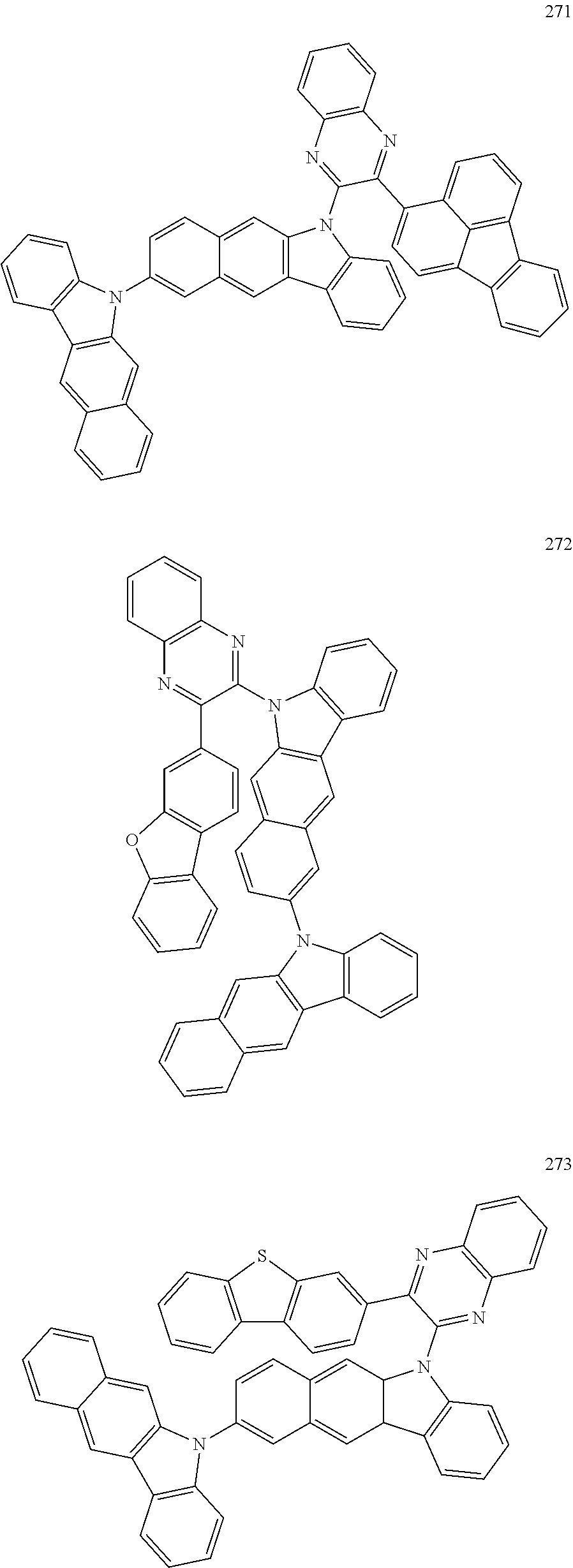






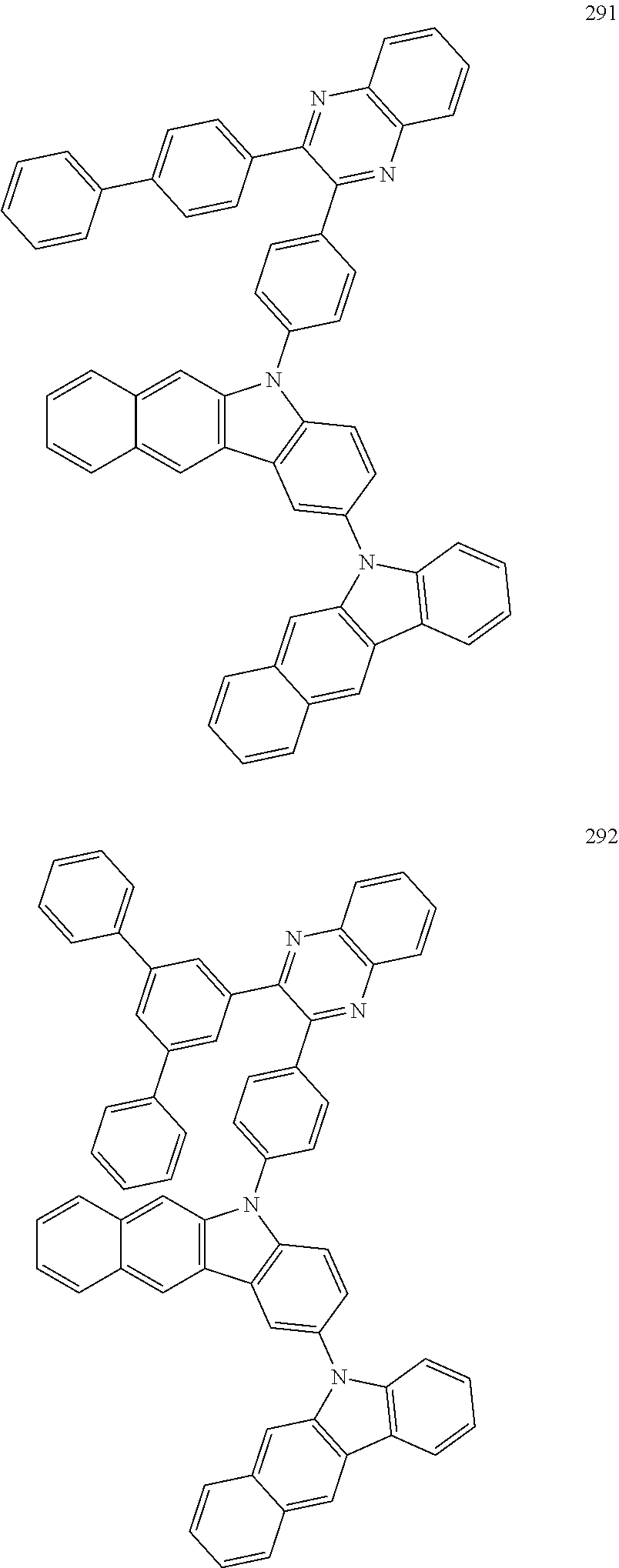




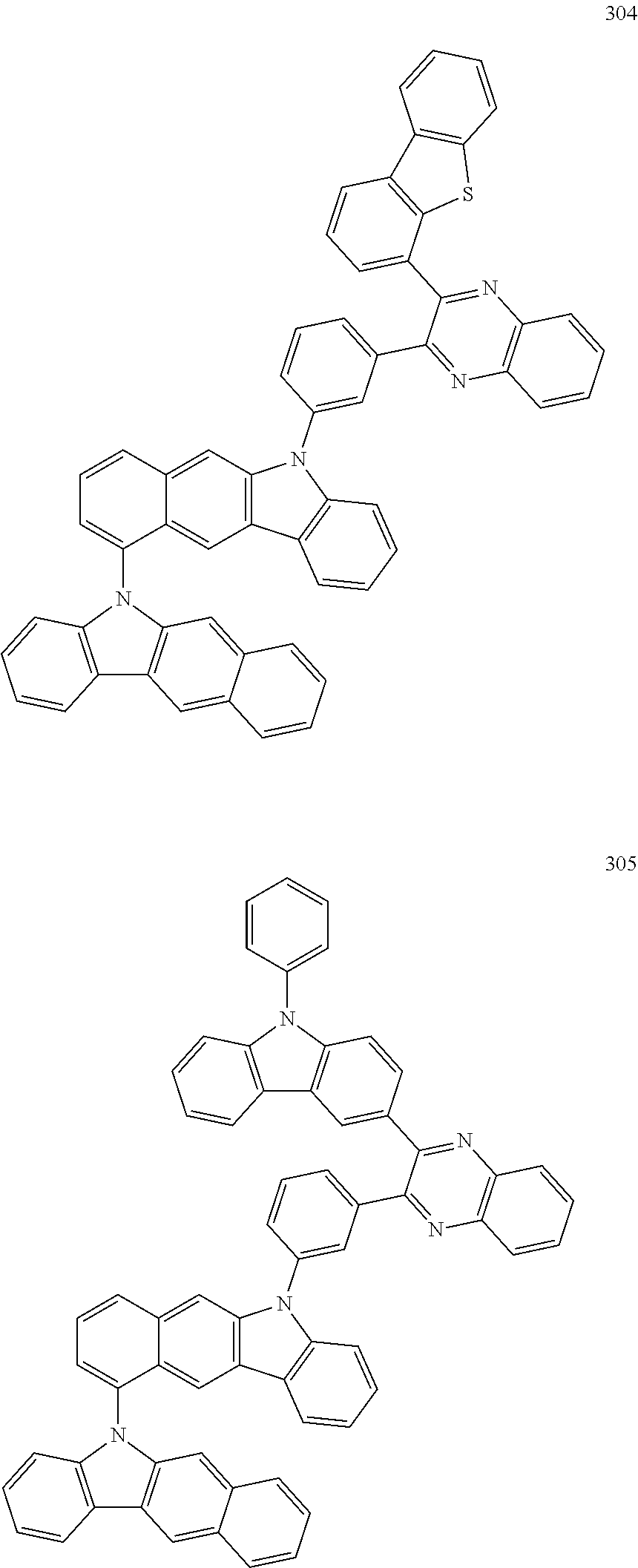



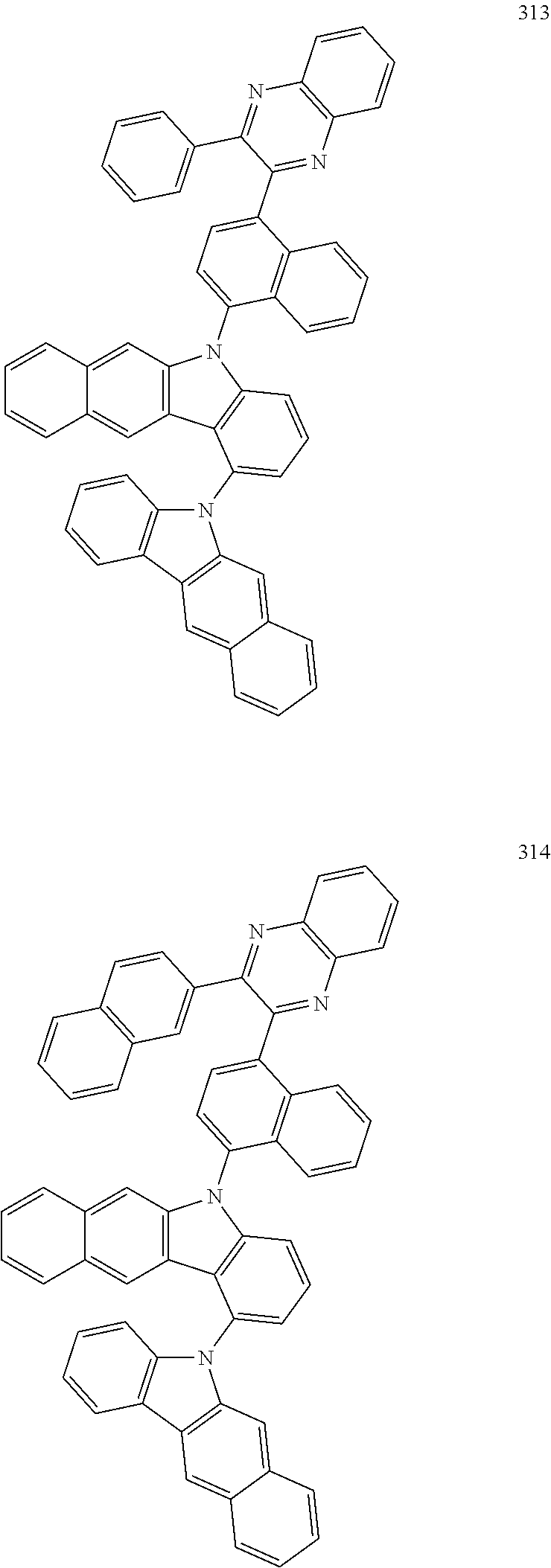




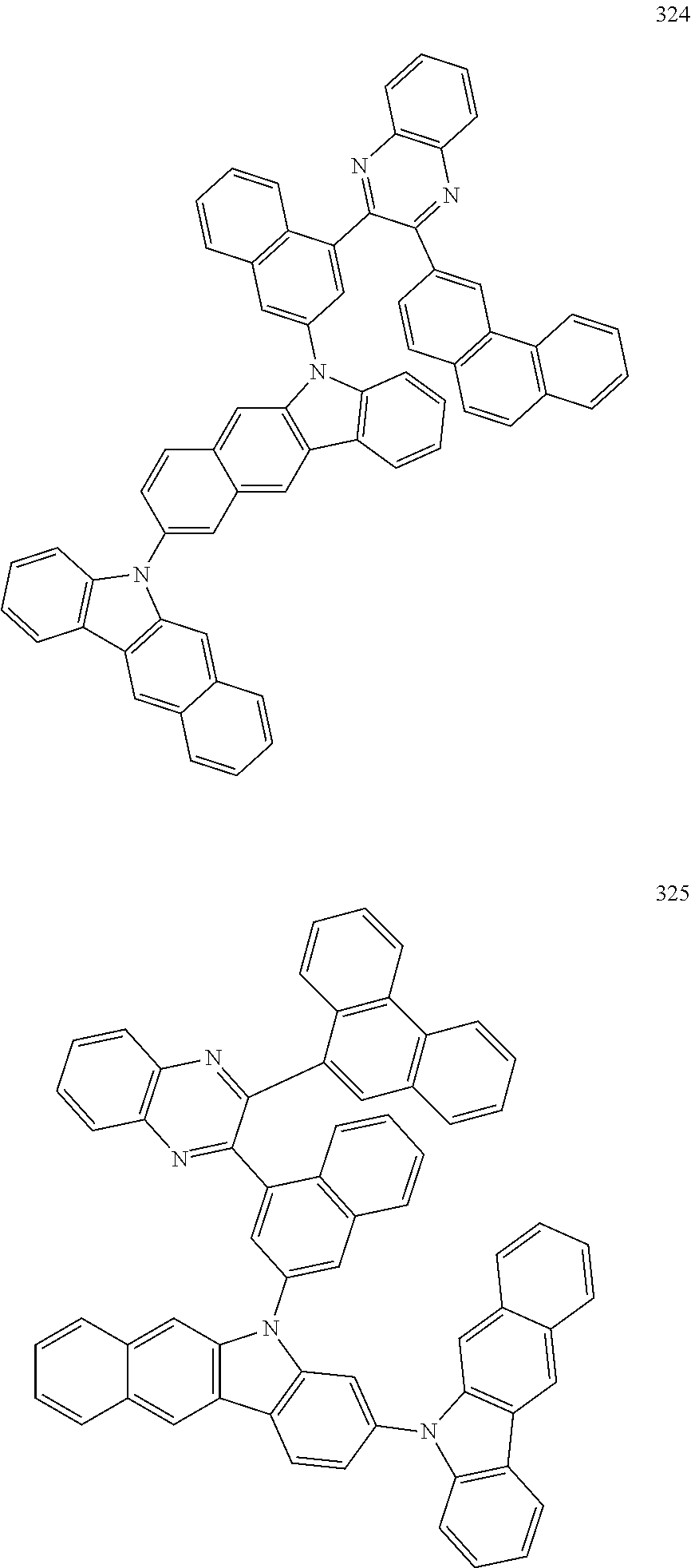







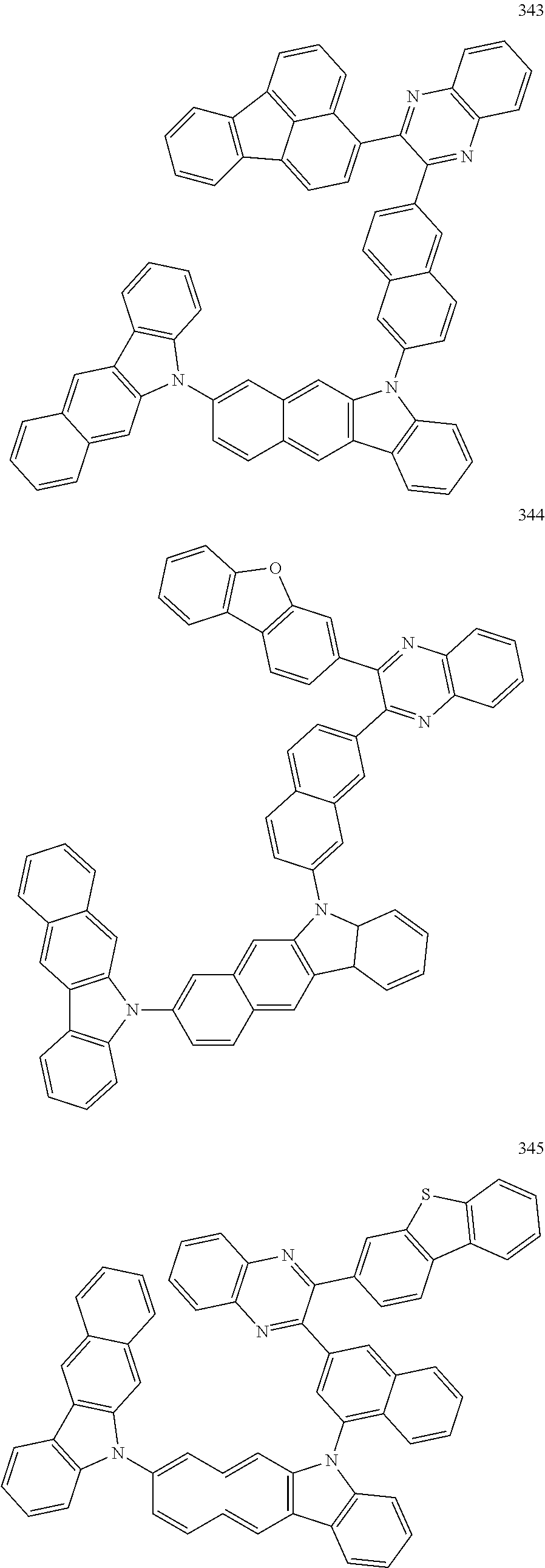
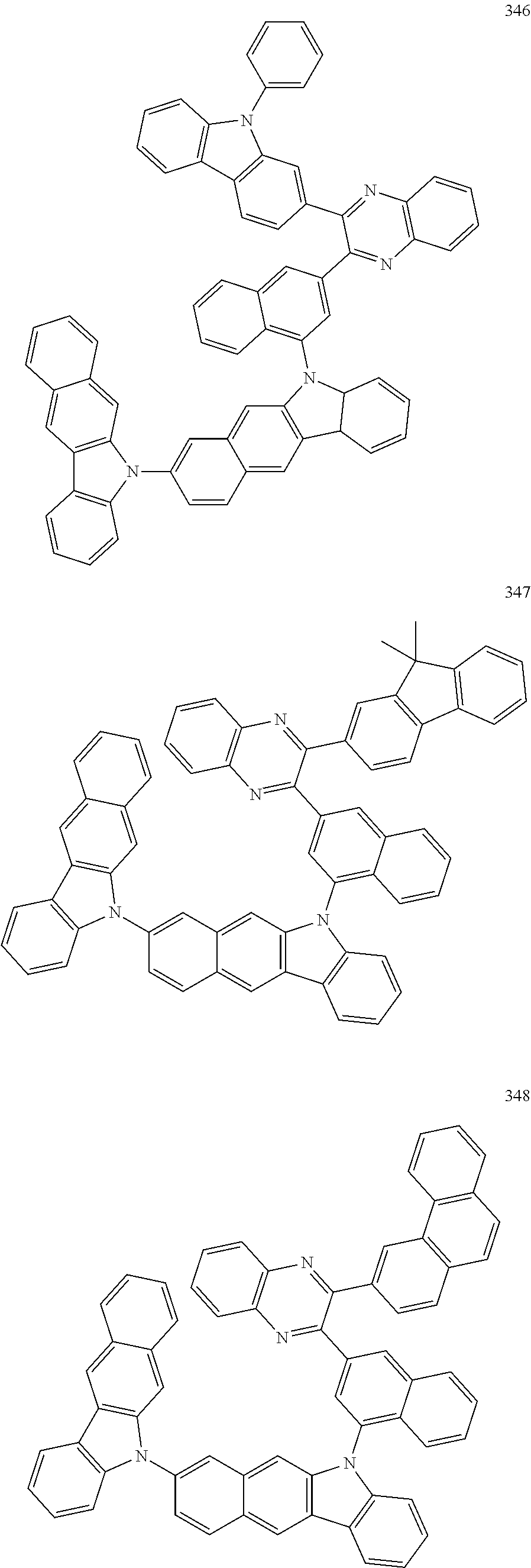






















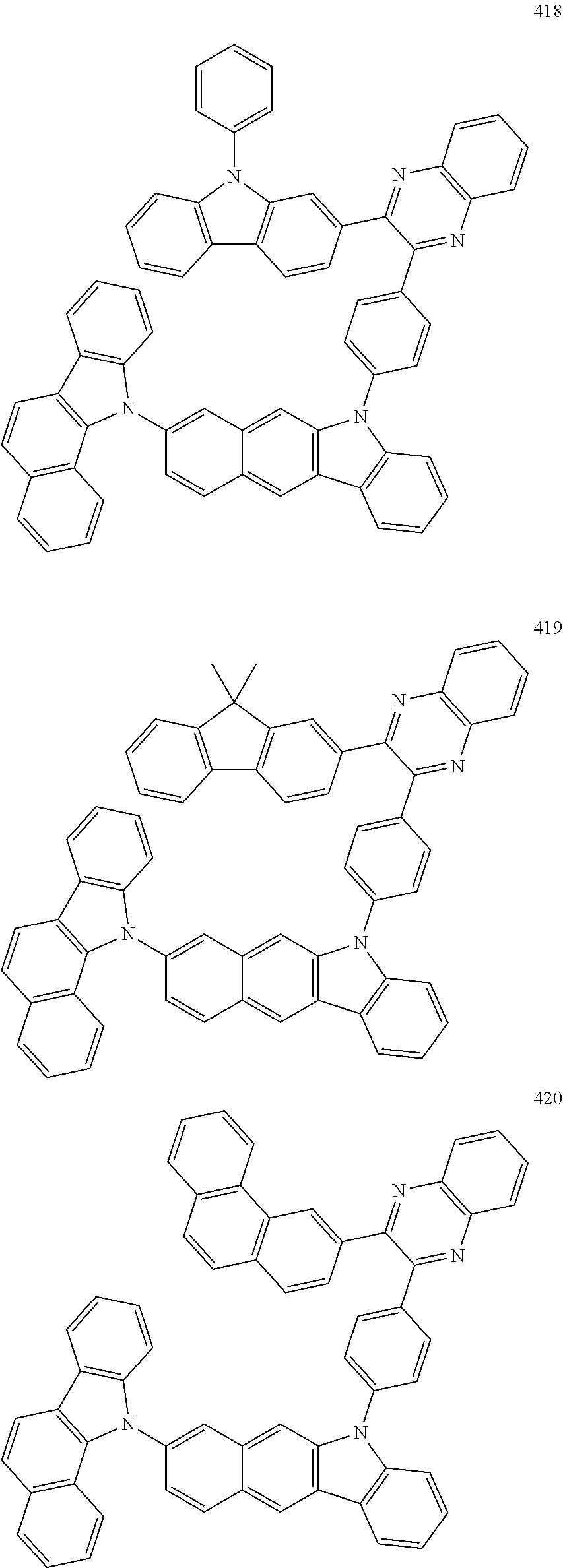













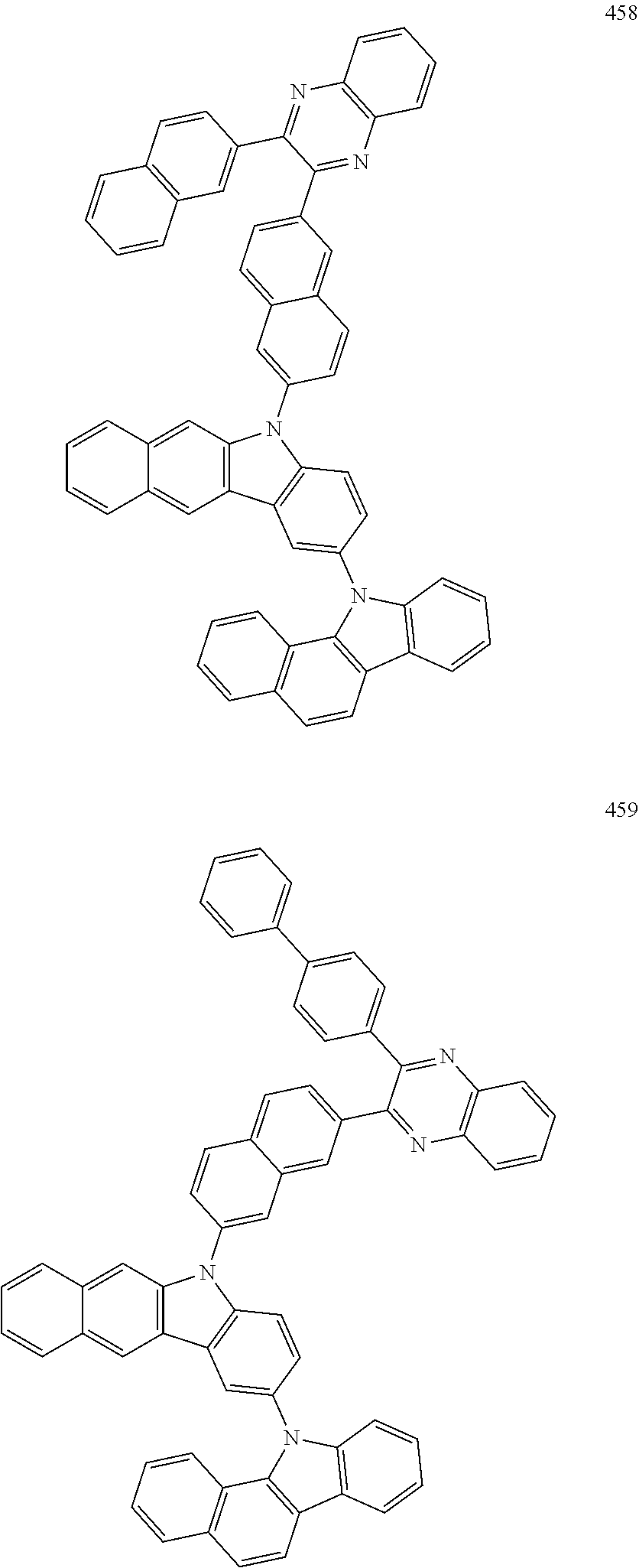






















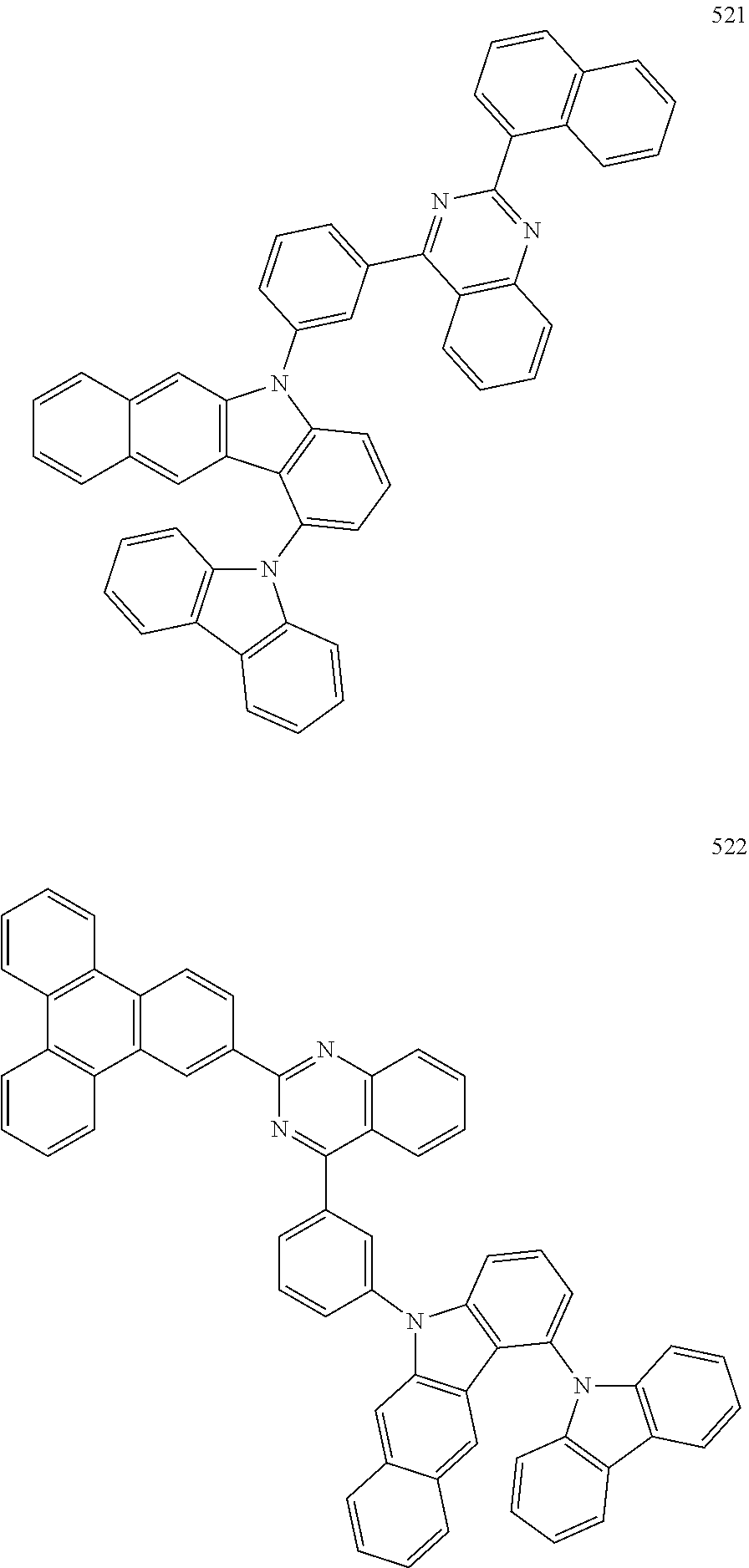


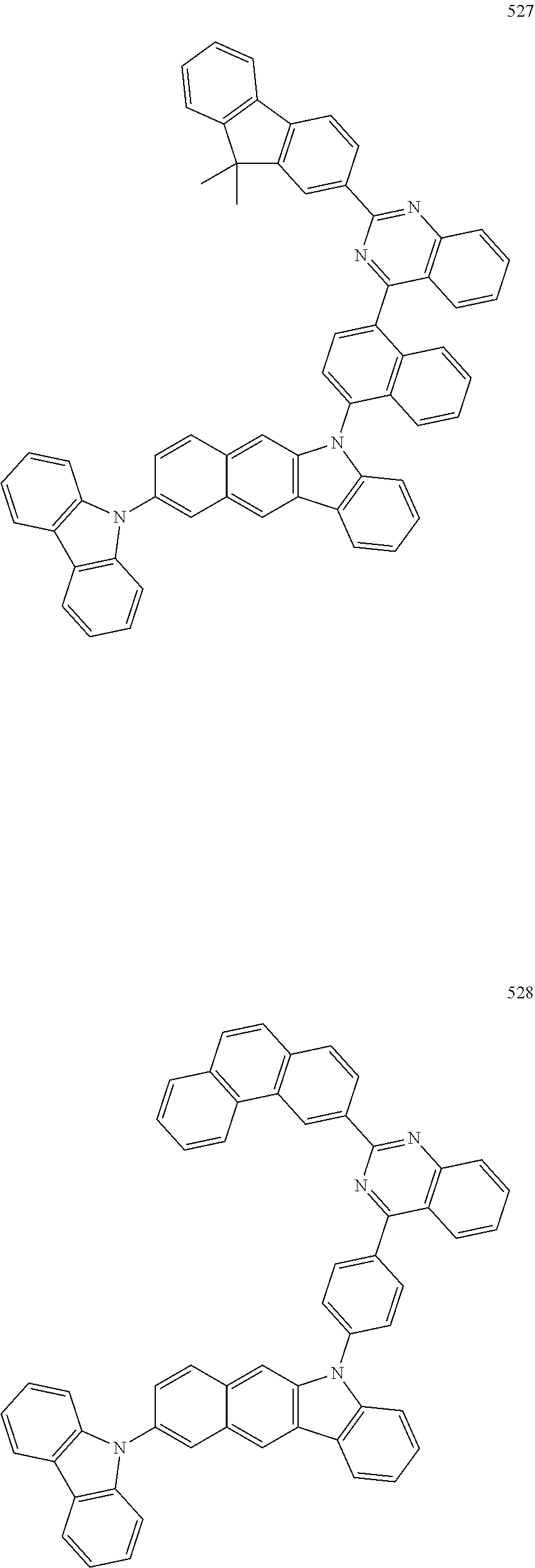
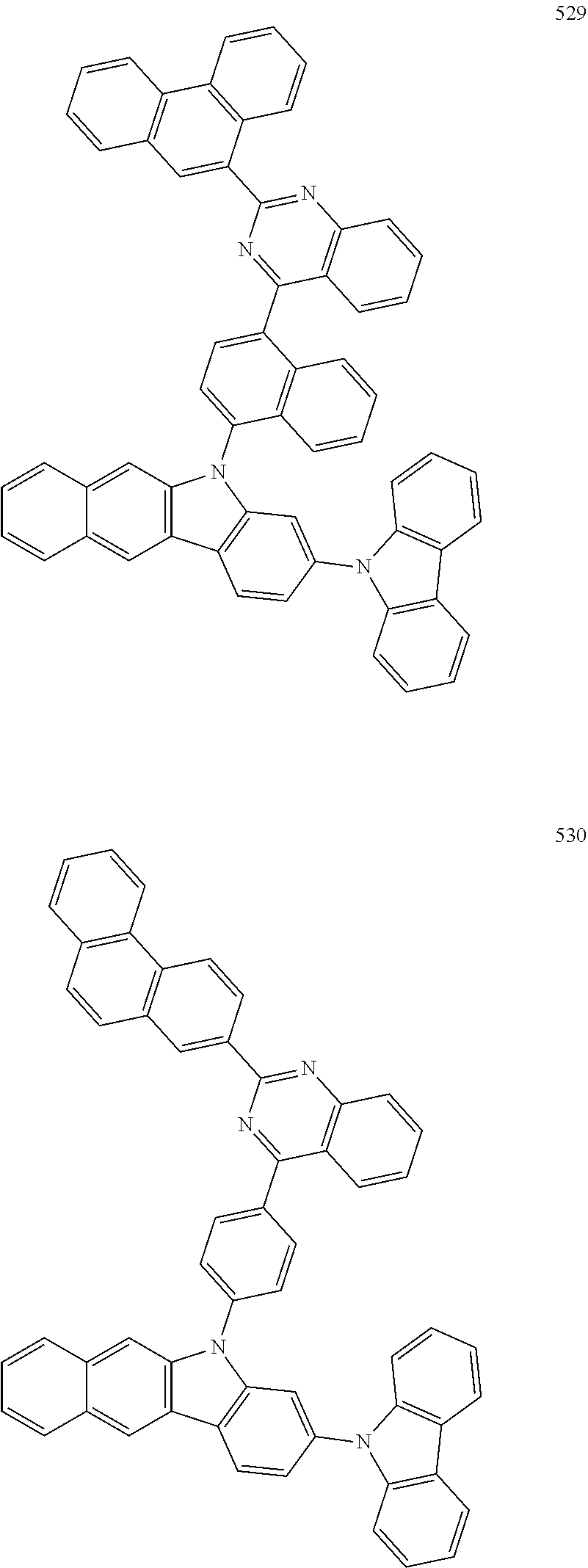

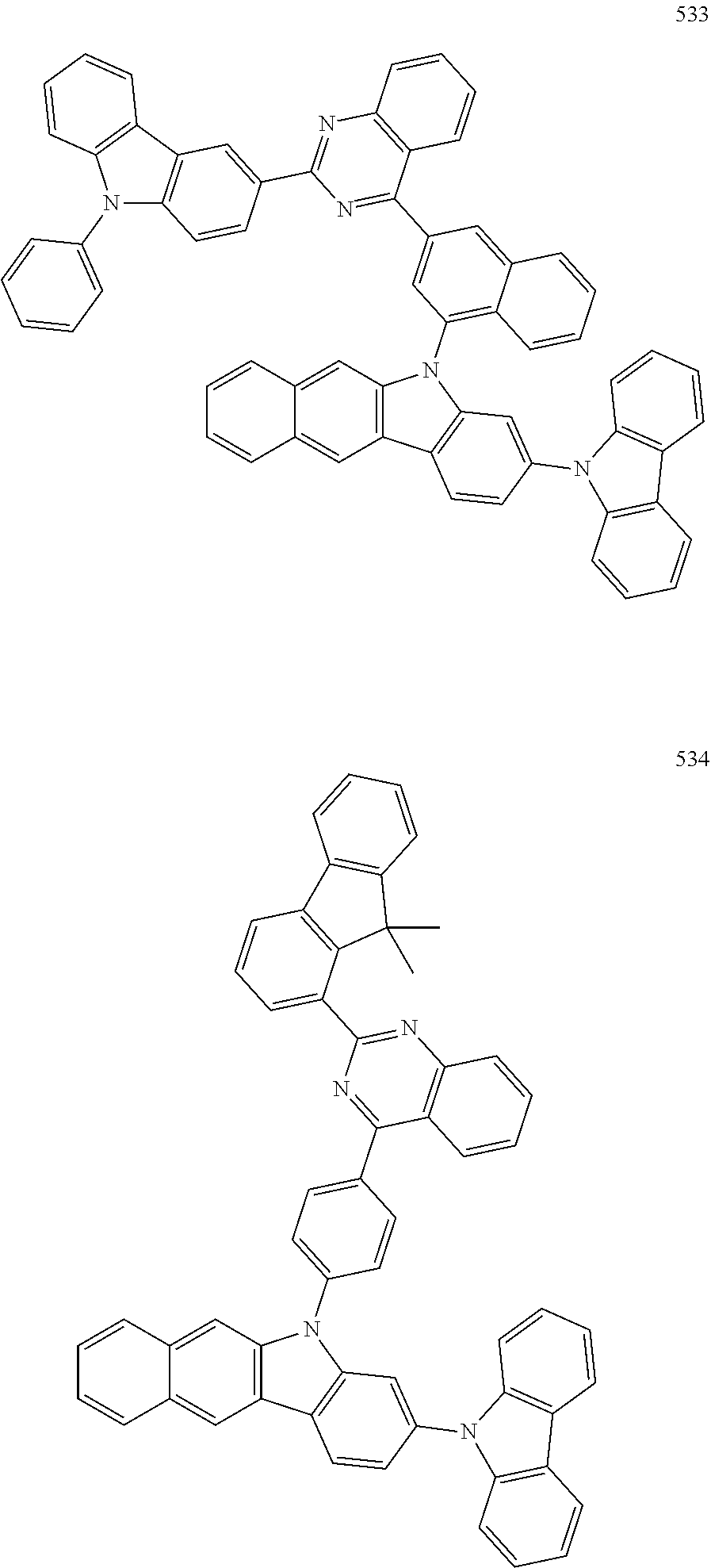
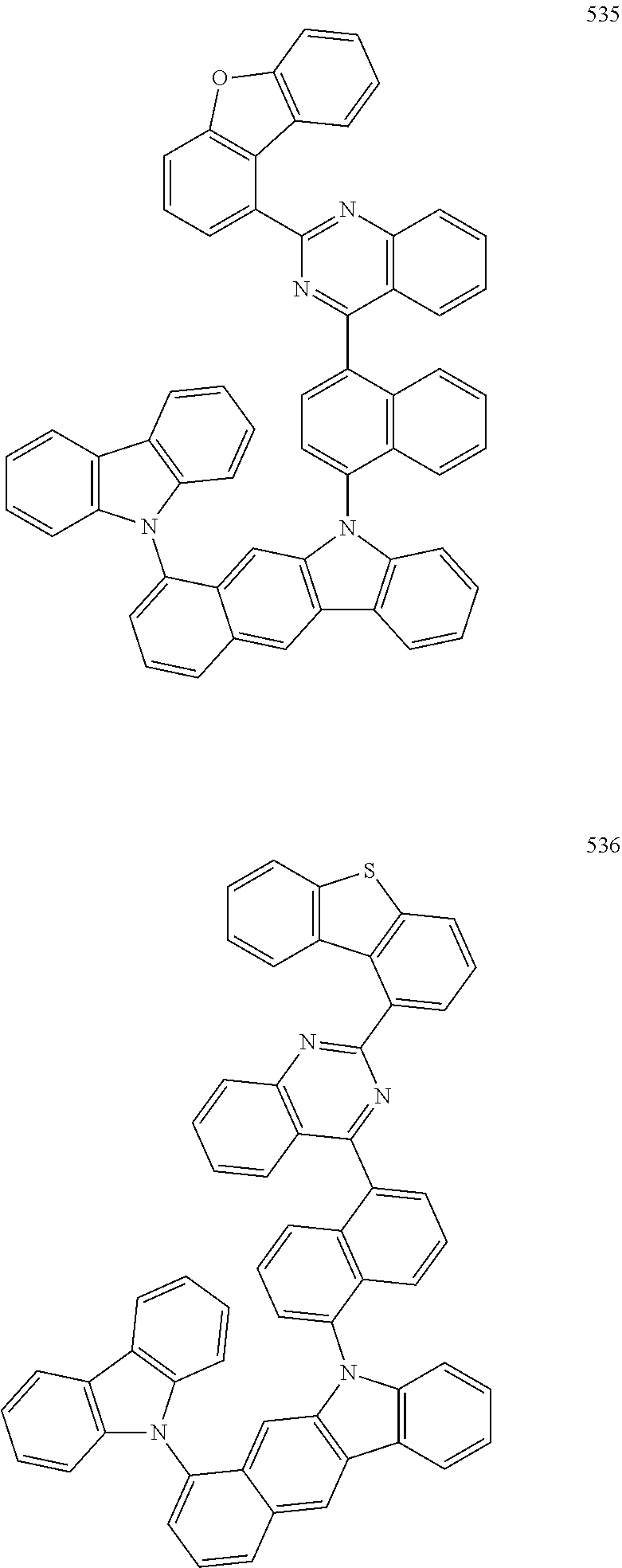

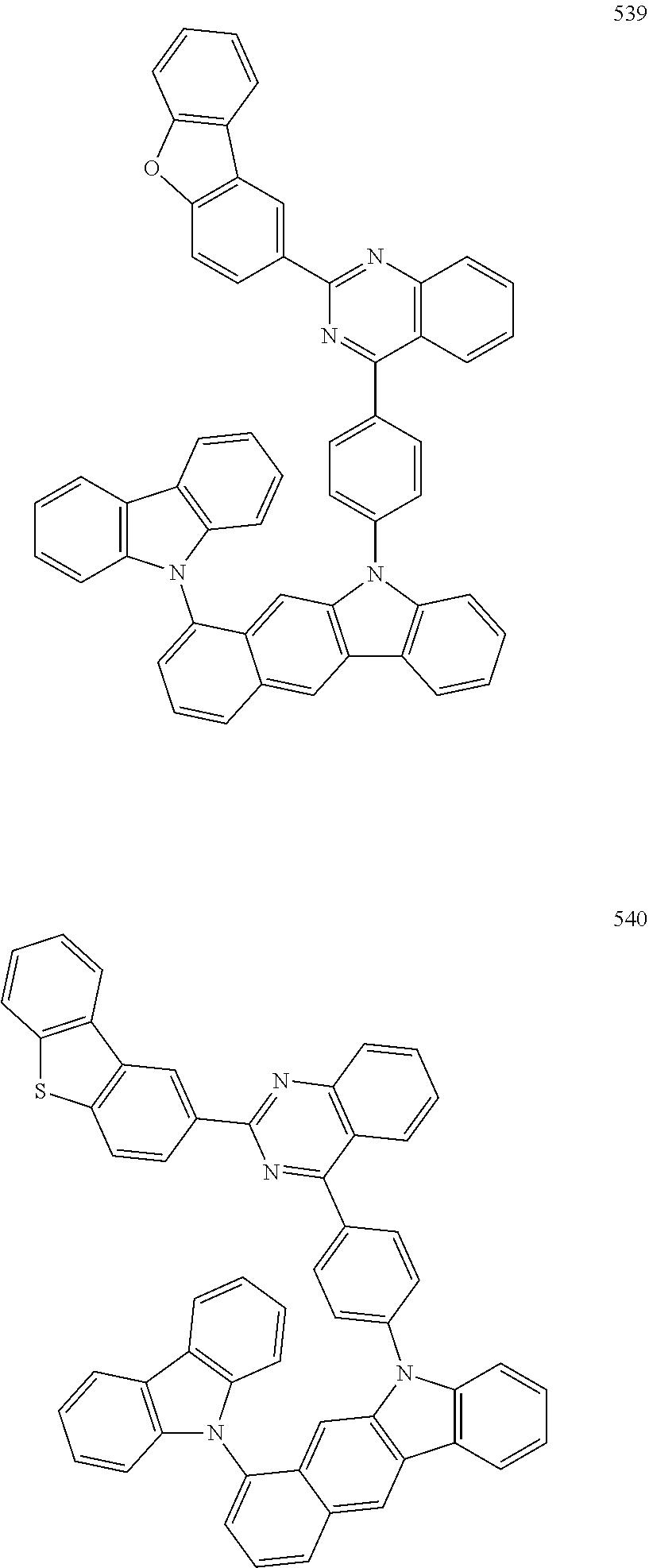















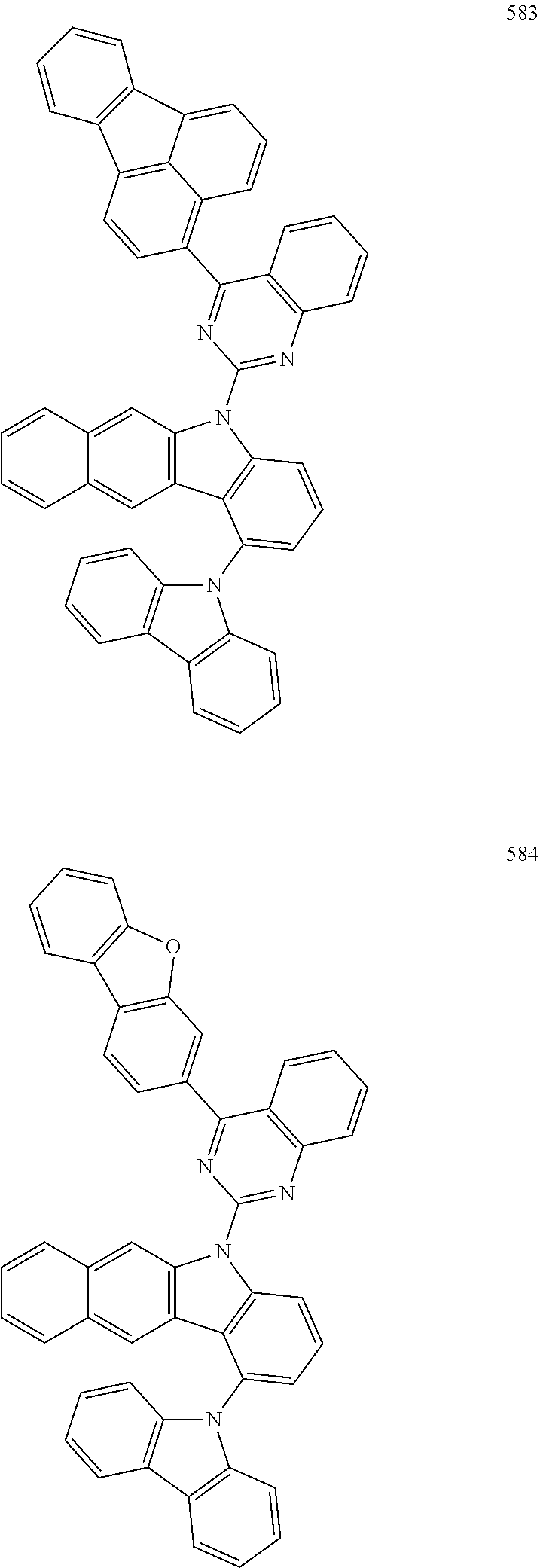





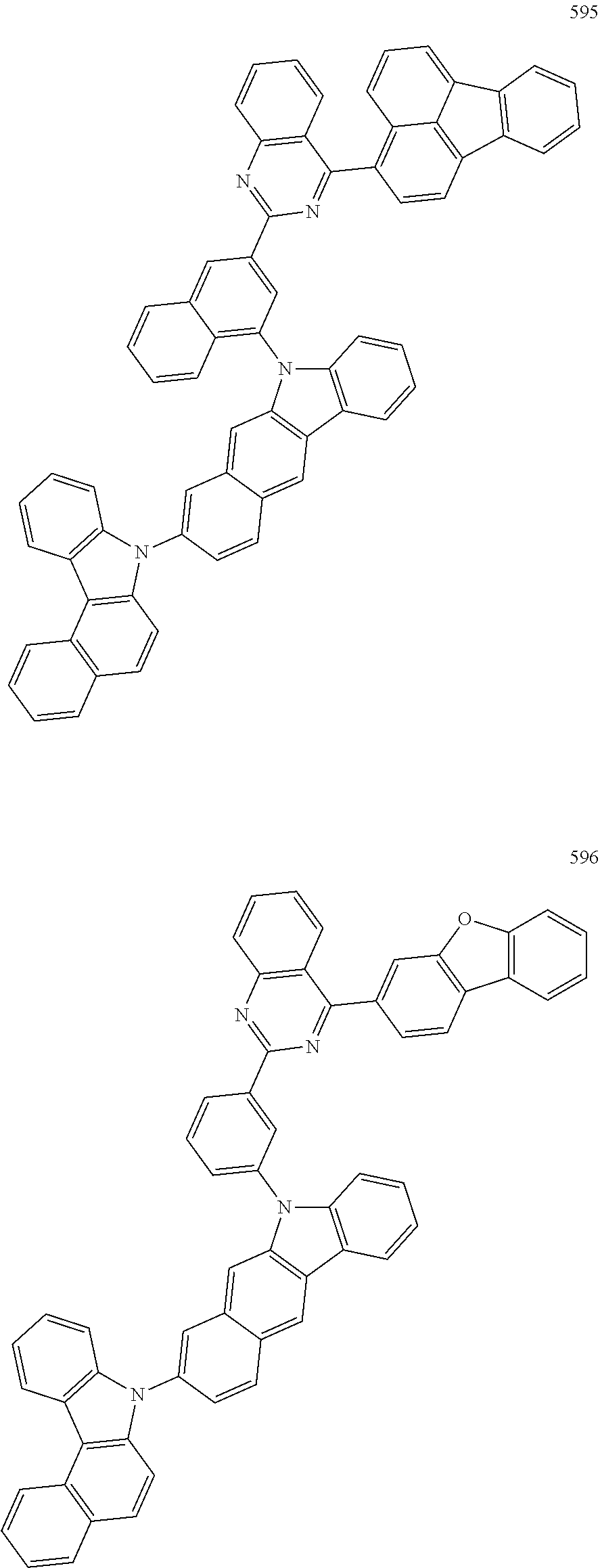











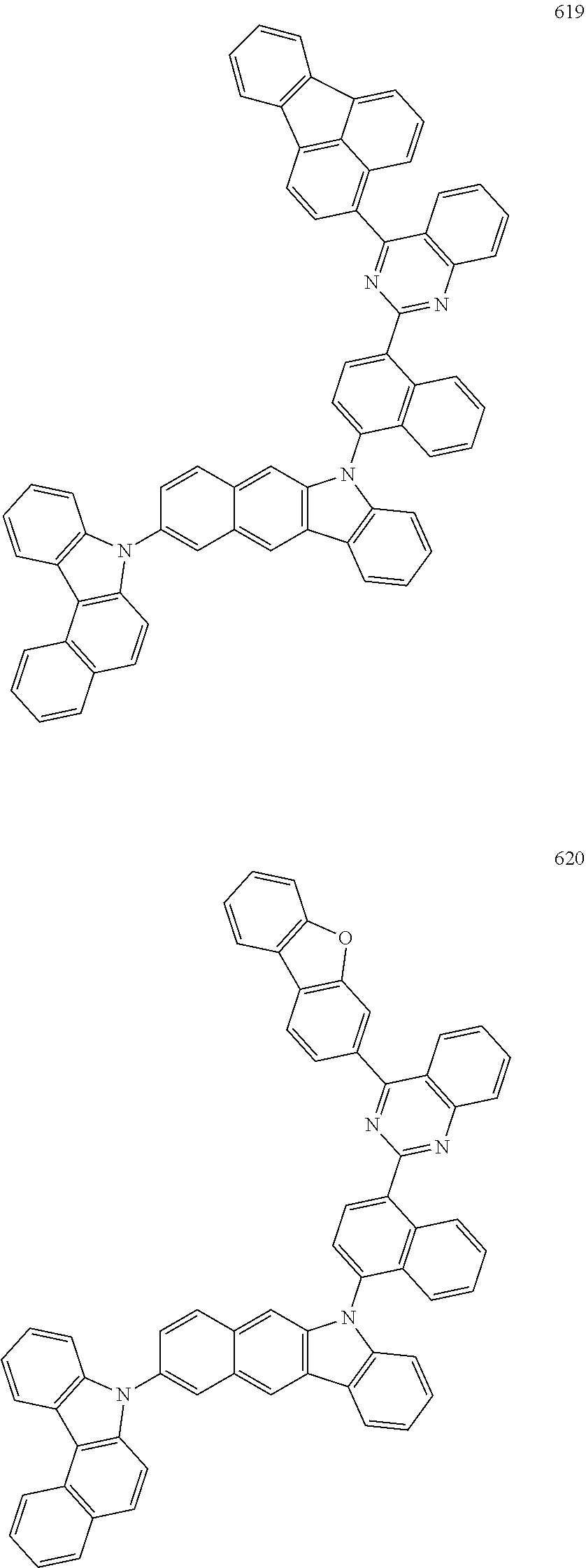





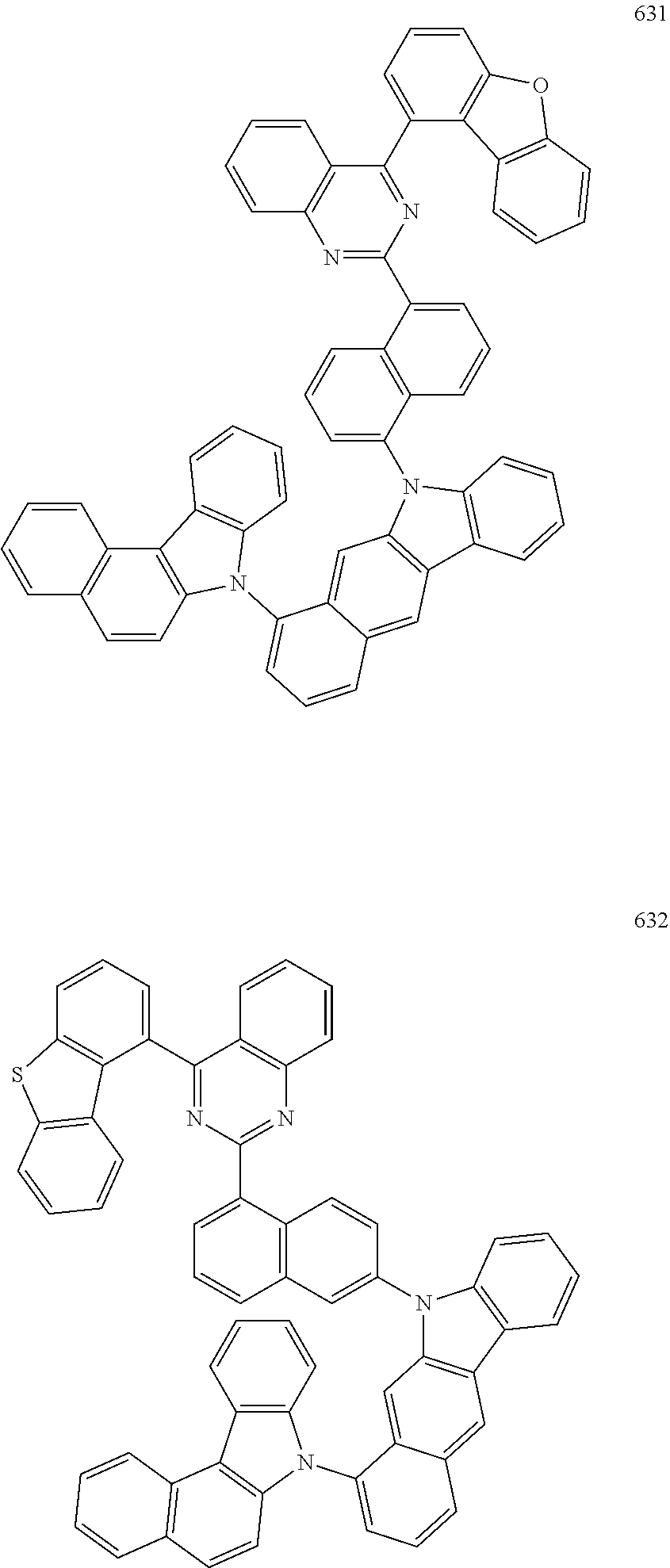
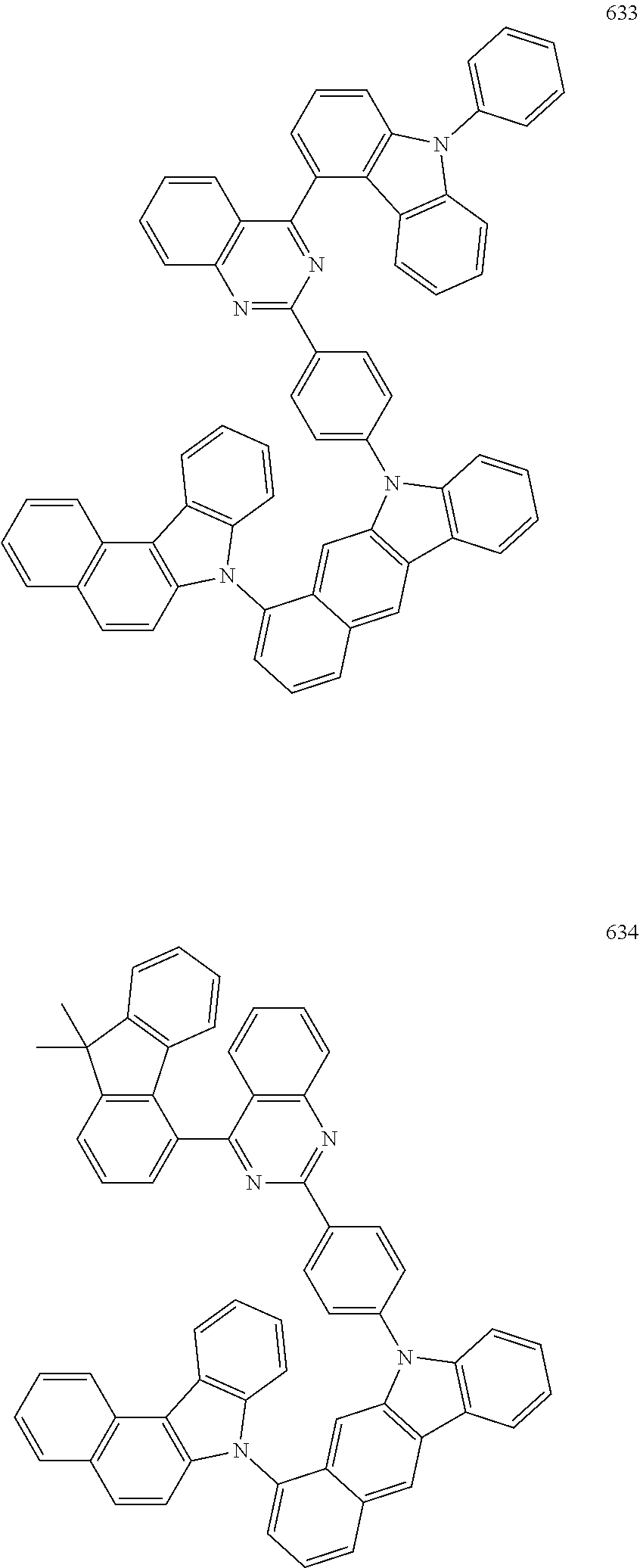
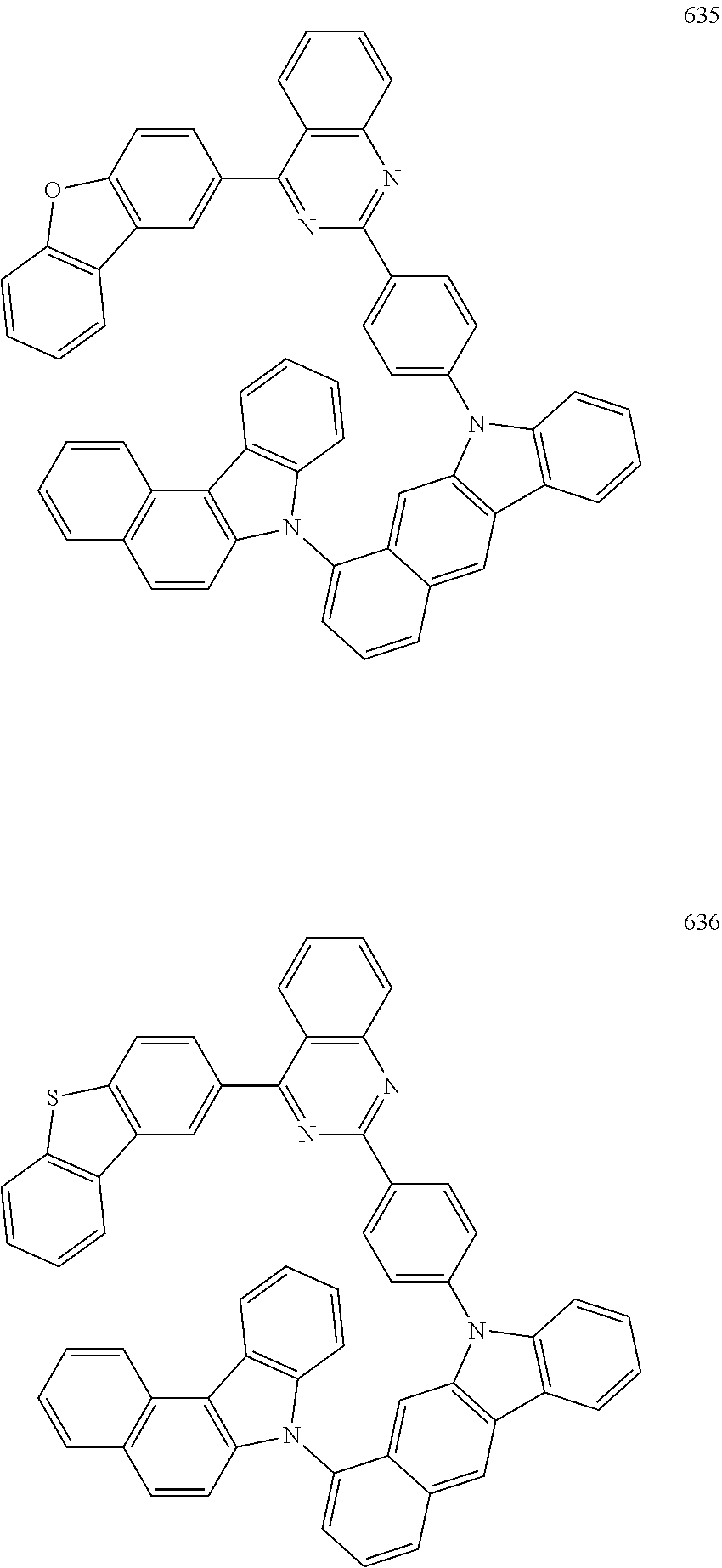



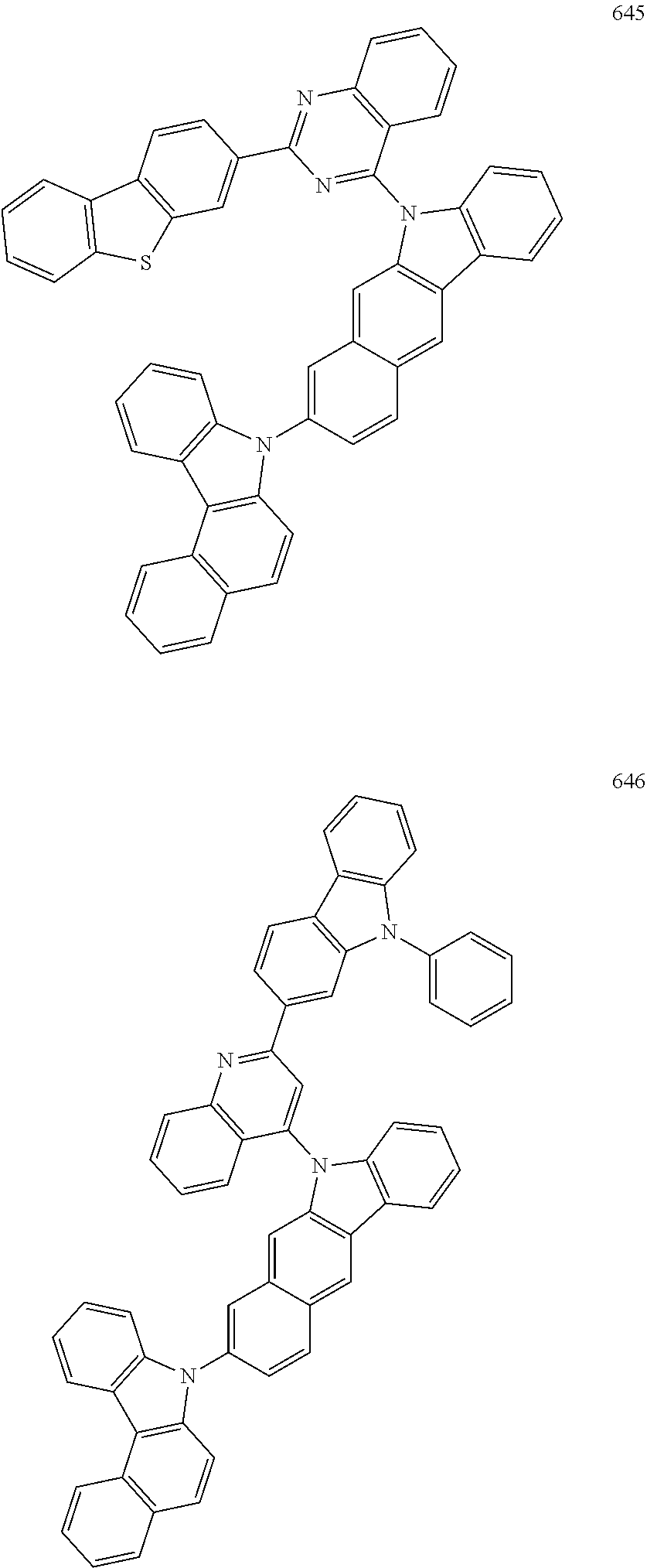
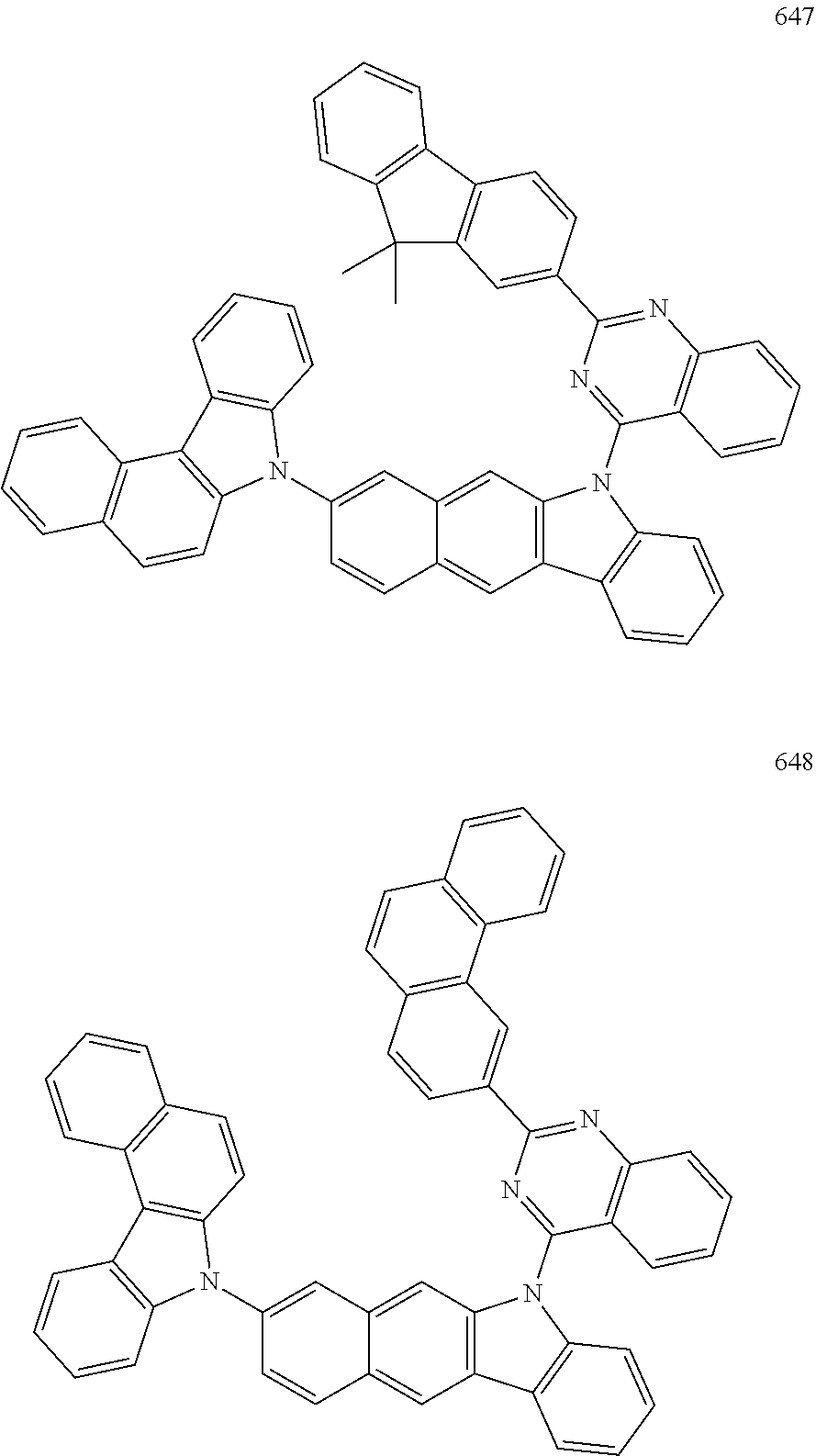


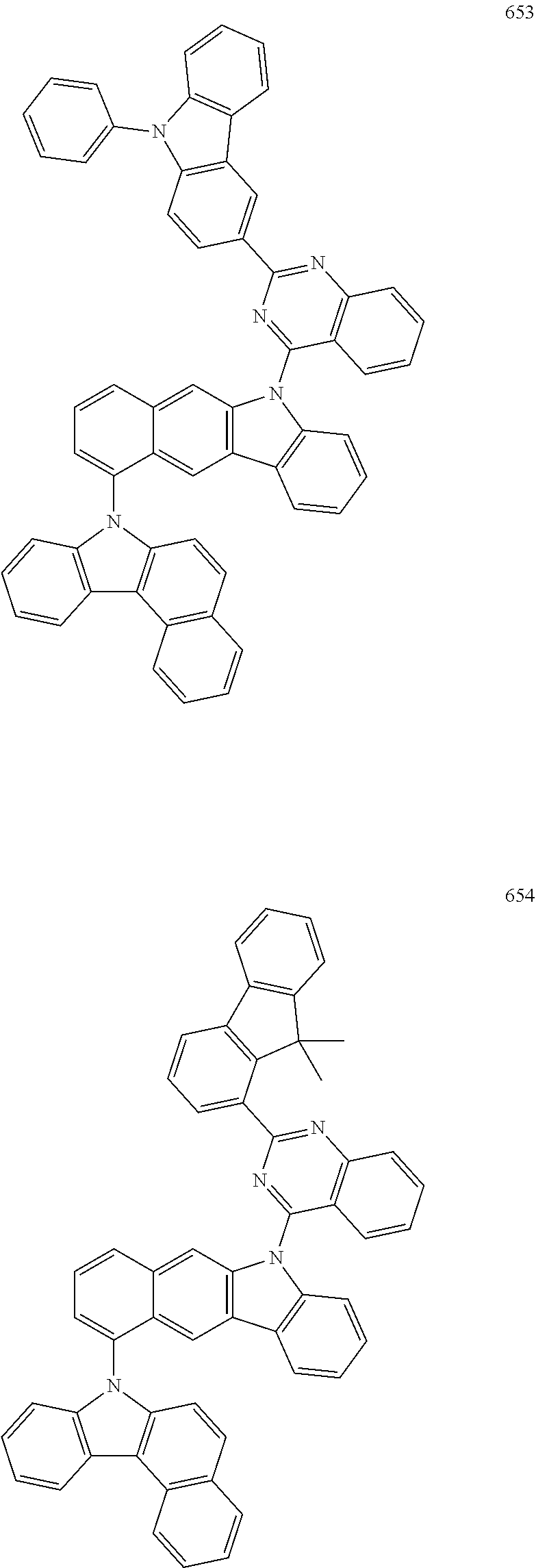

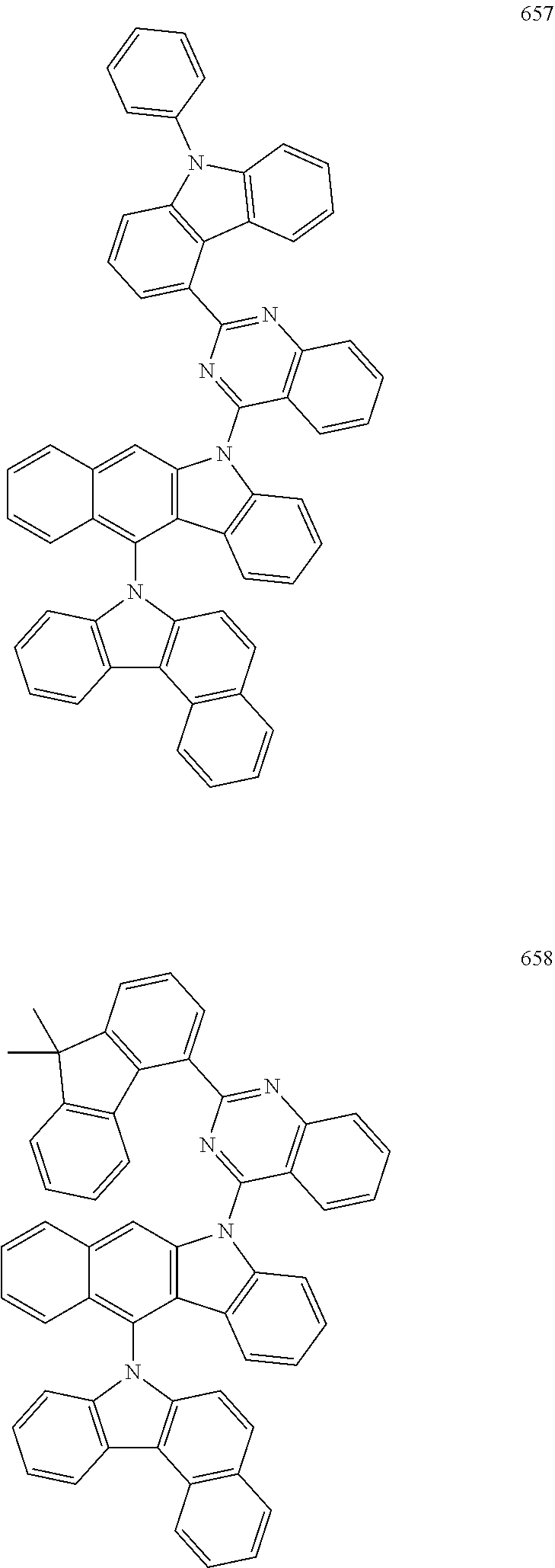
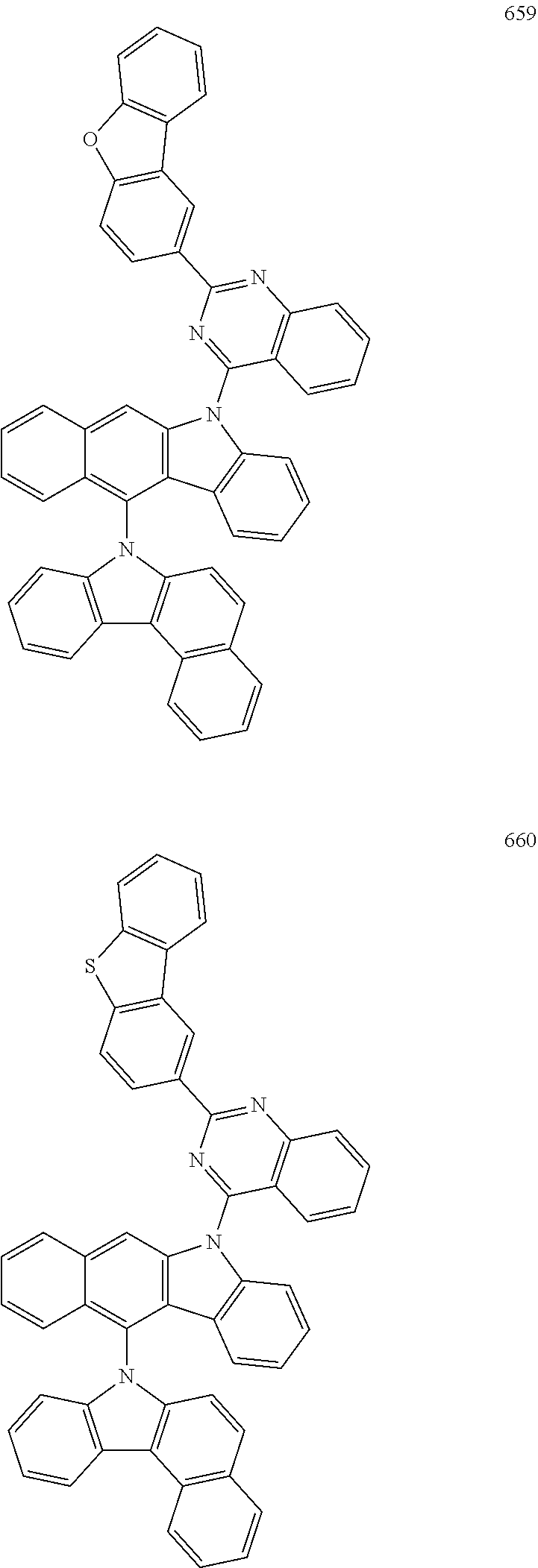


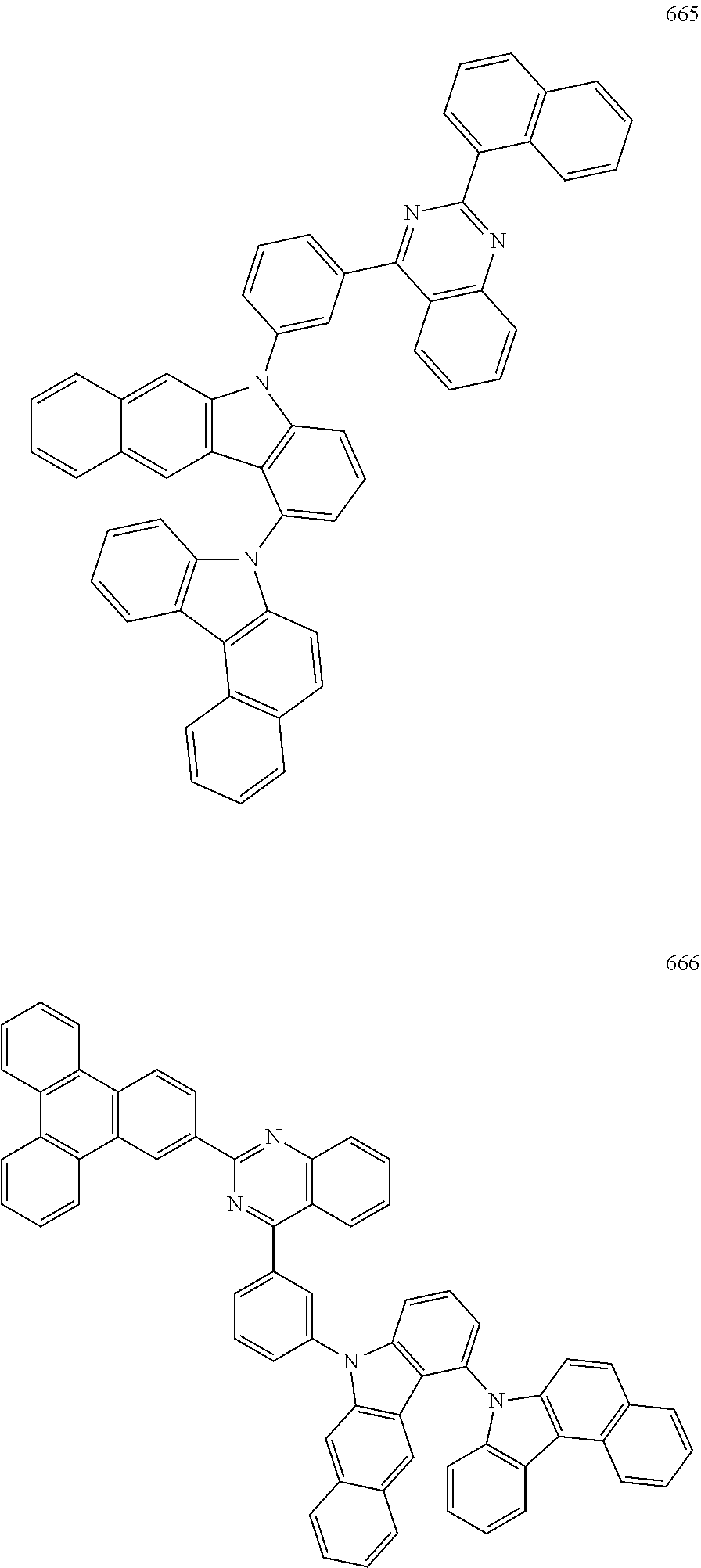








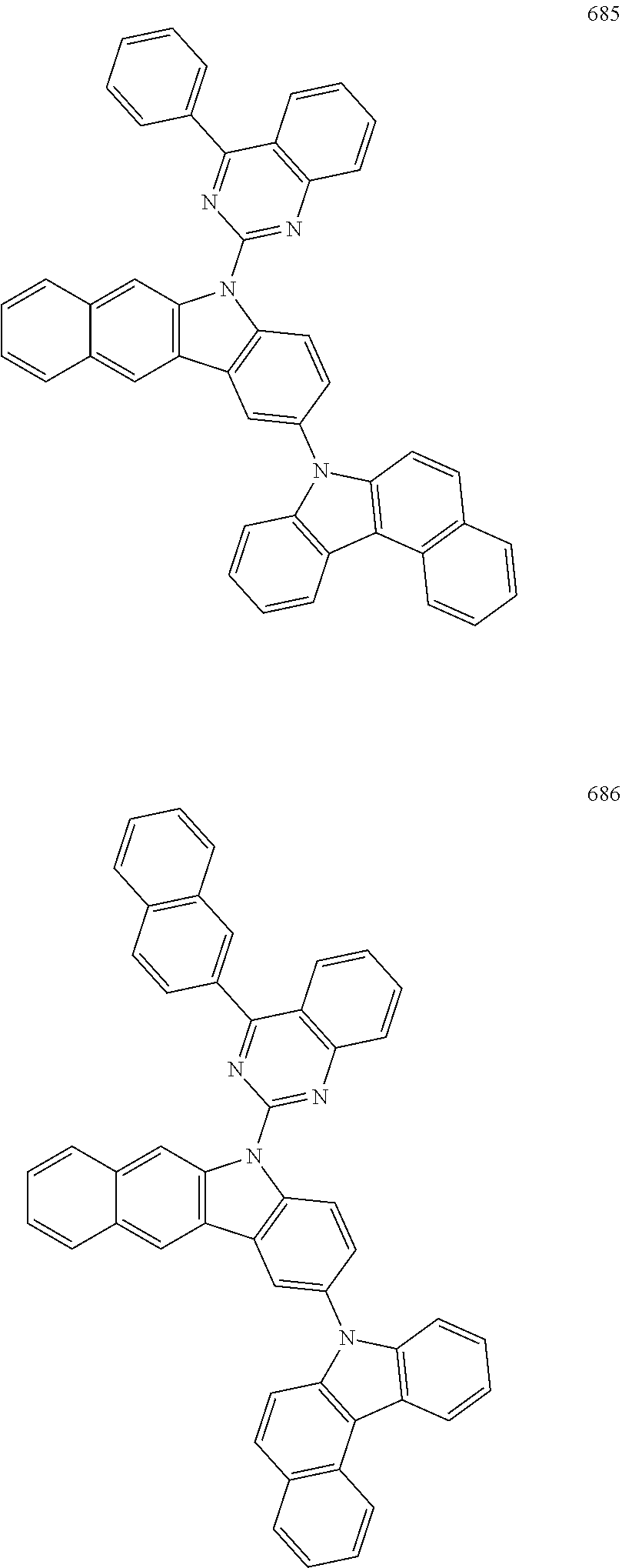








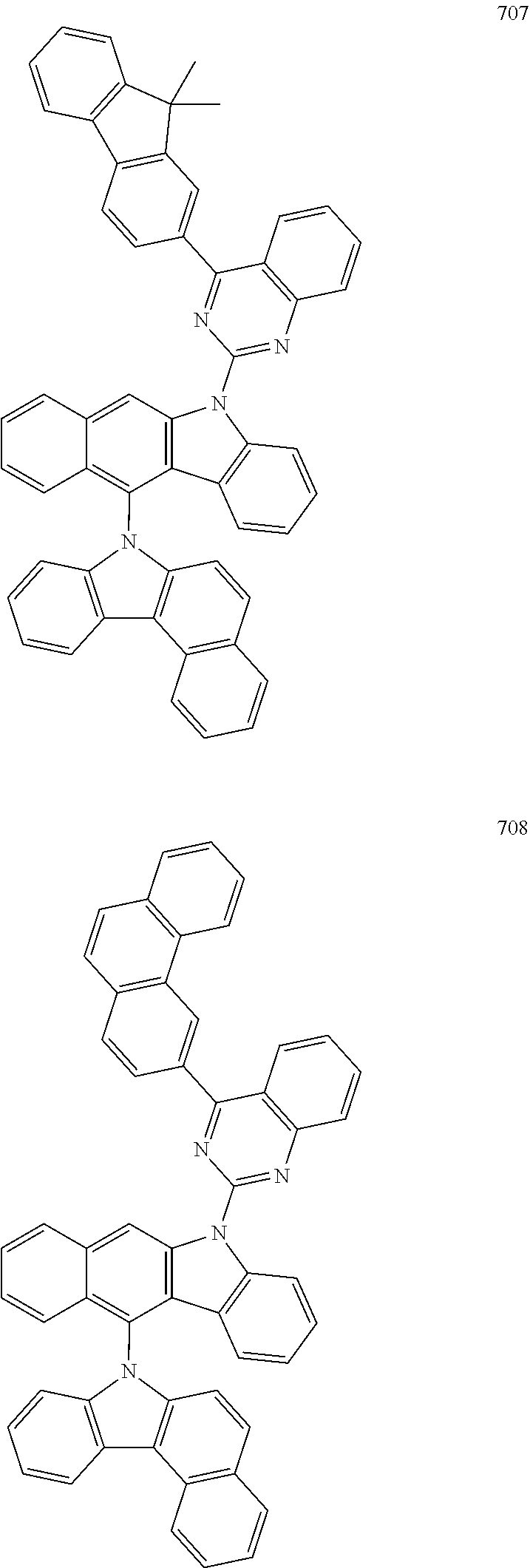













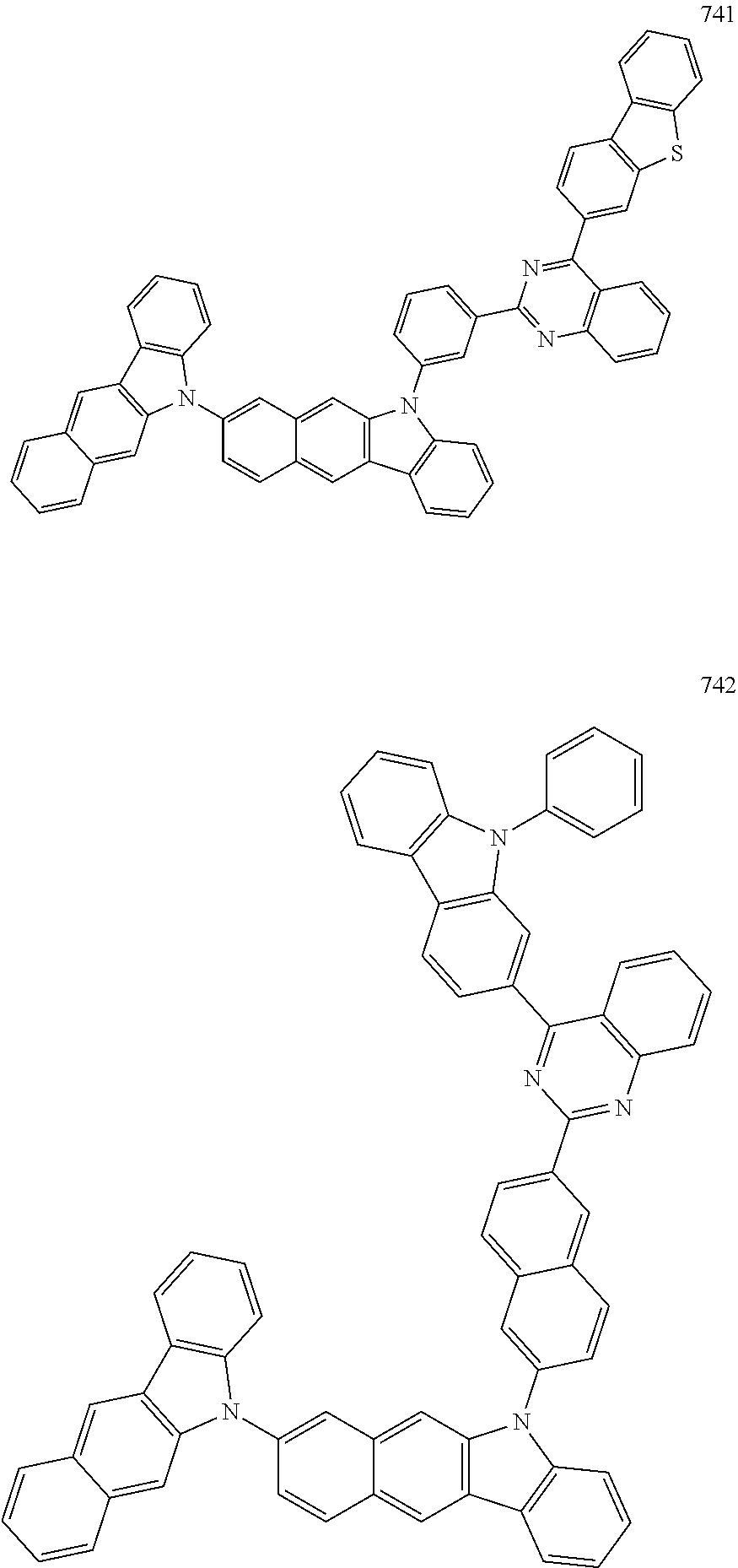



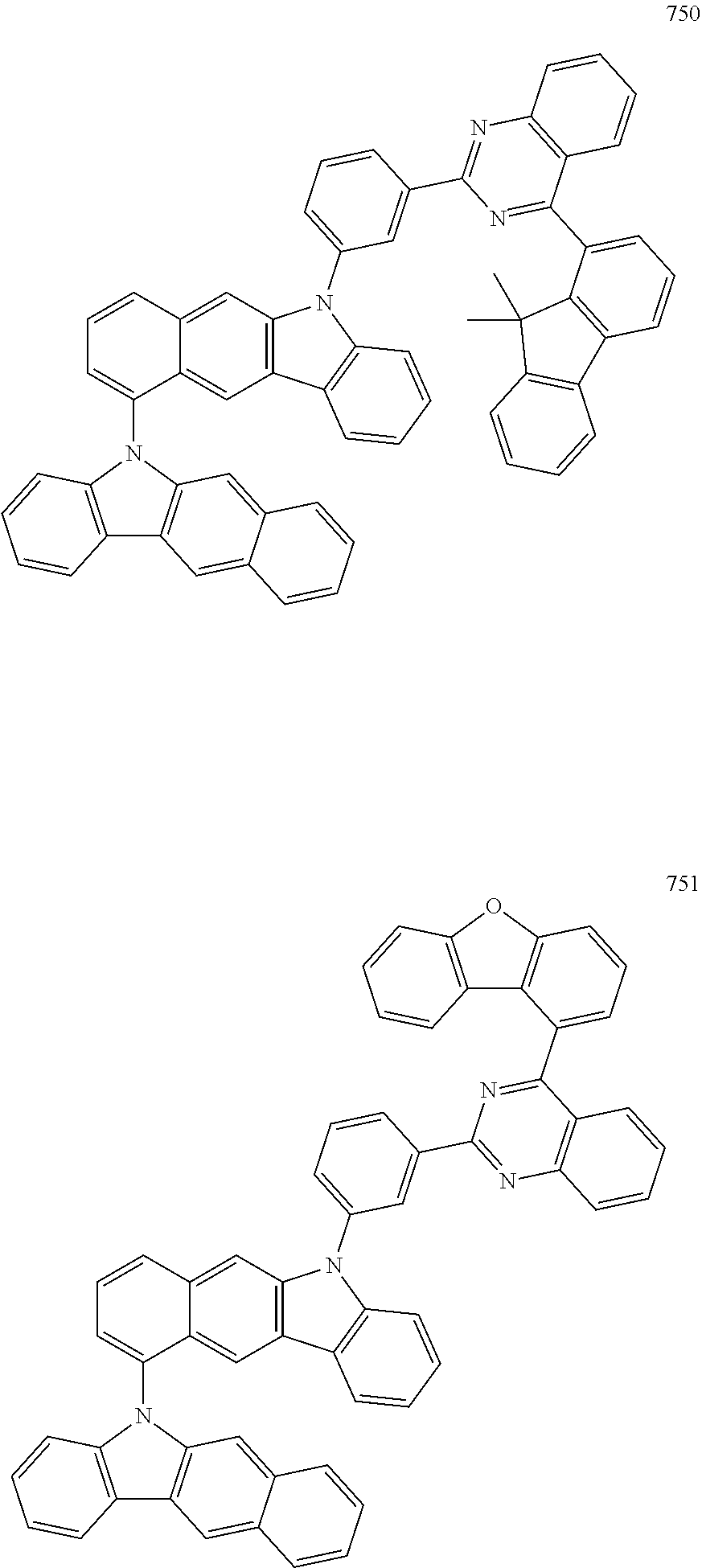




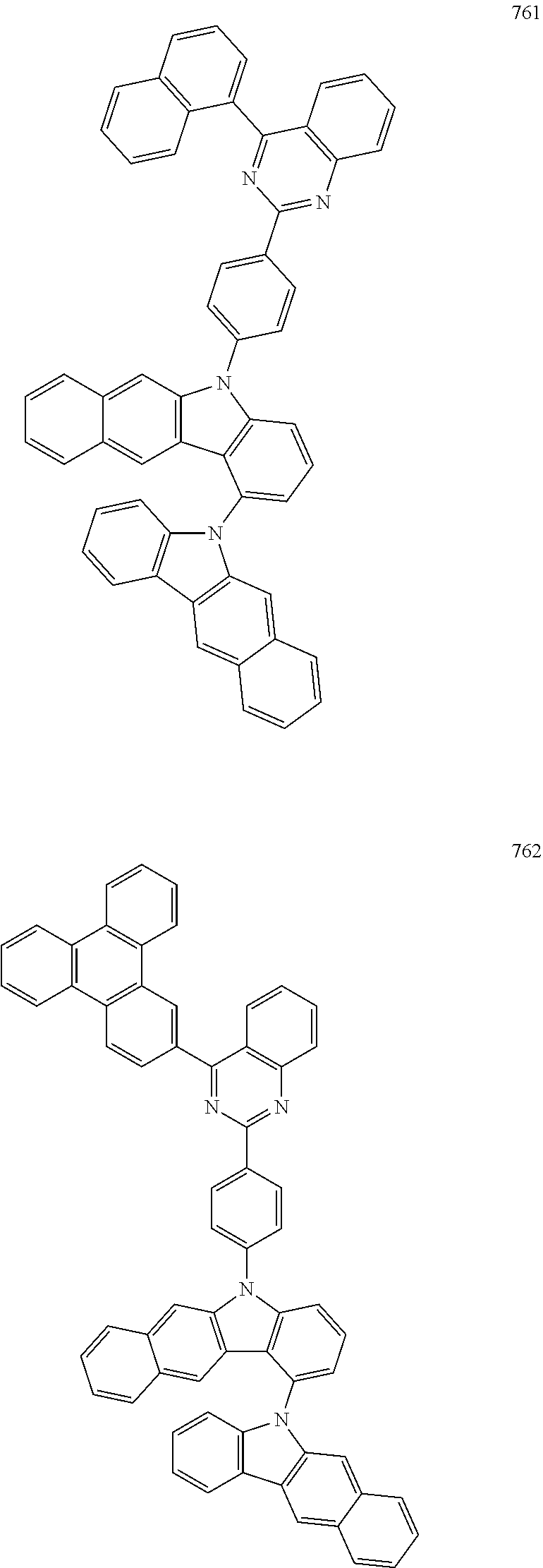
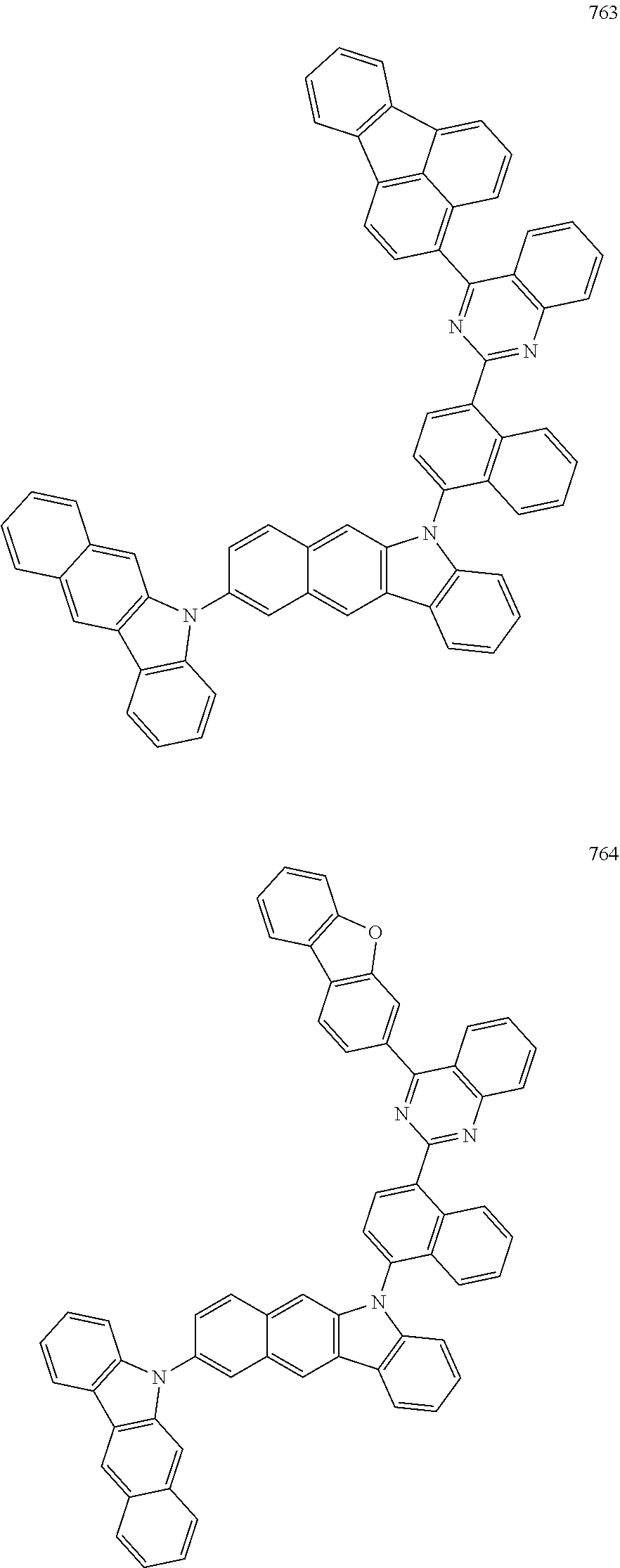
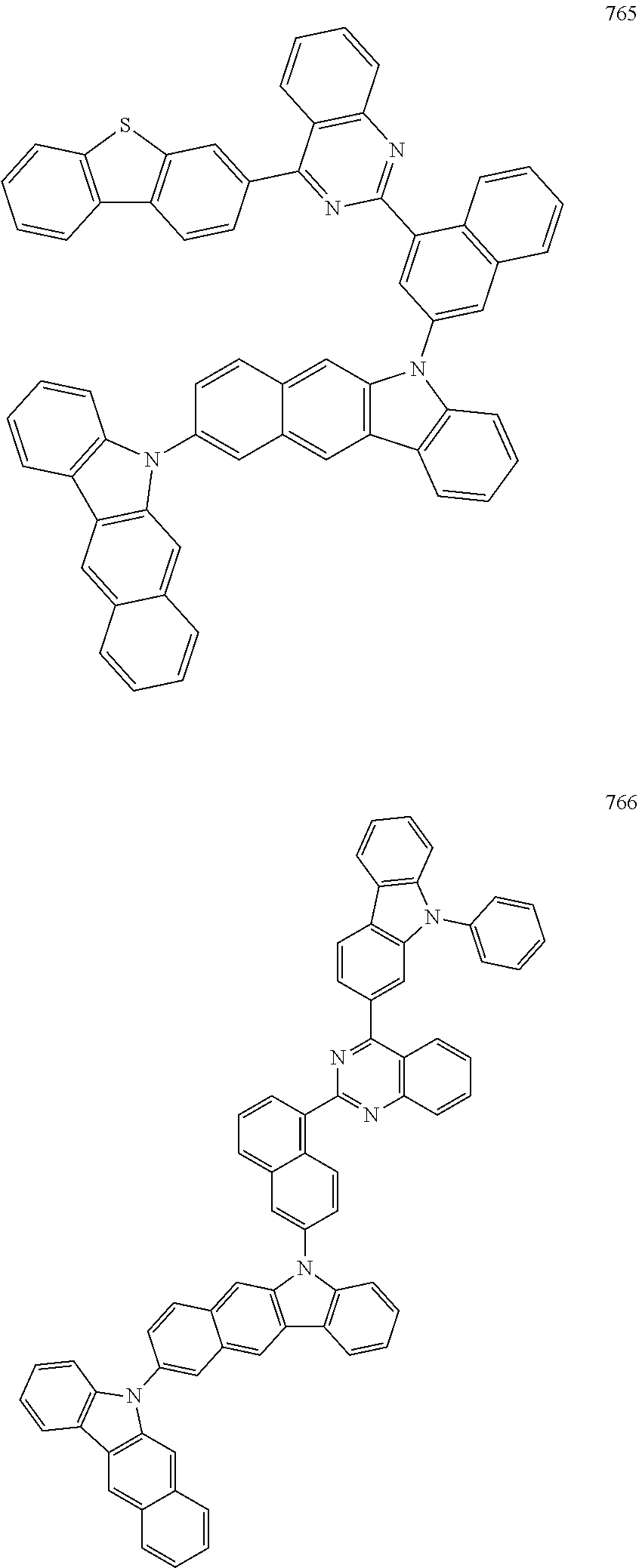



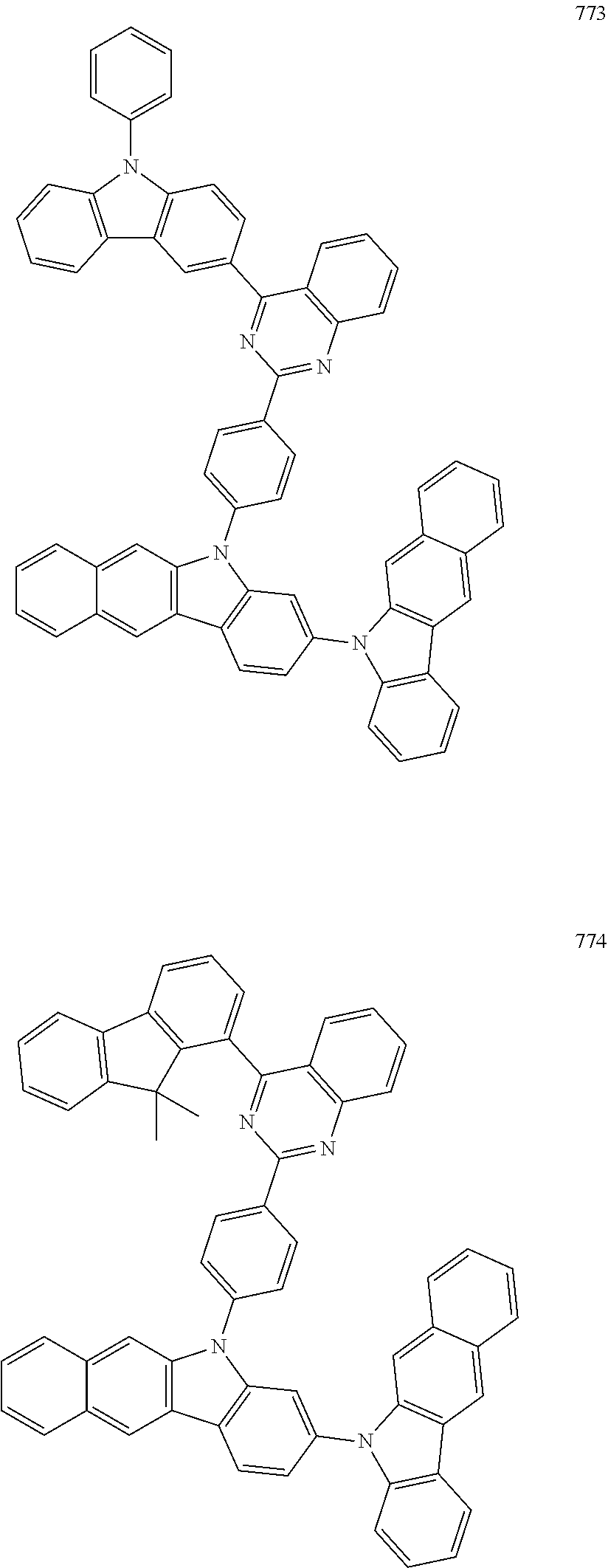































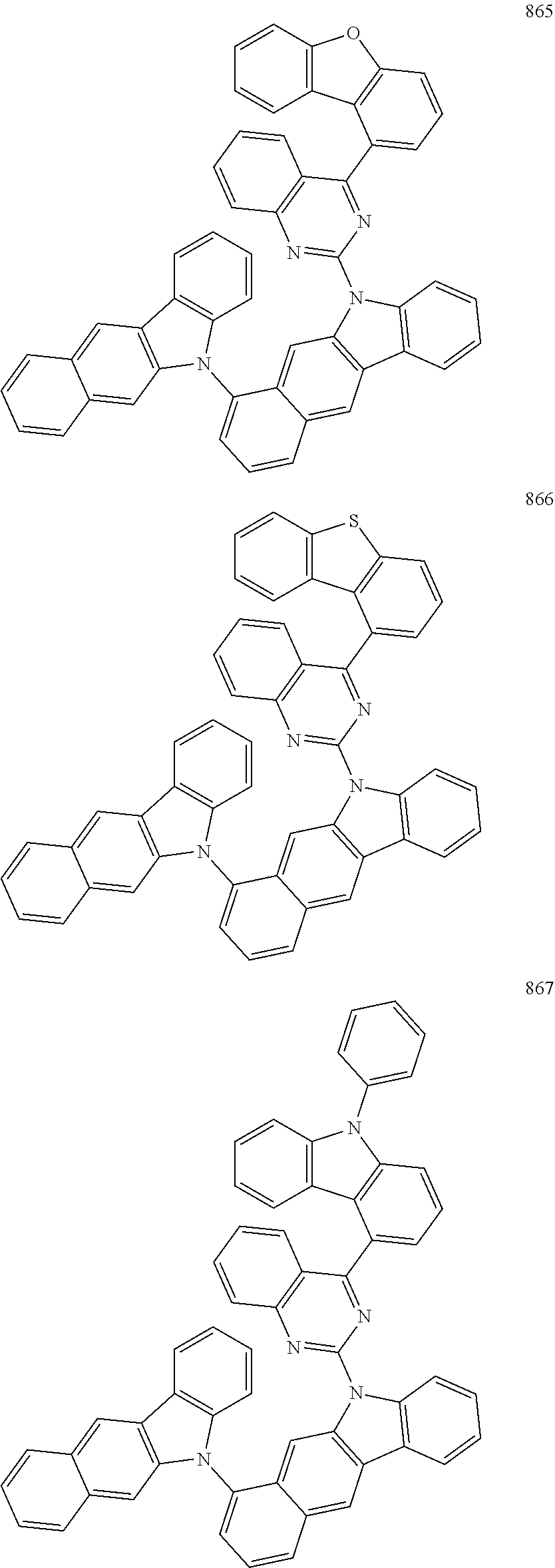





































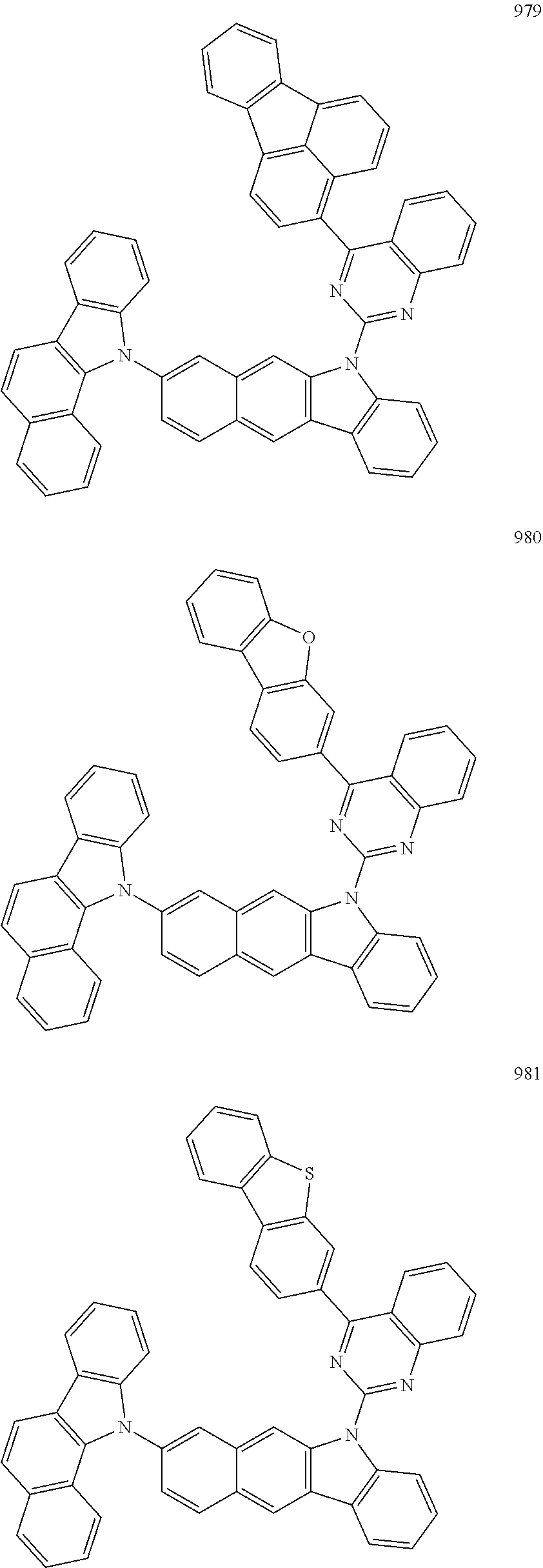


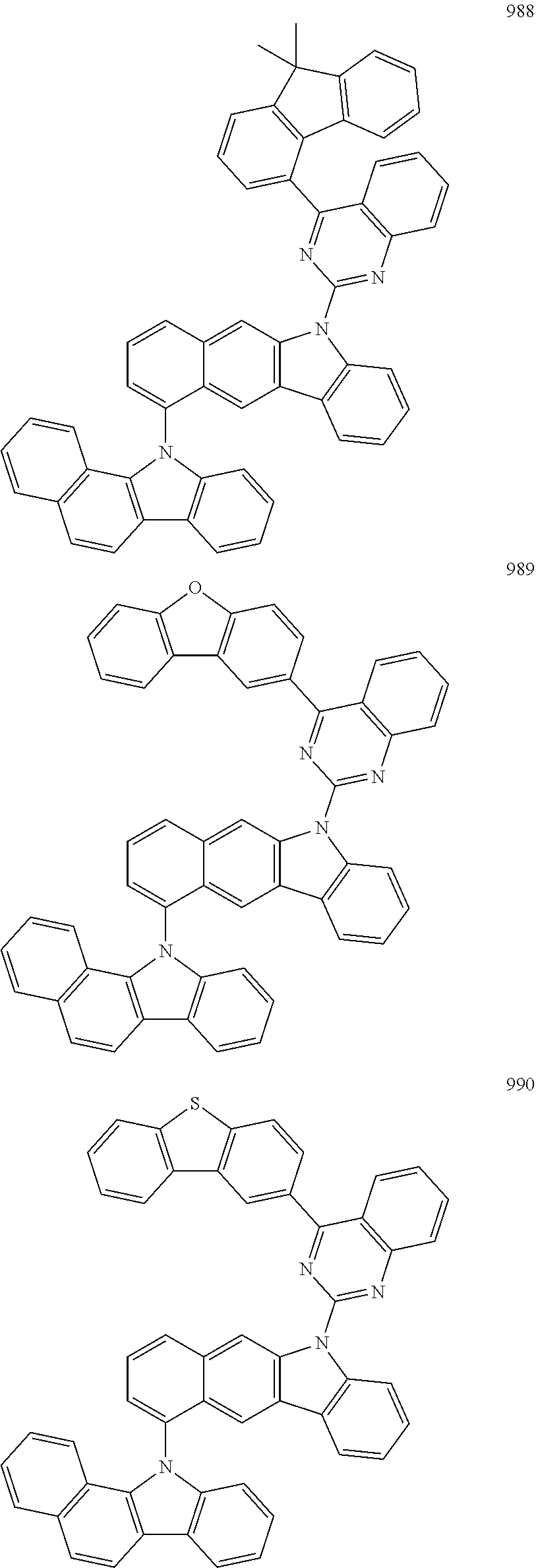







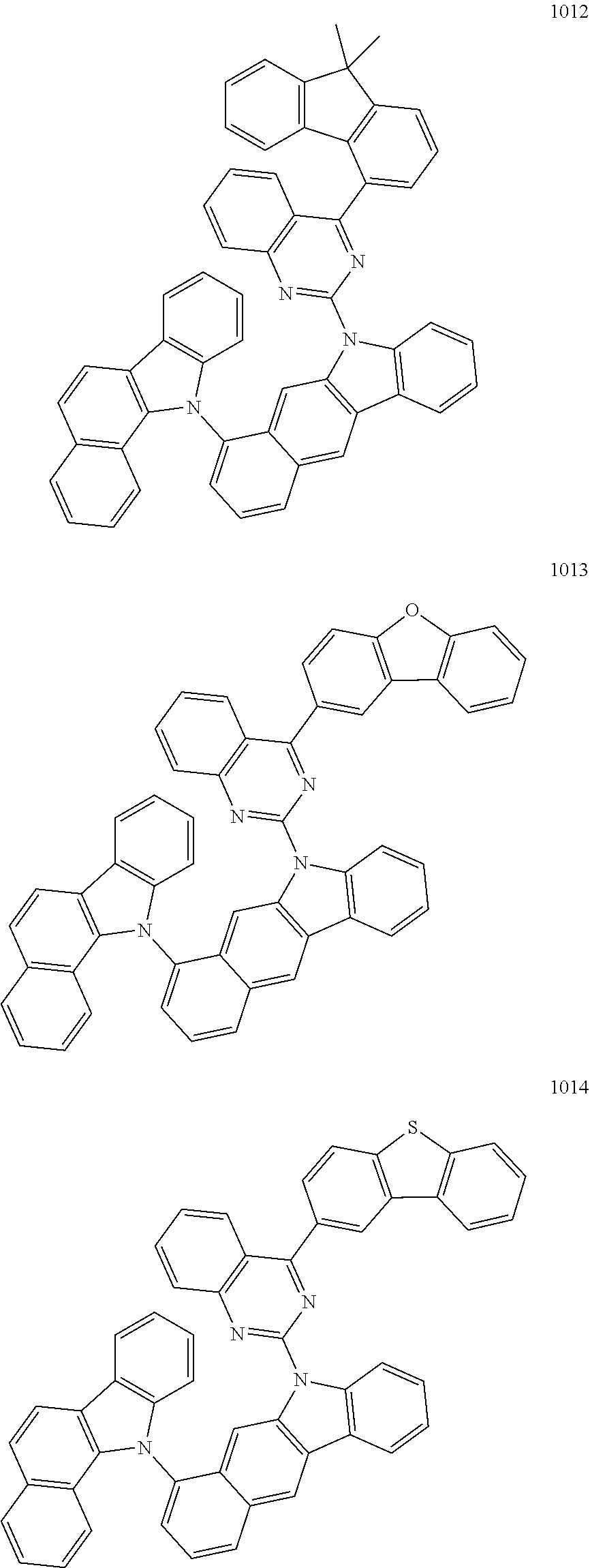














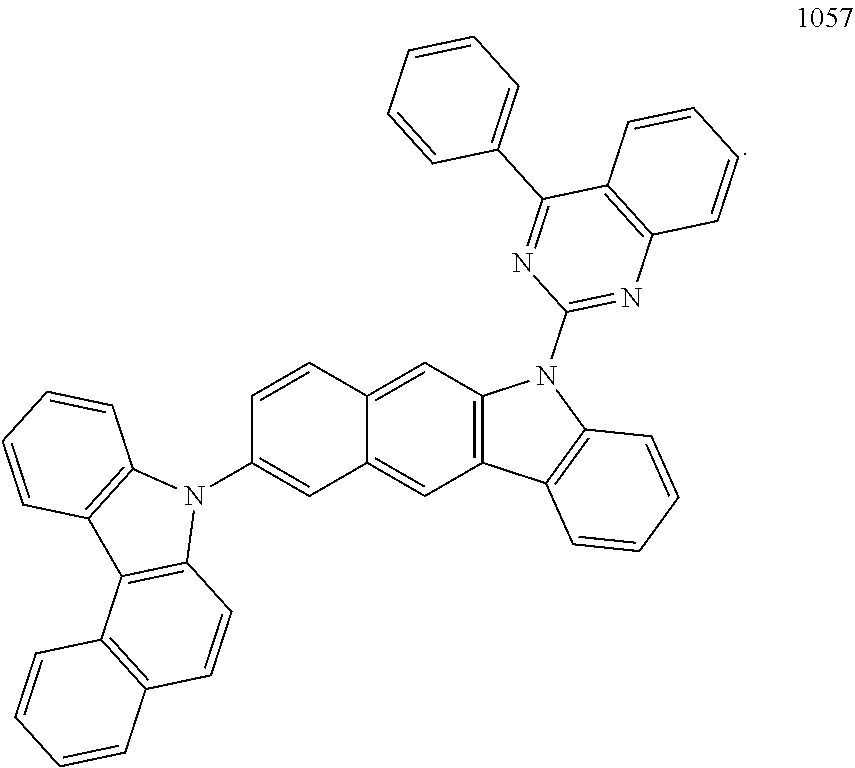





























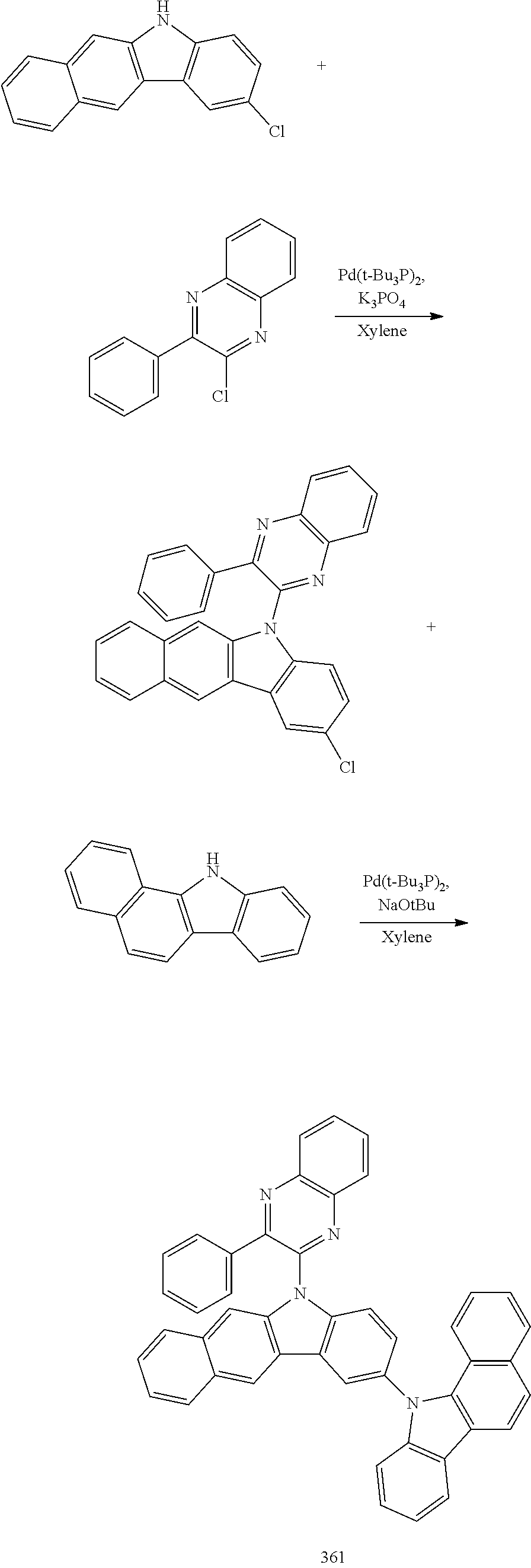










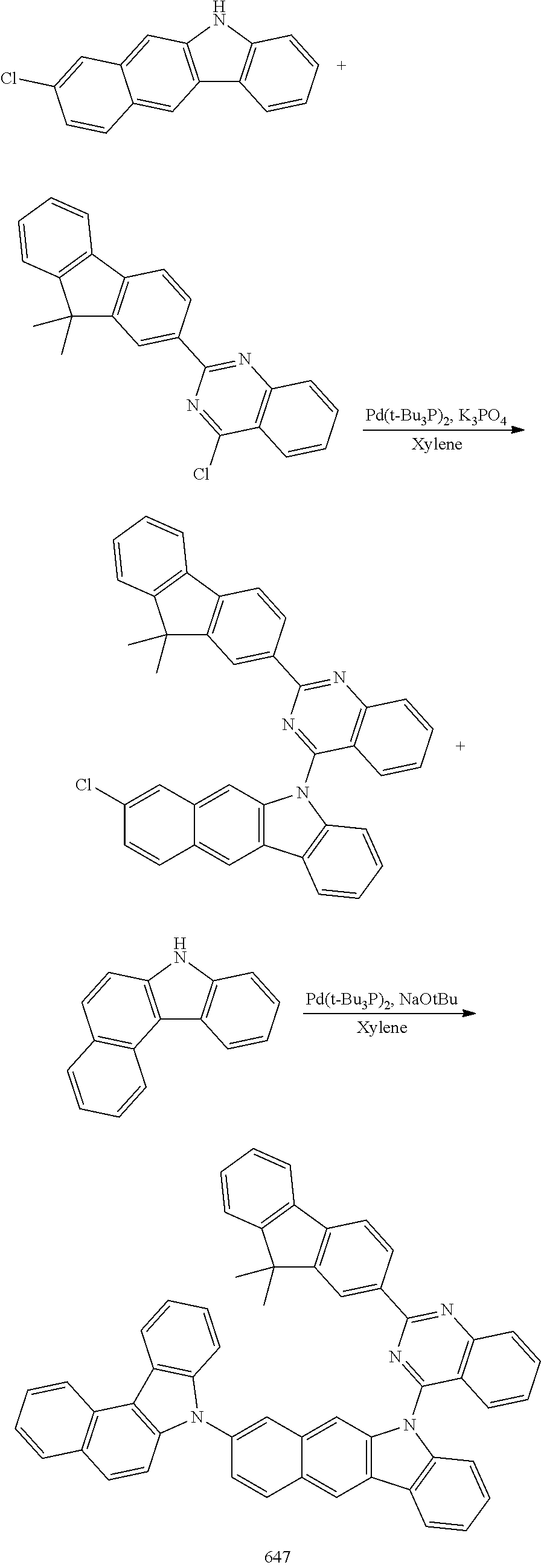




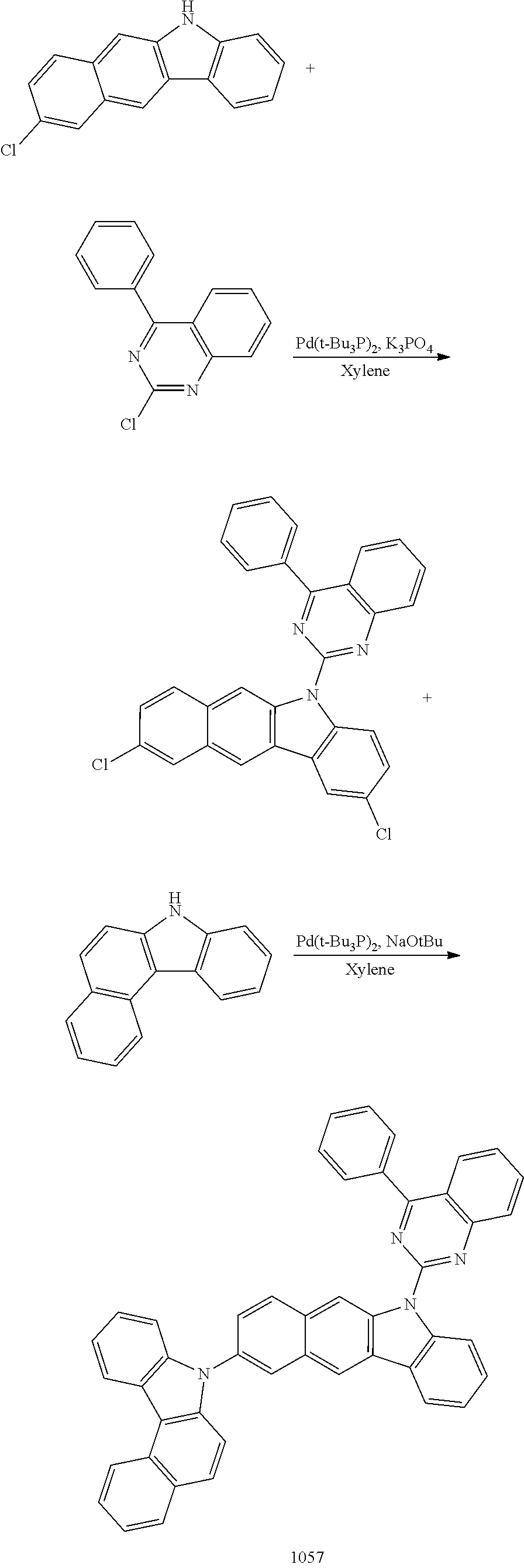


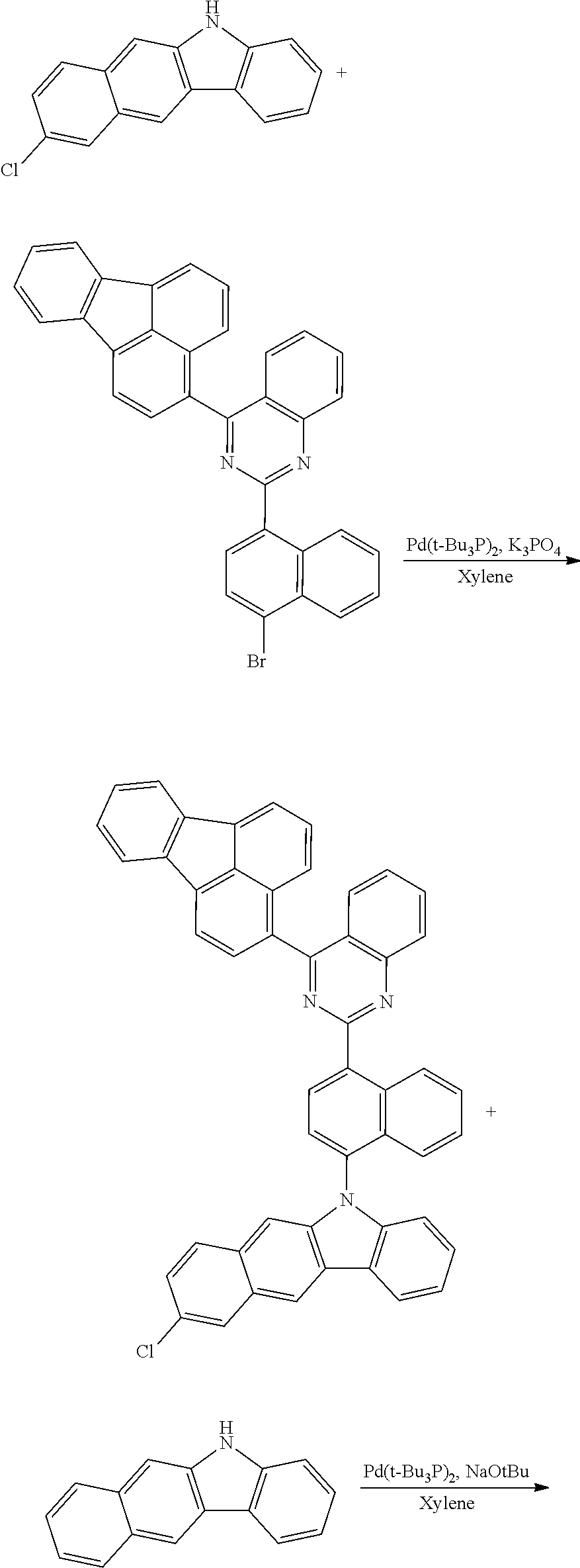
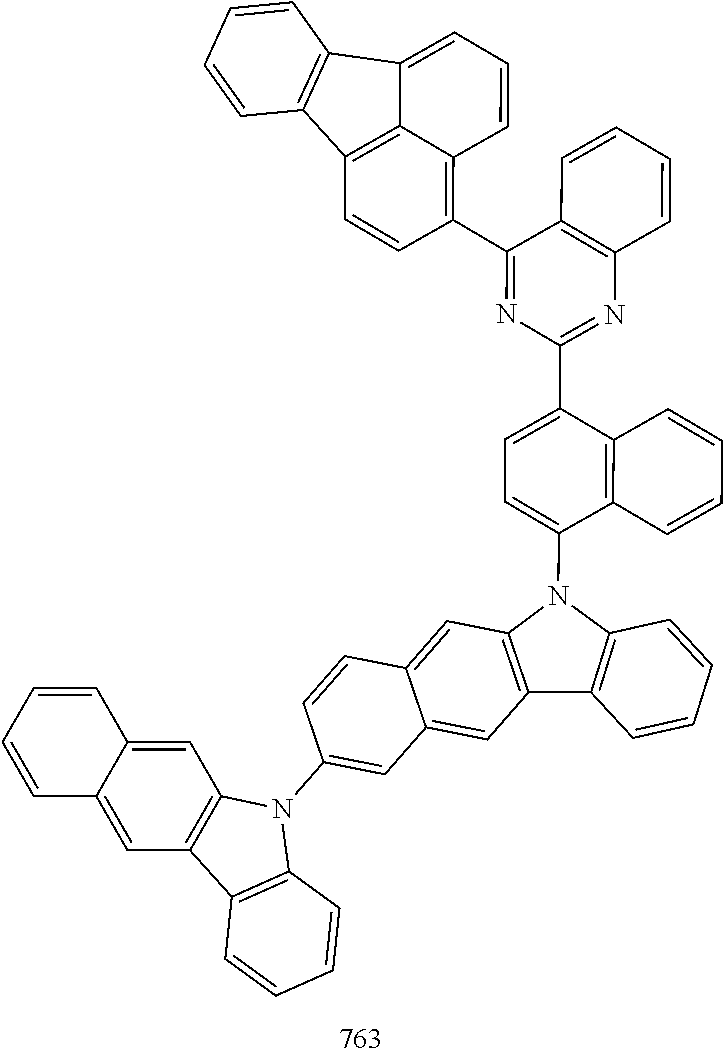















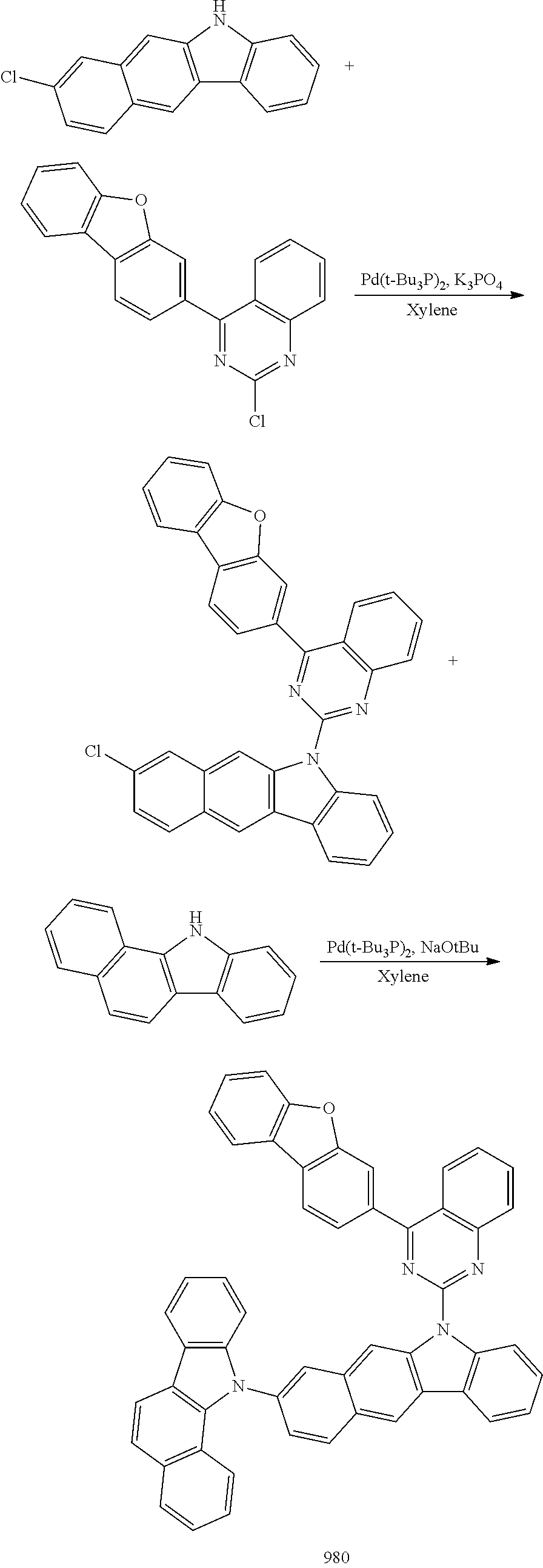





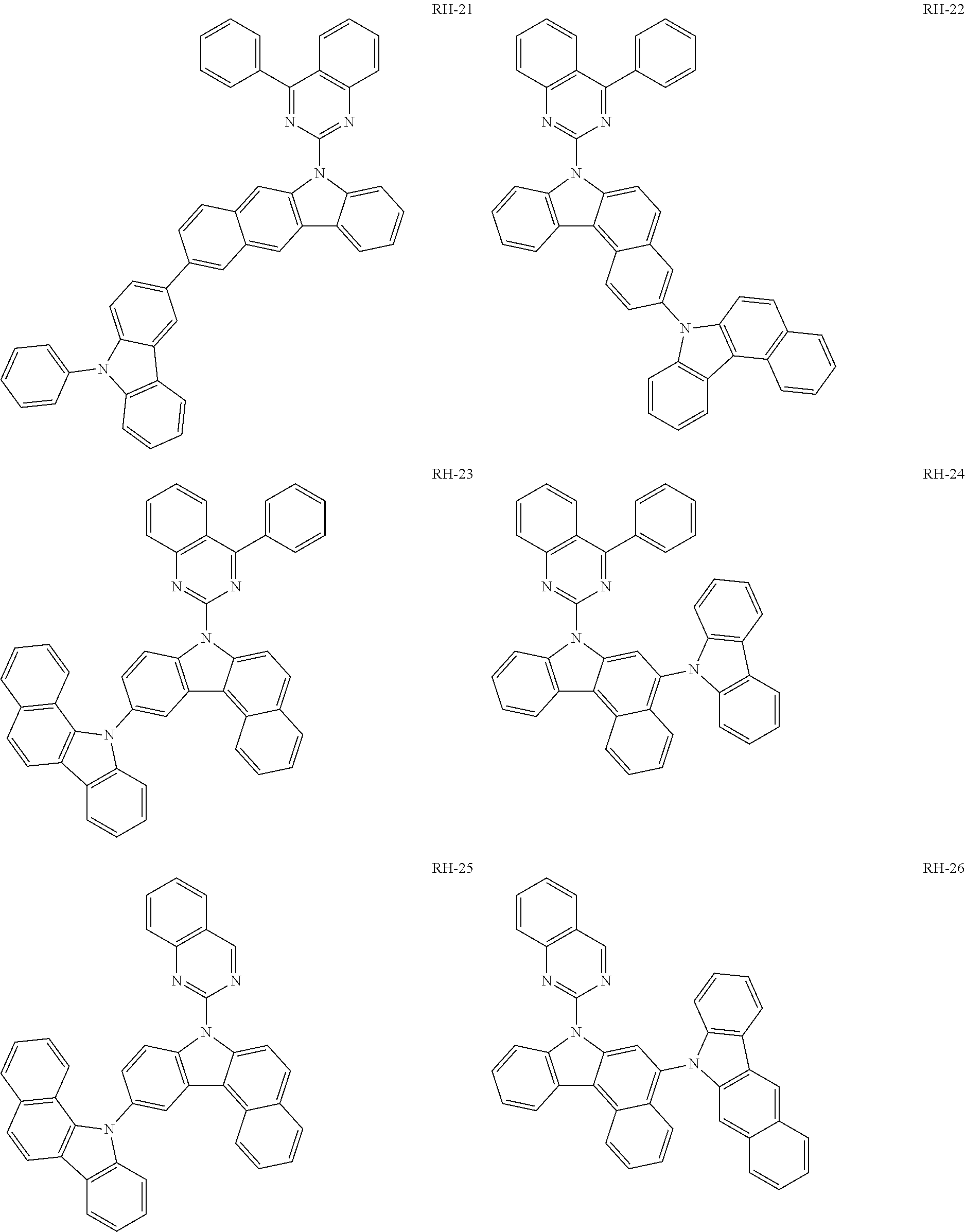

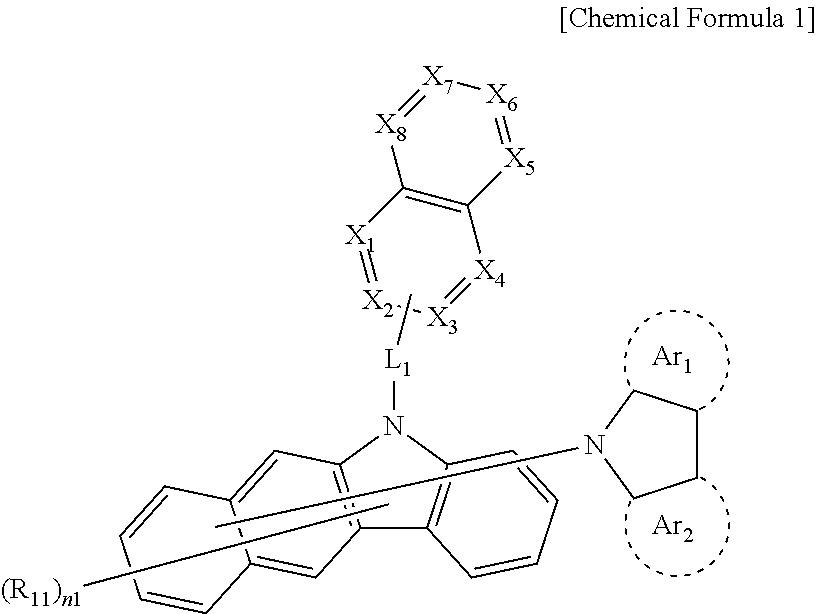



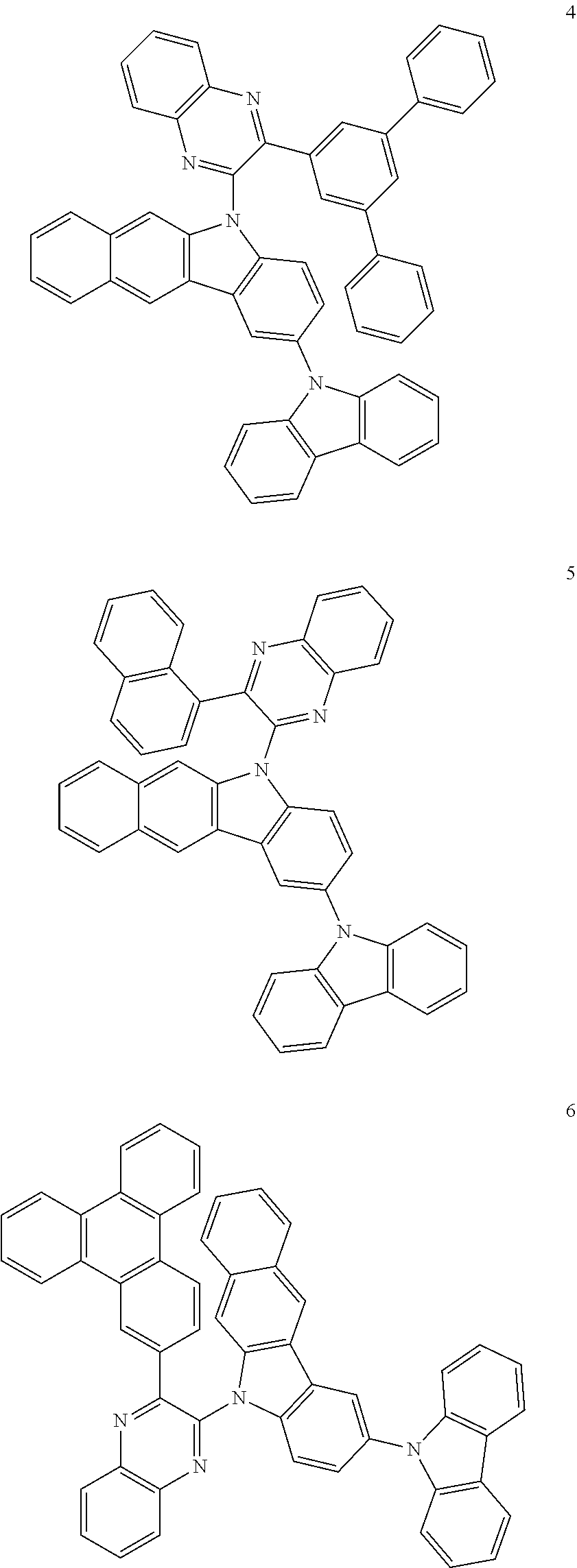




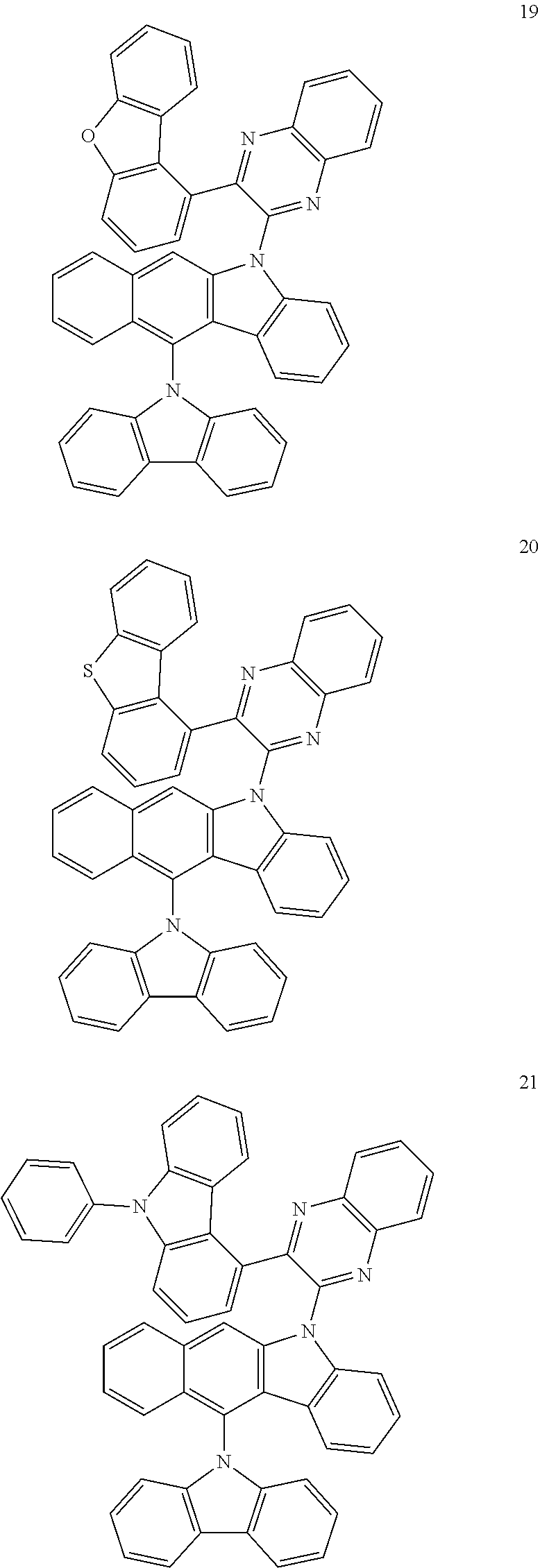



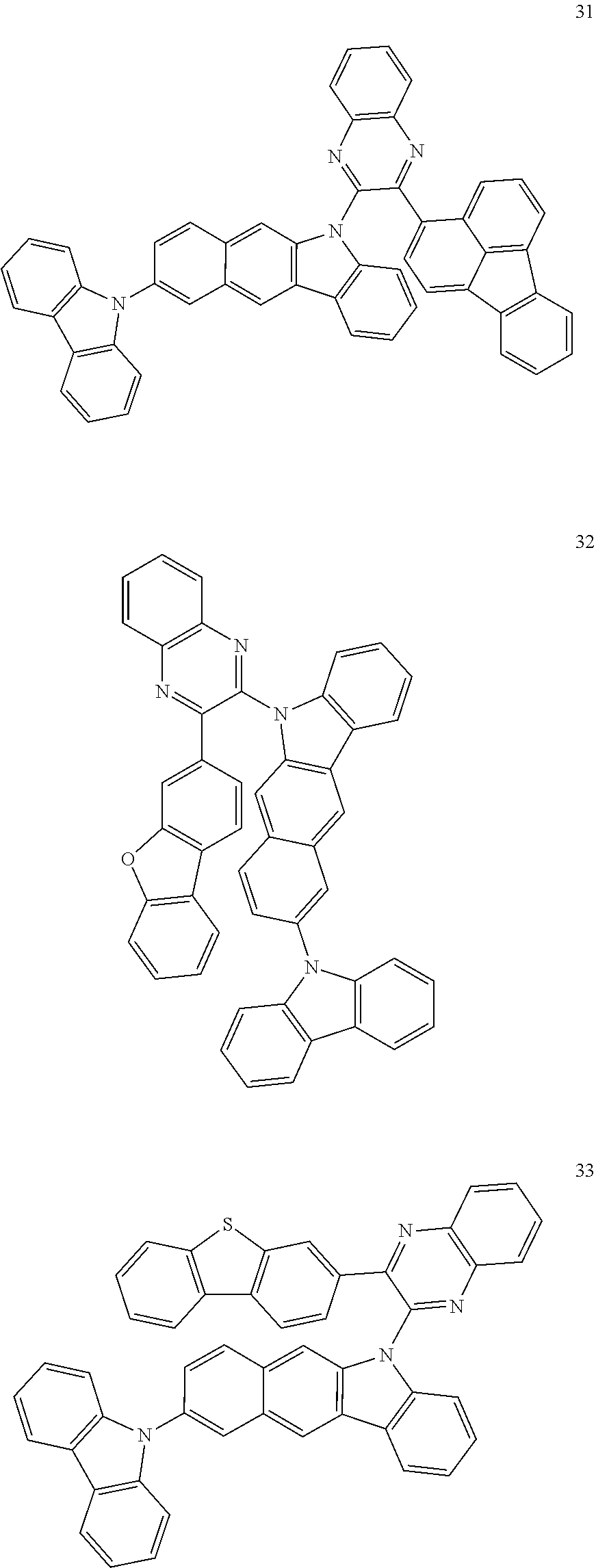





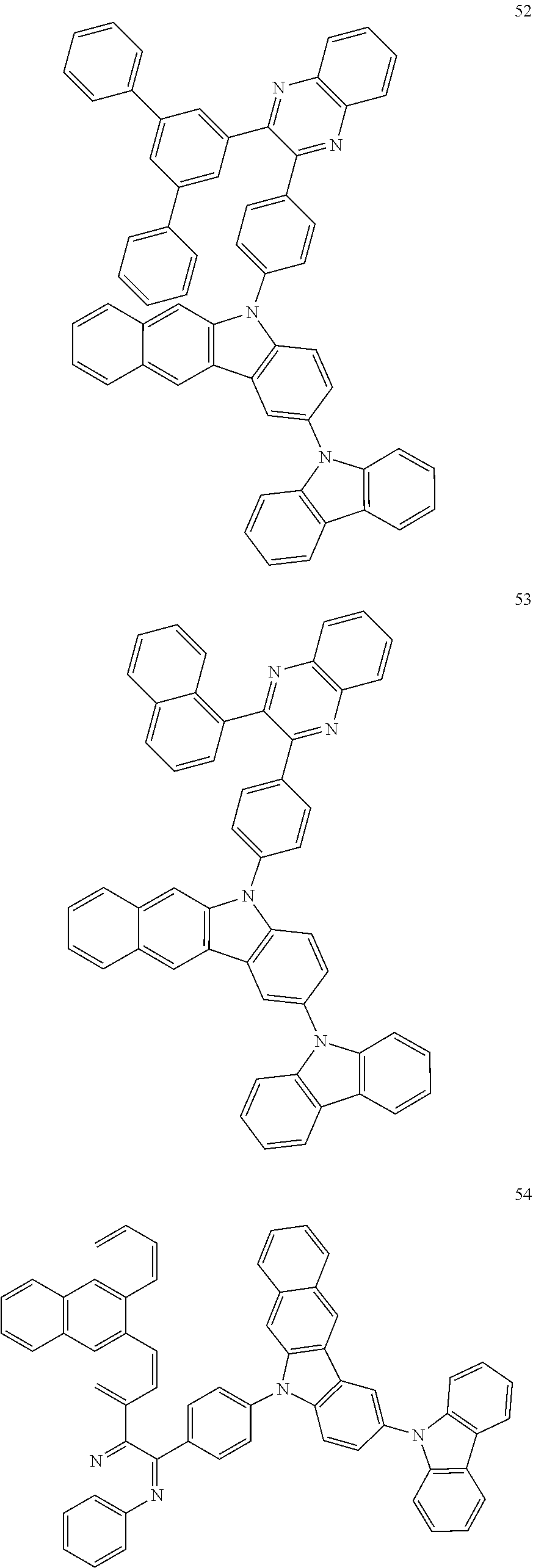








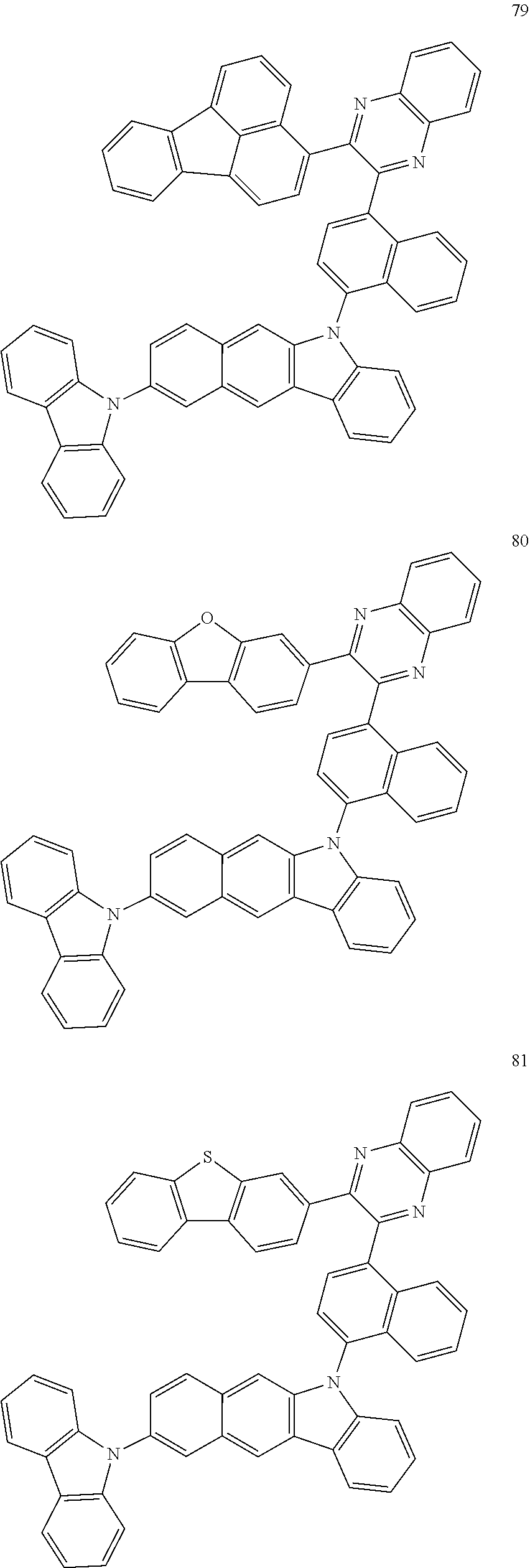











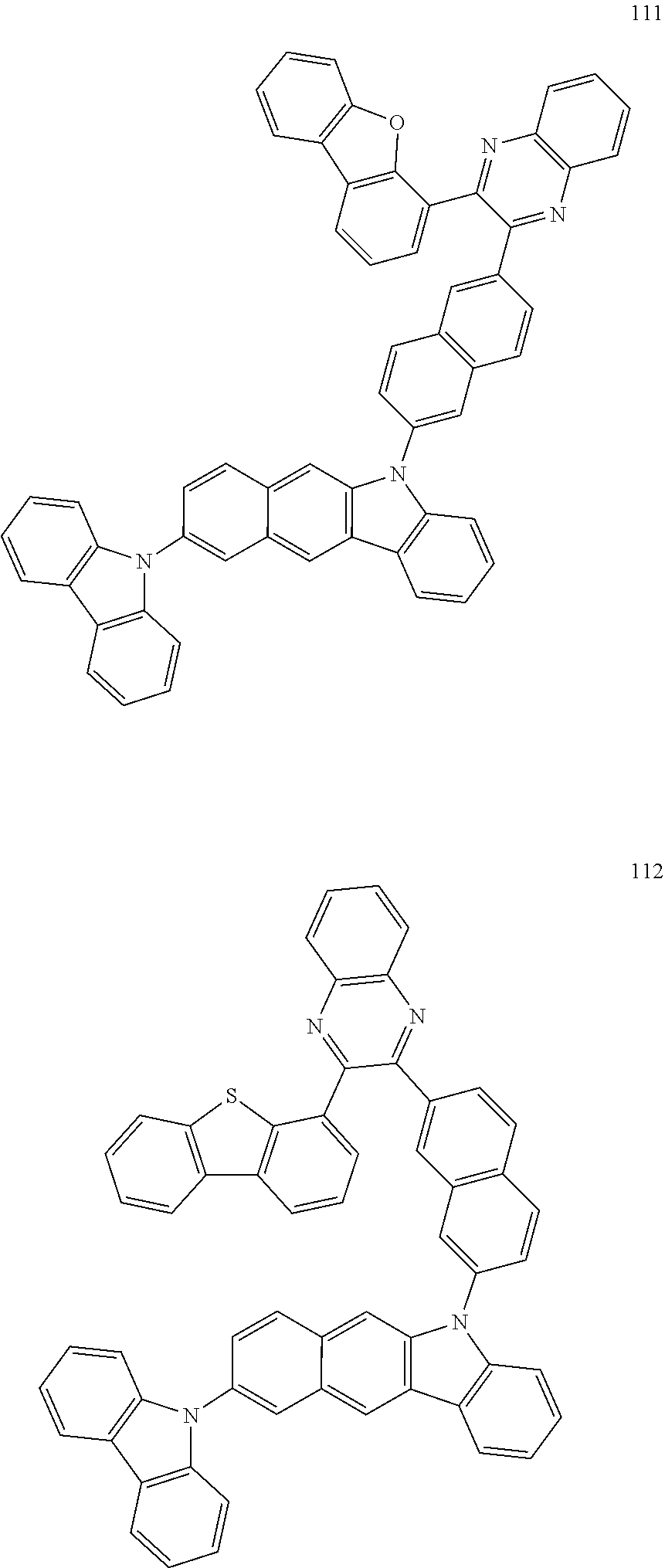

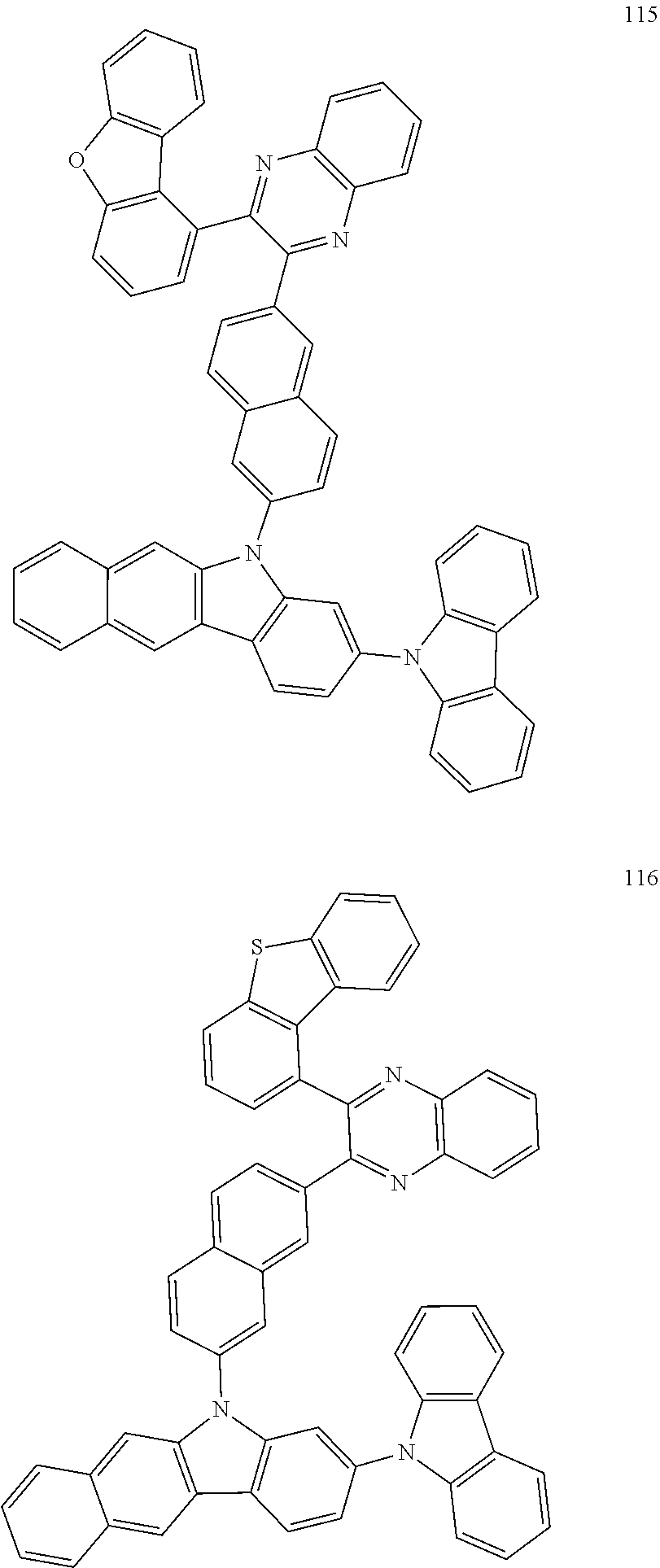



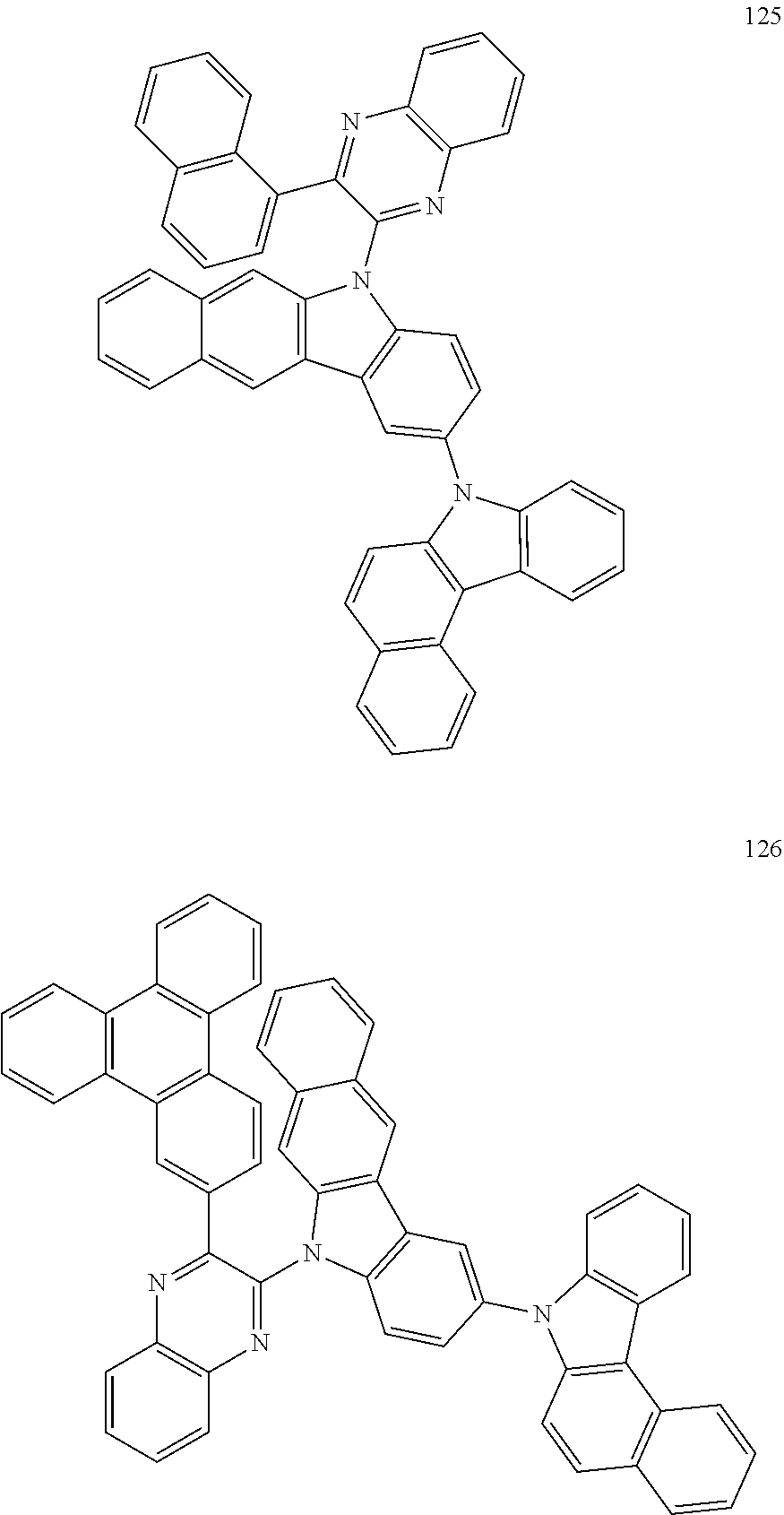





























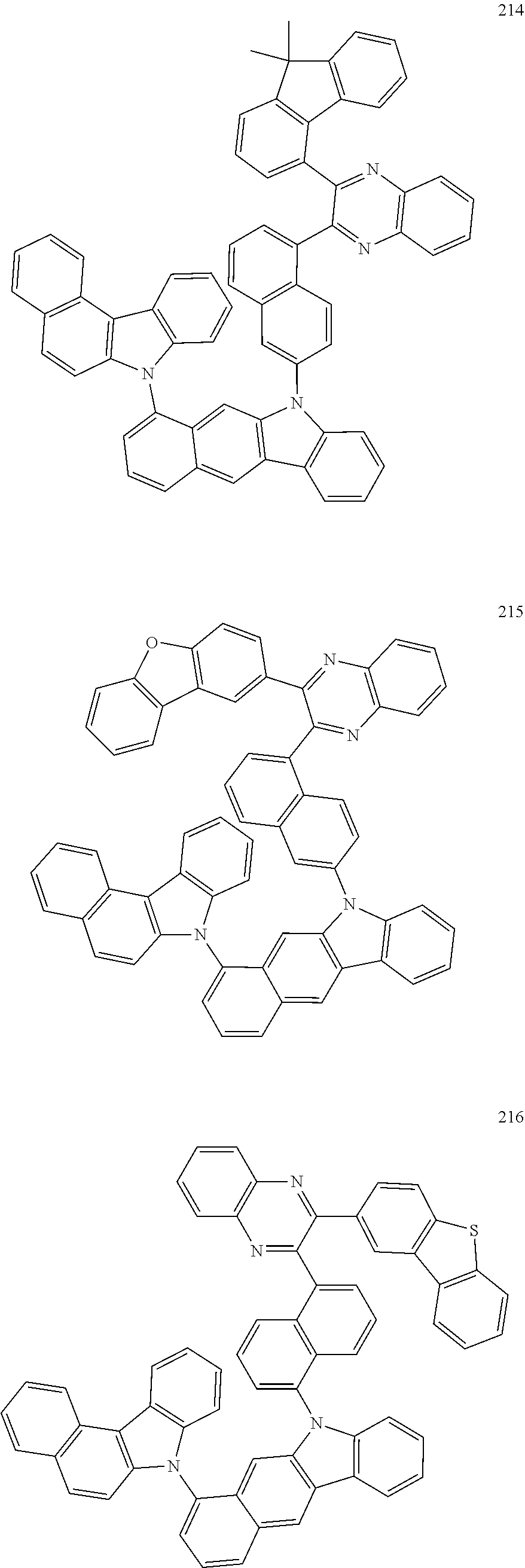





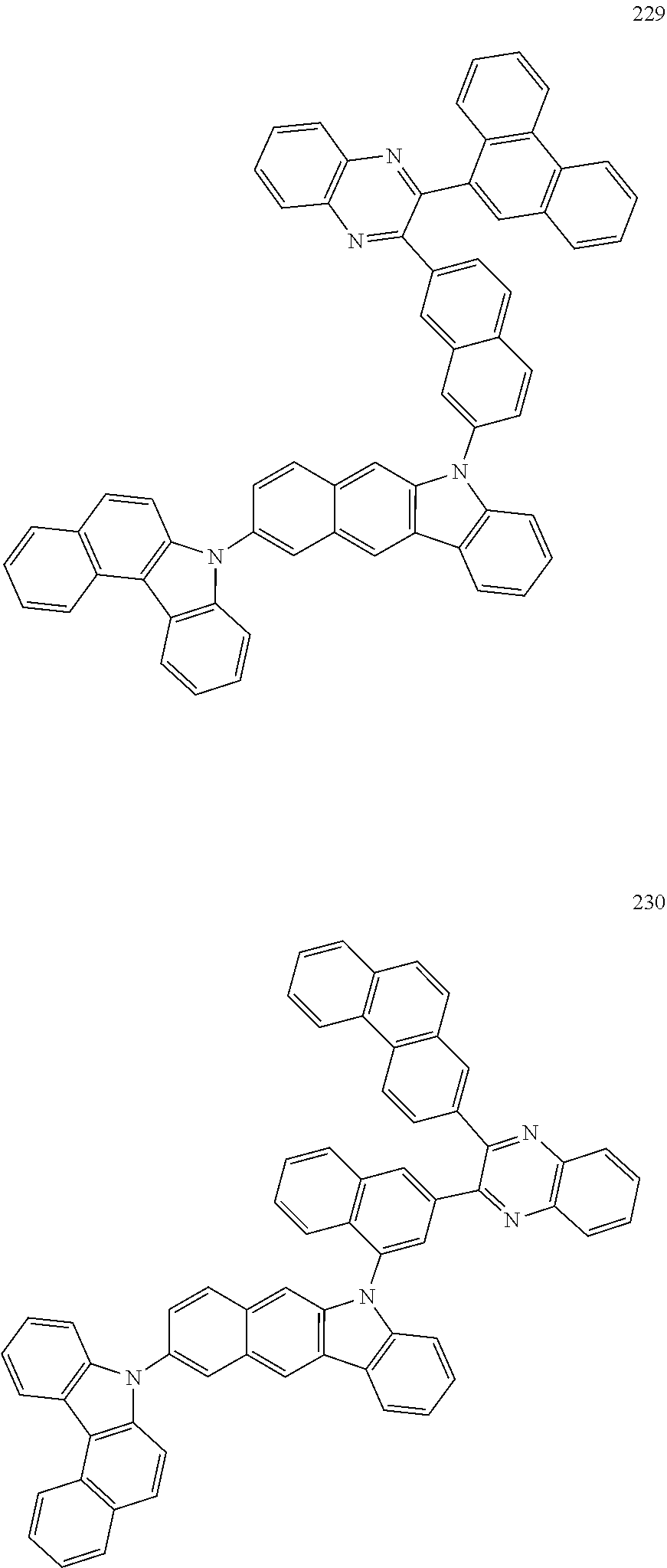

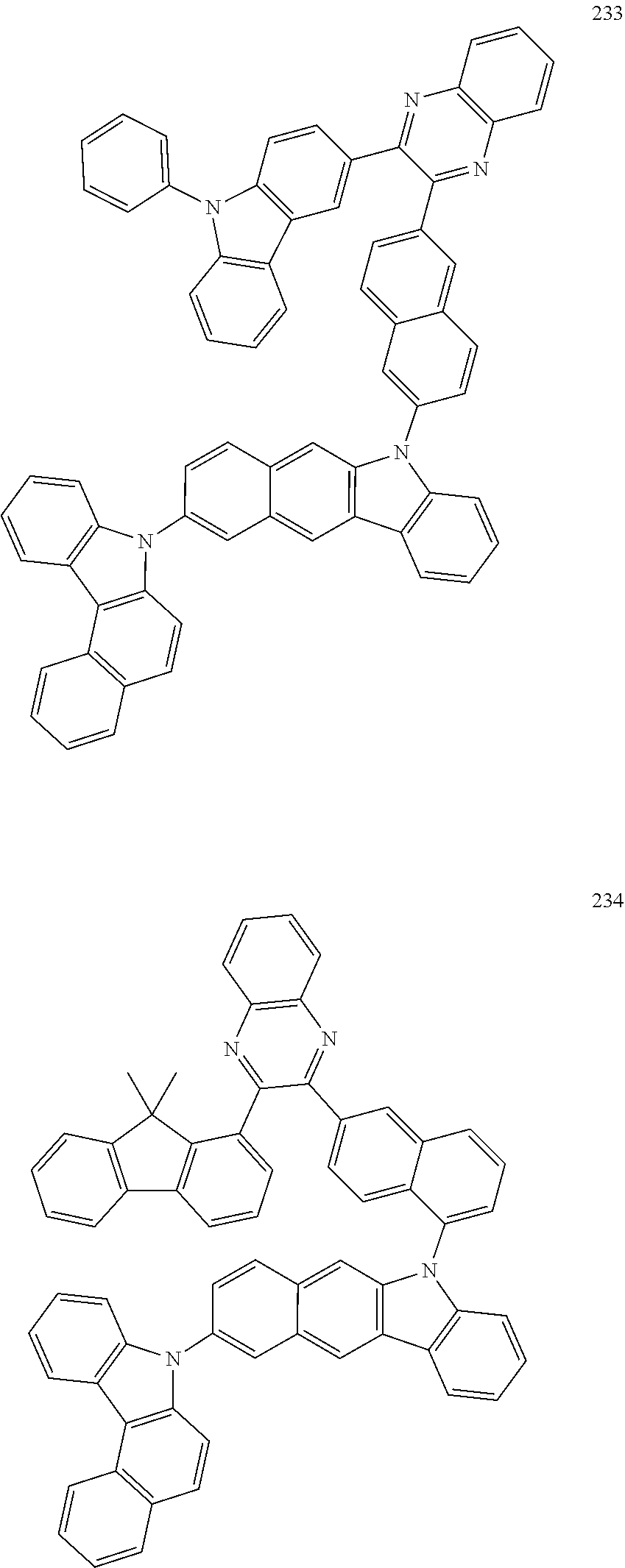
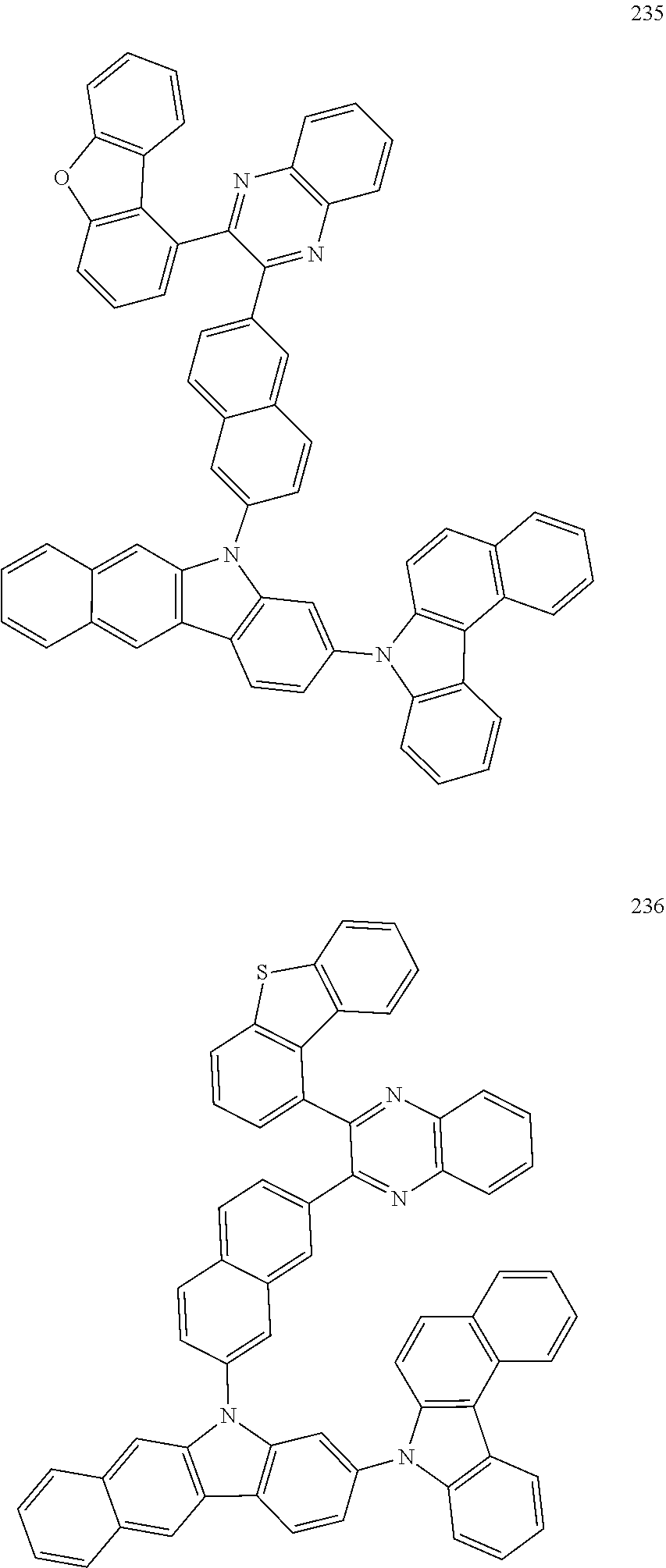



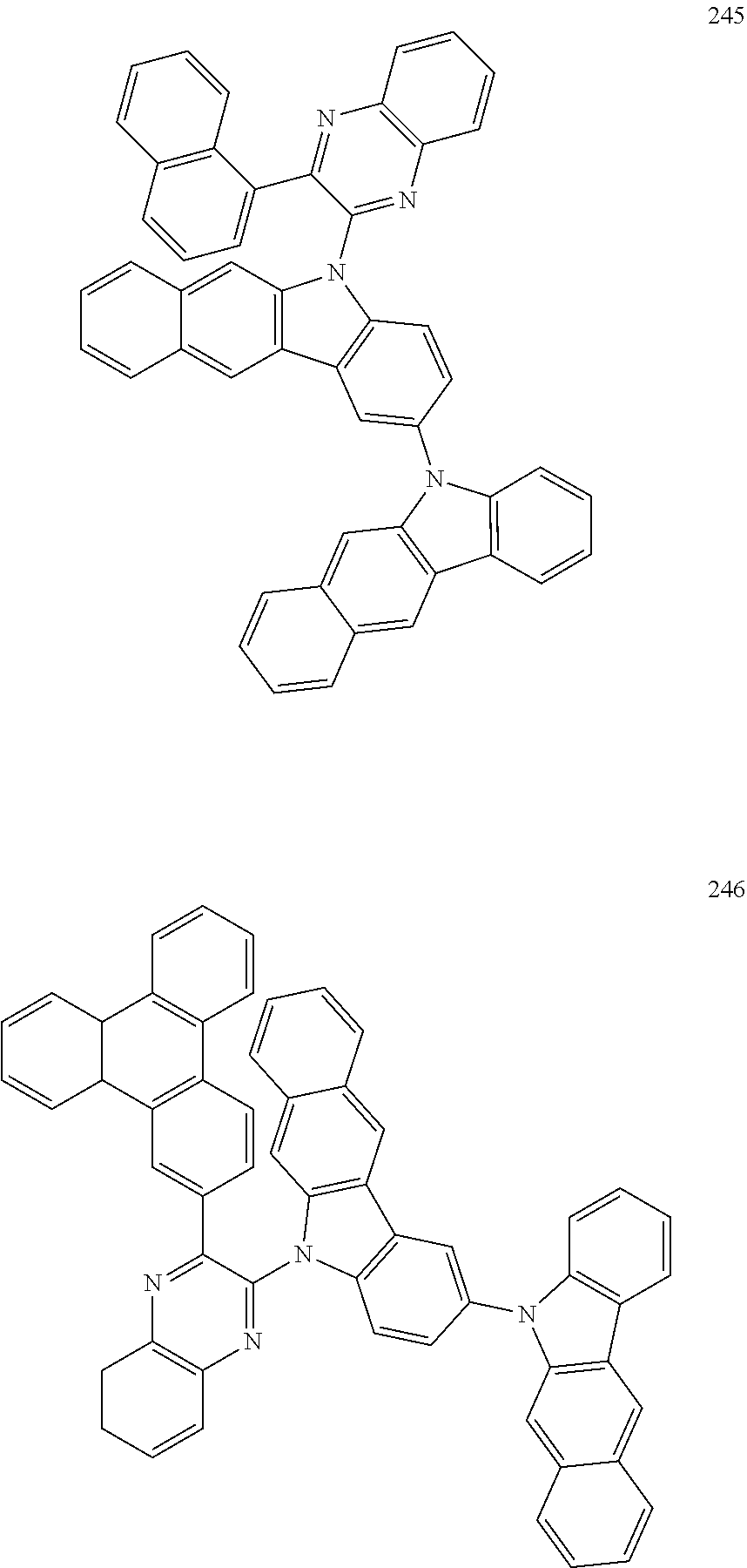


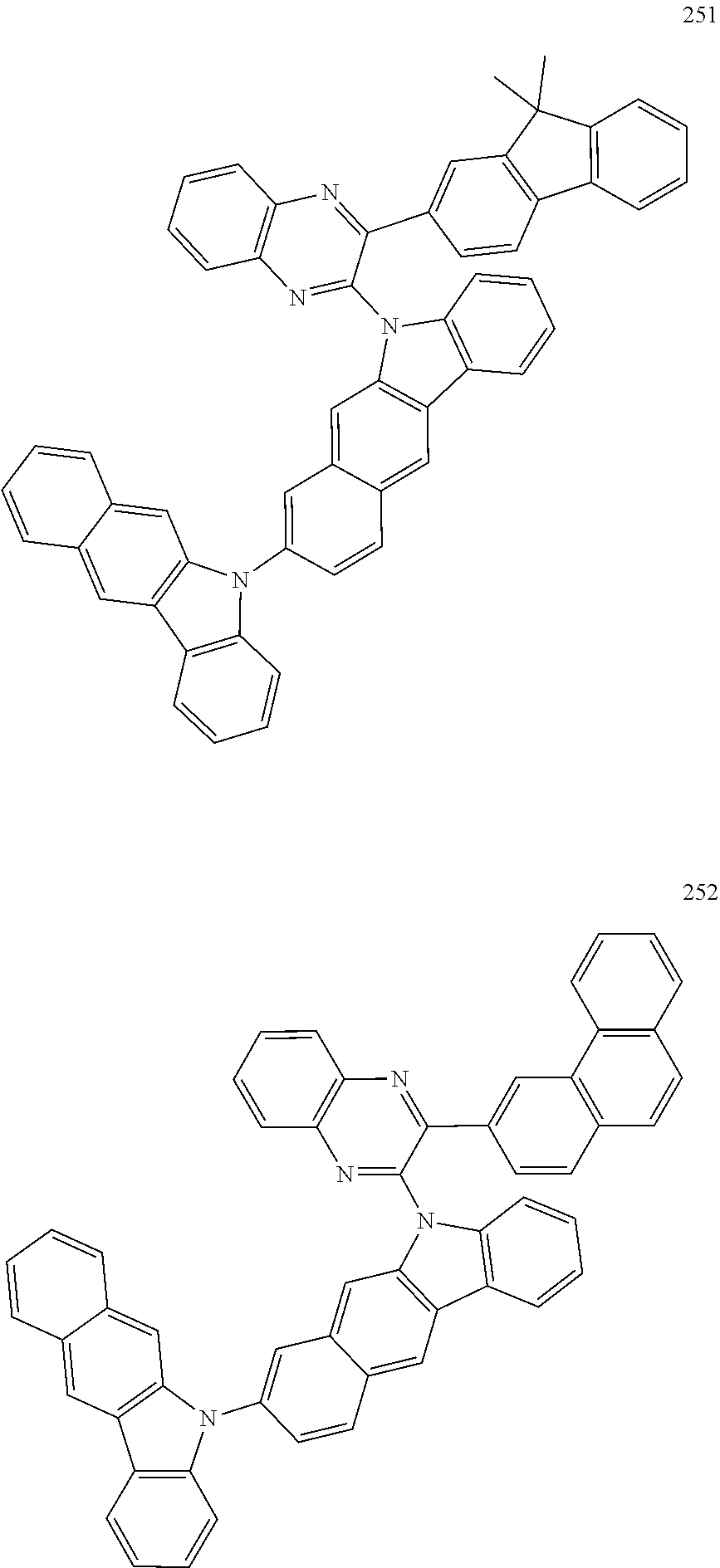

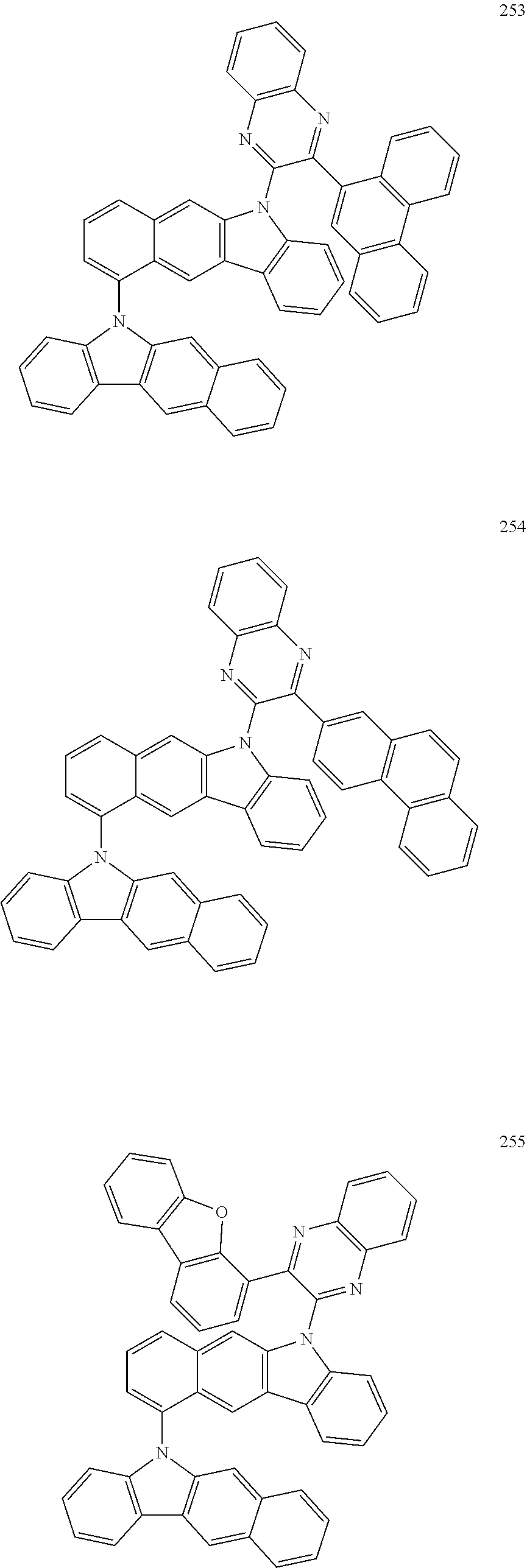











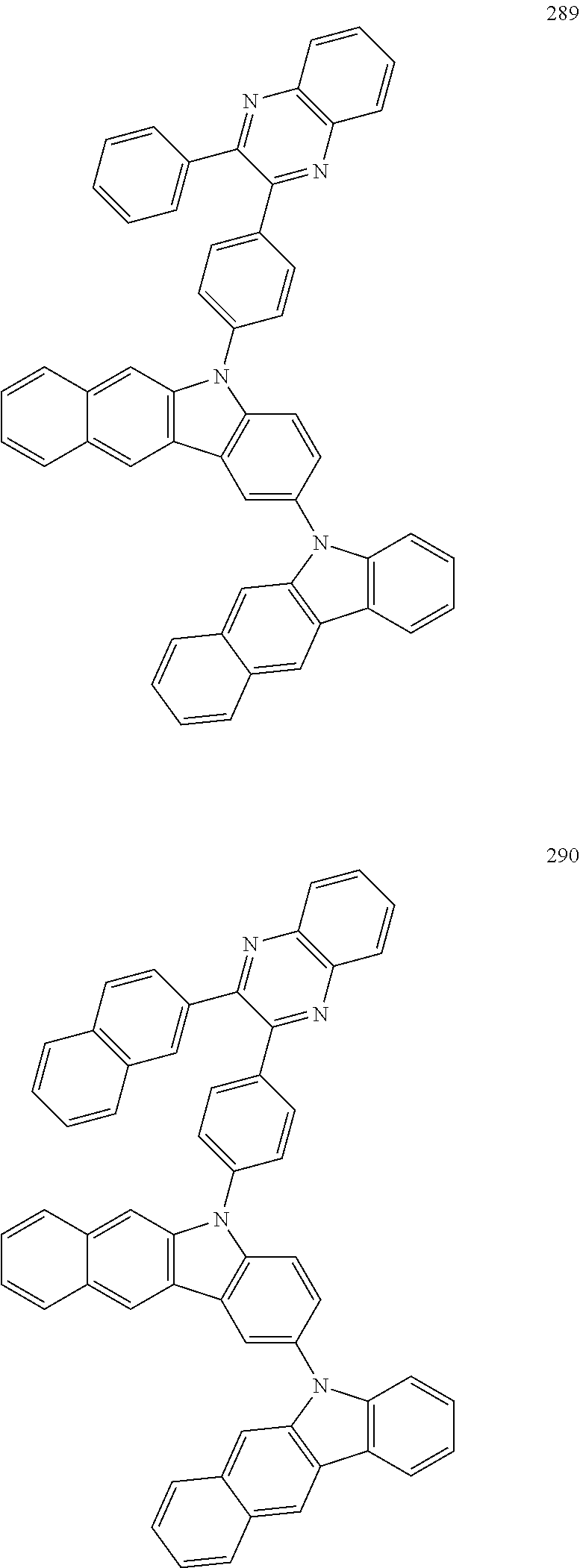





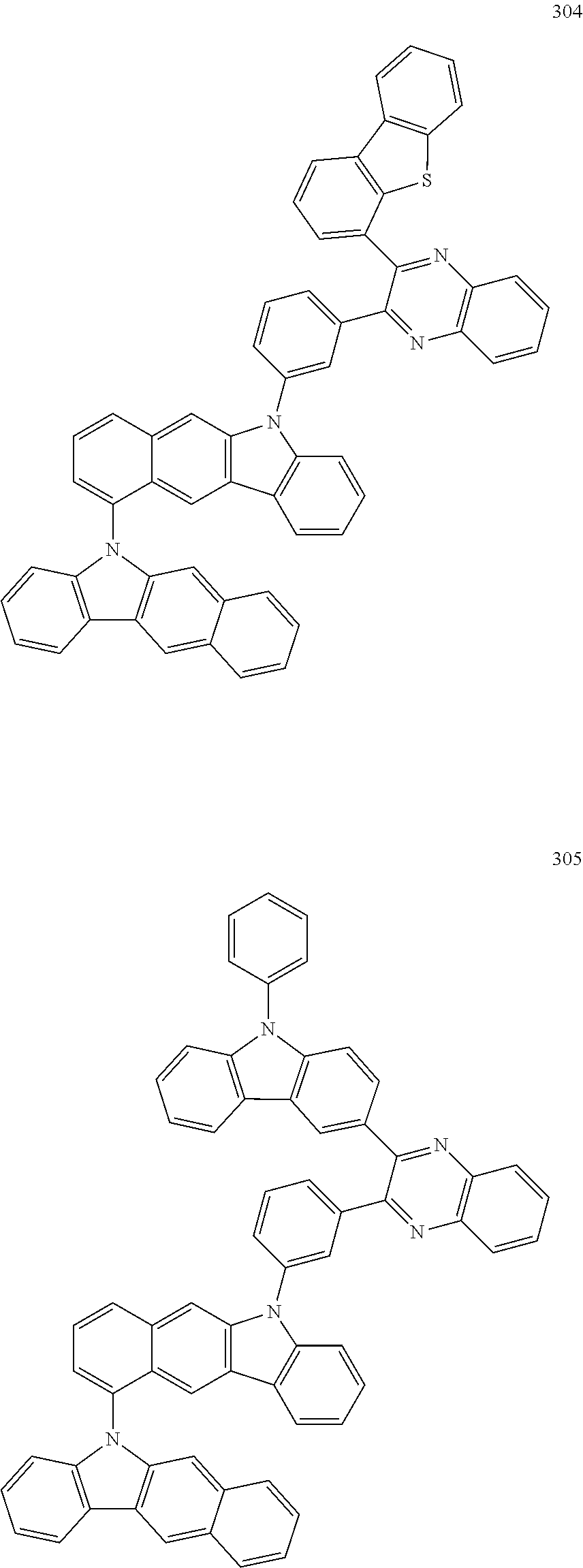















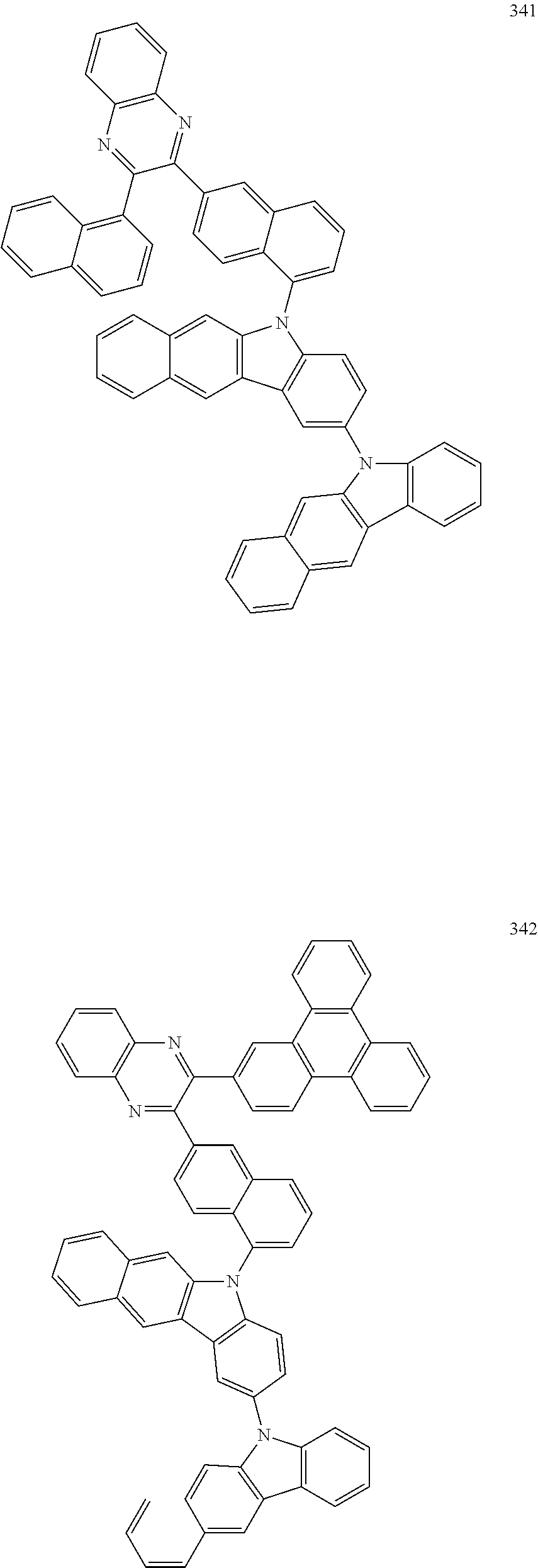






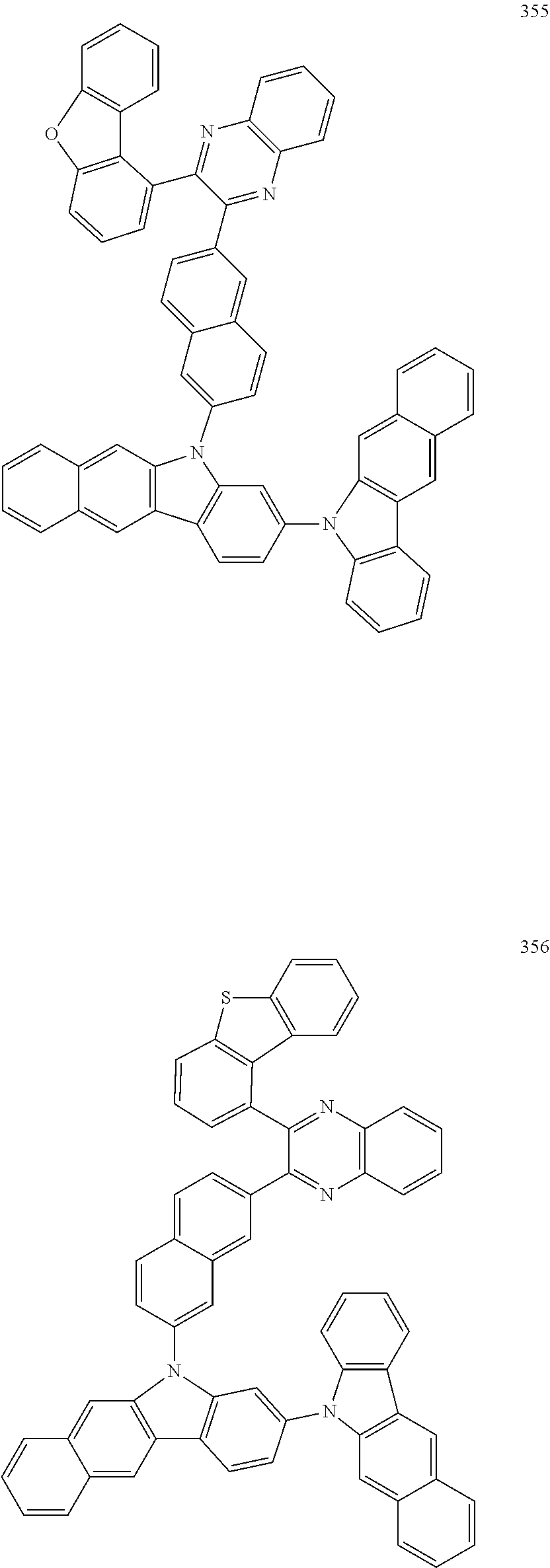
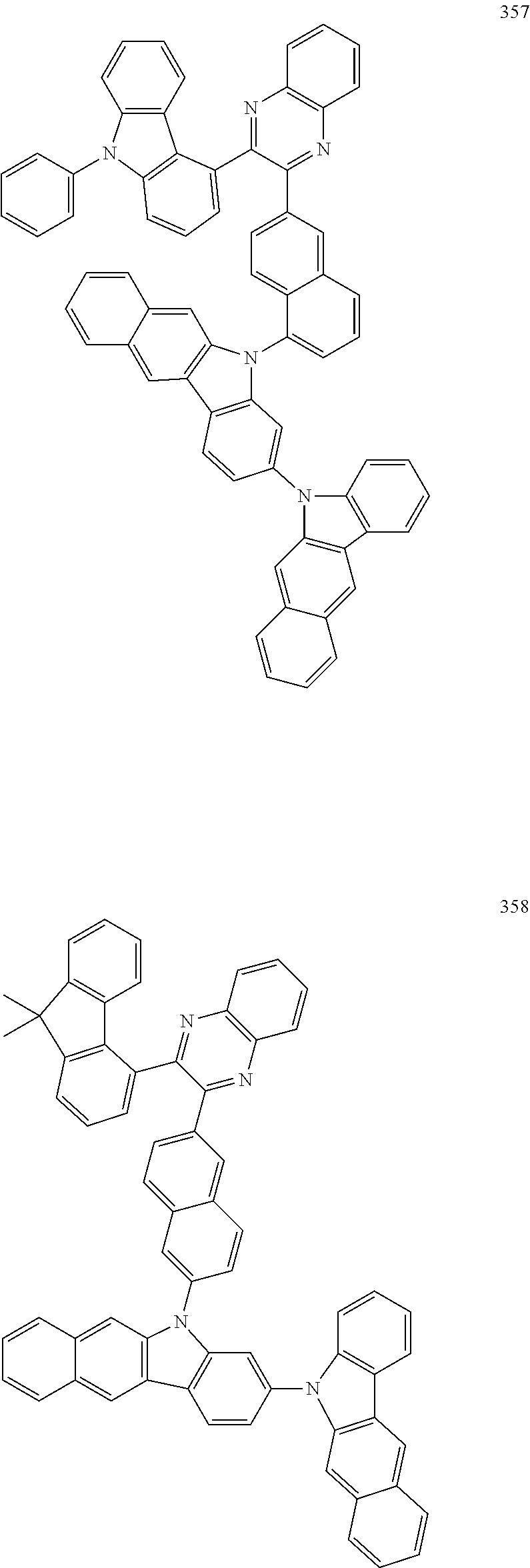



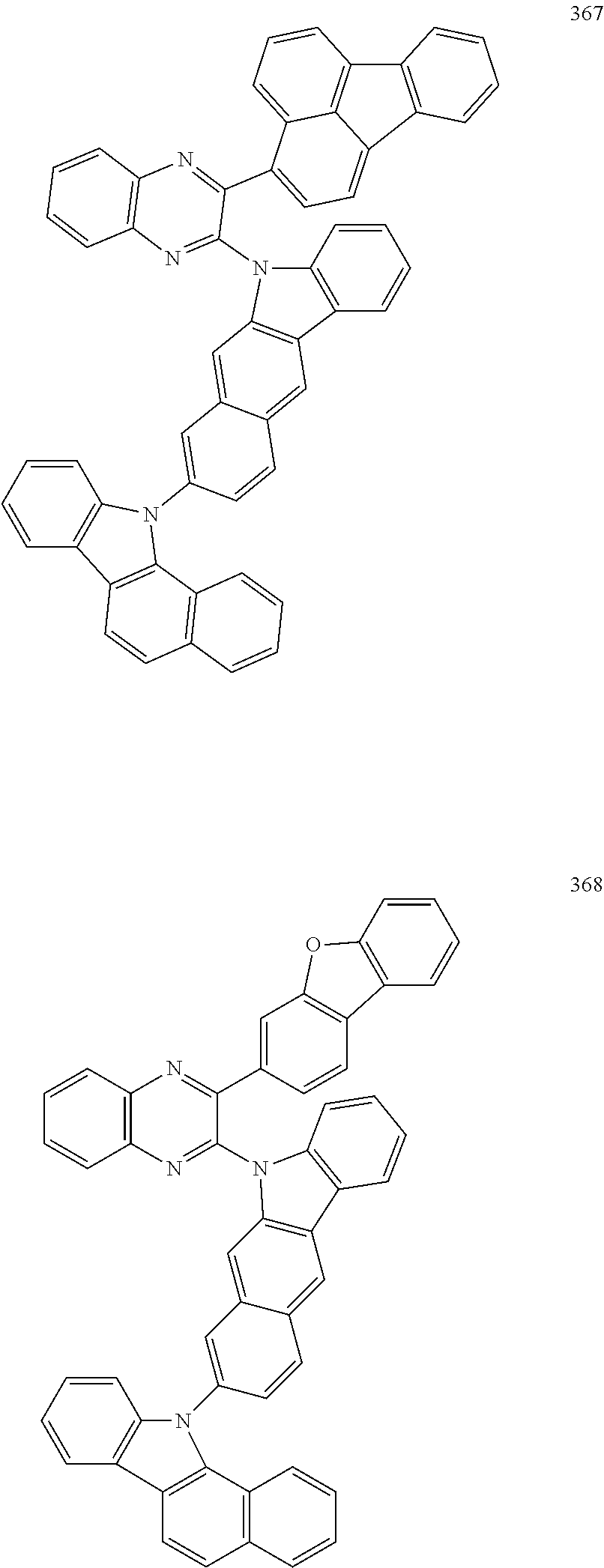
























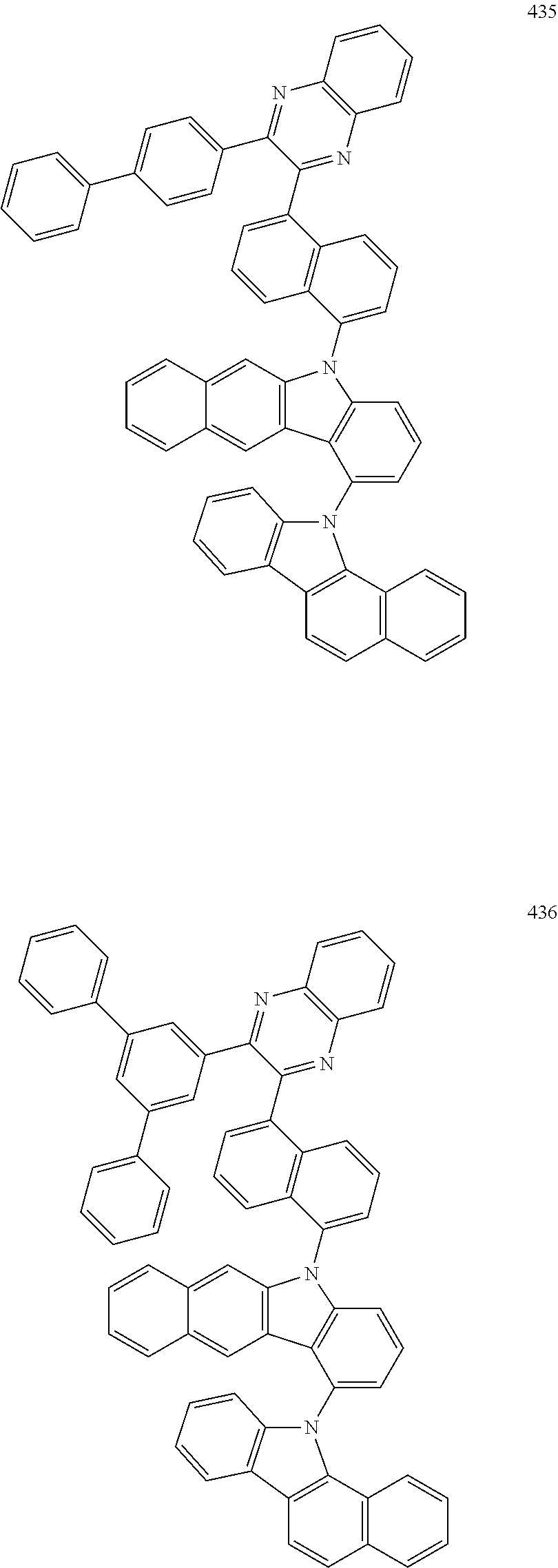
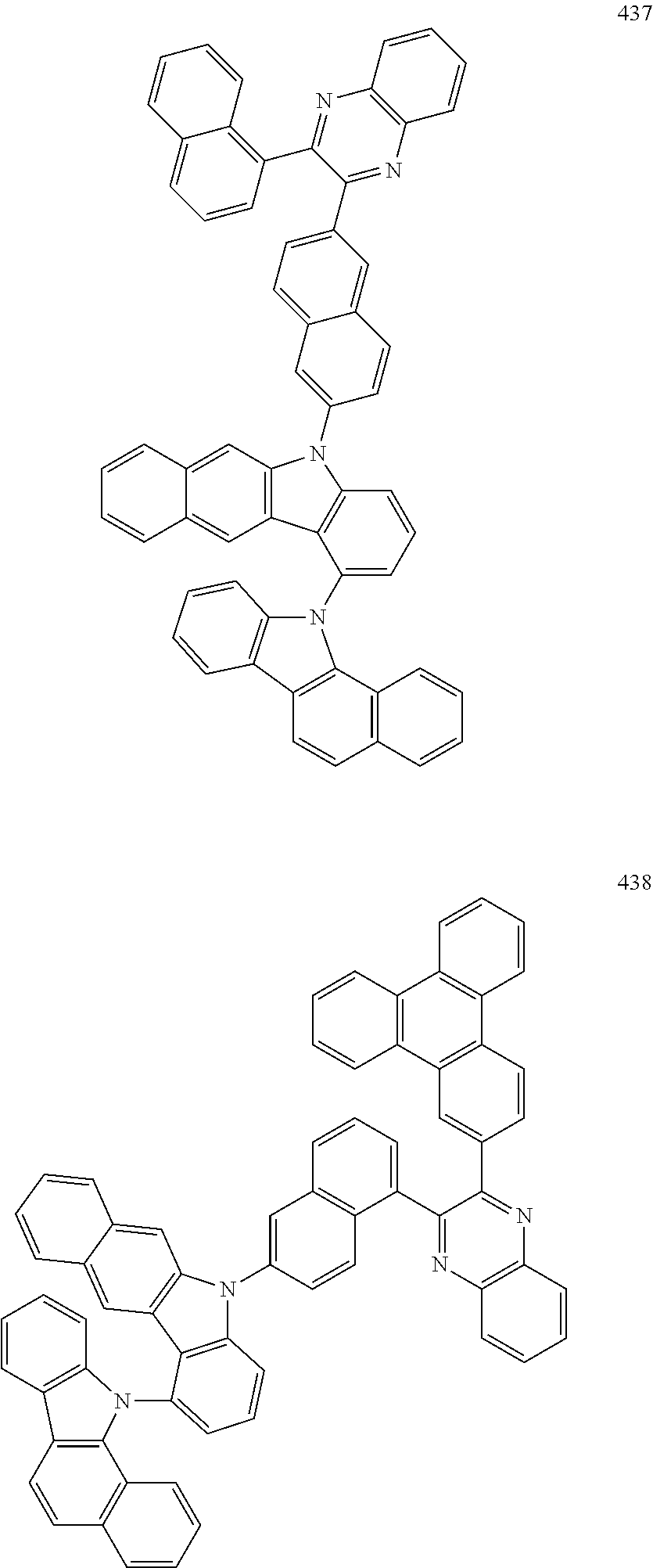
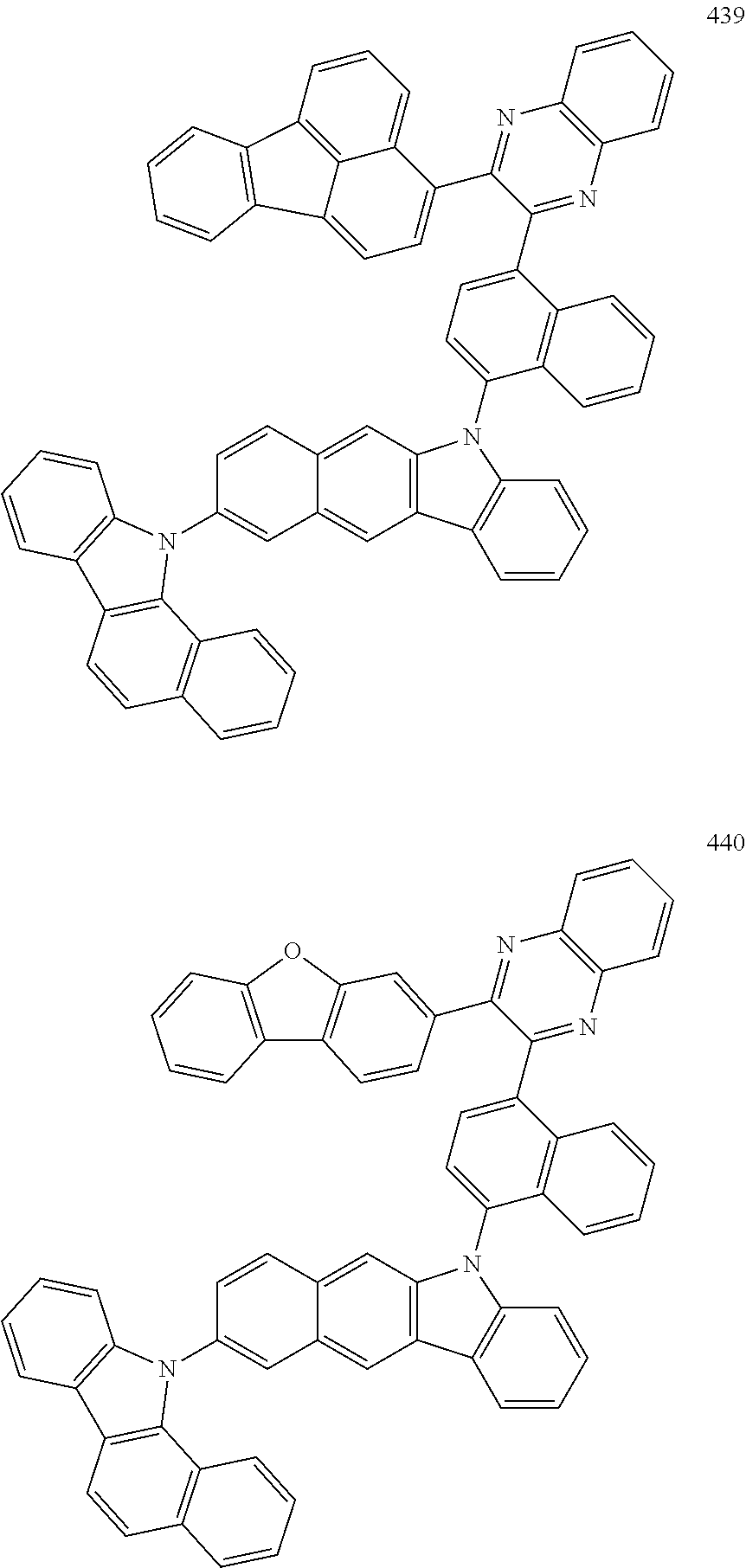
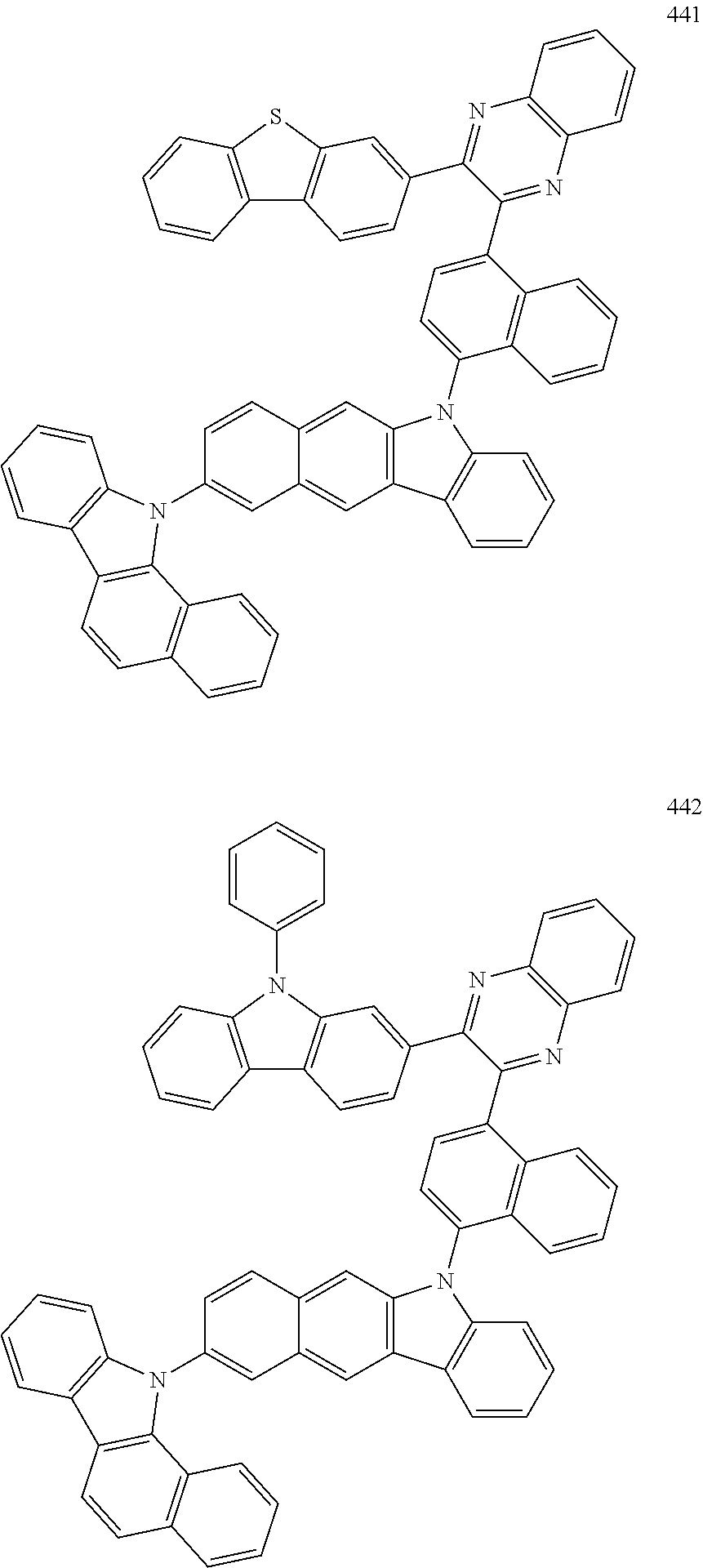
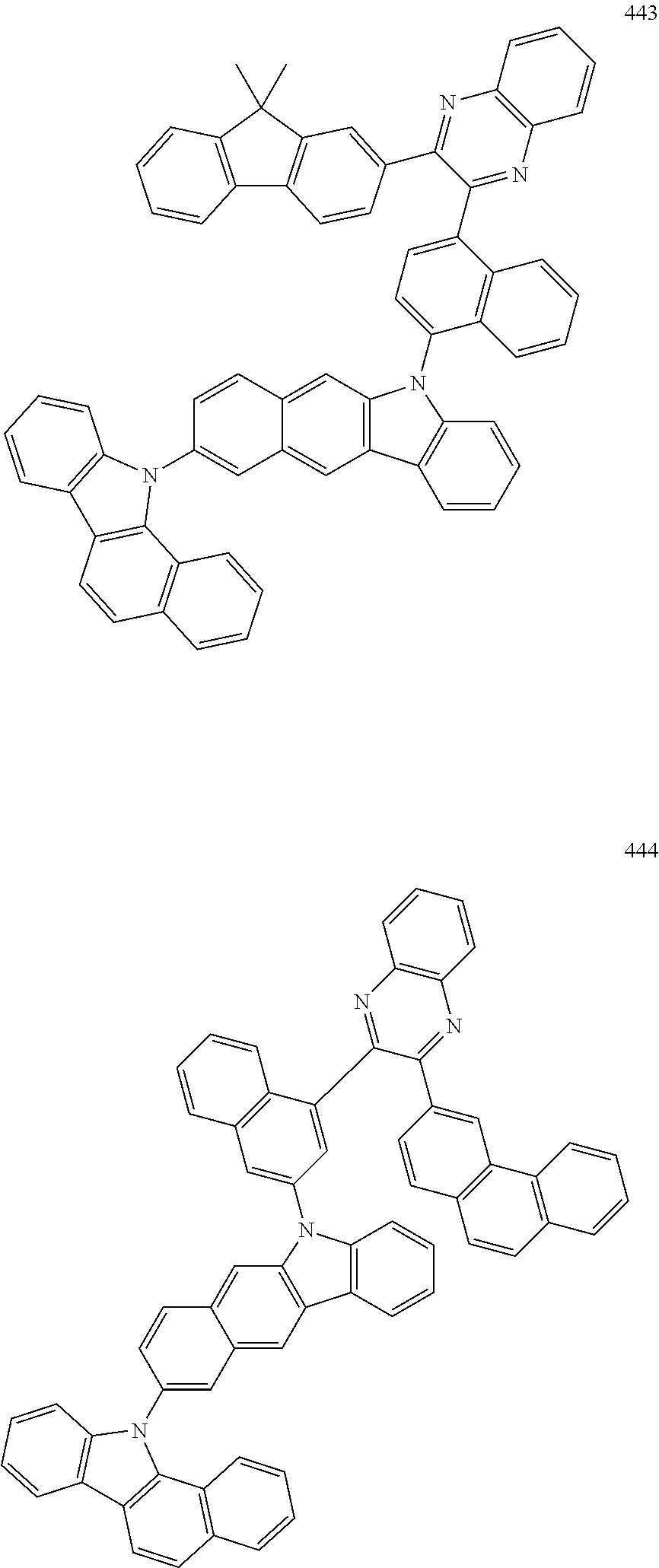





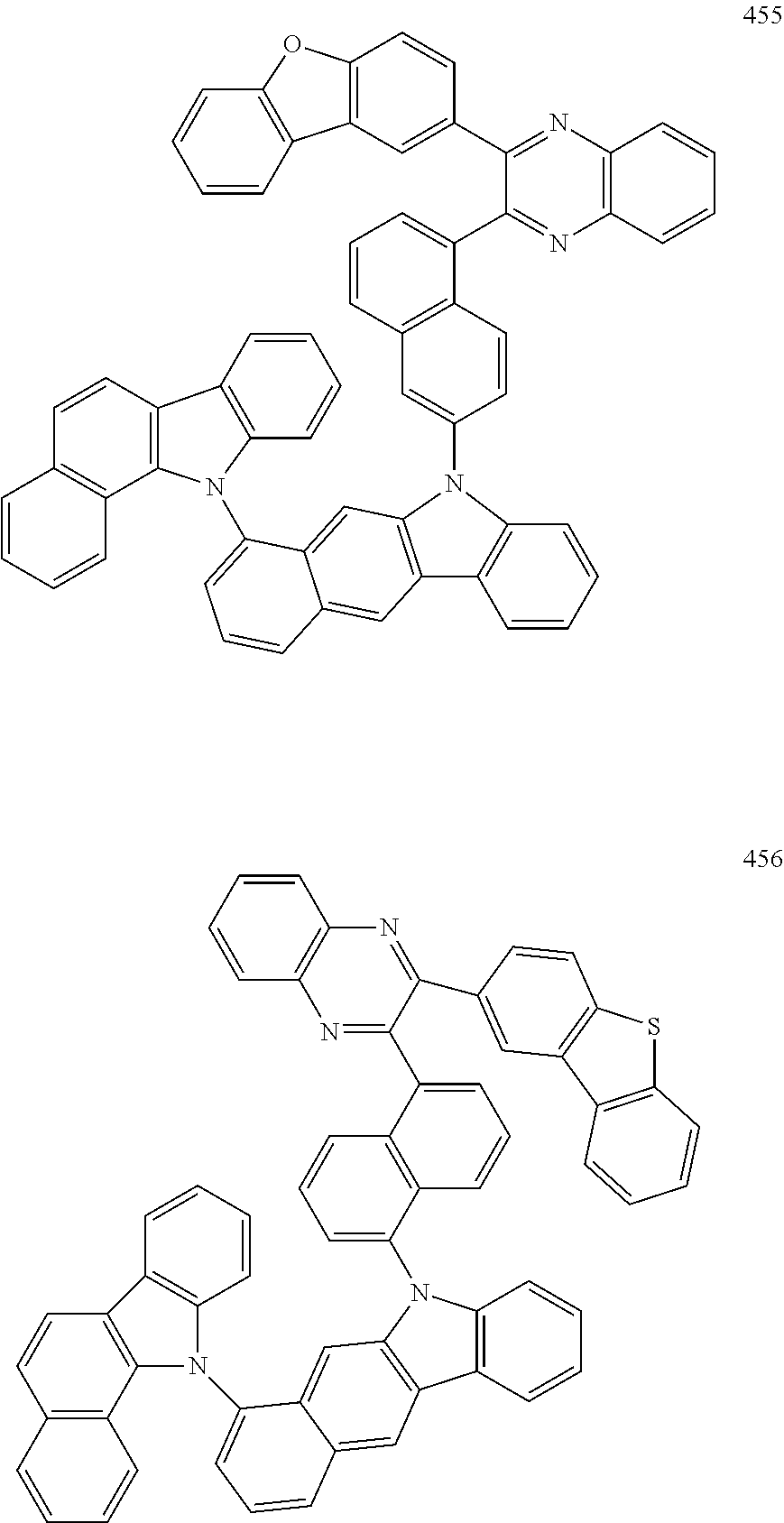

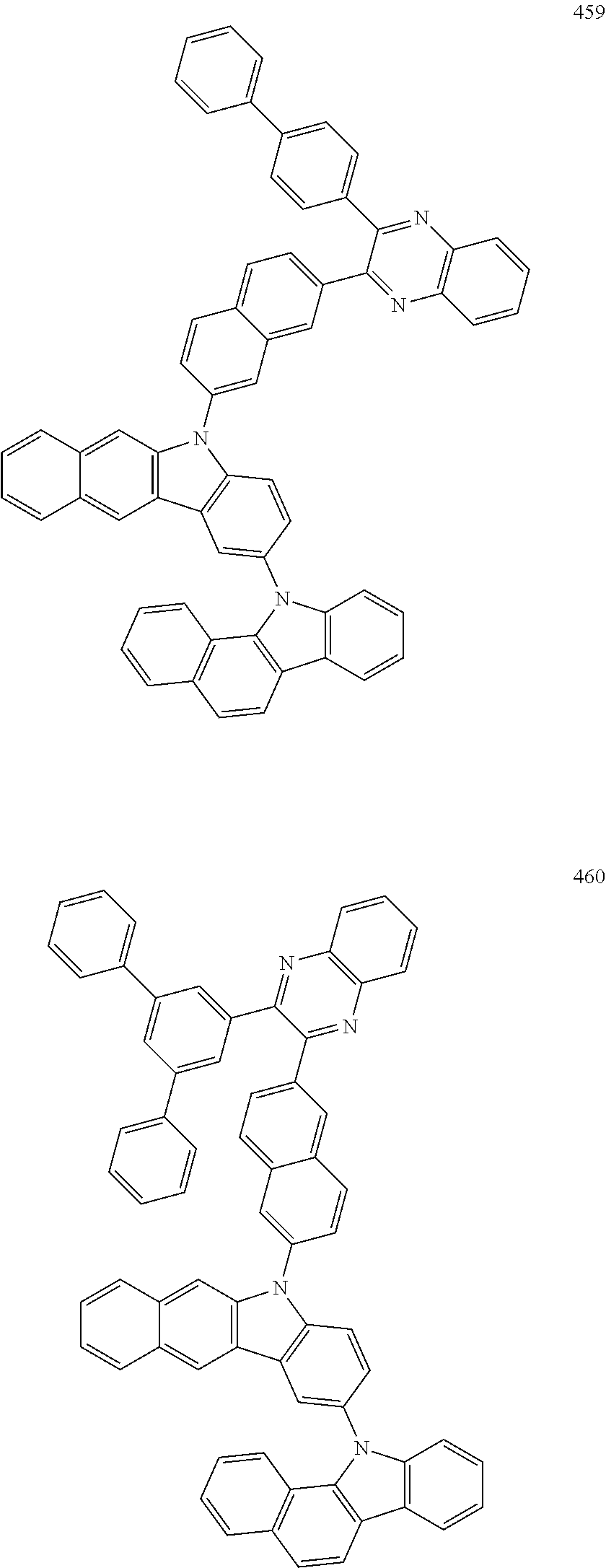
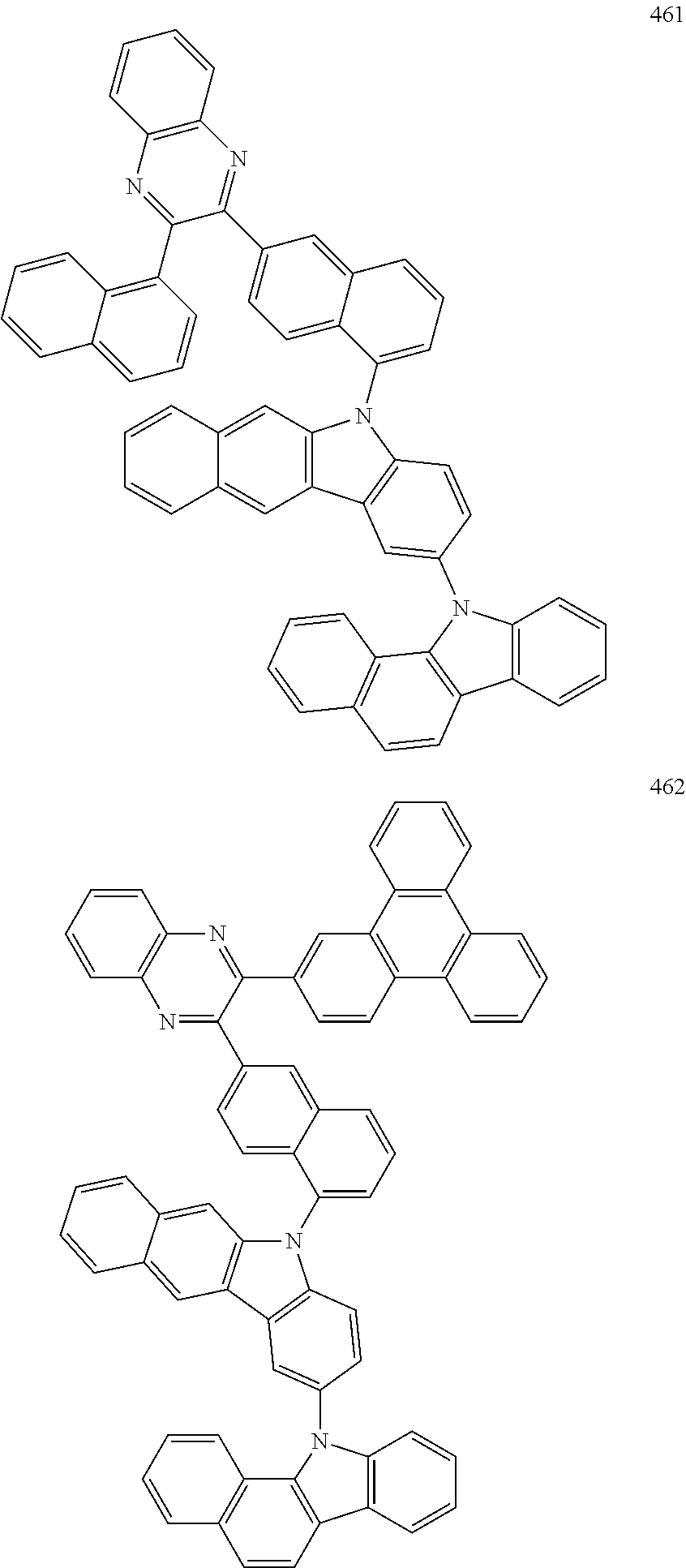

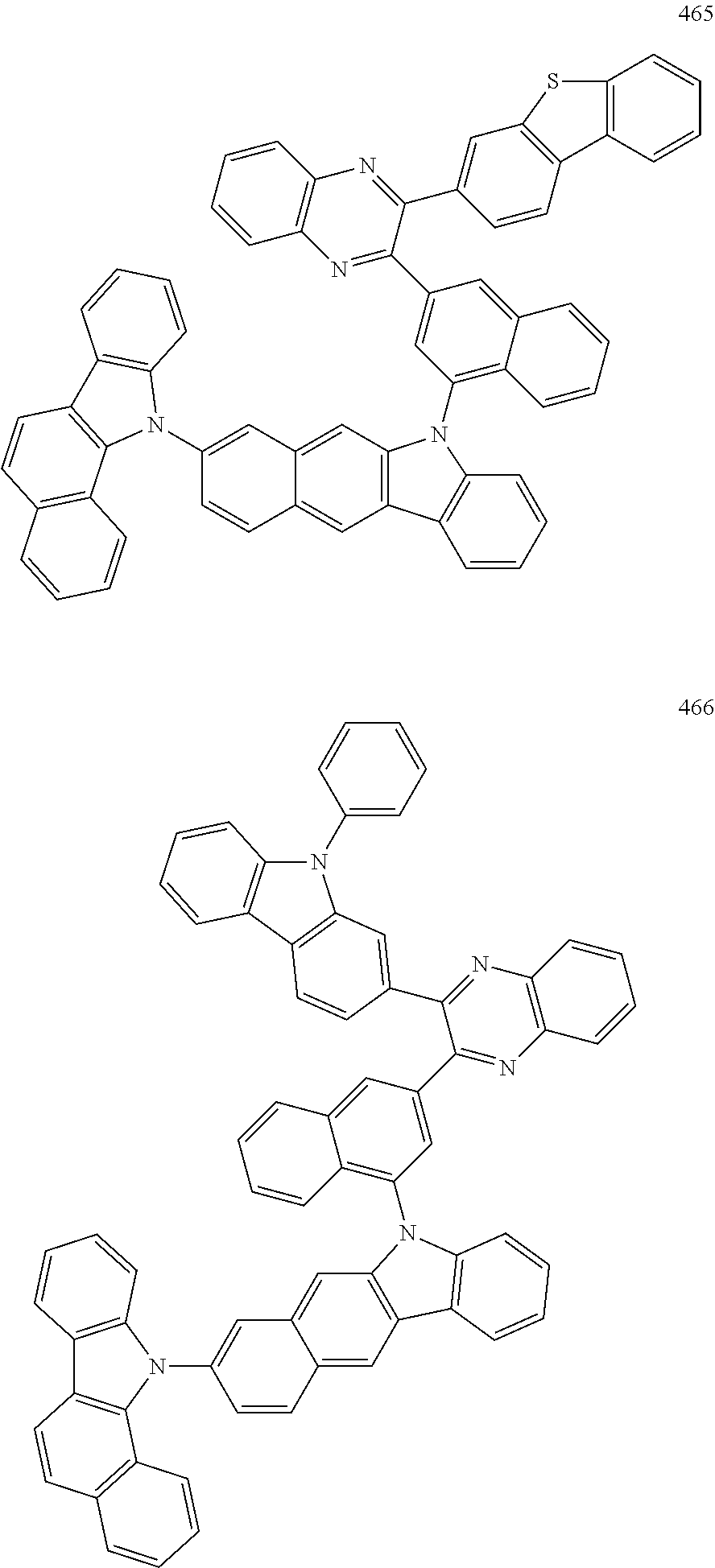
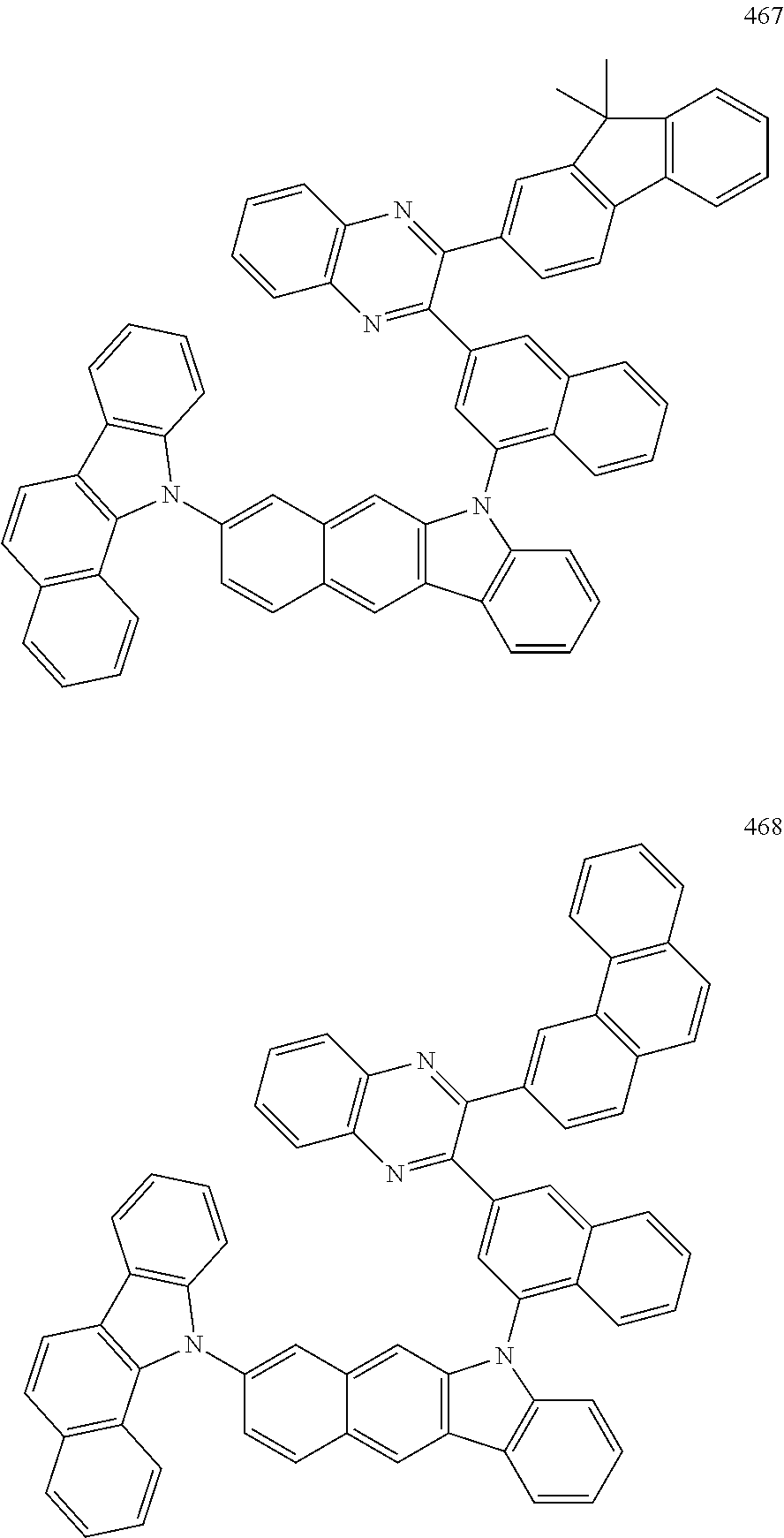


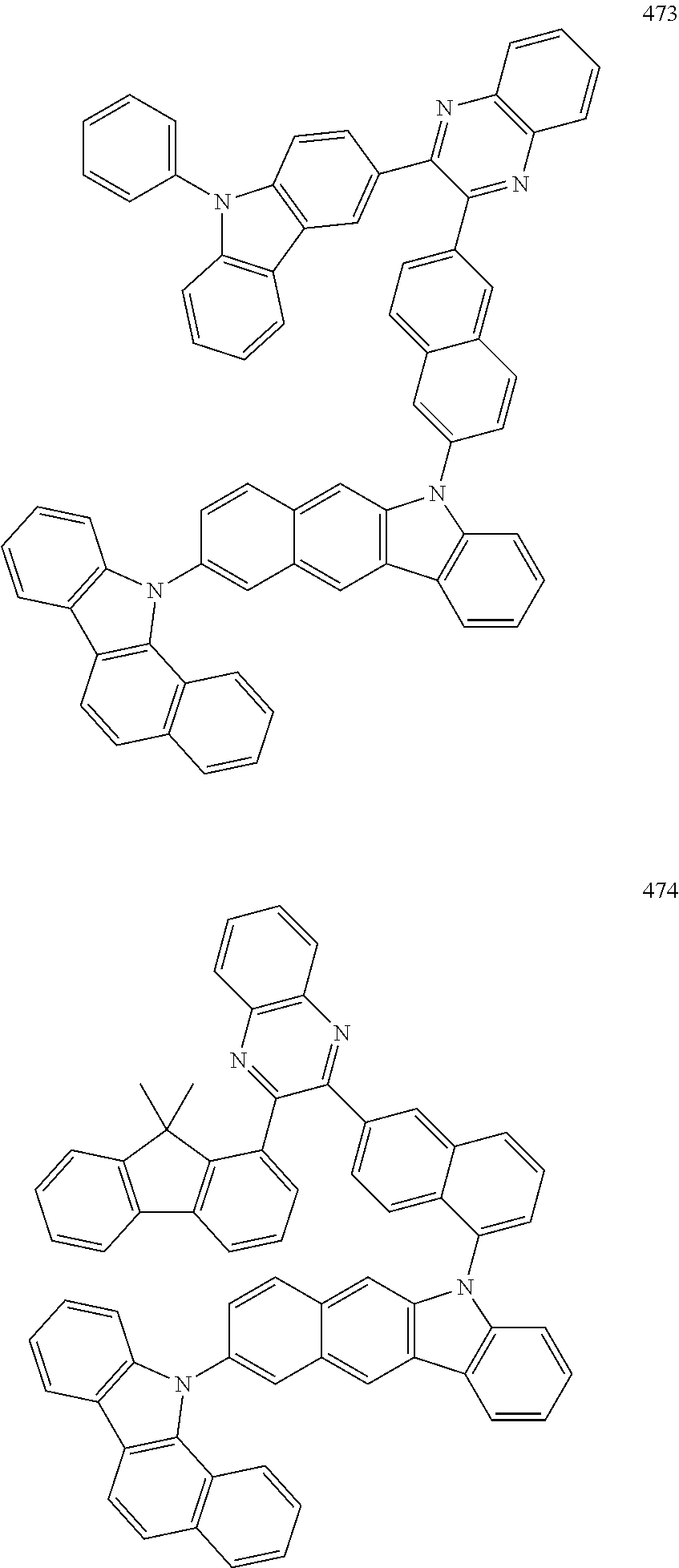



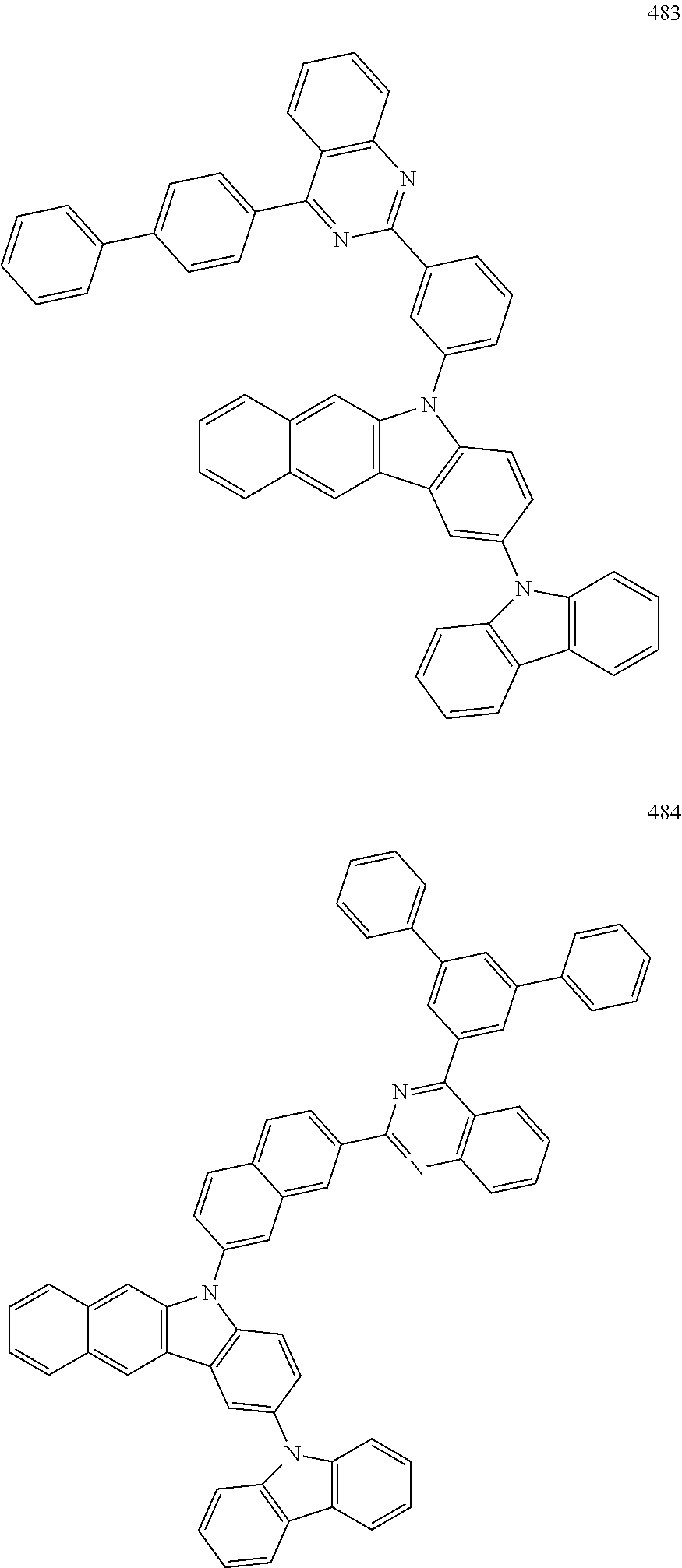








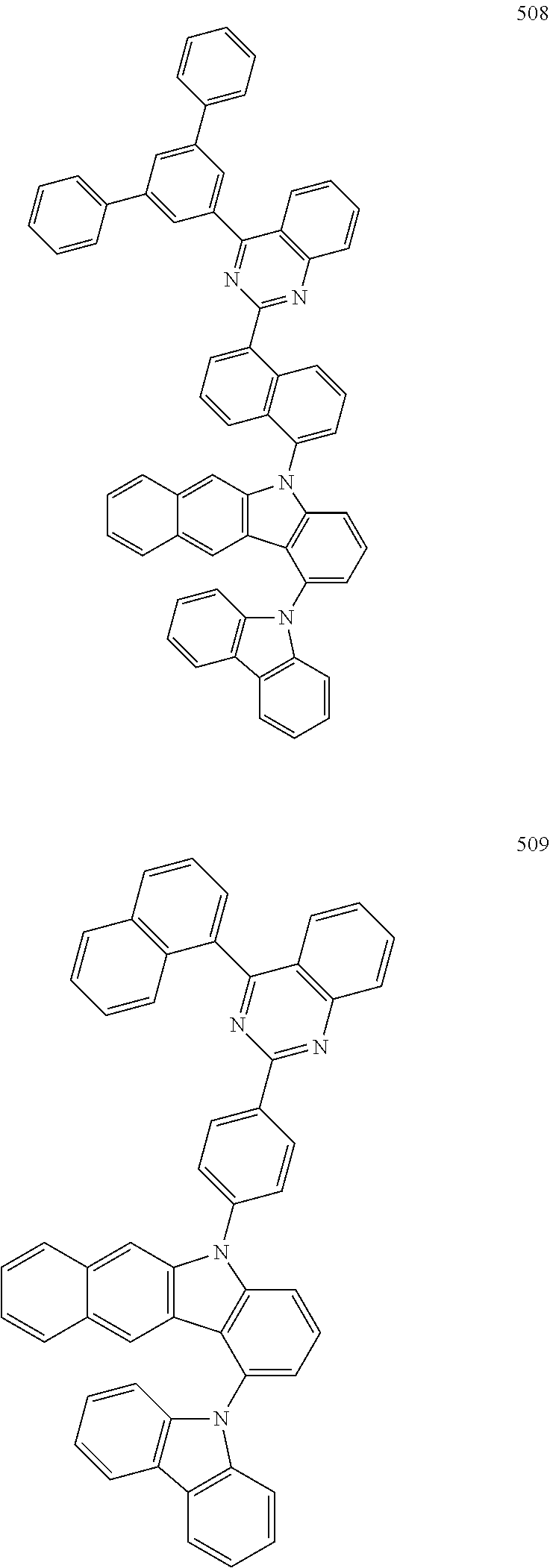














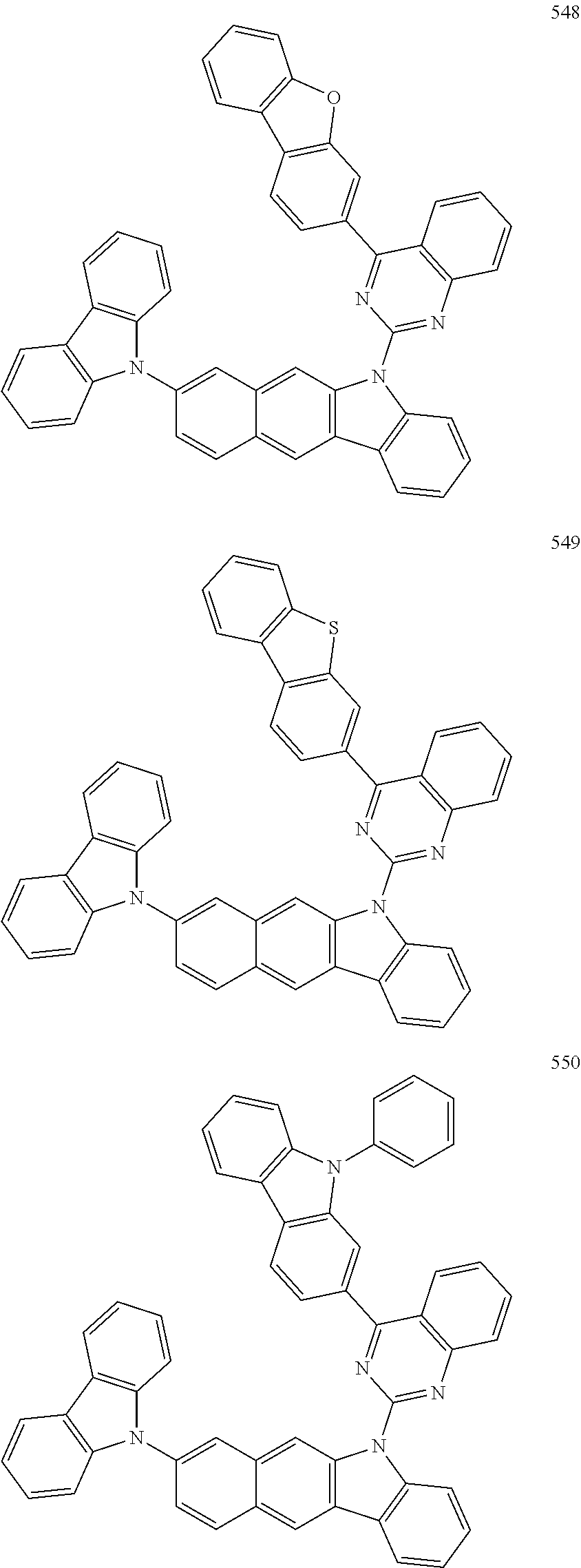
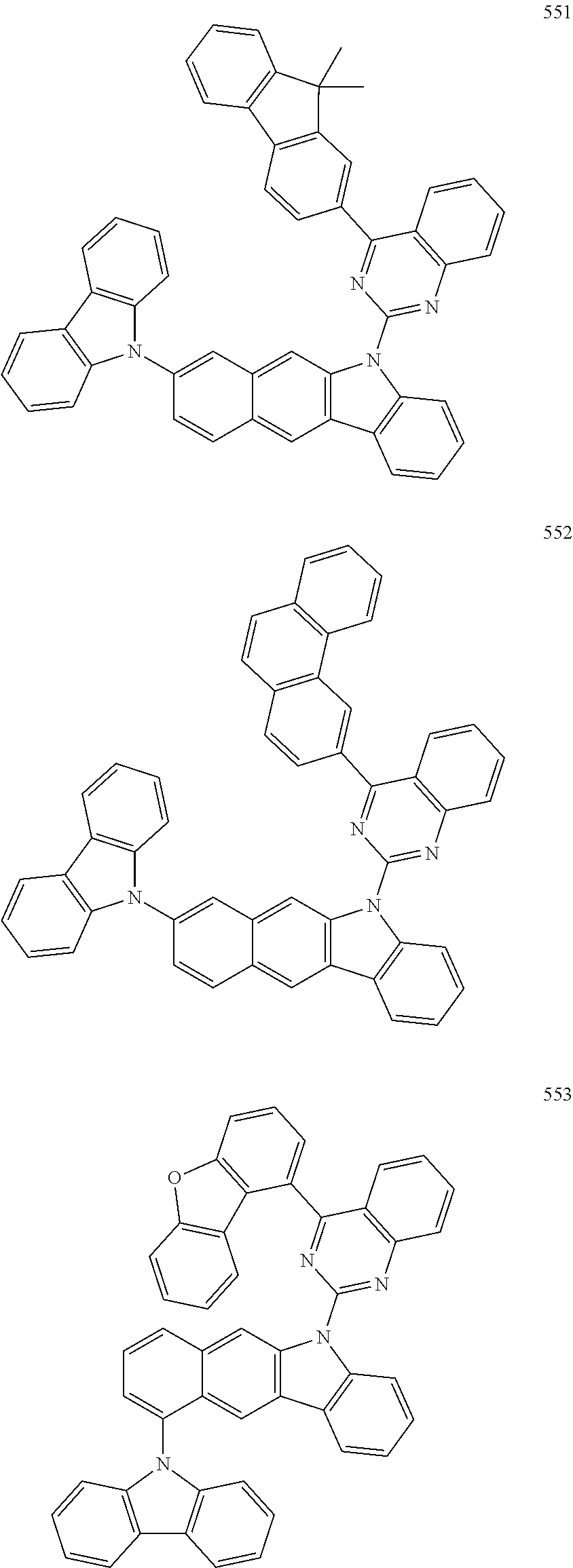










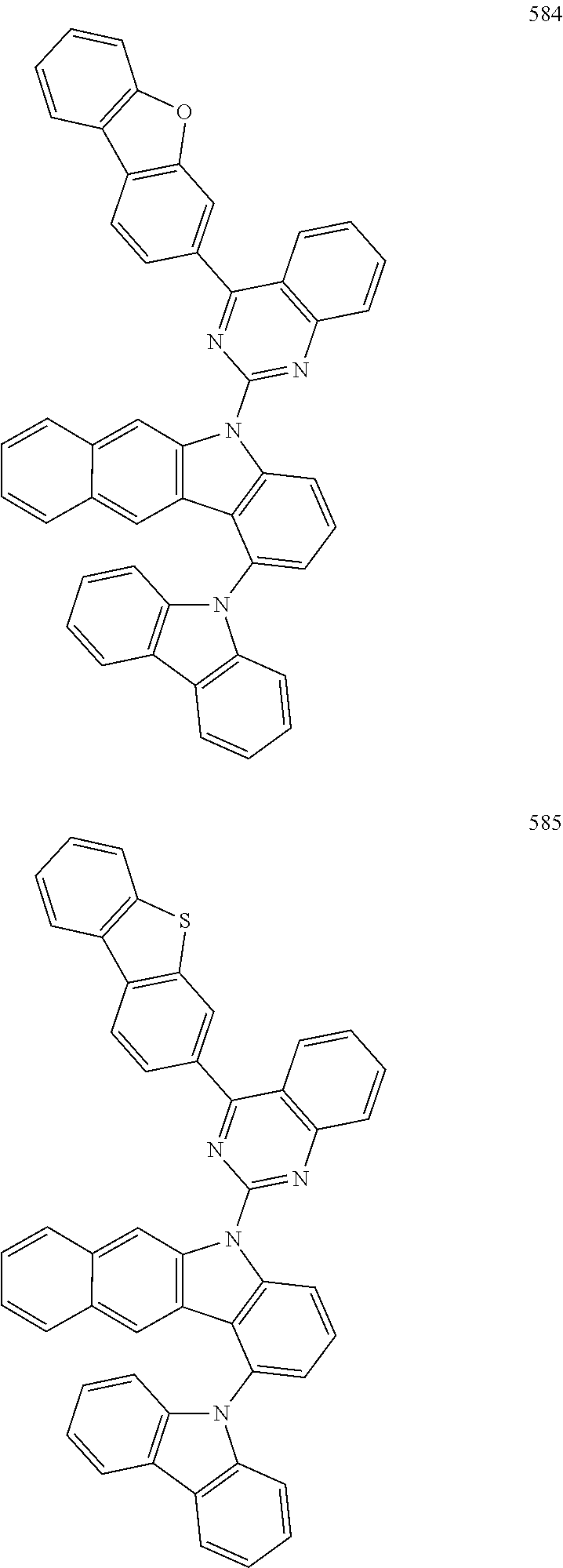


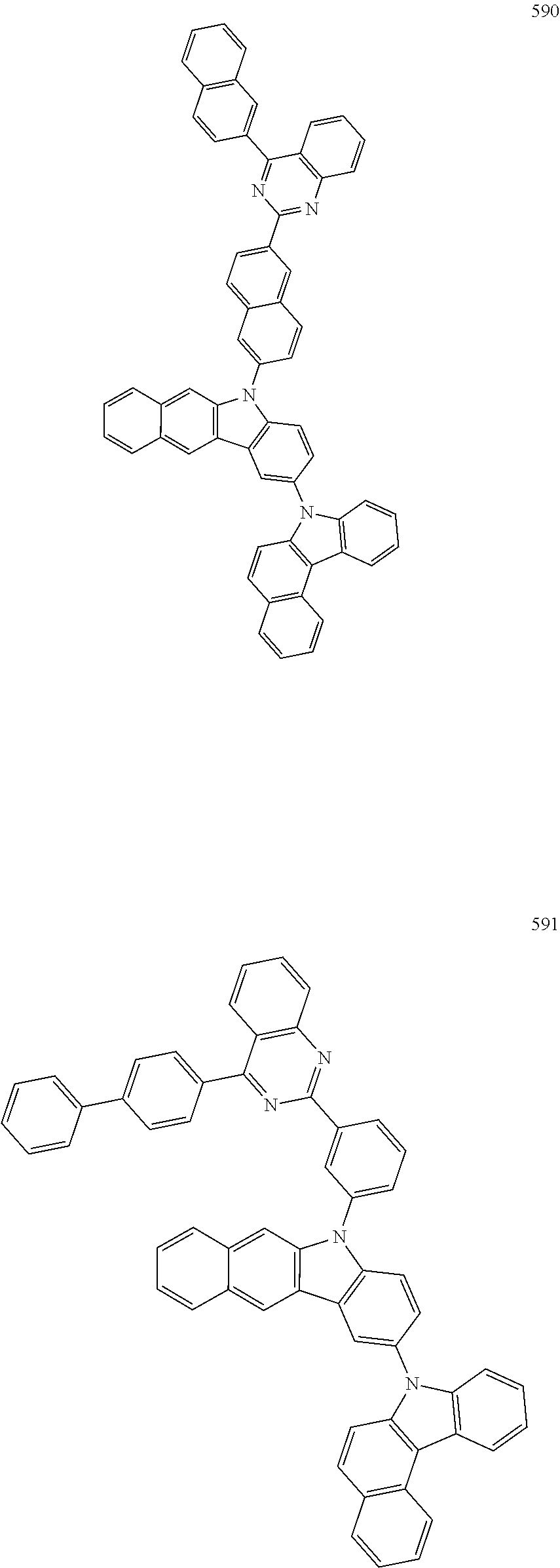







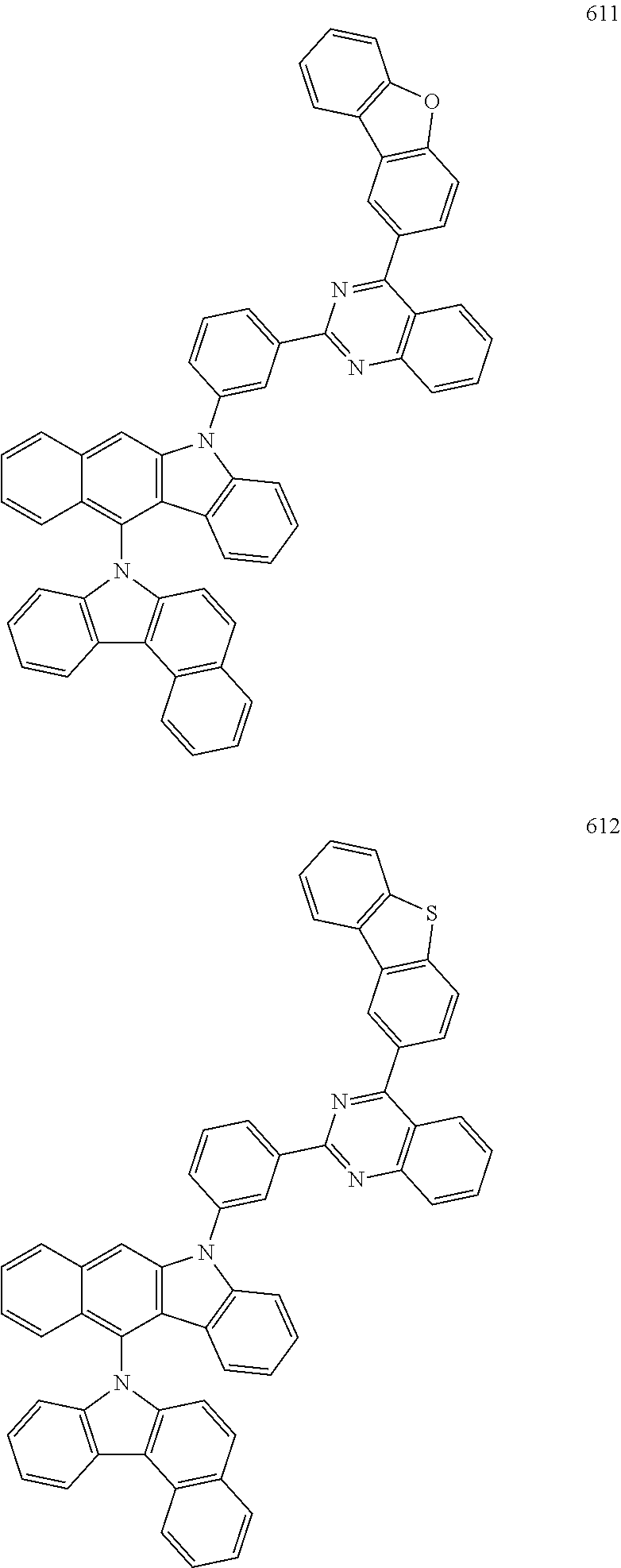











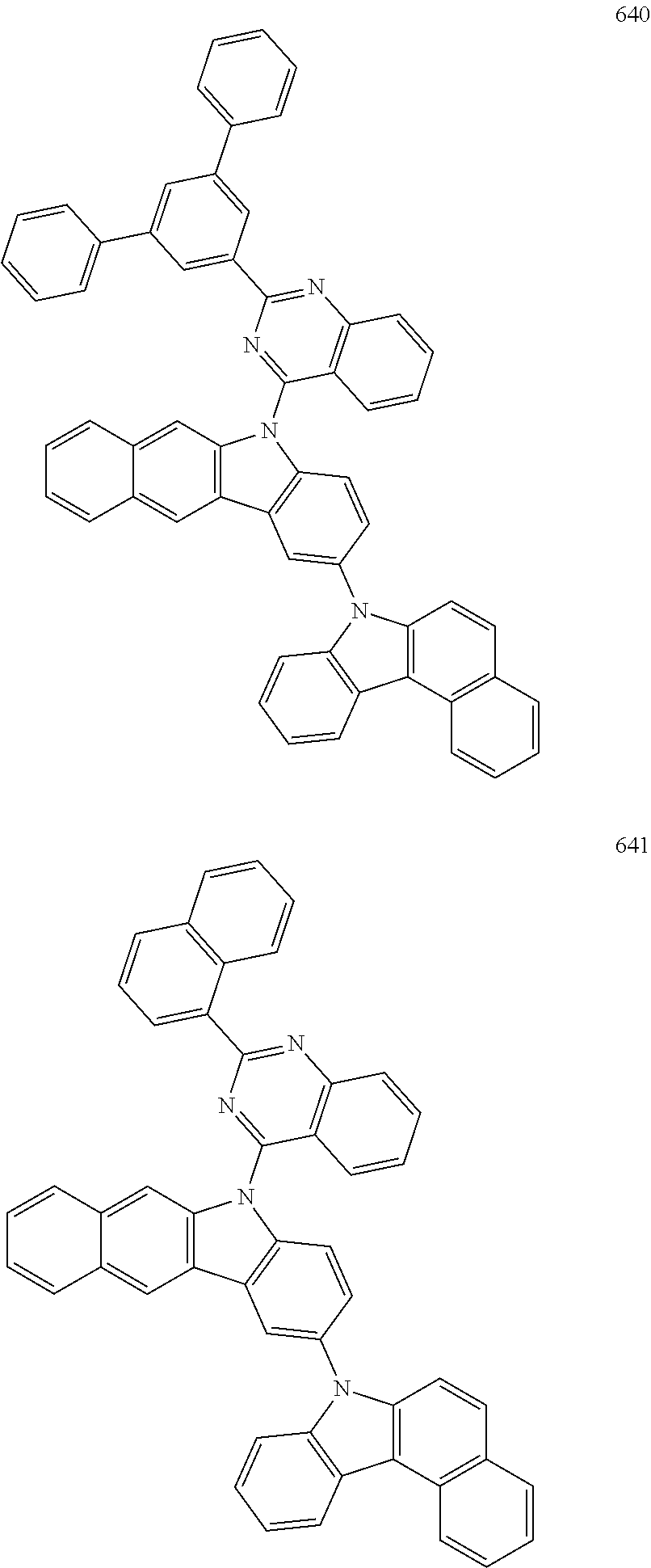

















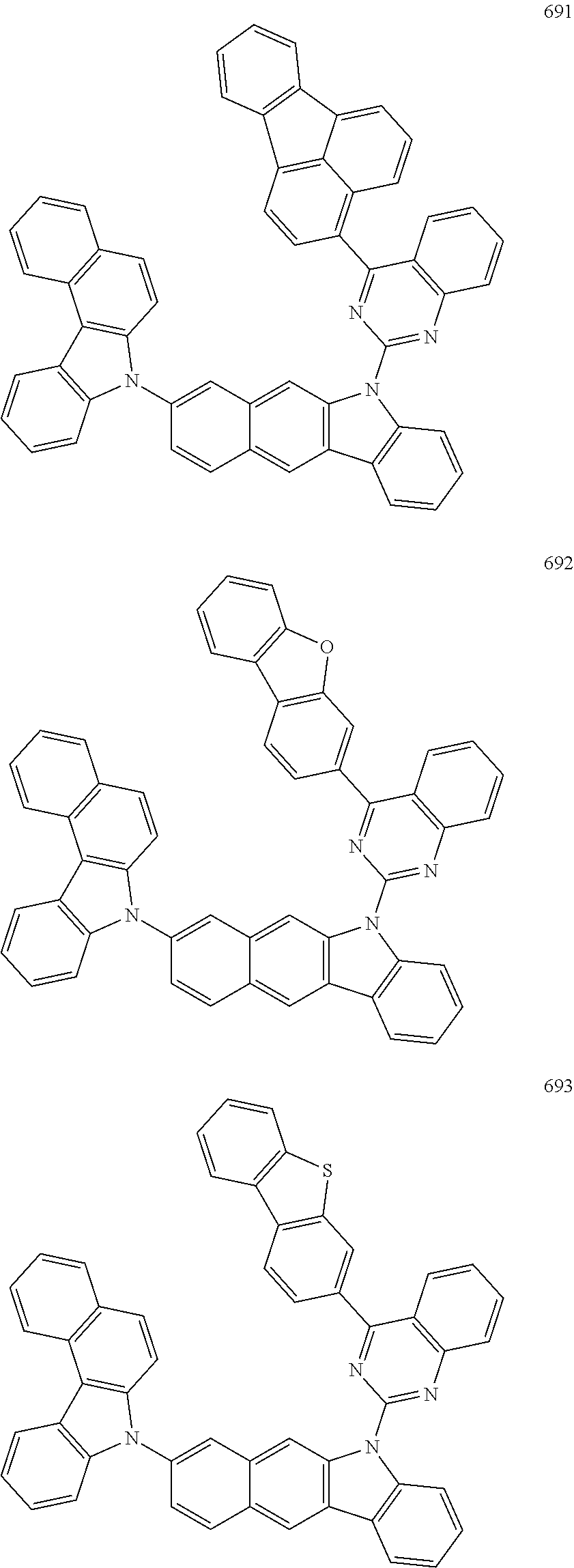















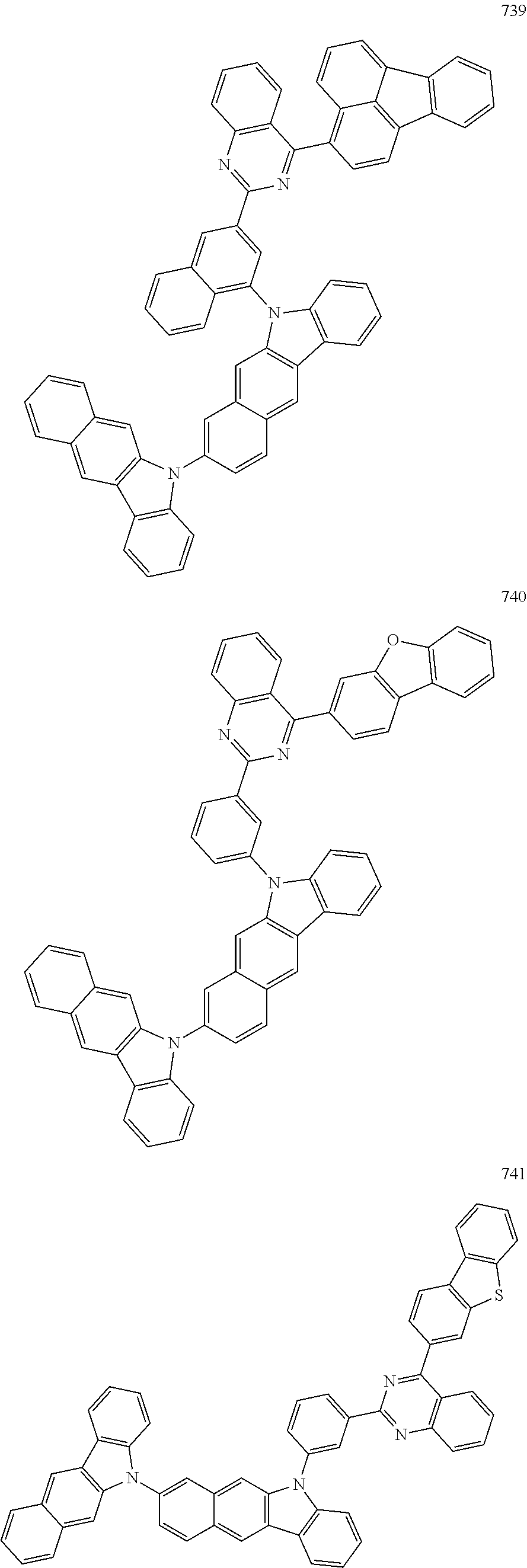























































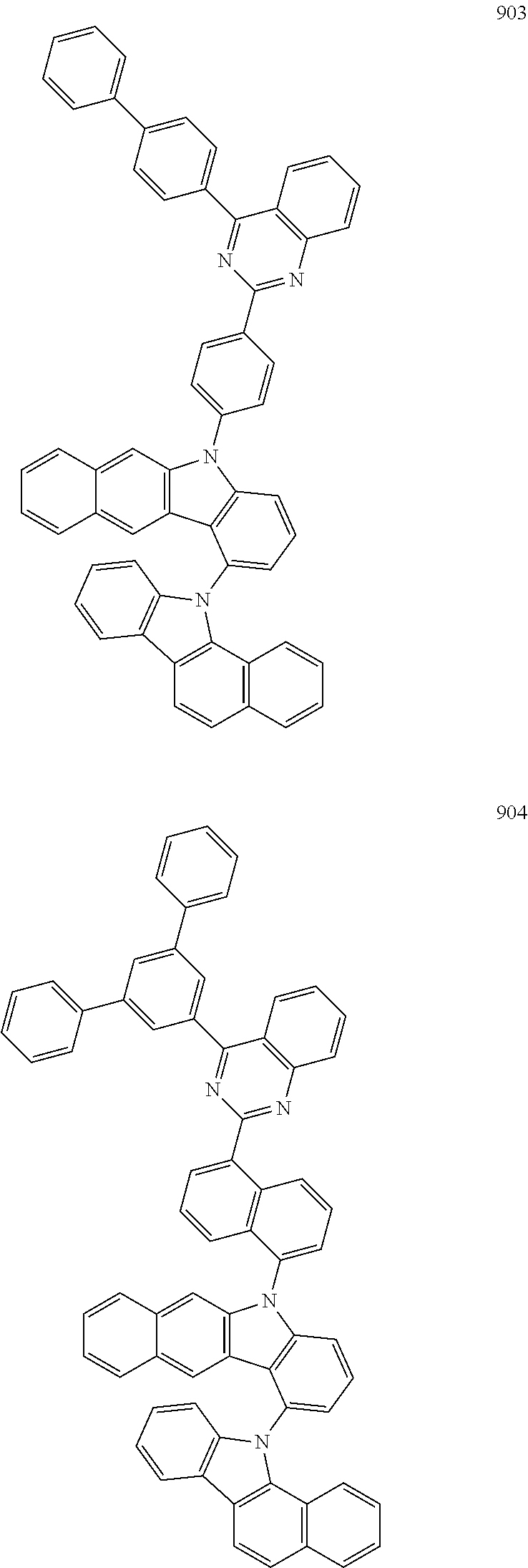
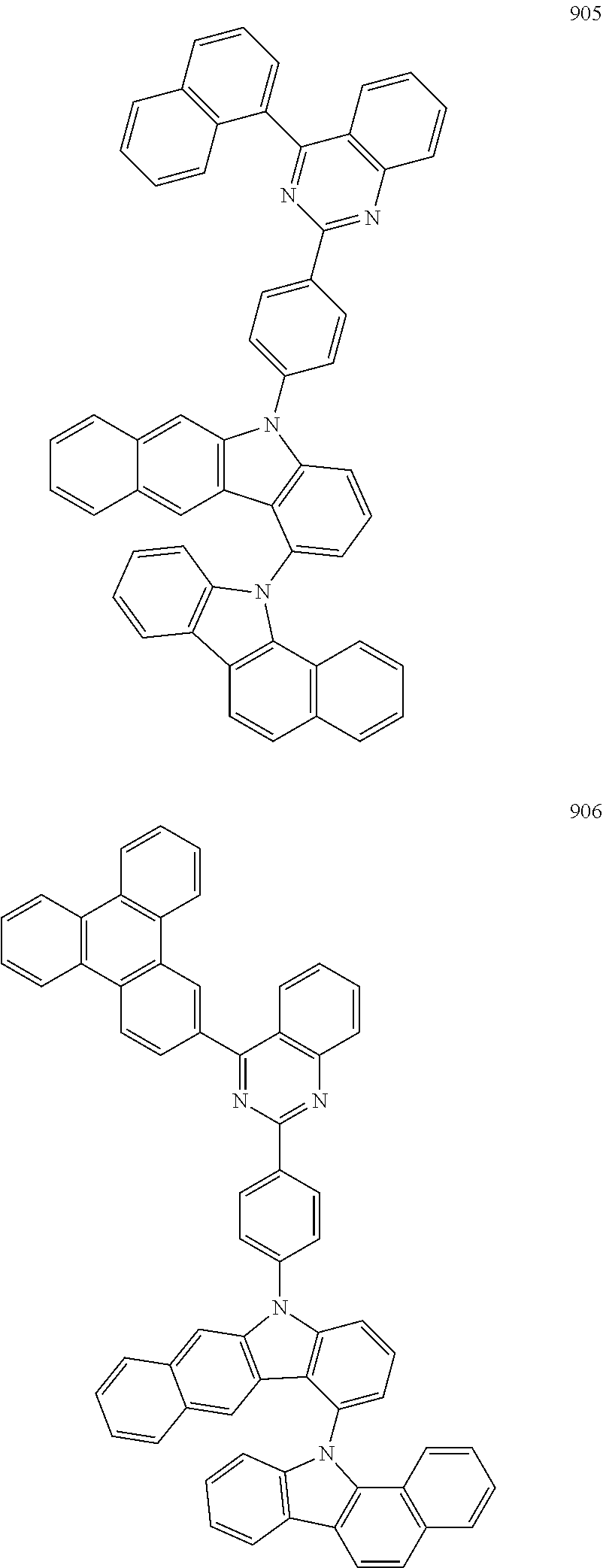





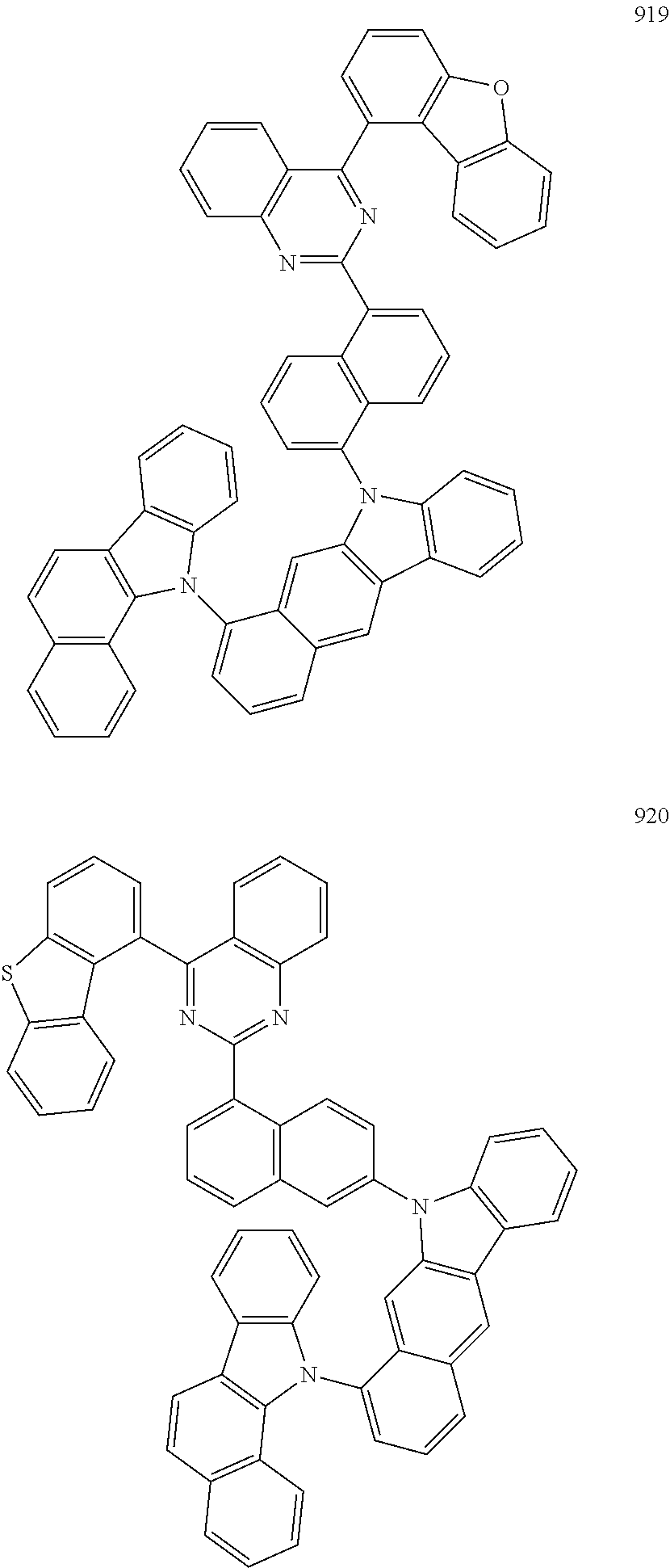















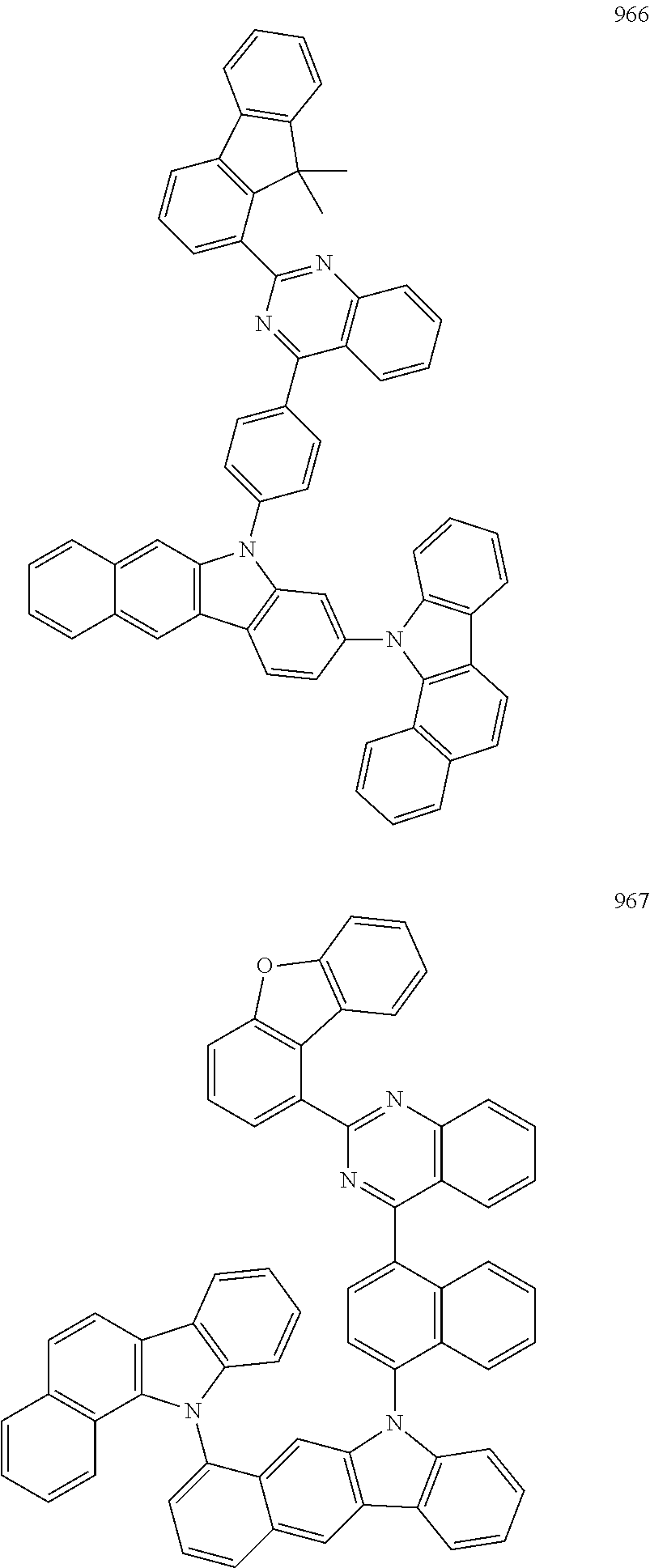




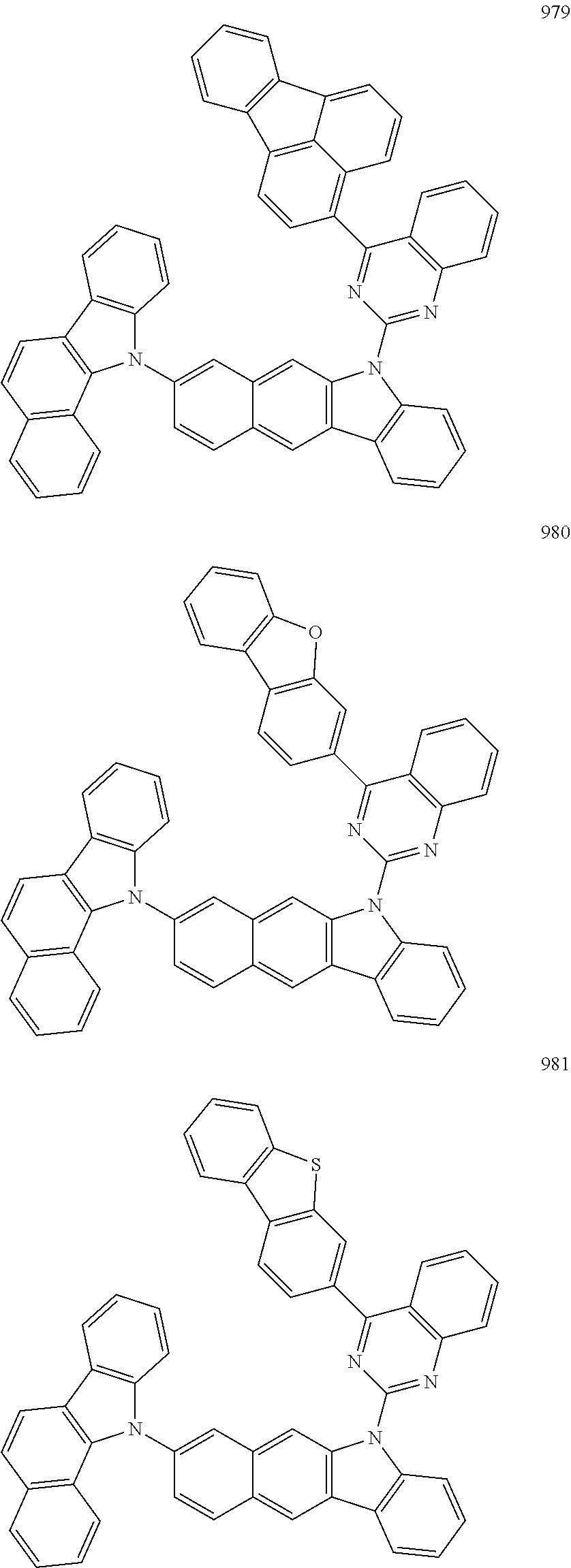
















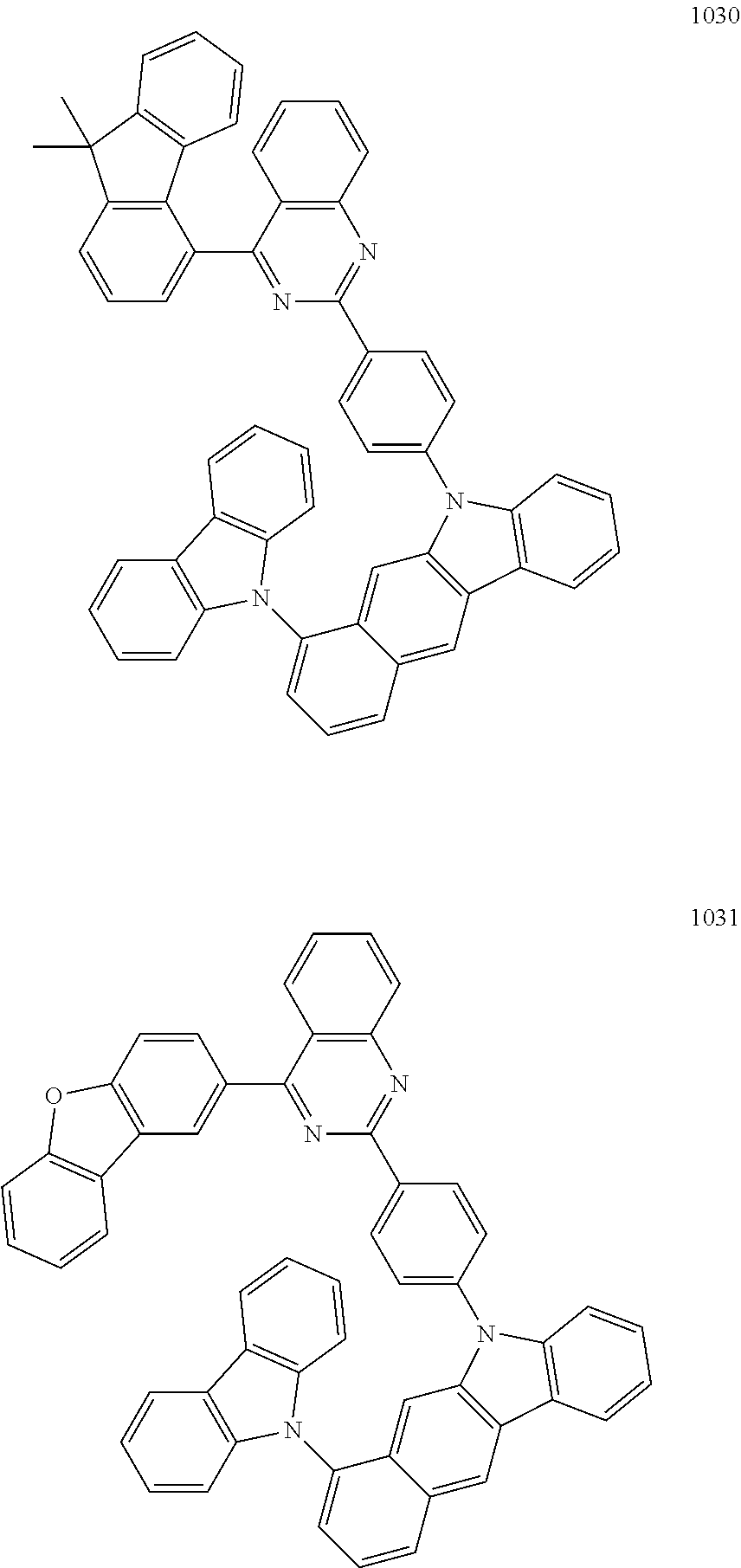









D00000

D00001

D00002

D00003

D00004
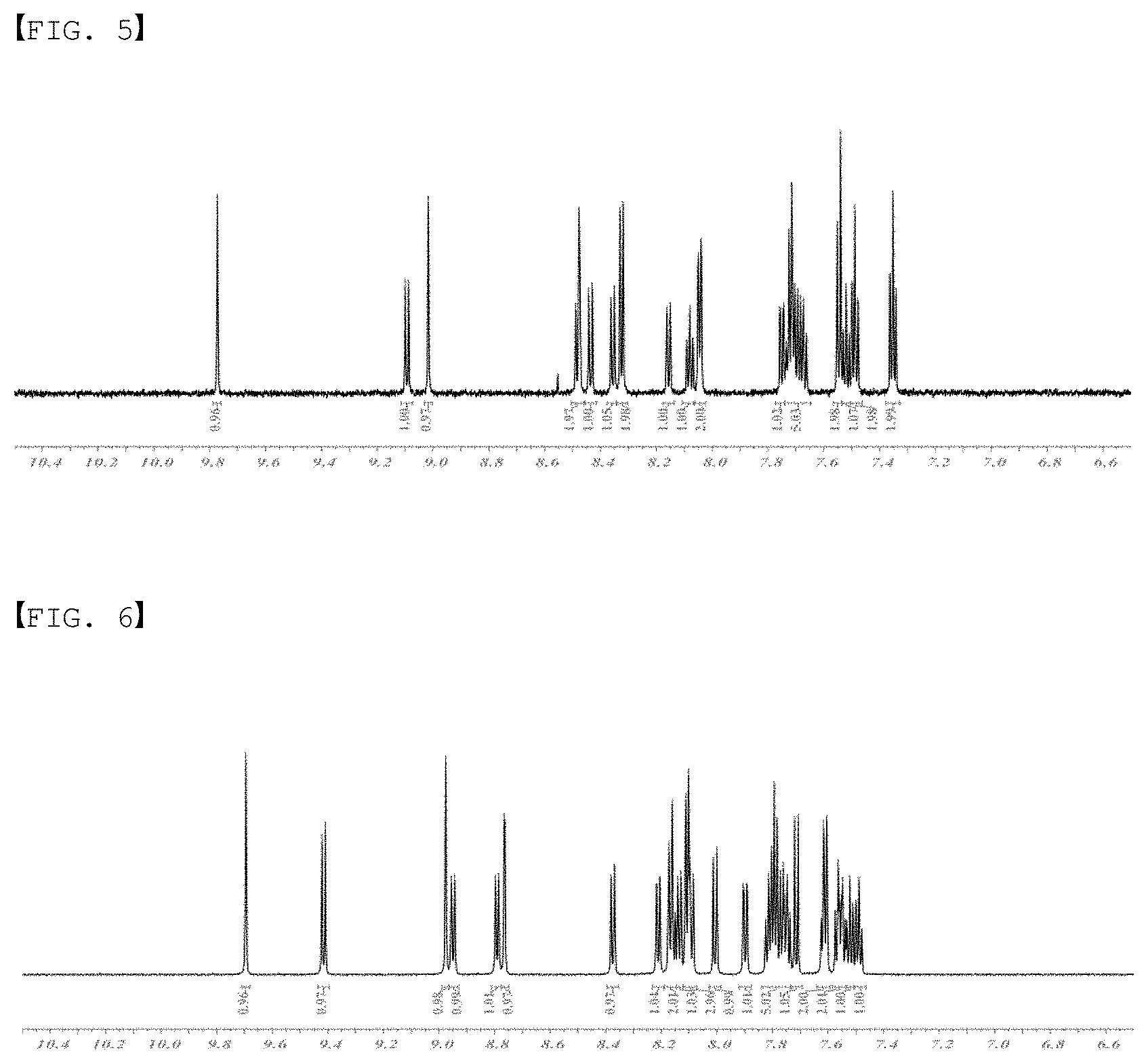
P00999
XML
uspto.report is an independent third-party trademark research tool that is not affiliated, endorsed, or sponsored by the United States Patent and Trademark Office (USPTO) or any other governmental organization. The information provided by uspto.report is based on publicly available data at the time of writing and is intended for informational purposes only.
While we strive to provide accurate and up-to-date information, we do not guarantee the accuracy, completeness, reliability, or suitability of the information displayed on this site. The use of this site is at your own risk. Any reliance you place on such information is therefore strictly at your own risk.
All official trademark data, including owner information, should be verified by visiting the official USPTO website at www.uspto.gov. This site is not intended to replace professional legal advice and should not be used as a substitute for consulting with a legal professional who is knowledgeable about trademark law.